- Highlights of the Month
- Restaurants
- Hamburg DOM
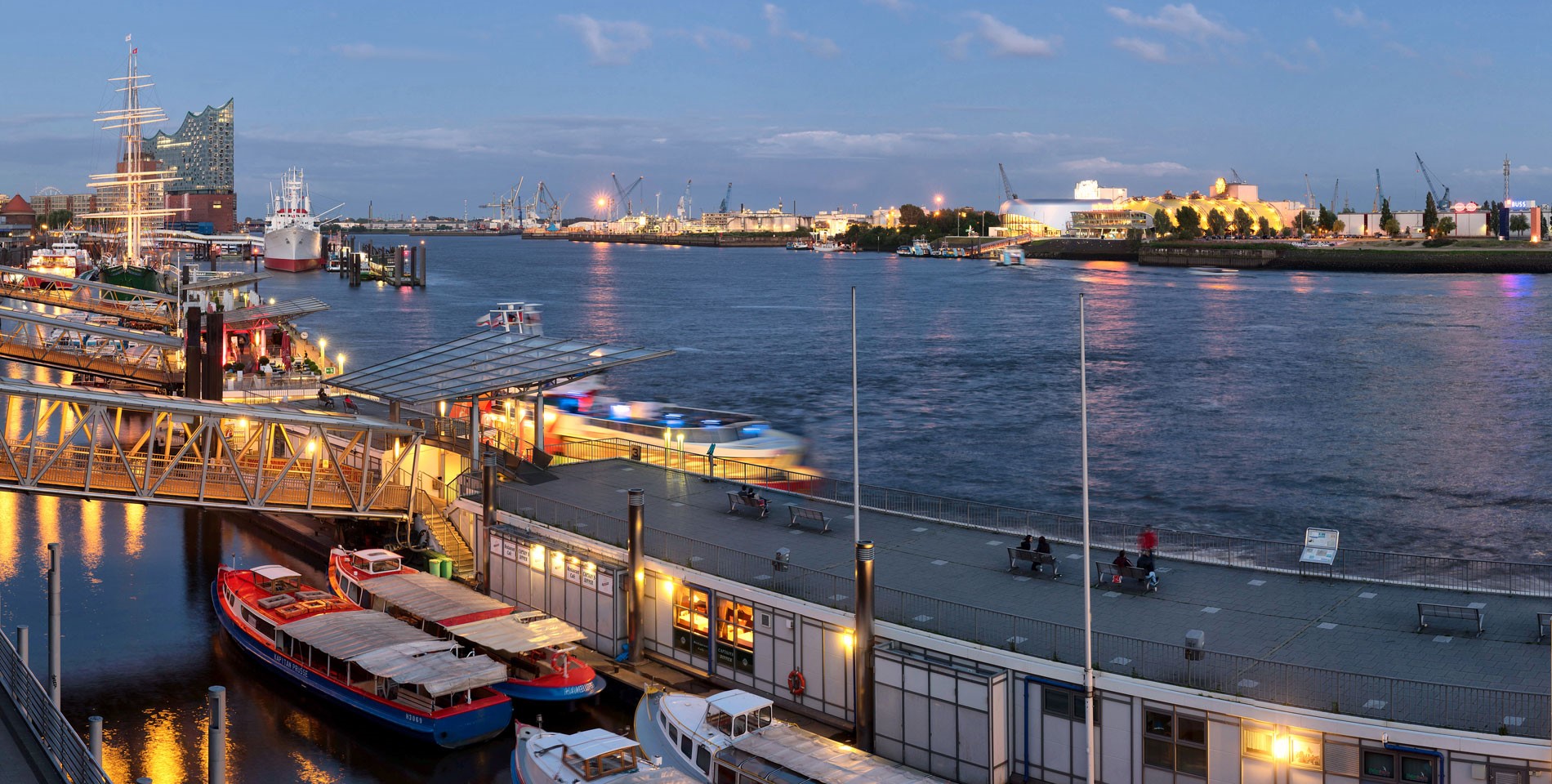

Day Trips Islands and Beaches
With both the Baltic and the North Sea only an hour's drive away, the many beaches and islands are a Hamburger's weekend delight.
European Men's Football Championship Cultural Run-Up to UEFA Euro 2024
Counting down the days: Hamburg's cultural venues present a rich programme in the forerun to the European Football Championship.
Explore Outdoors
Enjoy Hamburg's plentiful outdoor opportunities ─ stroll around the Alster or go jogging in the Stadtpark.
Hamburg For... Luxury Lovers
Five-Star hotels, haute cuisine, spas and shopping: Hamburg has a wealth of exclusive treats to entice visitors looking for an exclusive experience.
Explore Indoor Fun
Sometimes it's nice to spend a day safe from the elements. Here are some of the best ways to spend a fun day inside in Hamburg!
Visitors Museums
From modern art and German romanticism to ethnology and maritime history, Hamburg boasts a wide variety of museums.
Events Highlights of the Month
Sports, exhibitions, concerts, trade shows, street festivals - there's always something going on. See this month's highlights at a glance.
Visitors Dine and Drink
Pick your favourite from Hamburg's many restaurants, bistros, cafes, bars and pubs to wind down after a long day of exploring.
Day Trips Nature and Activities
Just outside the city's doorstep, the beautiful landscape of Northern Germany unfolds. Explore on foot, by bike or in a canoe.
Events Hamburg DOM Fun Fair
Held three times a year, the DOM is North Germany's biggest public festival.
COVID-19 Corona: What's New
Most of the COVID-related restrictions have been lifted all over Germany, but there are still certain things to keep in mind. Read our overview.
- Pause Pause Play Play
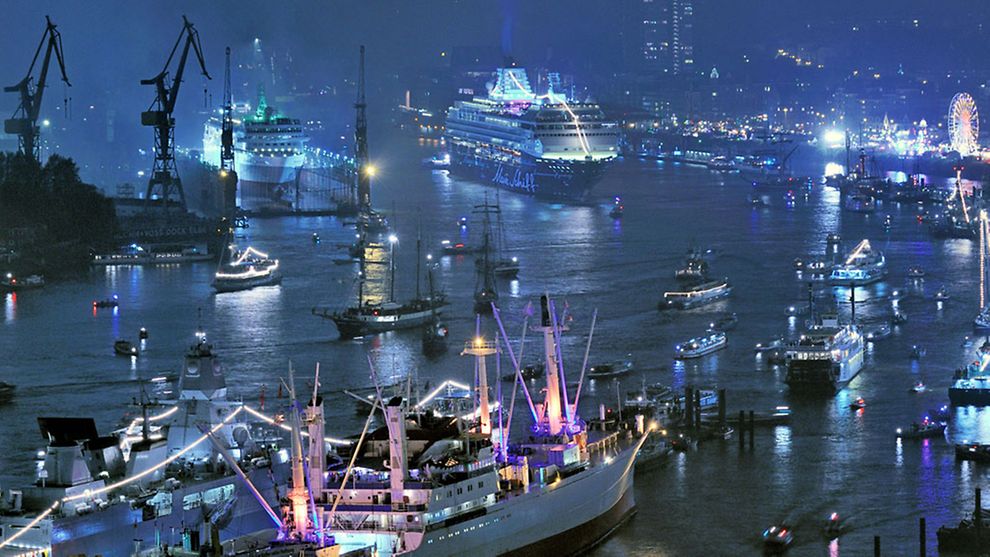
Visitors Events
Stay up-to-date on festivals, street fairs and recurring events like the Port Anniversary, Christmas markets and the Hamburg DOM.

Dine and Drink Restaurants
From haute cuisine to local specialties, taste the wide variety of Hamburg flavours — sorted by cuisine and location.
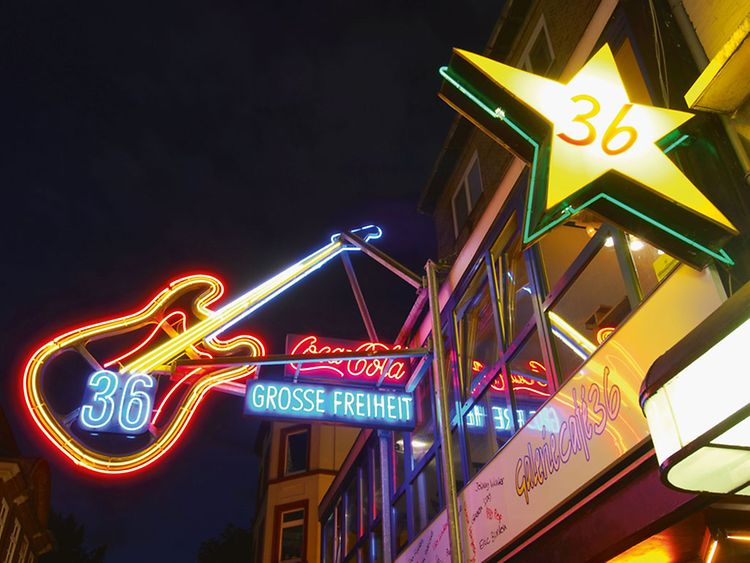
Dine and Drink Bars and Pubs
Night owls won't be bored. Dance all night long – explore the bars and pubs of St. Pauli and Sternschanze.
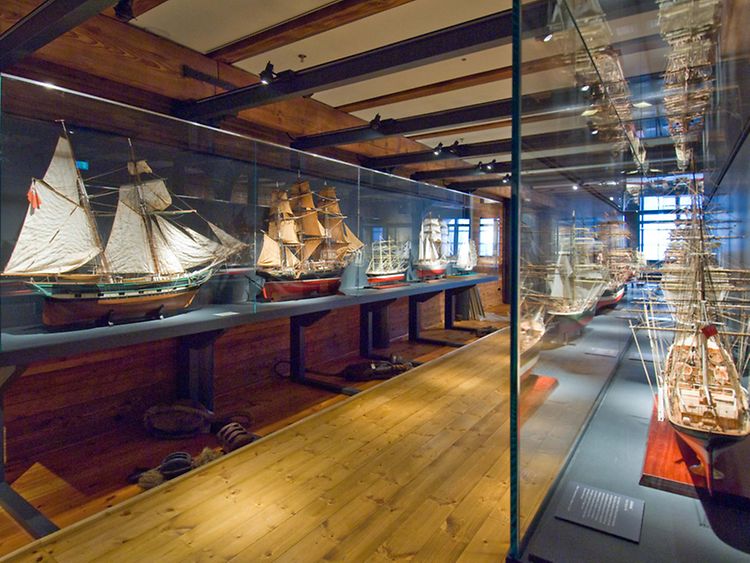
Visitors Day Trips
Feeling adventurous? Discover the best day trips around Hamburg: from beaches and wildlife parks to castles and medieval villages.
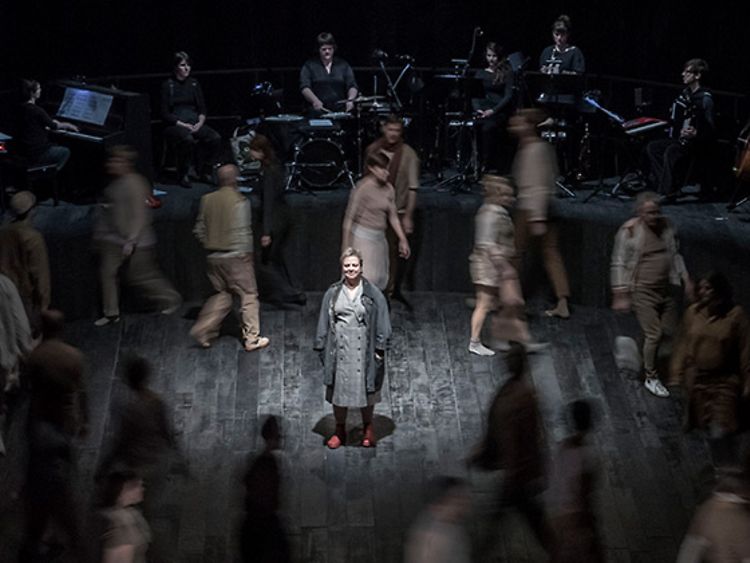
Explore Theatres
Out of Hamburg's 40+ theatres, many offer the occasional English play, while others focus entirely on the language of Shakespeare.
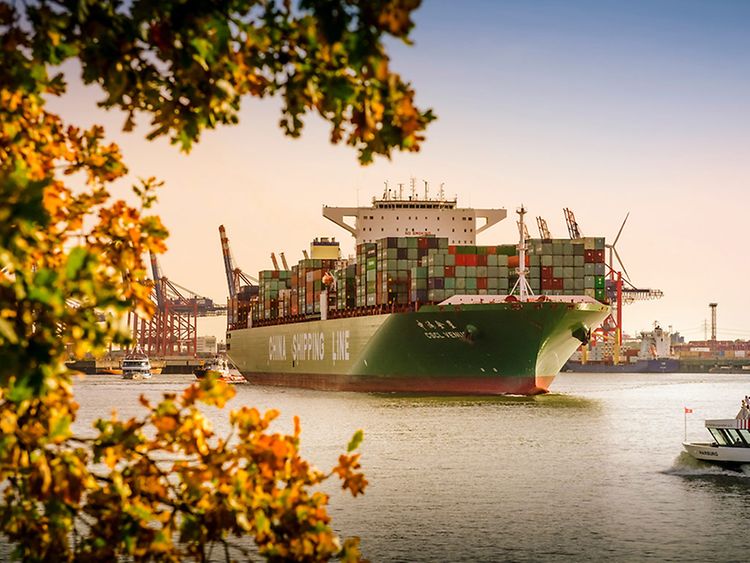
Business Port of Hamburg
From the latest ship arrivals to hi-tech port logistics and a multitude of responsible bodies: we'll help you navigate Hamburg's port.

Shopping Sports
Find your next fitness outfit, running shoes or exercise equipment in these sports stores.
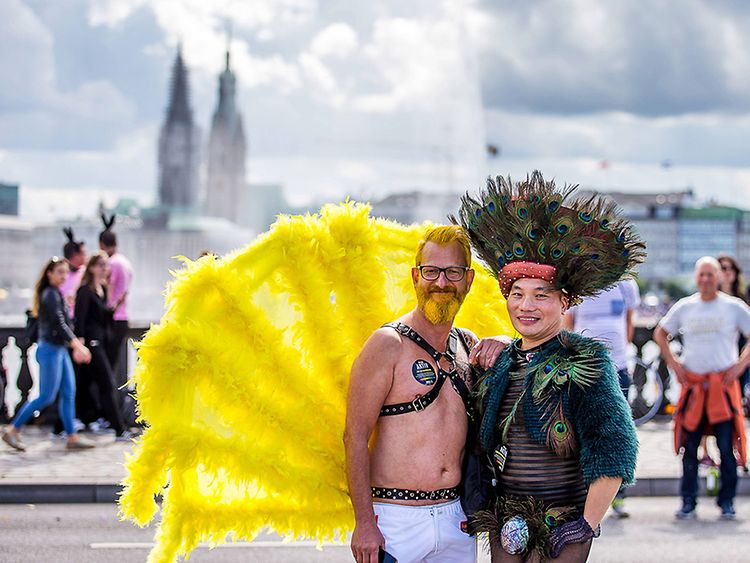
Events Street Festivals
As soon as the spring shines, street festivals pop up all over Hamburg.
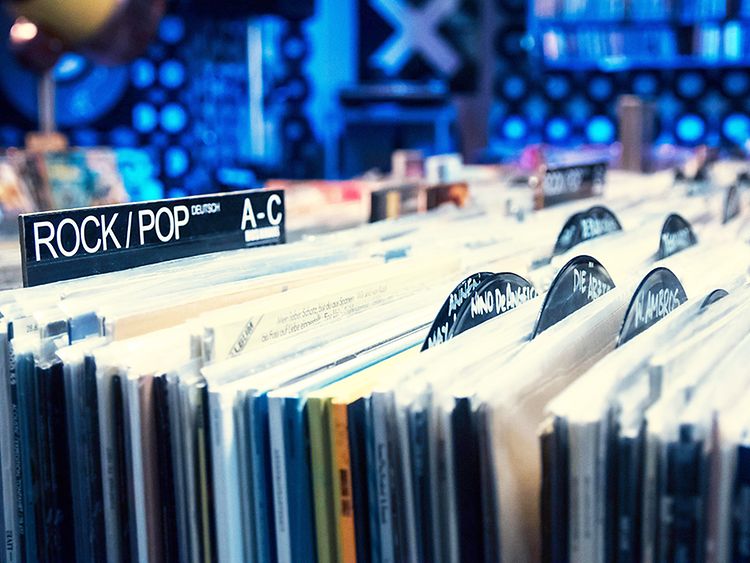
Shopping Music
Whether you're after the latest labels or vintage vinyl: visit these well-stocked record shops and discover the sounds of Hamburg.
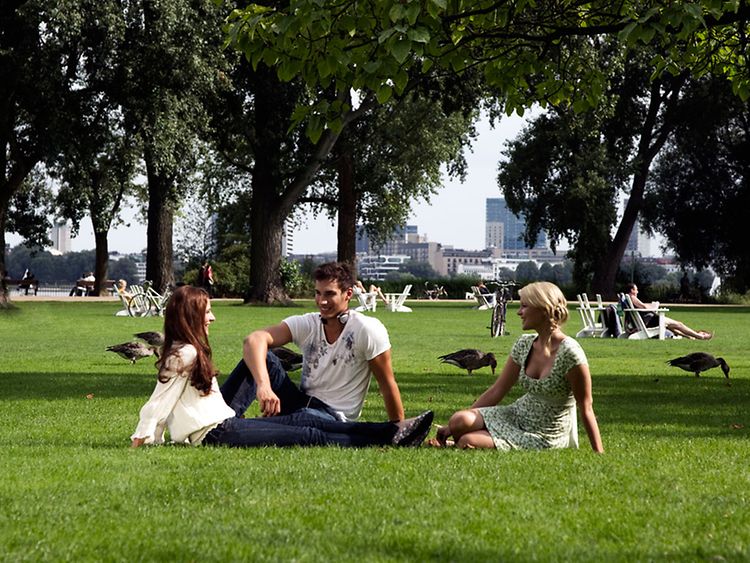
Explore Books
Whether you're looking for a unique travel guide or a collection of the city's street art: check out our Hamburg book suggestions.
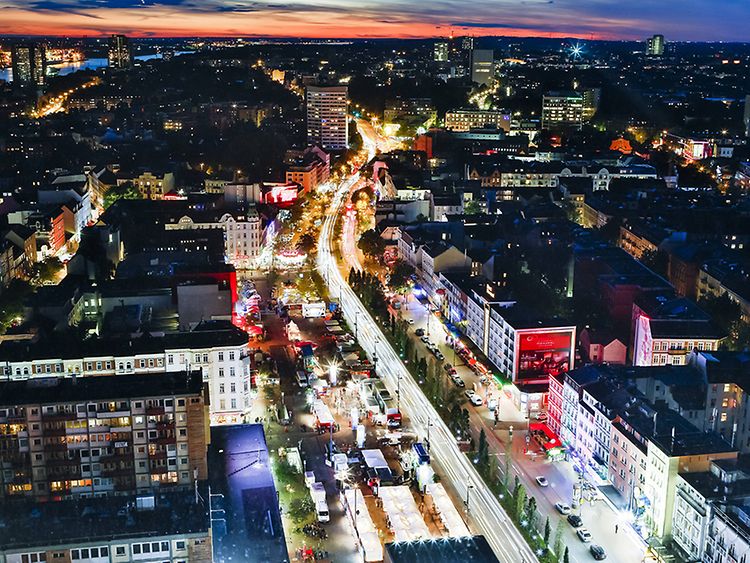
Explore Reeperbahn Nightlife District
The famous street in the heart of St. Pauli offers everything from theatres and galleries to trendy nightclubs and smoky sailor bars.
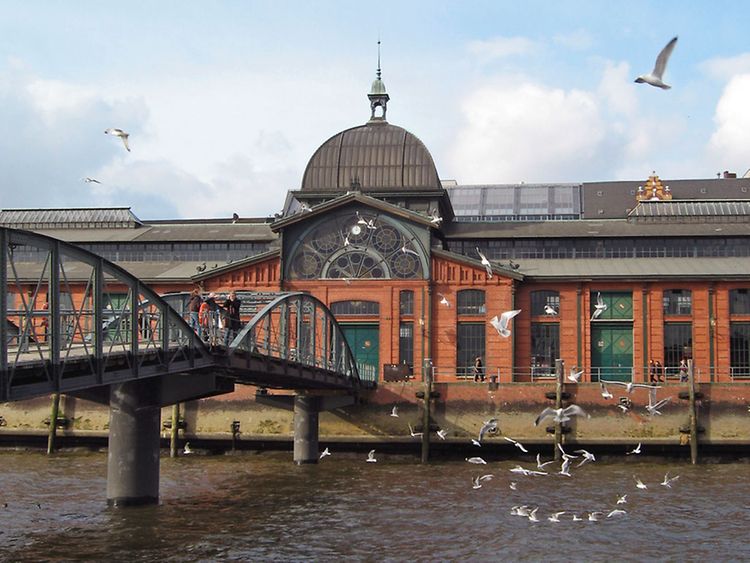
Sights Fish Market
Every Sunday morning, the Hamburg Fish Market by the Elbe attracts thousands of visitors, night owls and early birds alike!
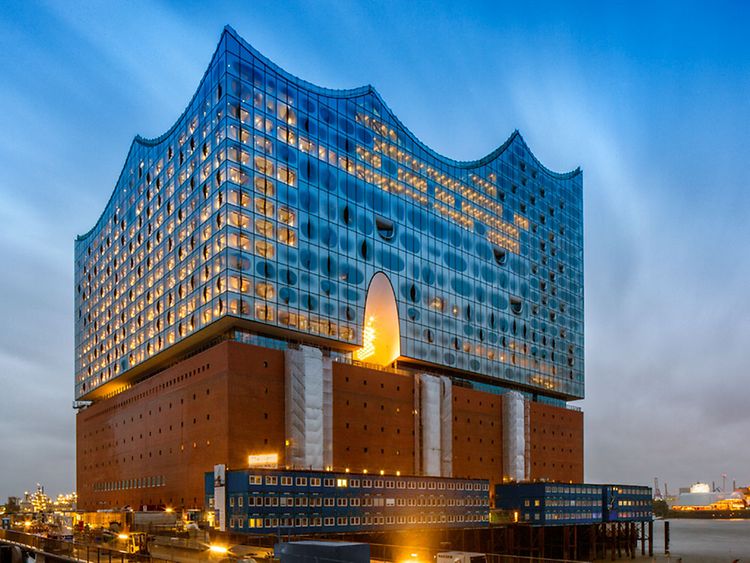
Visitors Elbphilharmonie
Towering above the Elbe and HafenCity is the city's newest landmark — the impressive concert venue Elbphilharmonie Hamburg.
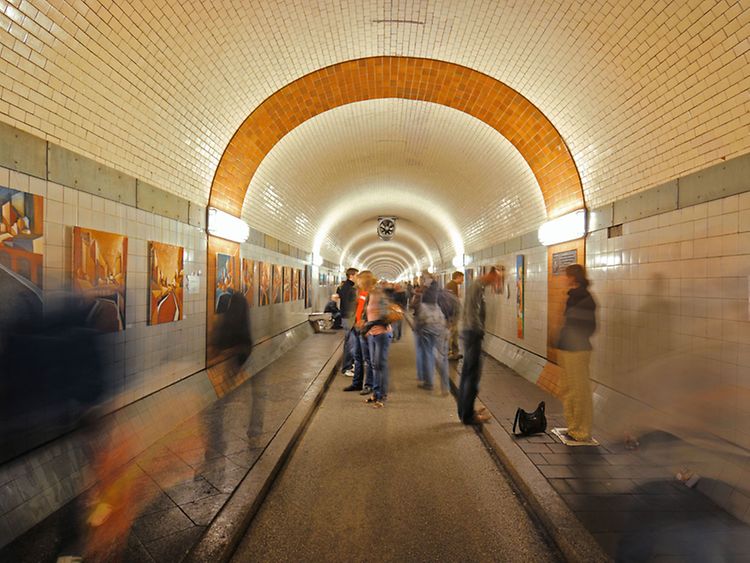
Sights Old Elbe Tunnel
Always free to pedestrians, the St. Pauli Elbtunnel (or Alter Elbtunnel ) connects the Landungsbrücken piers with the port.
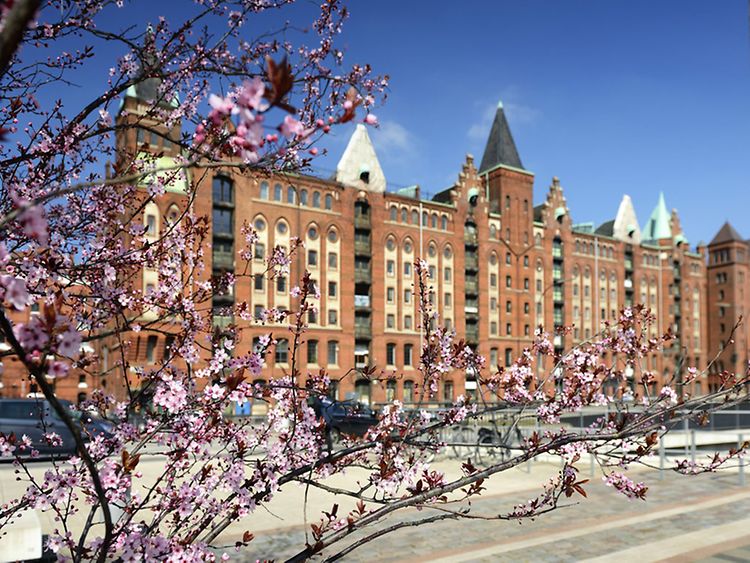
Sights Speicherstadt UNESCO Site
The world’s largest warehouse complex is a UNESCO World Heritage Site and a must-see on every trip to Hamburg.
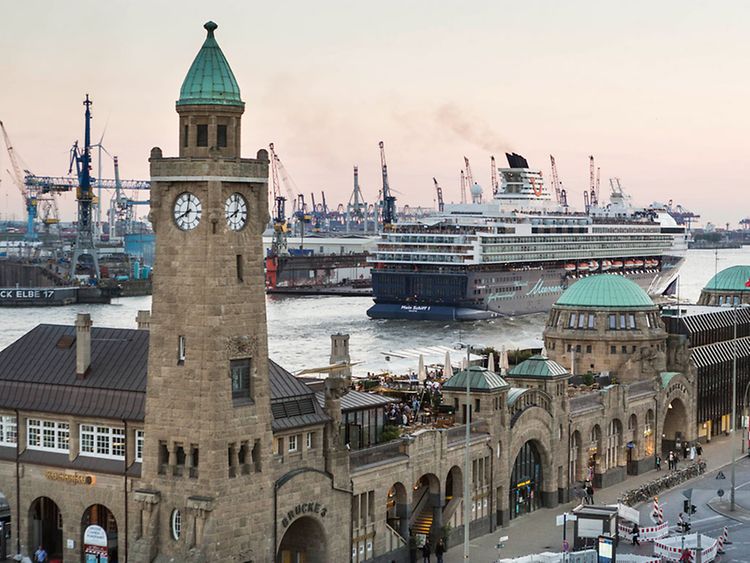
Sights Landungsbrücken Piers
Spectacular views, historic waterfront buildings and a public transport hub? Look no further than St. Pauli's Landungsbrücken.
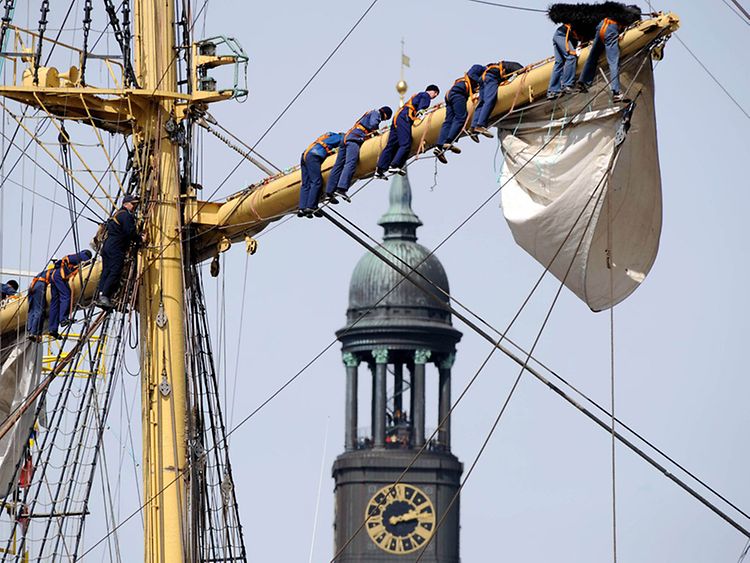
Sights St. Michael's Church
The 'Michel' is Hamburg's largest church and one of the city's must-see sights. Its bell tower offers a stunning view over the city.
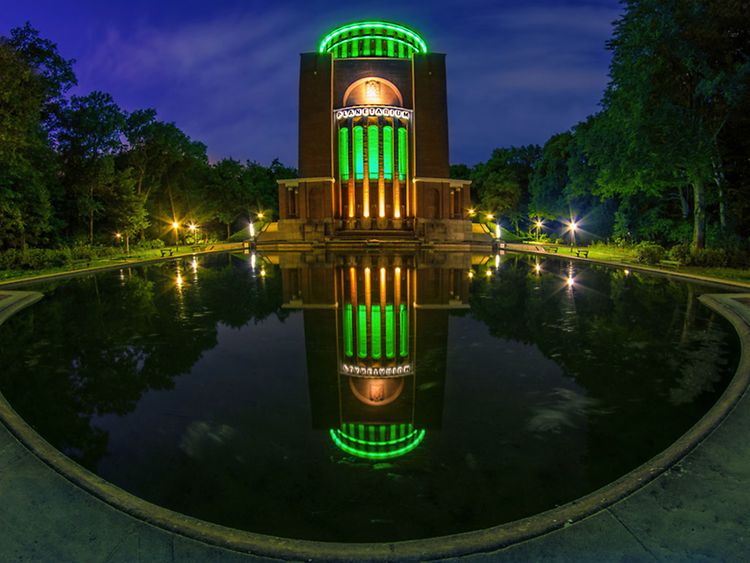
Sights Planetarium
Standing proudly in the centre of the Stadtpark, the planetarium has been shining new light since its grand reopening in 2016!
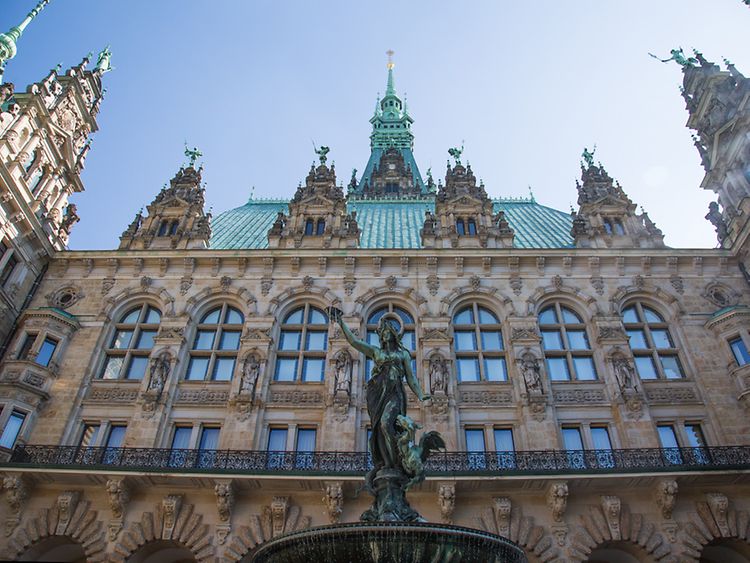
Sights City Hall
The impressive Rathaus (City Hall) is Hamburg’s seat of government. Hamburg's parliament and senate assemble here.
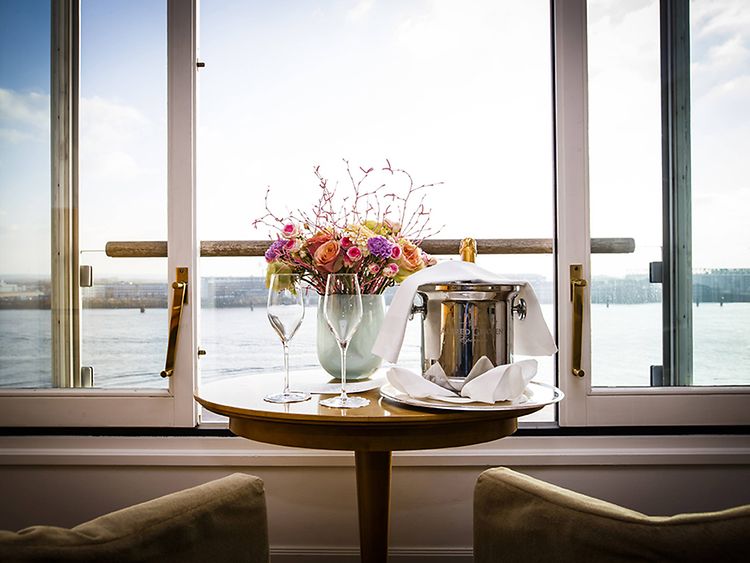
Stay Luxury Hotels
Discover the most exclusive and elegant five-star hotels the city of Hamburg has to offer.
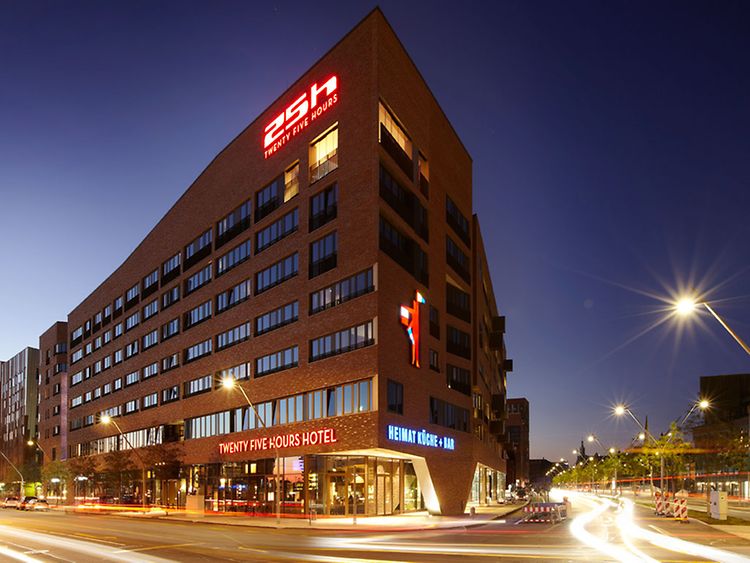
Stay Hotels
From five-star hotels and business resorts to B&B accommodation: find a room that suits your needs.
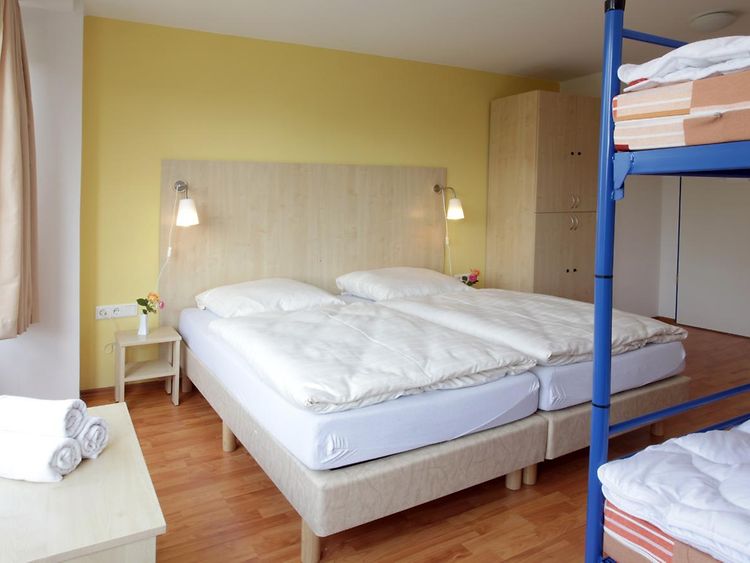
Stay Hostels
Book a dorm bed or private room in one of Hamburg's high-quality hostels and meet like-minded travelers.
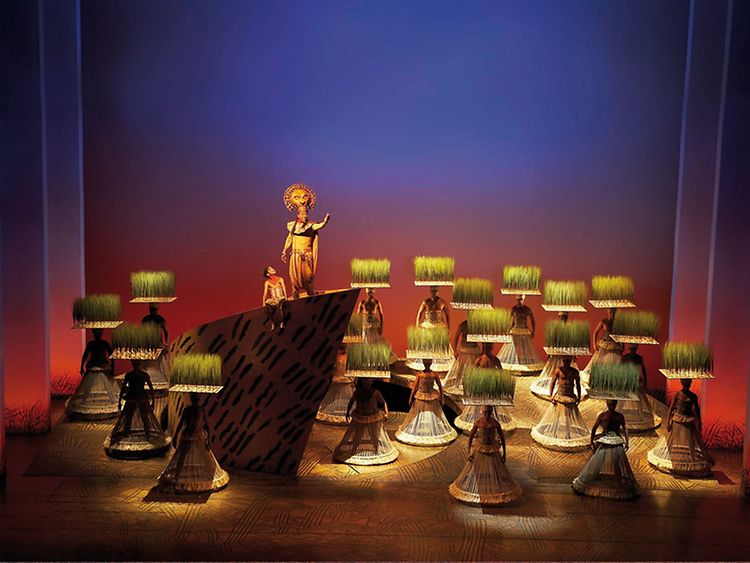
Stay Packages
Watch a musical, sleep at a classy hotel and discover Hamburg's attractions with a single ticket, the Hamburg CARD. Top packages.
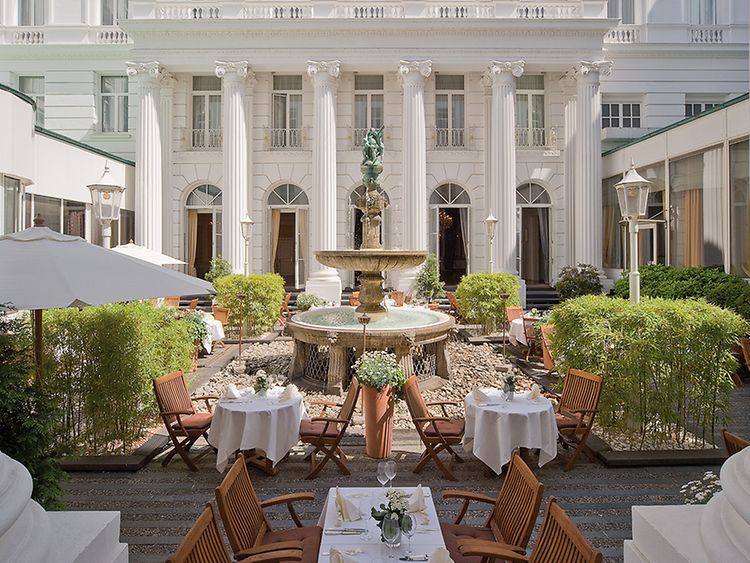
Bars and Pubs Hotel Bars
Every night, visitors of Hamburg's many hotels go for a drink at the in-house bars. From functional to fancy, all price ranges are covered.
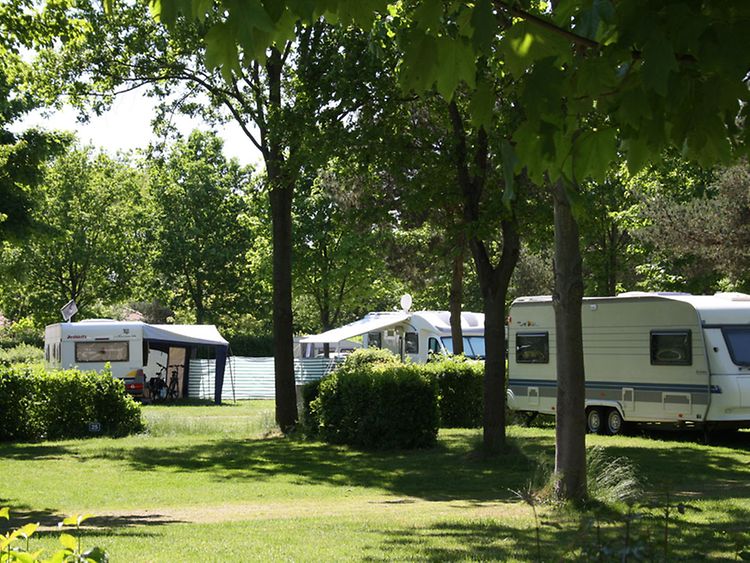
Stay Camping
Take your motorhome to the city, tow your caravan to the dyke, pitch your tent on the beach! Camping options in and around Hamburg.
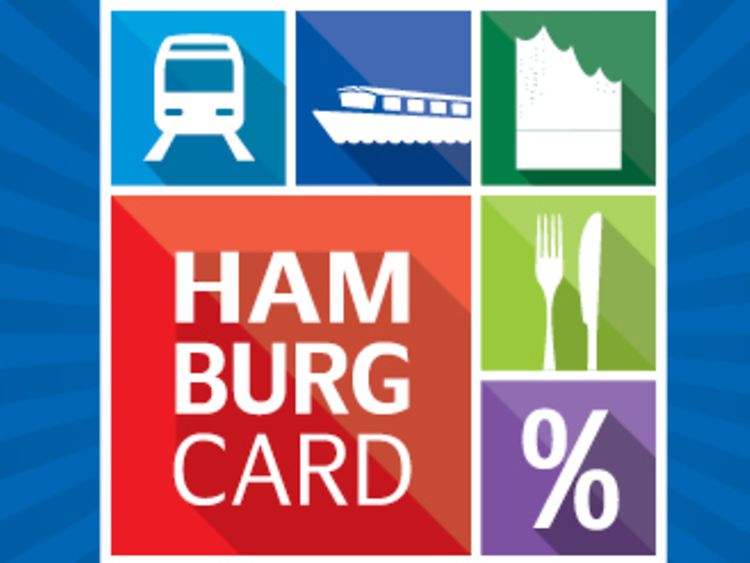
Useful Information Hamburg CARD
Enjoy free public transport and up to 50% discounts on museums, musicals and tourist attractions with the Hamburg CARD and Hamburg CARD Local.
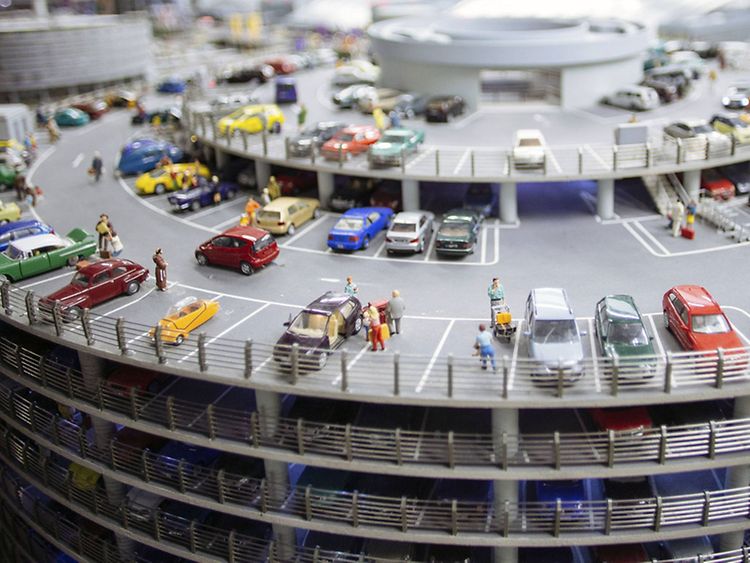
Useful Information Parking
Travelling to Hamburg by car? Find a parking facility near your hotel or business centre and learn about costs, regulations and signage.
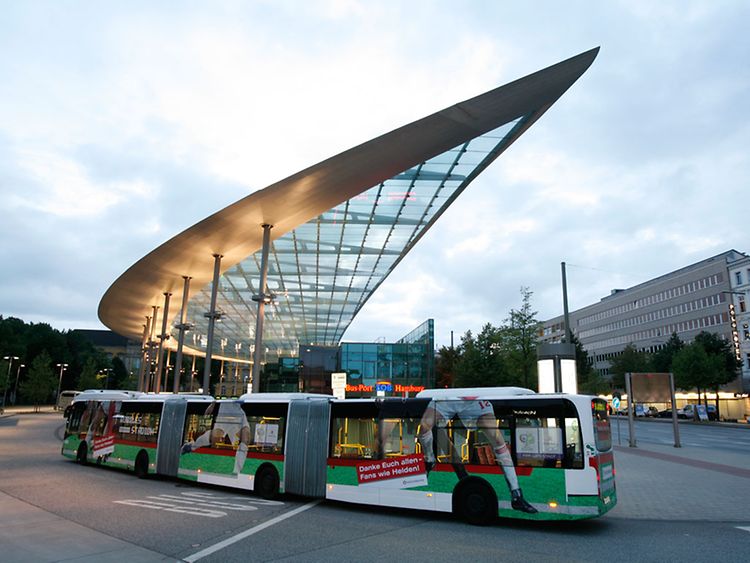
Getting Here Stations
Hamburg has 4 railway stations - Hauptbahnhof, Dammtor, Altona & Harburg - as well as a long-distance bus terminal (ZOB).

Visitors Plan Ahead
Discover Hamburg's top activities, restaurants, nightlife, shopping districts, clubs, places of worship and more.
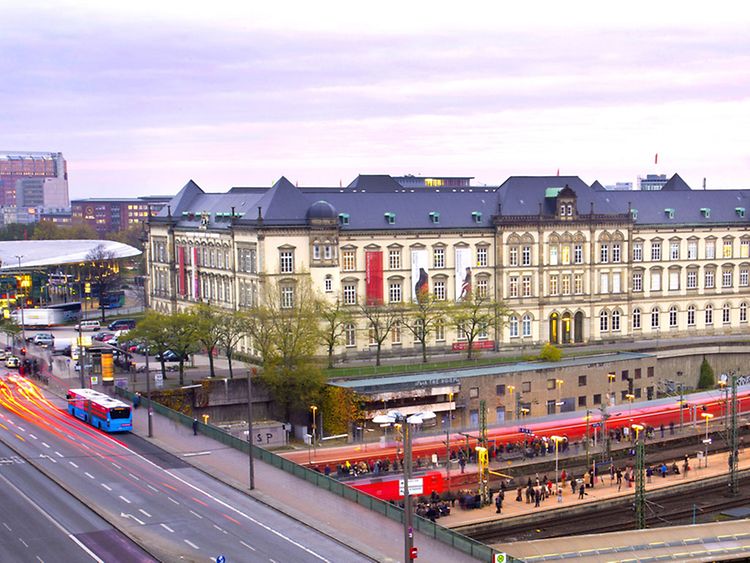
Visitors Getting Around
Train, bus, car or bike: Hamburg has a number of transport options, both public and private, that will let you navigate the city with ease.
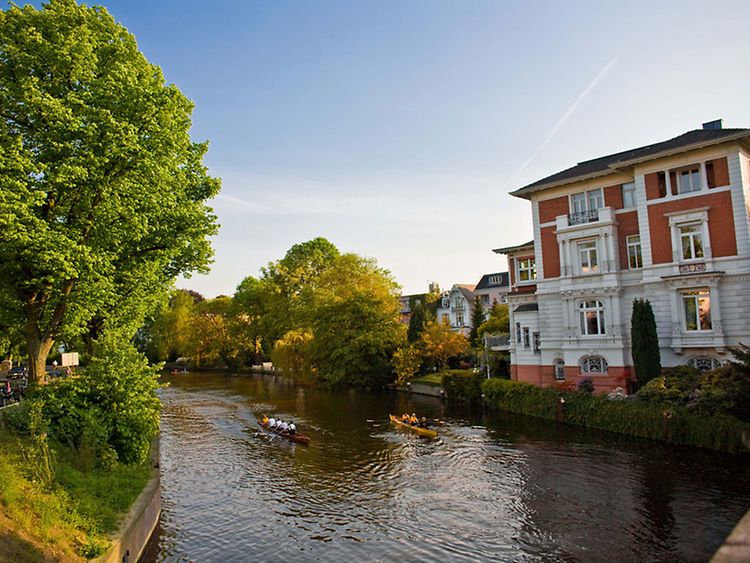
Residents Neighbourhoods
Maps and guides for Hamburg's seven administrative districts (Bezirke) and 104 quarters (Stadtteile).
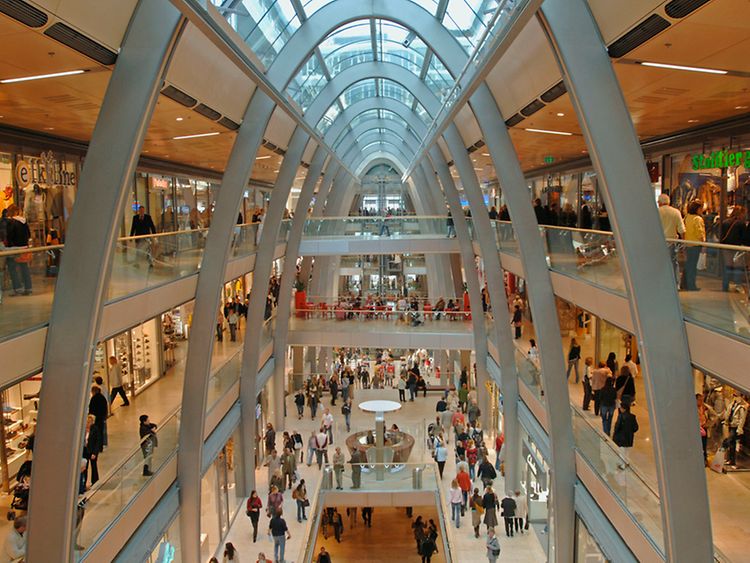
Visitors Shopping
Whether you're into high fashion or vintage chic, Hamburg is a great city for shopping. Get to know the best shopping districts and outlets.
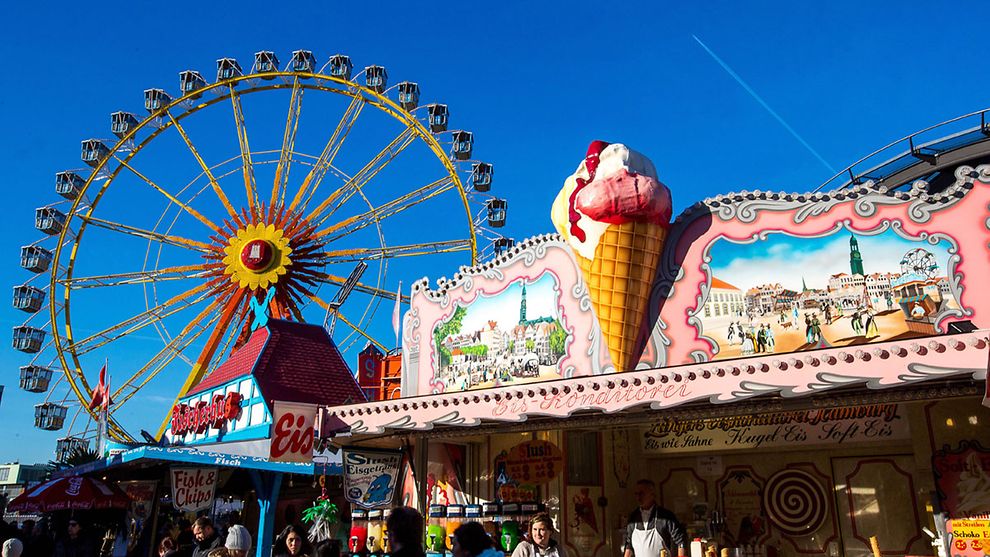
Visitors Holidays
From Christmas to Halloween to New Year's Eve, learn how holidays are celebrated in Hamburg.
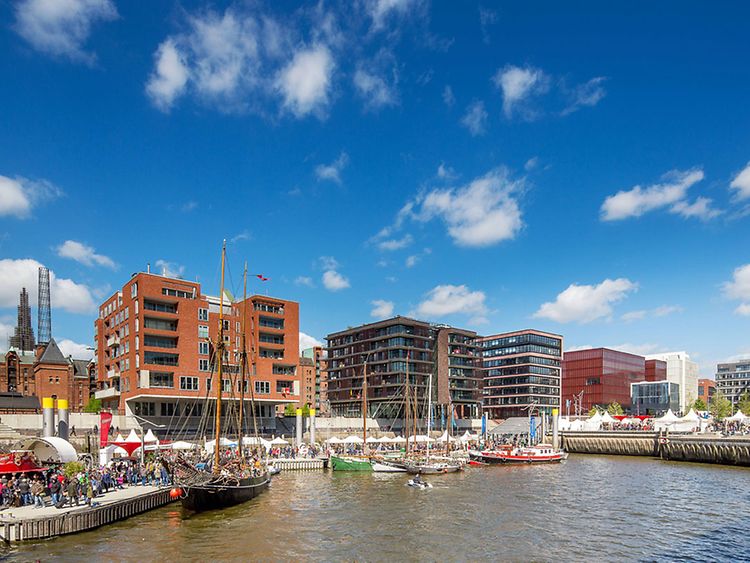
Events Port Anniversary
Maritime parades, historic sailboats and ships, music, fireworks and food: celebrate Hamburg's biggest festival along the banks of the Elbe.

Visitors Getting Here
Planning a trip? Hamburg has four railway stations, a coach station, an international airport and a cruise terminal. Find out more here.
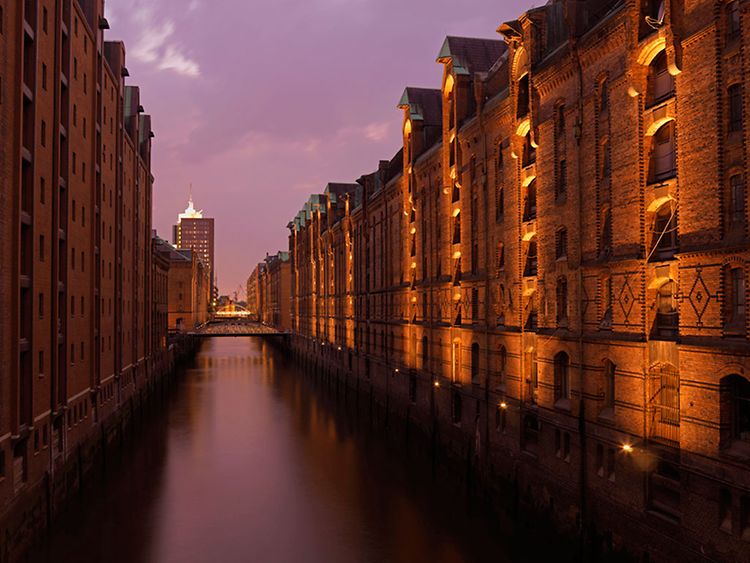
Visitors Hamburg by...
Choose your mode of transport to roll, paddle or ride through Hamburg your way: Options include trains and free-of-charge Stadtrad bikes.
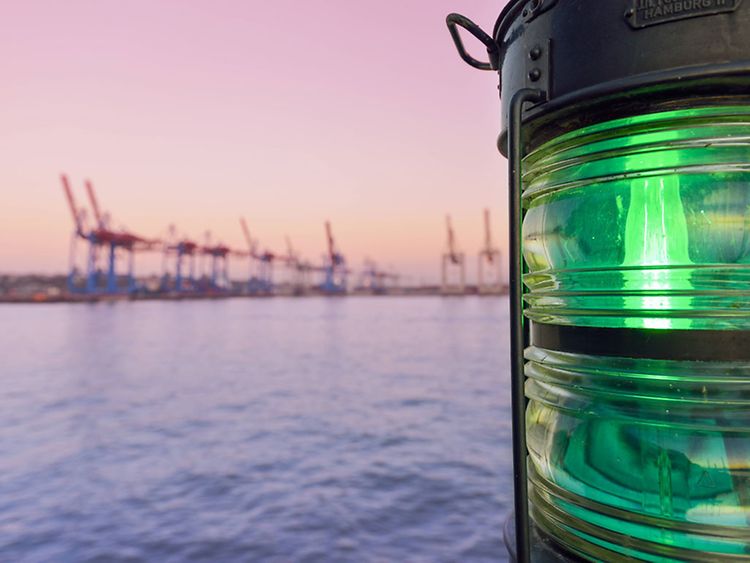
Visitors Hamburg for...
Travelling with kids, teens or pets? Are you on a vegan diet or a slim budget? See our tips and tricks to find what best fits your needs.
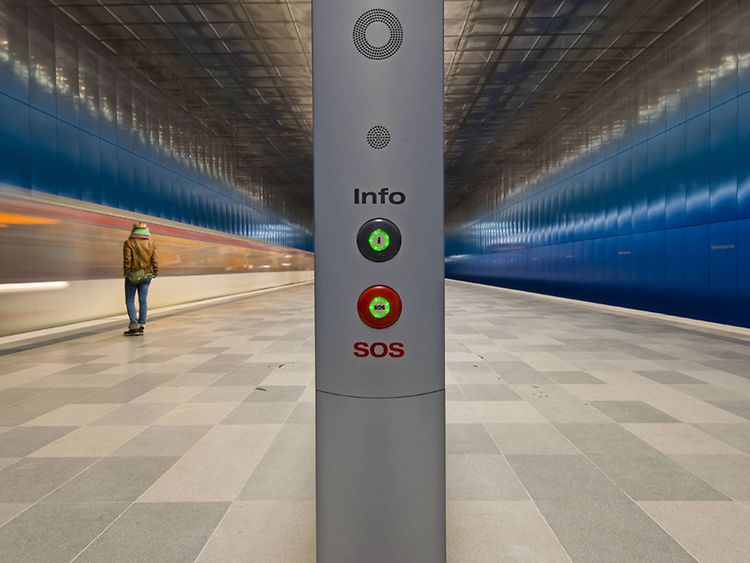
Visitors Useful Information
From practical advice on finding the nearest tourist information to insight into Hamburg's colourful history. Get to know the city here.
Copyright owners of the images
- Visitors : © www.mediaserver.hamburg.de / Andreas Vallbracht
- Islands & Beaches: © www.mediaserver.hamburg.de / Bernd Schlüsselburg
- Stiftung Fußball & Kultur EURO 2024 gGmbH: © Stiftung Fußball & Kultur EURO 2024 gGmbH
- outdoors-and-parks: © www.mediaserver.hamburg.de / Sven Schwarze
- Haerlin: © Jan Brettschneider
- Action Arena: © Action Arena
- Museums; IMMH: © www.mediaserver.hamburg.de / Christian Spahrbier
- Districts of Hamburg: © www.mediaserver.hamburg.de / Jörg Modrow
- Dine & Drink: © imago stock & people / Westend61
- Nature & Activities: © www.mediaserver.hamburg.de / imagefoto.de
- Hamburg DOM Fun Fair: © imago stock & people / Hoch Zwei Stock / Angerer
- Corona: What's New: © imago images / Bihlmayerfotografie
- Events: © www.mediaserver.hamburg.de / Christian Spahrbier
- Restaurants in Hamburg: © iStock.com / shironosov
- Bars & Pubs: © www.mediaserver.hamburg.de / Christian Spahrbier
- Daytrips: © www.mediaserver.hamburg.de / C. O. Bruch
- Mother Courage : © Krafft Angerer
- Port of Hamburg: © Hafen Hamburg / Ingo Boelter
- Sports: © imago stock & people / Westend61
- Street Festivals: © imago stock & people / Hoch Zwei
- Music: © imago stock & people / Christian Grube
- Hamburg Books: © imago stock & people / Hoch Zwei Stock / Angerer
- Reeperbahn: © imago stock & people / Lars Berg
- Fishmarket Markets: © www.mediaserver.hamburg.de / Christian Spahrbier
- Elbphilharmonie Venue: © www.mediaserver.hamburg.de / Thies Raetzke
- Old Elbe Tunnel: © www.mediaserver.hamburg.de / Christian Spahrbier
- Speicherstadt: © imago stock&people / Christian Ohde
- Landungsbruecken: © www.mediaserver.hamburg.de / Jörg Modrow
- St. Michael's Church: © www.mediaserver.hamburg.de / Michael Zapf
- Planetarium Hamburg: © Michael Björnson
- City Hall: © Jessica Mintelowsky
- Luxury Hotels Hamburg: © imago stock & people / Lars Berg
- 25hours Hotel Hamburg: © Stephan Lemke for 25hours Hotels
- hostels-hamburg: © A&O HOTELS and HOSTELS Holding AG
- Entertainment in Hamburg: © www.mediaserver.hamburg.de / Stage Entertainment
- Hotel Bars: © Hotel Atlantic Kempinski Hamburg
- Camping: © KNAUS Campingpark
- Hamburg CARD: © A. Vallbracht / Hamburg Tourismus GmbH
- Parking in Hamburg: © imago stock&people/Future Image
- Stations: © Hochbahn
- Plan ahead: © www.pixabay.com
- Getting around: © www.mediaserver.hamburg.de / Museum für Kunst & Gewerbe
- Hamburg districts: © www.mediaserver.hamburg.de / Roberto Kai Hegeler
- Shopping in Hamburg: © www.mediaserver.hamburg.de / Christian Spahrbier
- Plan ahead: © imago-images
- Port Anniversary Hamburg: © imago stock & people / Hoch Zwei Stock / Angerer
- Getting here: © www.mediaserver.hamburg.de / Christian Spahrbier
- Hamburg by ...: © www.mediaserver.hamburg.de / Christian Spahrbier
- Hamburg for: © imago stock&people / Westend61
- Useful Information: © imago stock&people / Westend61

Welcome to Hamburg
Experience and discover the beautiful city on the waterfront.
Hamburg is one of the most beautiful cities in the world and radiates an incomparable charm. Go on a discovery tour through the city by the Elbe and explore the most beautiful sights, attend unique events or feast in the most delicious restaurants & cafés. The city's scene & nightlife are known all over the world and Hamburg is also a great shopping metropolis. When are you coming?
Too beautiful to stay at home Hamburg in Winter
Despite sinking temperatures, Hamburg's winters are highly inviting: Whether you prefer ice-skating, walking through the snow or visiting one of the numerous Christmas markets, no one must stay inside. And you definitely won't stay cold with a hot… Discover now
Top events Highlights 2024
In addition to many musical highlights of the Hanseatic city, various events from art & literature to film & theater are again on the program this summer. Look forward to an exciting and eventful year 2024! Discover now
You should see this Sights in Hamburg
A short holiday in Hamburg also means sightseeing in Hamburg. Whether the Elbe Philharmonic, Landungsbrücken or Hamburg City Hall - they and many other sights are simply part of a trip to Hamburg. The easiest way to explore Hamburg's sights is on a… More
Shopping centres, department stores, shops Shopping in Hamburg
Hamburg is a paradise for shopping fans! The city centre is known to be one of the most attractive shopping streets in Germany. Discover now
Theatre, Museums, Galleries & Music Culture & Music in Hamburg
When it comes to culture, Hamburg certainly caters for all tastes! With everything from theatres, museums, exhibitions, live music and a lively club scene to a UNESCO World Heritage Site and exciting adventure attractions right through to the jewel… Discover now
@hamburgahoi
Hamburg Ahoi! We love Hamburg and want to show the world the most beautiful sides of the city. We show you tips, inspirations, travel pictures and events on our social media channels. Follow us, be the first to find out what's going on in the city by the Elbe and what you should not miss. Share with us and the world your most beautiful moments with the Hashtag #hamburgahoi .
We use a third-party service to embed social media content. This service may collect data about your activities. Please read the details and agree to use the service to view the content.
- German : Deutsch
- English : English
- Swedish : Svenska
- Dutch : Nederlands
- French : Français
- Danish : Dansk
Google translator for other languages
Please note that this is an automatic translation. For better information, you can always switch to the German or English version
Awesome, you're subscribed!
Thanks for subscribing! Look out for your first newsletter in your inbox soon!
The best things in life are free.
Sign up for our email to enjoy your city without spending a thing (as well as some options when you’re feeling flush).
Déjà vu! We already have this email. Try another?
By entering your email address you agree to our Terms of Use and Privacy Policy and consent to receive emails from Time Out about news, events, offers and partner promotions.
Love the mag?
Our newsletter hand-delivers the best bits to your inbox. Sign up to unlock our digital magazines and also receive the latest news, events, offers and partner promotions.
- Things to do
- Attractions
- Restaurants
- Los Angeles
Get us in your inbox
🙌 Awesome, you're subscribed!

Hamburg travel tips every first time visitor needs to know
Find out the dos and don'ts of navigating the city, from worthwhile boat tours to museum tips and more
Welcome to Hamburg, a city brisk with sea air, brimming with Hanseatic pride and open to the world not only in terms of centuries of maritime trade, but also in its vivid mix of nationalities, identities and political inclinations – not to mention its dusk-to-dawn party stamina. Whether you’re in town for 48 hours , a week or indefinitely, here’s how to make the most of this exciting harbour city, from public transport tips to tucked-away architectural treasures.
⛴ The best things to do in Hamburg 📍 The best attractions in Hamburg ⏰ How to spend 48 hours in Hamburg
An email you’ll actually love
20 travel tips every Hamburg visitor needs to know

1. Expect the rough with the smooth
Every metropolis is multi-faceted, but Hamburg’s vivid contrasts often take first-time visitors by wide-eyed surprise. While Berlin inclines towards a gritty edge, Frankfurt puts its finance suit on and Munich purrs with prosperity and mountain air, Hamburg has something of the rough, the smooth and the salty all mixed together. It’s a place replete with harbour bawdiness as much as Hanseatic elegance, as dense with millionaires as it is with a history of anarchist dissent. Whatever your budget and taste, be adventurous, explore different districts and get a sense of the city’s striking variety.

2. Get a Hamburg Card
Hamburg public transport (HVV) is extensive and efficient, with round-the-clock services at weekends. With the Hamburg Card, you have unlimited travel on all U-Bahn, S-Bahn, bus and ferry routes, as well as more than 150 discounts at many of the city’s museums, restaurants and stores. A one-day card, which is valid until 6am the following morning, costs €10.90 for one adult and up to three children under the age of 14. A three-day card costs €28.90. You can buy your card of choice on HVV buses, at vending machines, service centres, tourist offices, many hotels and hostels, and online.

3. …and a Kunstmeile Card if you’re into art
In the heart of Hamburg, the Kunstmeile includes five of the city’s most renowned art institutions: Hamburger Kunsthalle , Kunstverein Hamburg, Museum für Kunst und Gewerbe, Bucerius Kunst Forum and the Deichtorhallen Hamburg, all within walking distance of each other. If you plan on checking out even two of these, it’s worth getting the three-day Kunstmeile Pass, costing €25, or €20 with the Hamburg Card.

4. Go to the Kunsthalle late
The Kunsthalle is one of the most important museums in Germany, with major works across 700 years of European art history, including star turns from Cranach, Holbein, Canaletto, Gauguin and Caspar David Friedrich. Of course, there are plenty of other people wanting to catch a glimpse of the masterpieces, so if you’re hoping for a wistful moment alone before Wanderer above the Sea of Fog, your best chance will be with a late visit on Thursday, when the Kunsthalle stays open until 21.00.

5. Carry cash
Like many cities in Germany, Hamburg has plenty of smaller bars, shops and restaurants that will only accept cash. Though you’re likely never too far from an ATM or “Geldautomat,” it’s always wise to have some cash in your pocket.

6. Take to the water
With its nose to the North Sea, its vast harbour infrastructure, two inner-city lakes, a network of canals and majestic Elbe river, Hamburg is a city defined by proximity to—and the presence of—water. Make the most of the life aquatic with a trip round the harbour, a lazy day beside the Elbe, or a rental canoe, rowing boat or sailing boat on the Outer Alster lake.

7. …and hop on Ferry 62 for a cheaper harbour tour
Unless you want running (mostly German) commentary, the regular public ferry 62 is a great way to see Hamburg’s harbour, and is much cheaper than the official tours. A round trip will start and end at Landungsbrücken, taking in Altona, the Fischmarkt , Fischereihafen and Neumühlen, where you’ll find the city beach, Strandperle . The ferry is yours to ride with a standard HVV ticket, and you’re free to hop on and off along the route.

8. Put in some pedal time, too
With flat roads and dedicated cycle paths throughout the city, Hamburg is a very bike-friendly place. Some hostels and hotels have their own bike rental, but you can also check out the city-wide “Stadtrad” rental scheme—sturdy, red-pedal steeds which you can pick up and drop off at a multitude of stations all over town. The bikes are free to ride for the first 30 minutes, costing eight cents per minute thereafter, up to a daily cap of €12.

9. Sundays are for leisure
Germany takes Sundays seriously; in the interest of both the religious Sabbath and workers’ rights to at least one day off a week, the country has some of the strictest laws on retail opening hours in Europe, and Hamburg is no exception. Though most restaurants, attractions and bars will be open and bustling on a Sunday, you can expect almost all shops to be closed, except for very basic grocery stores or “spätis.” If you need some supplies or plan to dine in, be sure to stock up on groceries on Saturday afternoon.

10. Pack a raincoat in winter
If you’re hoping to escape wet weather, think again; Hamburg is renowned for its damp and cloudy winters. There’s plenty to keep you warm and entertained indoors, but between October and April, you’ll do well to pack a raincoat and umbrella.

11. …and swimwear in summer
When sun hits the city, Hamburgers flock to the city’s many waterfront locales, whether for a sail, a chilled Astra beer or a paddle in the shallows. Though real swimming is not recommended due to passing boats, currents and swells, many dip their toes in both the Elbe and Outer Alster Lake. Strandperle and Strand Pauli are among the city’s best-loved beach clubs.

12. Don’t miss the Reeperbahn
With its lurid run of erotic shops, fast-food joints and 24-hour pharmacies, the fluorescent thoroughfare that is the Reeperbahn is certainly not the makings of an elegant night out, but it’s an essential part of Hamburg’s identity. Whatever your taste, it’s well worth at least one walk down the “party mile”, if only to observe the bawdiness of its bars and the diversity of its crowds, from ebullient bachelorette parties to law school kids out to prove their wild side. You’ll see plenty of prostitutes, strip joints and upfront seediness, but with so many bright lights and people around you’re very unlikely to feel unsafe.

13. You can party long and late if you want to
Whether you embrace raucous Reeperbahn revelry or opt for one of the city’s finest upscale cocktail joints, you can be sure to stay out late in Hamburg. Many bars and clubs won’t really kick off until well after midnight and the most dedicated night-owls will head straight from the party to breakfast, often in the form of a salutary sandwich at the Sunday morning Fischmarkt .

14. Book ahead for Elphi
Hamburg’s new Elbphilharmonie , affectionately known as “Elphi”, opened in January 2017 to rapturous acclaim, despite being several years late—and ten times over budget—on completion. As well as its stunning waterfront location and impressive architectural impact, the building’s three concert venues boast some of the best acoustics in the world. If you want to experience them for yourself, do book well in advance either online or over the phone. Note that the Laeiszhalle is a separate venue, three kilometres away from the new building.

15. Ogle the architecture
Though it suffered significant bombing during World War II, Hamburg is home to some remarkable buildings old and new. As well as the Elbphilharmonie , other major architectural landmarks include the elaborate, neo-Renaissance town hall; the extraordinary red-brick warehouse district; the seventeenth-to-nineteenth century houses on the Deichstraße; and the 1920s Chilehouse and waterfront Dockland Office Building (2005), both of which nod to Hamburg’s maritime identity with forms like a ship’s prow.

16. Sample the seafood
Naturally, Hamburg prides itself on excellent fish. Whether you’re in the mood for classic Hanseatic elegance at the Fischereihafen , sublime sushi at Henssler and Henssler , or market stall banter and fischbrötchen (fish sandwiches) at the Fischmarkt , be sure to savour some seafood.

17. Enjoy a free concert at the St Michaeliskirche
Beneath its 132-metre high spire, the 18 th -century ‘Der Michel’ is a historic Hamburg landmark, and not just for ships sailing up the Elbe. Dedicated to the Archangel Michael, it is considered one of the finest Hanseatic Protestant churches in the baroque style. There is an organ recital at noon each day, allowing you to enjoy the church’s remarkable acoustics as well as its impressive interior.

18. Miniatur Wunderland is not just for kids
Tucked away in the Speicherstadt district, the Miniatur Wunderland is the largest model railroad in the world, and you sure don’t need to be a child or a train geek to get a kick out of its scale, technical wizardry and extraordinary attention to detail. At last count, it consisted of 15,400 metres of track and 900 trains, alternatively whizzing or trundling through replica American, Swiss, Scandinavian, Italian, German and Alpine landscapes. It’s not just trains, either; the Miniatur Wunderland also includes road, air and sea traffic infrastructure with cars, lorries, fire engines, police cars, cruise liners and the world’s most comprehensive miniature airport, complete with hangars, terminals, ground staff and vehicles.

19. Get botanical
Hamburg has many glorious green spaces, among them the Planten un Blomen park. This 116-acre city oasis features a vast tropical greenhouse, water features, an ice-skating rink, an Alpine garden, a rose garden with some 300 varieties of rose and a show-stealing Japanese garden, complete with tea pavilion. If you’re in town in the summer, pack a blanket and a bottle of wine and watch one of the park’s water light shows, or Wasserlichtkonzerte , which take place every night from May to September, starting at 10 pm.

20. Explore the suburbs
With so much to see in the Altstadt and neighbouring districts, it’s easy to spend your trip in Hamburg central only. But for those who enjoy a little serenity in the city, a bus trip west to the rolling Jenisch Park or upscale Blankenese suburb promises a major dose of leafy peace and luxury. Wander the park’s peaceful woodland paths; pop into the Ernst Barlach Museum of modern expressionist sculpture; or enjoy tea, cake and pristine Elbe views in one of Blankenese’s classic cafes.
Time to see some sights

The 10 best attractions in Hamburg
Known as a harbour city, millionaire’s metropolis, media capital and an anarchist hub, Germany’s second-largest city is an intoxicating mix. A place where the North Sea winds carry prosperous Hanseatic trading history, as much as bawdy nightlife and a long tradition of leftist dissent.
[image] [title]
Discover Time Out original video
- Press office
- Investor relations
- Work for Time Out
- Editorial guidelines
- Privacy notice
- Do not sell my information
- Cookie policy
- Accessibility statement
- Terms of use
- Modern slavery statement
- Manage cookies
- Advertising
- Time Out Market
Time Out products
- Android app
- Time Out Worldwide
Hamburg Travel Guide: Top Things to Do and See
Hello Hamburg, you beautiful city! For us, it was love at first sight with this northern port city of Germany. Over the years, we visited this Hanseatic city on several occasions. Now it’s time to collate all our tips and recommendations for Hamburg into this detailed travel guide .
In this travel guide, we will share with you what to expect on a city trip to Hamburg and where to find the best things to do and see. Plus, you’ll find our best tips for cafes, restaurants and things to do. At the end of the travel guide, you will also find an interactive map with all the recommendations we’ve mentioned here.
1. Hamburg: Things to Know when Planning your Trip
2. the most beautiful sights and places in hamburg: what to see, 3. tours & activities in hamburg: our tips, 4. cafes and restaurant tips in hamburg, 5. our hotel recommendation in hamburg.
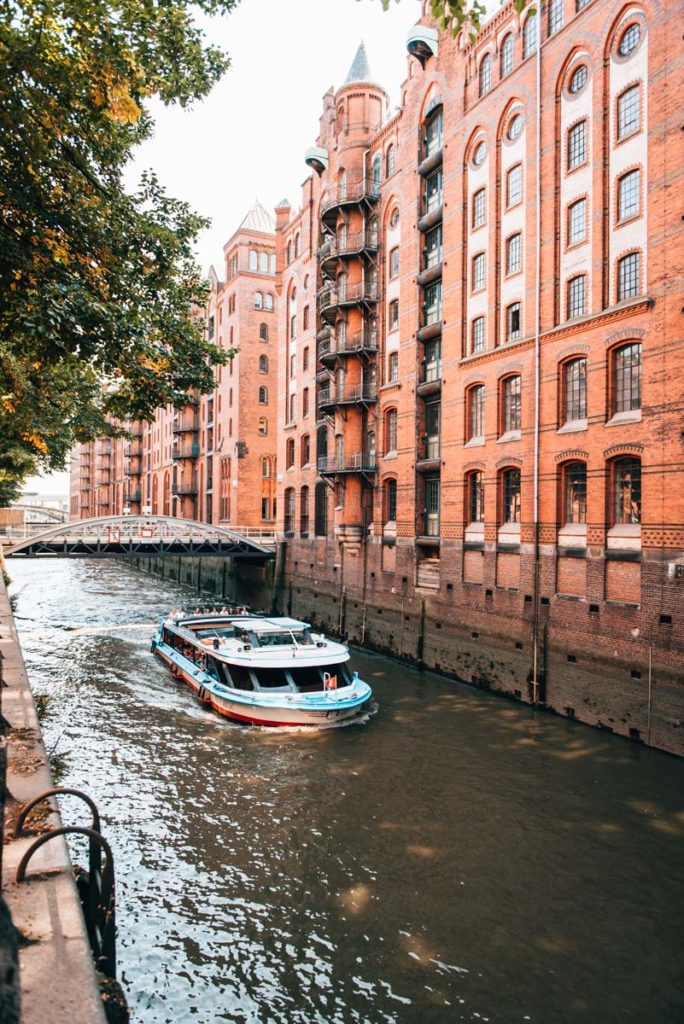
Interesting facts to know about Hamburg
Honestly, we don’t think we have ever met anyone who did not like Hamburg. If you like Port Cities and maritime scenes , then you will love Hamburg. There is water everywhere around and throughout the city: whether it’s by the harbour on the Elbe, or the very pretty Speicherstadt, or at the Alster.
- Hamburg is Germany’s second largest city after Berlin . Around 1.8 million people live in Hamburg.
- Hamburg is very large and a rather sparsely populated city . You can get around the city rather quickly and many of the highlights are either within walking distance or can be reached via the U-Bahn and S-Bahn trains.
- Although Hamburg is not located by the sea (the North Sea is about 100 kilometers away), its location on the Elbe gives Hamburg a maritime flair.
- Hamburg is actually the city with the most bridges in Europe! There are 2,500 bridges in Hamburg – more than in Venice or Amsterdam.
- The weather in Hamburg can be quite variable with a lot of rain. There are about eight to ten rainy days per month.
How much time should you spend Hamburg?
Hamburg is a great city for a weekend trip. You can explore most of the important sights in Hamburg in about 2 nights (3 days).
However, if you have more time to spend, then we would certainly recommend you stay longer. In our opinion, 3 to 4 nights is the ideal period to really experience Hamburg for the first time. That way, you will also have enough time to explore more local places off the beaten track.
When is the best time to visit Hamburg?
We ourselves have visited Hamburg in each of the four seasons and can confirm that no matter which season, Hamburg is always worth a trip. Good to know: the weather here is heavily influenced by its geographical location, therefore, it experiences quite a large amount of rainfall. We would suggest bringing an umbrella or a rain jacket with you just in case.
Personally, we love summer in Hamburg: the temperature is super nice and the days are long. It’s usually not too hot, but you do get the odd exceptions now and again. (Even we got caught in a decent heat wave during one of our visits.) Spring and Autumn are also very beautiful seasons for a trip to Hamburg.
Hamburg Bucket List: What shouldn’t I miss?
For those who want it short and sweet, here is a small best-of list for Hamburg. (Of course, more detailed tips about these things to do will follow throughout this travel guide.)
- Enjoy the view from the Michel, Hamburg’s most famous church.
- Admire the Elbphilharmonie – and ideally even attend a concert.
- Take a harbour tour and marvel at the large container ships.
- Eat a fish sandwich.
- Stroll through the Speicherstadt or, even better, take a boat trip through the canals.
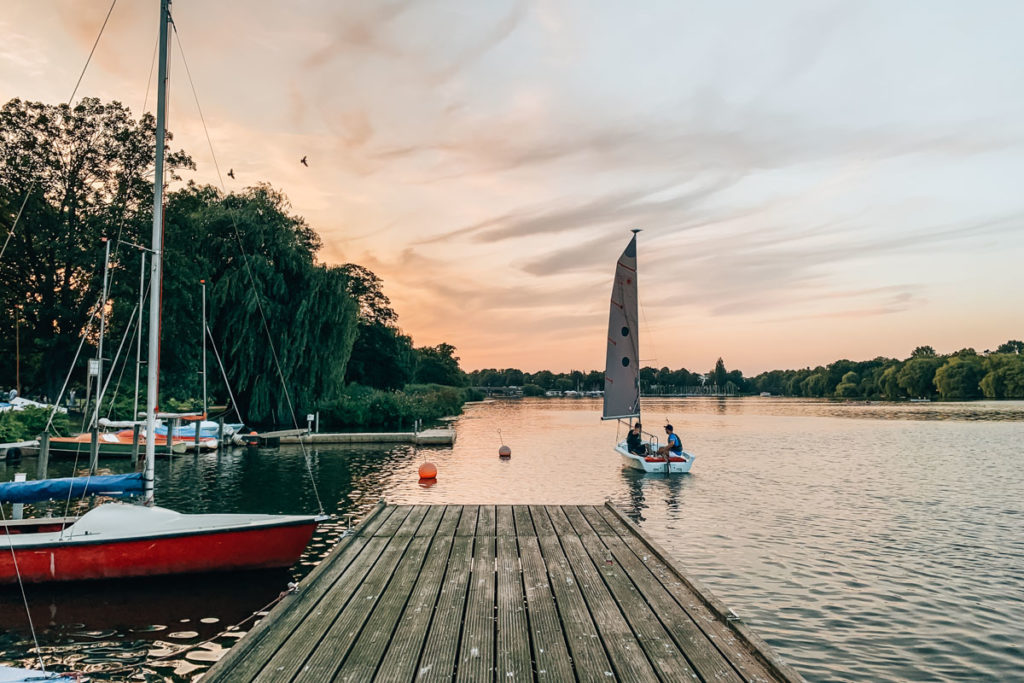
Jungfernstieg & Town Hall: Hamburg’s Old Town
If this is your first time in Hamburg, then a good starting point would be the area around the Jungfernstieg. You will find yourself by the Binnenalster – an artificial lake, which is fed by the river Alster. There are some magnificent buildings along the shores of the Binnenalster.
Just a few minutes walk from the Jungfernstieg is one of the most beautiful buildings in Hamburg: the town hall . This Neo-Renaissance building is not only surprisingly large, but also incredibly beautiful. The courtyard of the town hall is also very worth seeing if you’re in the area.
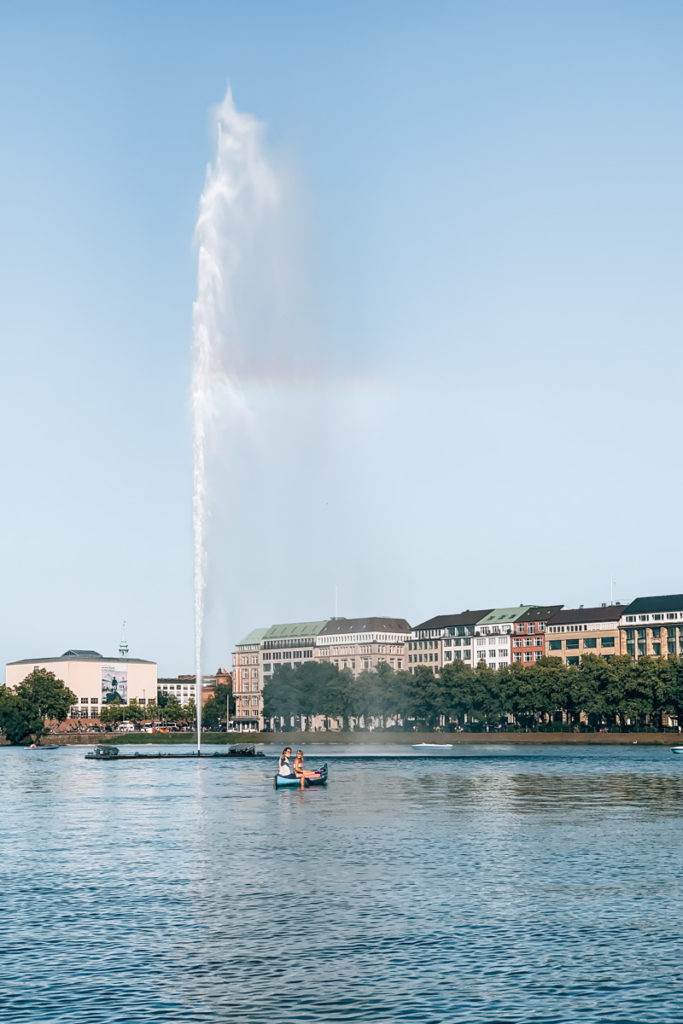
Main Church of St. Michaelis: The Michel
The most famous church in Hamburg is nicknamed the Michel . You can get here from the town hall in about 15 minutes by foot. The inside of the church is well worth seeing, but the Michel is best known for its church tower: high up at the observation deck of the 132-meter-high tower, you can enjoy a magnificent panoramic view of the city.
You can either walk up the tower (453 steps) or choose to go up with the lift – the price is actually the same for both options. The 360-degree view from high above Hamburg is just stunning and although you are behind safety bars, you can easily photograph through them .
For a super unique experience, you could also visit at night. They call this Nachtmichel (or Night Michel in English) and you can visit in the evenings, past regular opening hours, on many days of the year. However, the prices are a little higher.
Information about the lookout point from the Michel Church
Price: 8 Euros (during the day) or 11.50 Euros (at night) Opening hours: November to March from 10am to 6pm, April and October from 9am to 7pm, May to September from 9am to 8pm (last admission half an hour before closing time); The opening times for the evenings can be found here: Nachtmichel
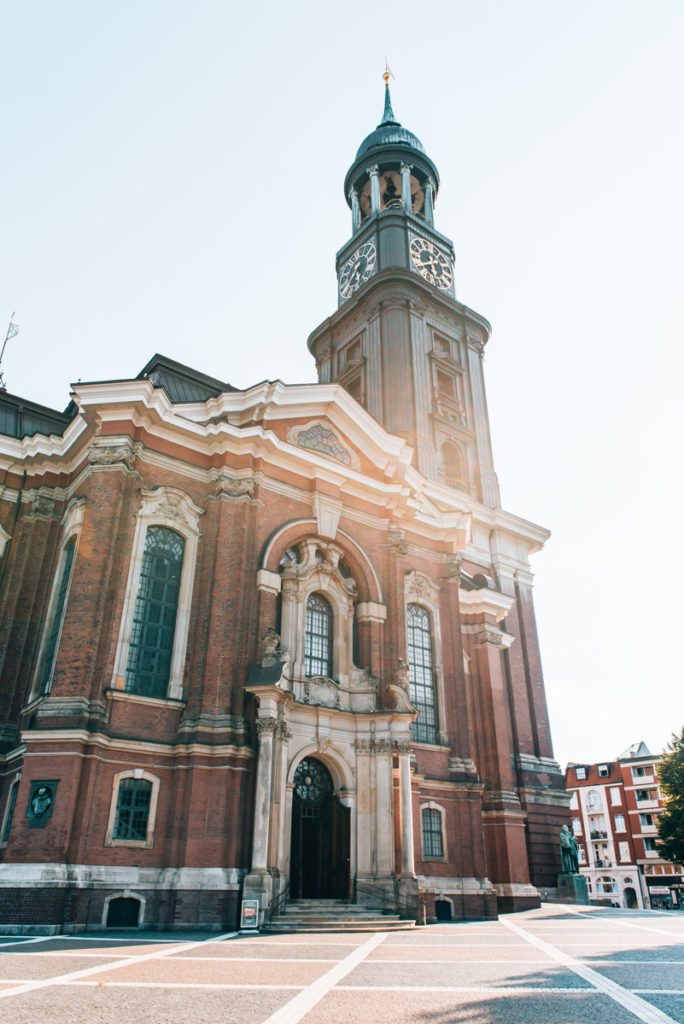
Elbphilharmonie
Since November 2016, Hamburg has a new landmark: the Elbphilharmonie – a modern concert hall enthroned on the banks of the Norderelbe. Despite the many controversial opinions, we think that the Elbphilharmonie fits in very well with its surrounding cityscape.
The dream would be, of course, to attend a concert in the famous Great Hall . We were able to experience that on our last visit to Hamburg. Coveted concerts are usually sold out within minutes, so it’s not that easy.
Alternatively, you still have the opportunity to visit the Elbphilharmonie as part of a public concert hall tour , where you also get access to the Great Hall. This tour takes about an hour and costs 20 Euros per person. Important to know: If you want to see the Great Hall, then we would strongly recommend you book your tour through the official website of the Elbphilharmonie (or at the actual ticket office). This is because most guided tours booked through other sites won’t include access to the concert halls!
The cheaper alternative is to visit the viewing platform , which is located 37 meters high between the brick base and the glass structure – this viewing platform is called Plaza. If you go to the Elbphilharmonie visitor centre, you can receive a ticket for the same day free of charge (if there are still enough tickets for that day). If you want to buy your ticket online in advance, it costs an extra 2 Euros.
Information about the visit to the Elbphilharmonie
Price for official concert hall tour: 20 Euros Price for the Plaza (viewing platform): free or 2 Euros (for tickets in advance)
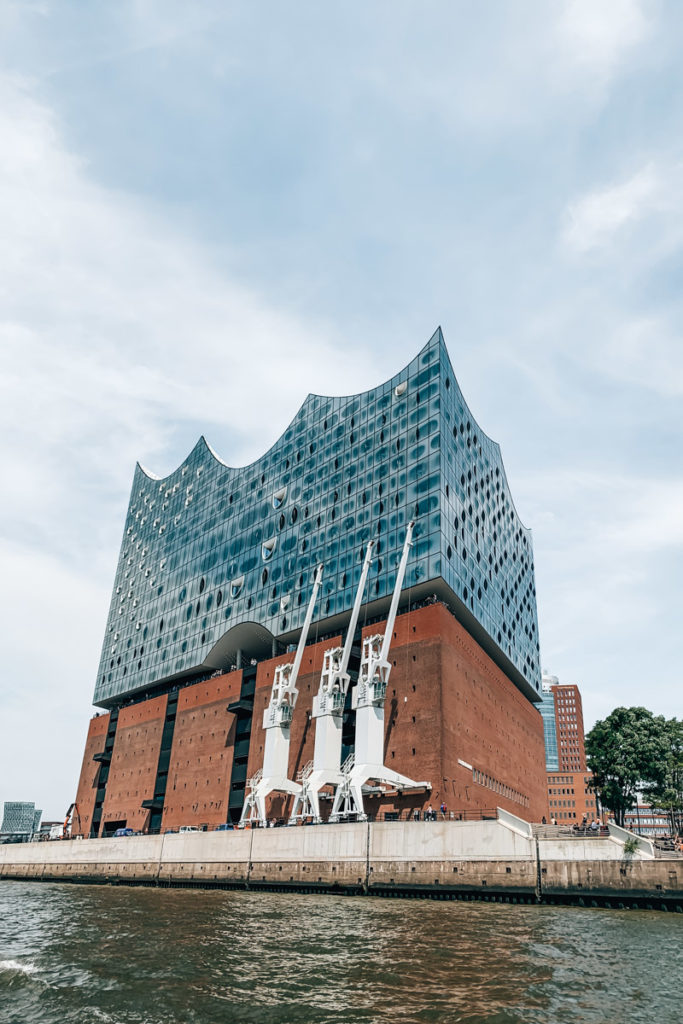
Speicherstadt & HafenCity
Nearby the Elbphilharmonie is the very unique and photogenic Speicherstadt . This historic brick ensemble is indeed the world’s largest historic warehouse complex. The Speicherstadt is a UNESCO World Heritage Site and in our opinion one of the coolest places in Hamburg.
Thanks to the numerous bridges, you can explore the Speicherstadt by foot. It is also very worthwhile to see the Speicherstadt from the water and you can do this as part of a harbour tour. There are countless tour providers, each with different routes – some even offer trips in the late evening. We will share with you more information about these harbour tours later in this travel guide.
One of our highly recommended stopovers in the Speicherstadt would definitely be the Speicherstadt Kaffeerösterei , where you can enjoy delicious coffee from their special house-roasted coffee beans. Incidentally, one of the most famous photo opportunities in the Speicherstadt is at the intersection of the moated castle , which you can see in the first photo.
The Speicherstadt is bordered by the modern HafenCity . This district is also home to the Elbphilharmonie and there is no other place in Hamburg, which evolves as fast as the HafenCity. New buildings are constantly being constructed and the HafenCity is said to be completed by 2025.
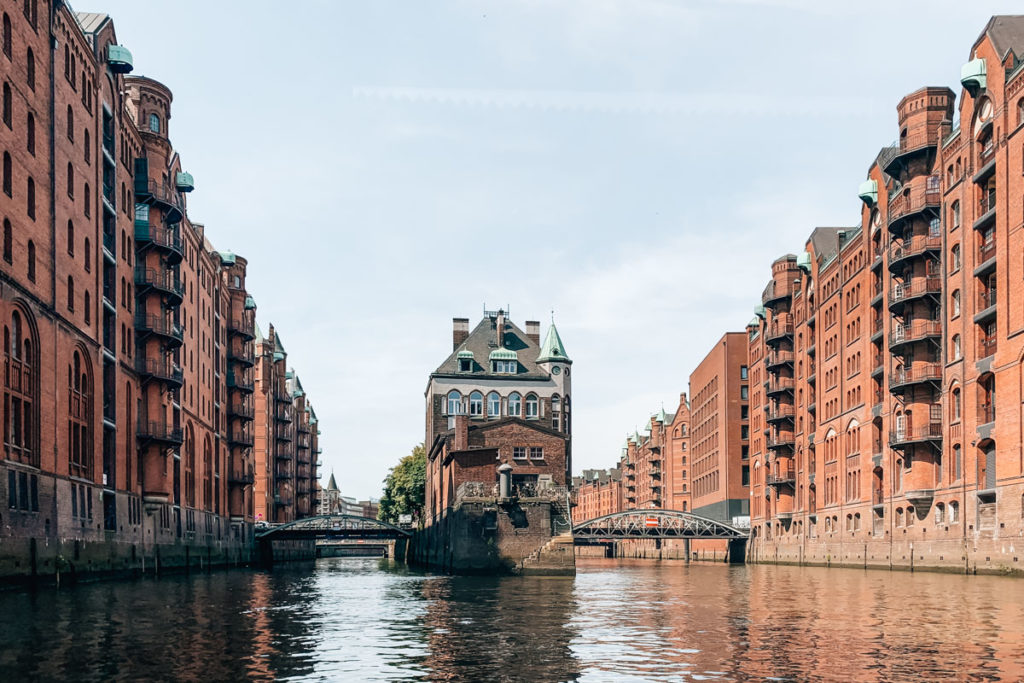
Landungsbrücken & Old Elbe Tunnel
The so-called Landungsbrücken on the Norderelbe are your starting point if you want to explore the port of Hamburg. This is where the countless harbour tours start. The Landungsbrücken are generally a very touristic place but also really worth seeing in Hamburg.
One of the most famous things to see at the Landungsbrücken is the Old Elbe Tunnel. Opened in 1911, this tunnel crosses the Norderelbe at a depth of 24 meters and connects the Landungsbrücken with the Elbe island of Steinwerder.
The Old Elbe Tunnel is exactly 426.5 meters long and can be used both on foot and by bike (although no longer by car) free of charge. It’s a cozy 15 to 16 degrees down here – a pleasant cooling off in summer.
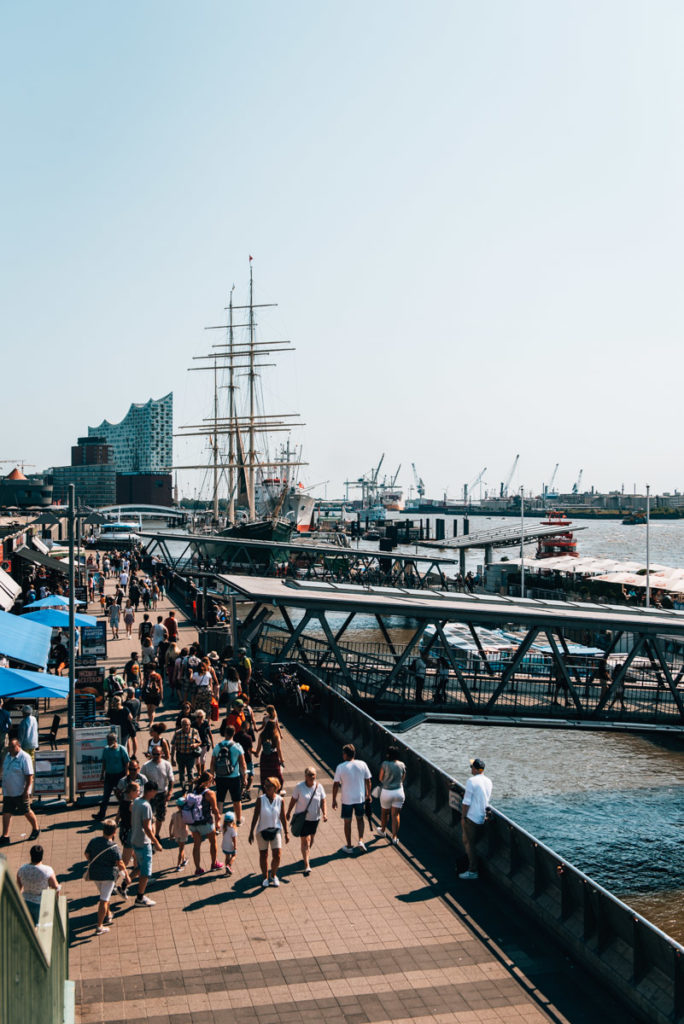
Nikolaifleet & Deichstraße
A so-called “Fleet” is a canal and there are a lot of them in Hamburg. One of the most famous canals is the Nikolaifleet. Here you will find Hamburg’s oldest preserved town houses and with them probably the most beautiful building ensemble in Hamburg. You have a nice view of the houses from the High Bridge.
Of course there were many more of these characteristic houses in Hamburg. Unfortunately, countless of them fell victim to the great fire in 1842 that destroyed two thirds of downtown Hamburg.
Deichstraße, one of the most picturesque streets in Hamburg, runs along the back of the town houses. You should definitely not miss this street.
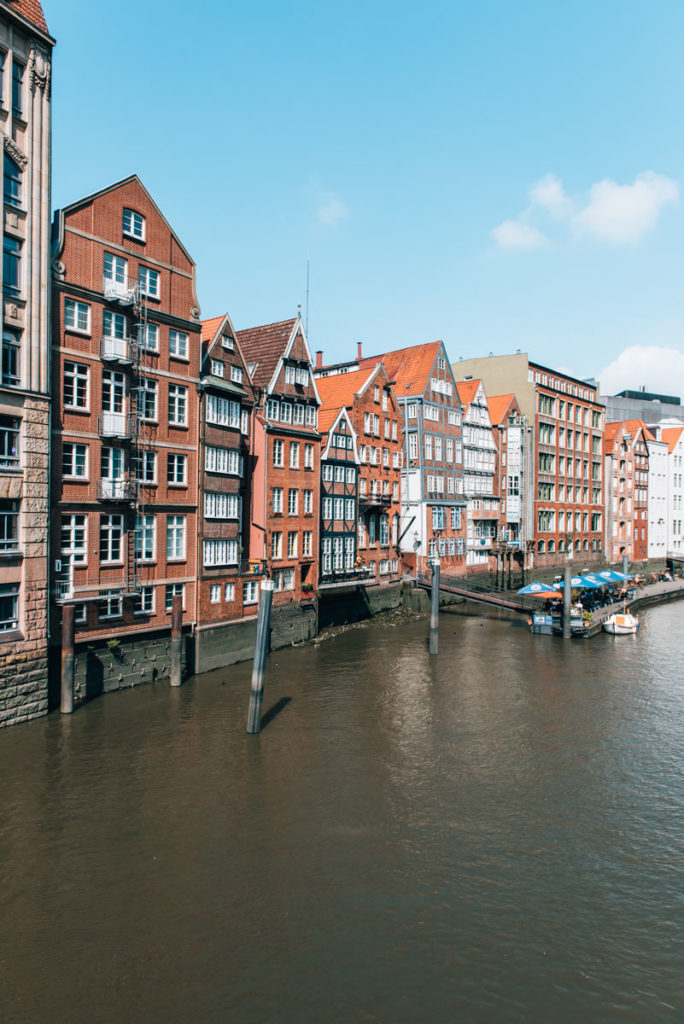
Memorial St. Nikolai
Another well-known thing to see in Hamburg is not far from the Nikolaifleet and can be seen from afar: the St. Nikolai memorial. If you are thinking of a church, you are absolutely right.
The ruins of the main church of St. Nikolai now house a memorial dedicated to the victims of the war between 1933 and 1945. Large parts of the church were destroyed during World War II. Only the tower, part of the southern outer wall and the walls of the chancel have survived.
The memorial is free of charge, but there is a fee for the museum on the lower floor. If you want, you can also take the glass panorama elevator to the viewing platform at a height of 76 meters.
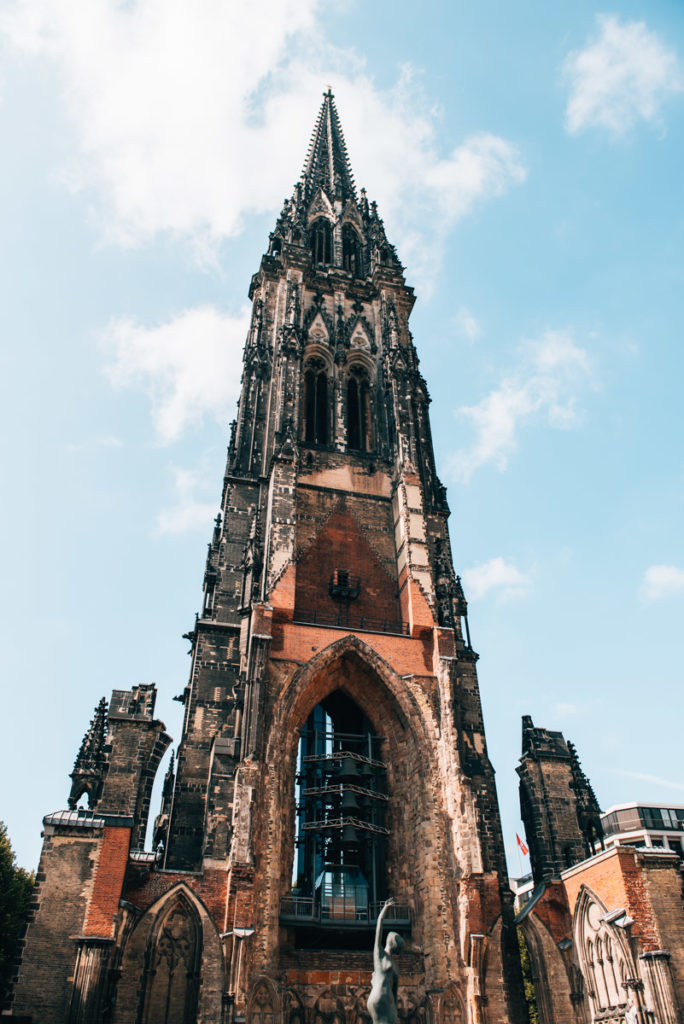
Hamburger Kunsthalle (Art Museum)
The perfect tip for rainy weather! The Hamburger Kunsthalle is one of the most famous museums in Hamburg. It is home to works from the Middle Ages to modern and contemporary art. Art from seven centuries can be admired here.
One focus is on works from the 19th century and paintings by the old masters. Because the Kunsthalle is really spacious and the collection is extensive, we recommend a stay of at least two to three hours.
Information about the visit to the Hamburger Kunsthalle
Price: 16 Euros Opening hours: Tuesday to Sunday from 10am to 6pm, Thursday from 10am to 9pm
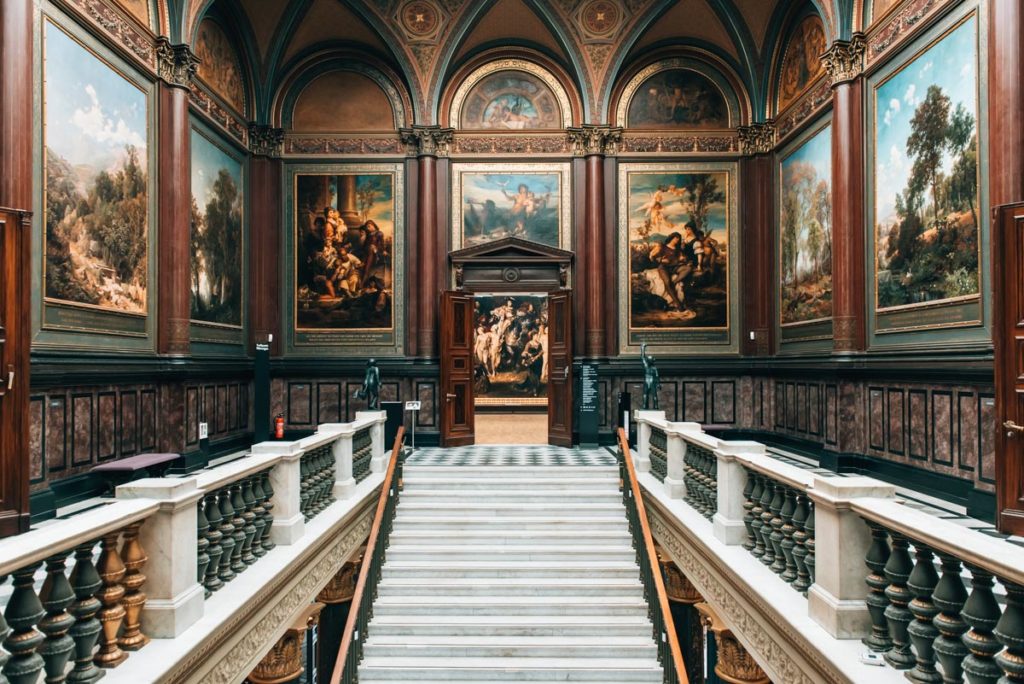
Karolinen- and Schanzenviertel: Hipster District of Hamburg
Together, the Schanzen and its neighbouring district – Karolinenviertel (or Karoviertel as it’s often called) come to form one of our favourite areas in Hamburg. They are both considered the trendy, hipster districts of Hamburg and you will find plenty of great boutiques here, as well as nice cafes and restaurants.
A good starting point to explore this area would the S-Bahn or the underground station Sternschanze . Should you feel like it’s time for a coffee hit, then you should stop by Café Elbgold. In our opinion, the coffee here at Elbgold is one of the best in Hamburg. You will also find nice restaurants and shops along Susannenstraße and the Schulterblatt. (Café Herr Max is another cafe worth visiting – although it’s not exactly a secret.)
From the Schanzenviertel district, you are just a stone’s throw away from its neighbouring district of Karoviertel . There you will come across some amazing street art . Just walk along the market street and perhaps peep into the odd courtyard here and there.
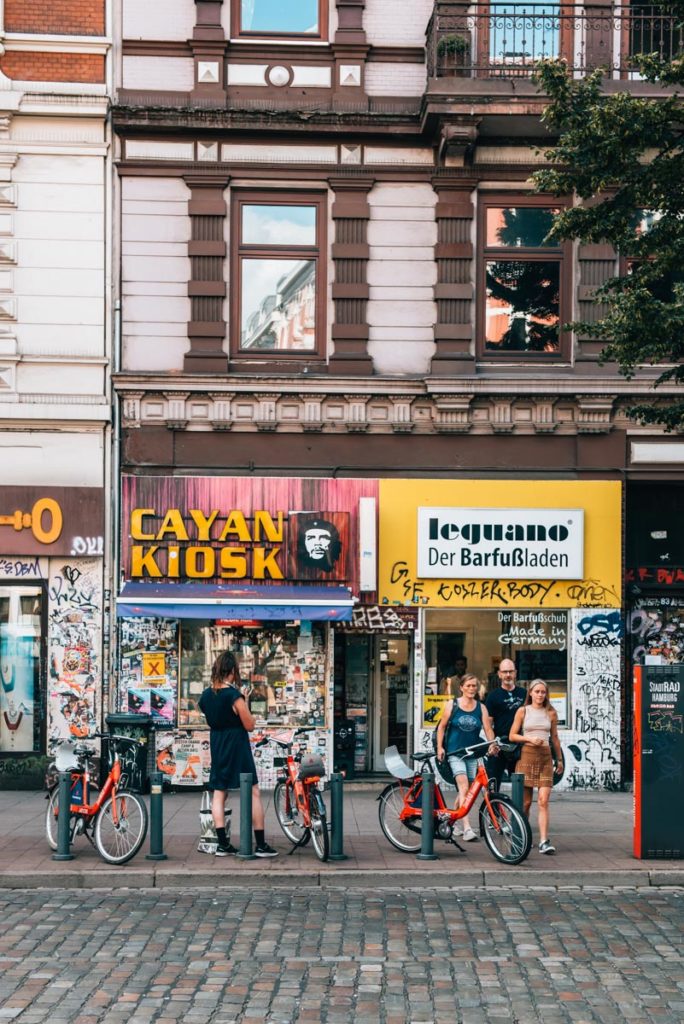
Fish Market Hamburg
A visit to Hamburg’s Fish Market is quite an experience and it takes place every Sunday on the banks of the Elbe. Unfortunately, you have to get up rather early : In winter, the market starts at 6 am, and even earlier than that in the summer – 5 am. By 9:30 am, the spectacle is already over.
You will see sellers fighting for the attention of the buyers. Many stalls also sell fruits and vegetables, so don’t expect just fish and seafood as the market offers much more than that.
Every Sunday, there is a huge brunch offered with live music in the Fish Auction Hall. The price per person is 22 Euros and the brunch goes until 12 pm / noon. If that’s something you would like to experience, then we would highly suggest making a reservation. You can find more information here: Fish Auction Hall (website in German only).
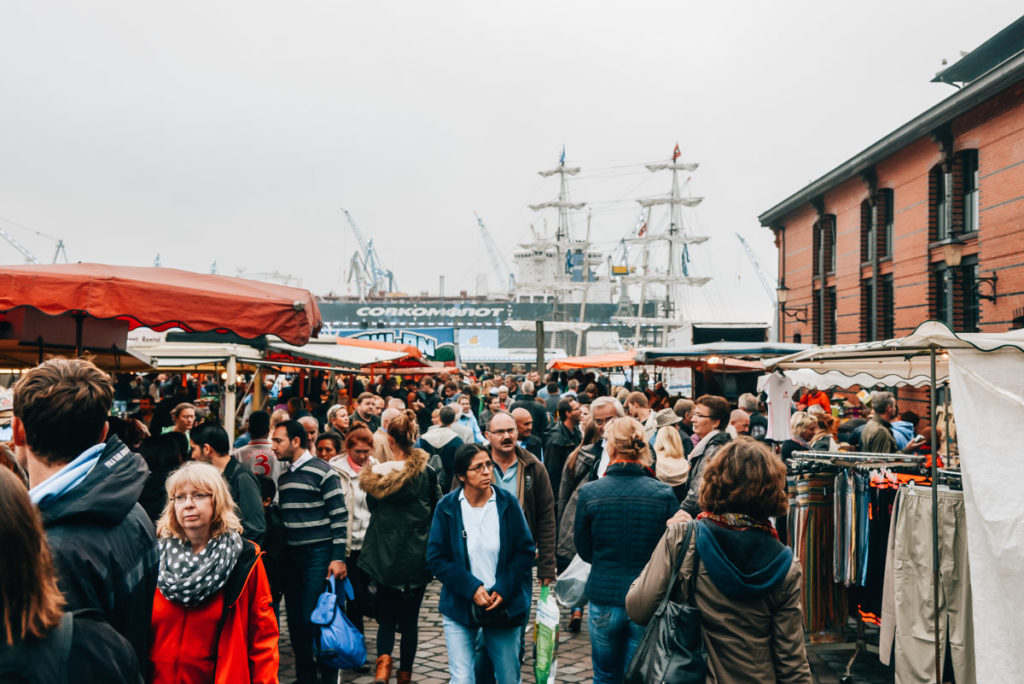
Reeperbahn in St. Pauli
We weren’t sure whether or not to include the Reeperbahn in our list, but somehow it just belongs to Hamburg and we couldn’t leave it out. The Reeperbahn is a synonym for the Red Light District of Hamburg in St. Pauli. This notorious street is the number one entertainment district in Hamburg.
You will find countless bars and nightclubs along the Reeperbahn (and in the back alleys) – most of them are not what we would personally call “inviting”. But if you really want to party hard, then this is a place to consider.
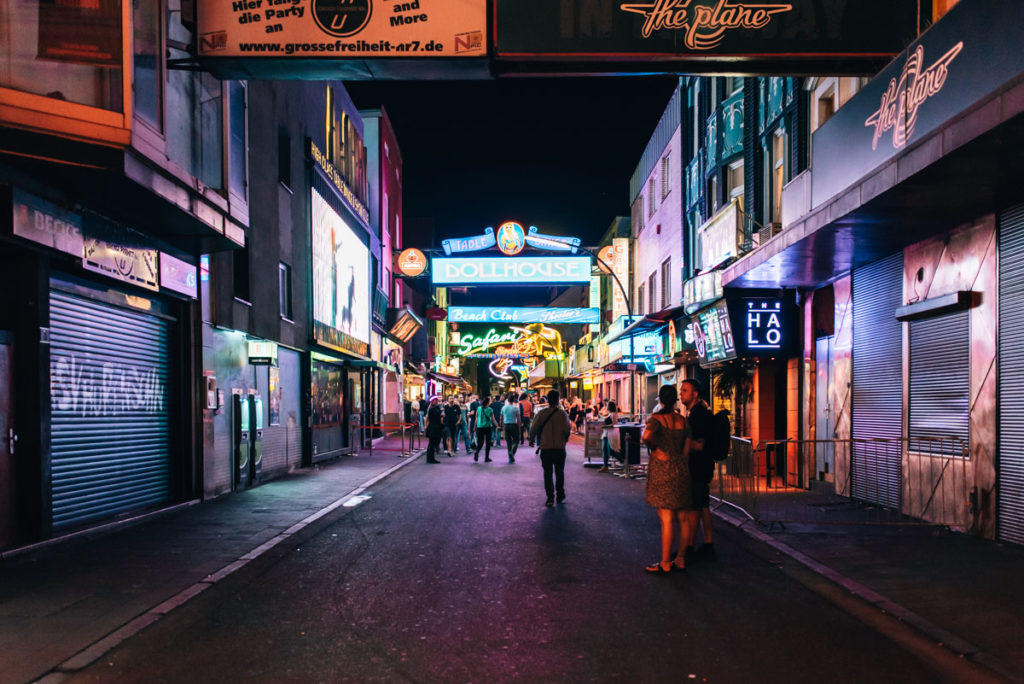
Harbour Cruise
A typical sightseeing activity for Hamburg usually includes a harbour cruise. We ourselves have experienced this several times. Exploring Hamburg from the water is such a unique and special experience – we can only highly recommend you experience it for yourselves.
There are countless providers offering harbour cruises with a variety of ships and routes. Most ships depart from the Landungsbrücken and when you get there, be prepared to be overwhelmed by the amount of harbour cruise offers.
The classic cruise is the socalled “Große Hafenrundfahrt” which takes two hours. As the name suggests, you will get very close to the harbour and you will see the gigantic container ships, for example.
Depending on the water level (and of course the chosen route), the big harbor tours also lead through parts of the Speicherstadt. However, if you are primarily interested in the Speicherstadt or the canals in Hamburg, you are better advised to take a canal trip. (We’ll tell you more about that in a moment.)
Our tip: Make sure to be at the Landungsbrücken preferably 30 minutes before departure. You have to find your way around the many docks and find the right boat.
You can book the tour here: Harbour Cruise

Tip # 1: Fleetfahrt from Jungfernstieg
The centre of Hamburg is intersected by several canals, known as the “Fleete” and these historic canyons can be explored as part of a cruise. The journey takes about two hours and unlike most other harbour cruises, they actually start on the Jungfernstieg (Binnenalster). From there it goes through the canals in the centre of Hamburg and towards the Speicherstadt. After that, you will get to see the port of Hamburg and go past the Elbphilharmonie. You usually won’t get close to the container ships.
However, the Fleetfahrten are tide dependent – meaning they can only take place when the water level is at an appropriate level. The route may also change depending on the tide and you might pass through several locks or channels. It’s quite an exciting experience, but you have to be prepared to wait a while.
You can find more information about the prices and the departure times here: Fleetfahrt . We recommend that you check the departure times directly at the Jungfernstieg ticket counter the day before and book the ticket for the next day.
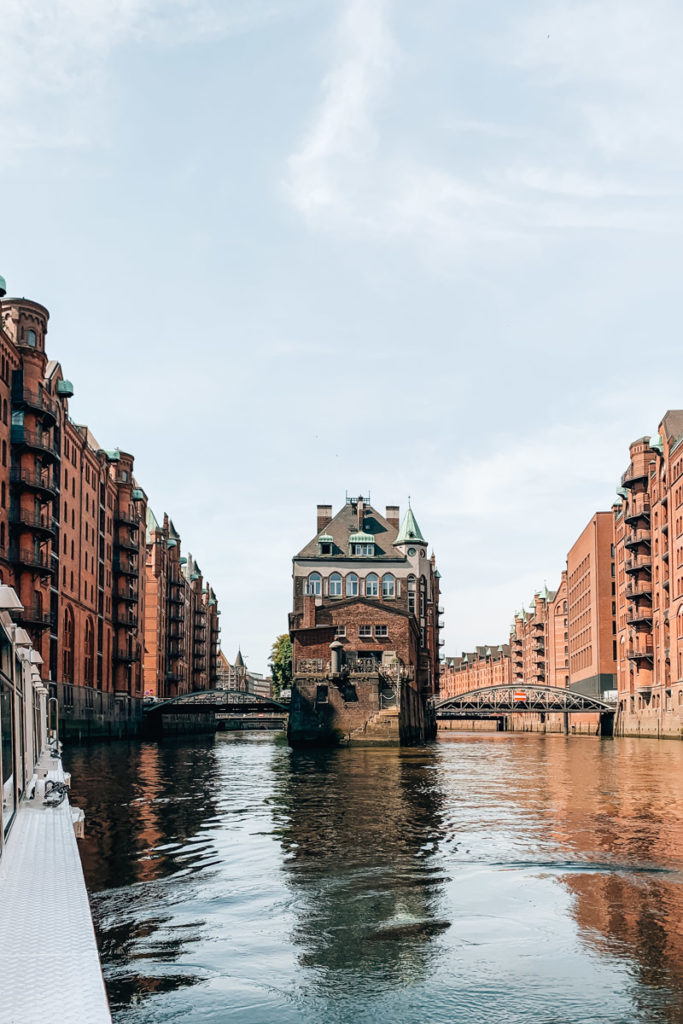
Alsterrundfahrt Tour
After the harbour cruise, the second most popular boat tour in Hamburg would be the Alsterrundfahrt Tour – along the Alster River. Personally, we found the harbour cruise more exciting, but can nevertheless recommend a boat tour along the Alster.
The classic Alsterrundfahrt starts at the Jungfernstieg and takes you across the Binnenalster and the Außenalster for about 1 hour . As you cruise along the shore, you’ll learn some background information about Hamburg and specific individual buildings along the tour.
You can buy your ticket in advance here: Alster Boat Trip
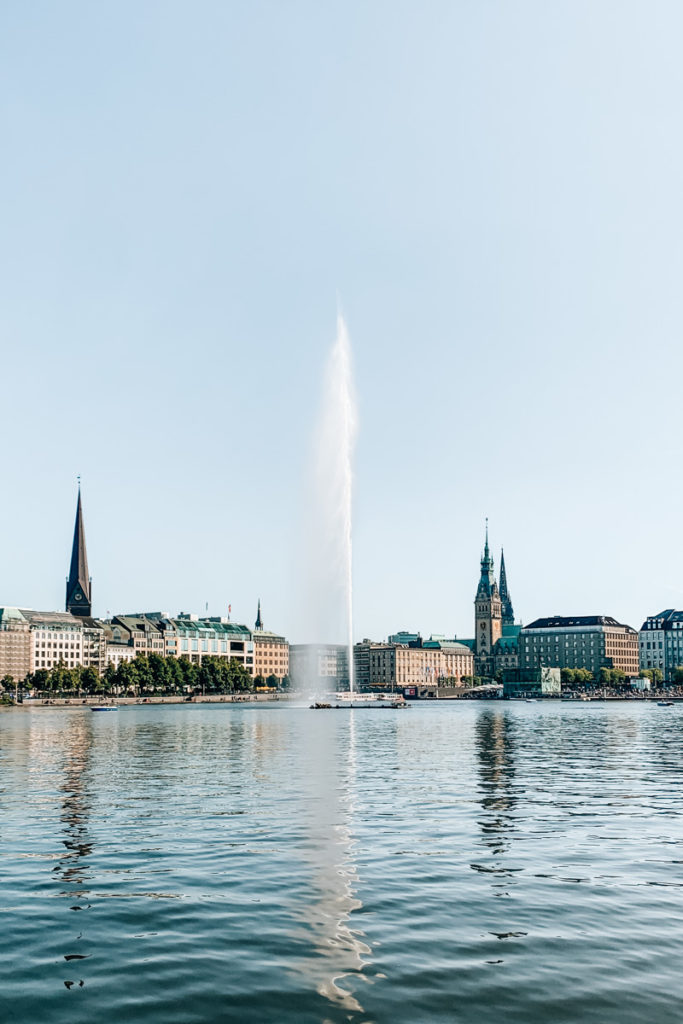
City Tours in Hamburg
We had a fantastic city tour a few years ago in Hamburg and although we often like to explore cities on our own, we have to admit that this city tour made quite the impression on us. So if you want to know a little more information about Hamburg, we can highly recommend you to take part in a city tour.
Free Walking Tours in Hamburg
There are several providers for free city tours in Hamburg and one of the more highly recommended (and entertaining) tours can be found by SANDEMAN’s New Europe Tours. You’ll get a guide that takes you through Hamburg for about 2.5 hours and shows you the most important sights. The tour is free, but of course you should give a reasonable tip.
You can find more information here: FREE Tour from Hamburg
Extra City Tours in Hamburg
In addition to these free walking tours, there are countless other offers for city tours in Hamburg. Most focus on a specific topic (for example, Reeperbahn or Speicherstadt).
With the Hamburg CARD you can get a discount on certain city tours. To find out exactly which ones, you can find the information on the official website of the Hamburg Tourism Board: City Tours with the Hamburg CARD .
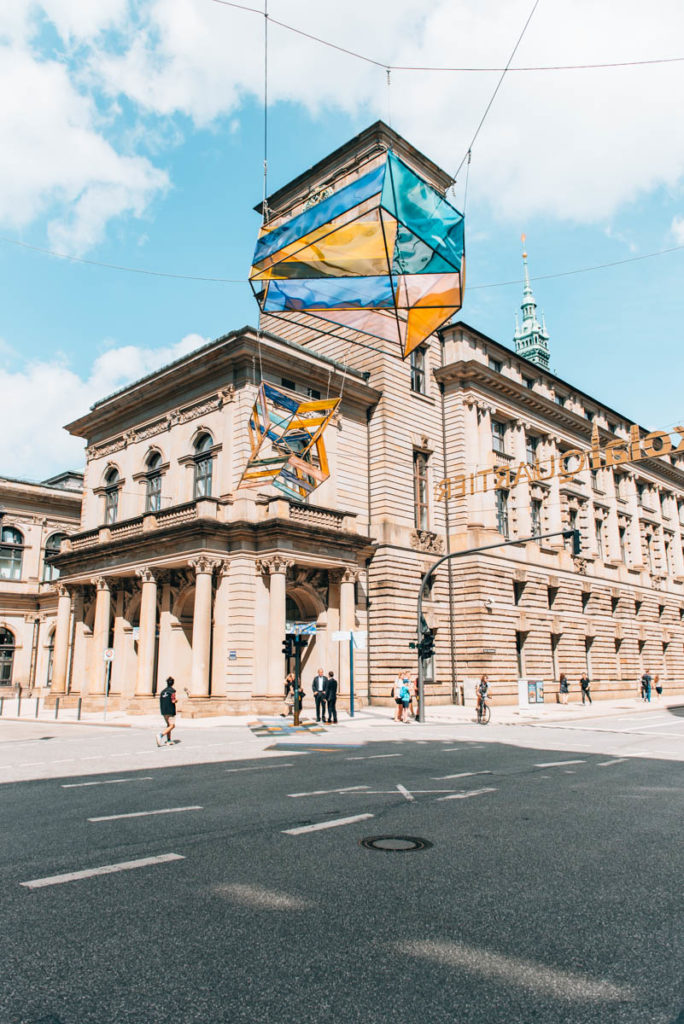
Herr Max: Very nicely furnished café in Schanzenviertel. Our recommendation: Try the cheesecake, which is ridiculously good. The breakfast is also said to be very delicious here.
Café Elbgold : In our opinion, the best coffee in Hamburg can be found at Café Elbgold, with special house-roasted beans. The Café Elbgold actually has several locations in Hamburg, but the largest café (and where they roast their beans) is located in Schanzenviertel.
Kaffeerösterei Speicherstadt: This coffee roasting house is located in a historic brick building in the Speicherstadt. Not exactly a secret, but can definitely recommend for a quick coffee break.
Nord Coast: Very popular café that supposedly serves amazing breakfasts. Unfortunately, the queue in front of the restaurant was a bit too long for us, so we did not get the chance to try it out.
Hoppe’s Restaurant: A popular fish restaurant by the water with fair prices. The restaurant is located outside the center at the Elbe beach. We recommend you to take the ferry (line 62) from Landungsbrücken.
NENI Hamburg: No matter which NENI you go to, you just know what you’re going to get – high quality Israeli cuisine with nice chill vibes. We really liked it here and can definitely recommend you stop by too!

25hours Hotel HafenCity
This very hip, individual boutique hotel is located in HafenCity. We love the design of the rooms. They are designed as ship cabins, which are very comfortable and well equipped – as you would expect from 25hours hotels. The breakfast is excellent, albeit a little expensive.
The location of this hotel is very central: you can reach the Elbphilharmonie in just 10 minutes by foot and the subway station is right on the doorstep. Conclusion: If you want to stay in a young boutique hotel, you are in good hands here.
You can view and book the hotel here: 25hours Hotel Hamburg HafenCity
AMERON Hamburg Hotel Speicherstadt
This design-hotel is located in the middle of the Speicherstadt. The rooms are quite small, but very cozy and we found the atmosphere very pleasant.
The location is amazing: The Speicherstadt is one of our favourite places in Hamburg, it just has so much character. Many of the hotel rooms here also overlook the canals of the Speicherstadt. If you are looking for a stylish, exceptional hotel, then this is the right choice for you.
You can view and book the hotel here: AMERON Hamburg Hotel Speicherstadt
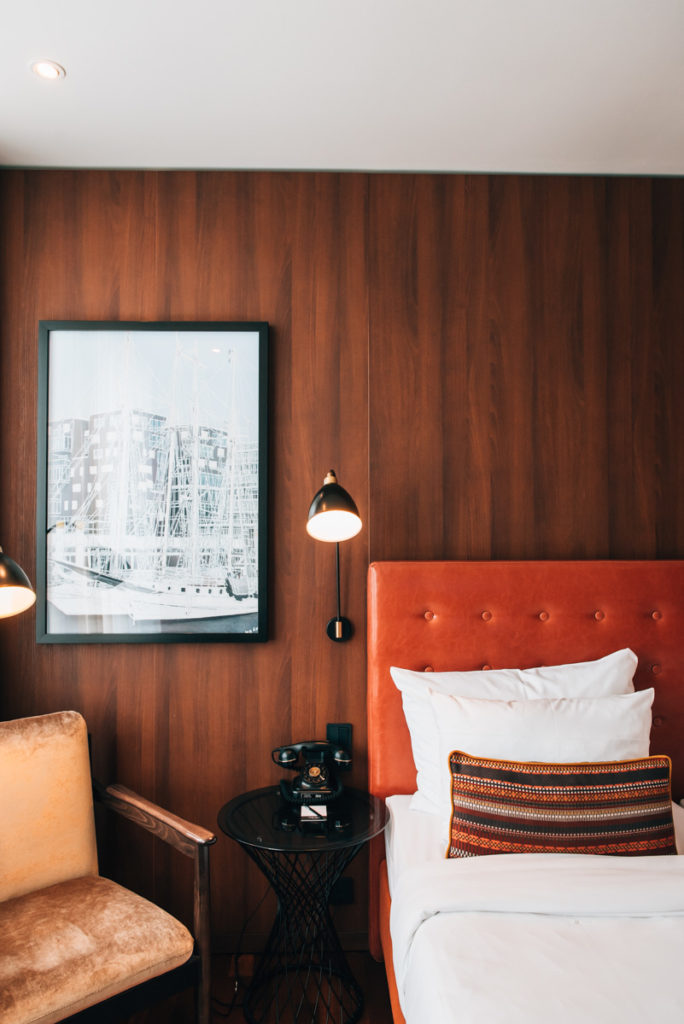
Disclaimer: Affiliate Links
This travel guide contains our personal recommendations in the form of affiliate links. If you book or buy something through these links, then we will receive a small commission. But this does not change the price for you at all – it’s just an awesome way for you to support this blog. A million thanks from the both of us!
Have you ever visited the beautiful Hanseatic city of Hamburg? What did you think of it? What are your top things to do and see in Hamburg? If you have any personal tips for Hamburg, we would love to hear them! See you in the comments down below!
You might also be interested in this
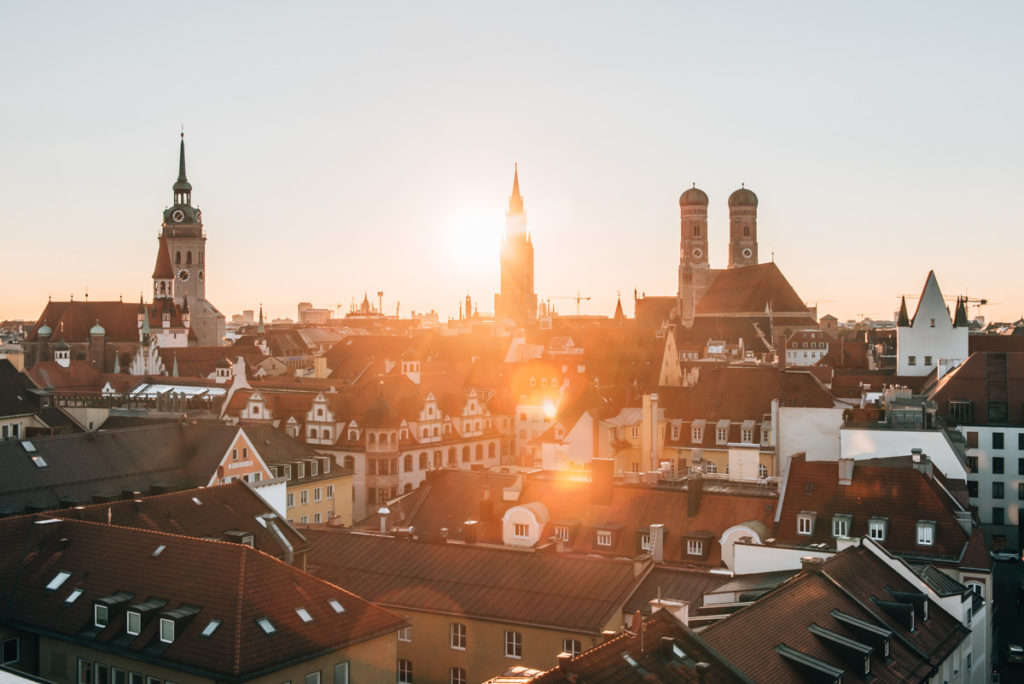
Munich Travel Guide: Best Attractions & Top Things to Do
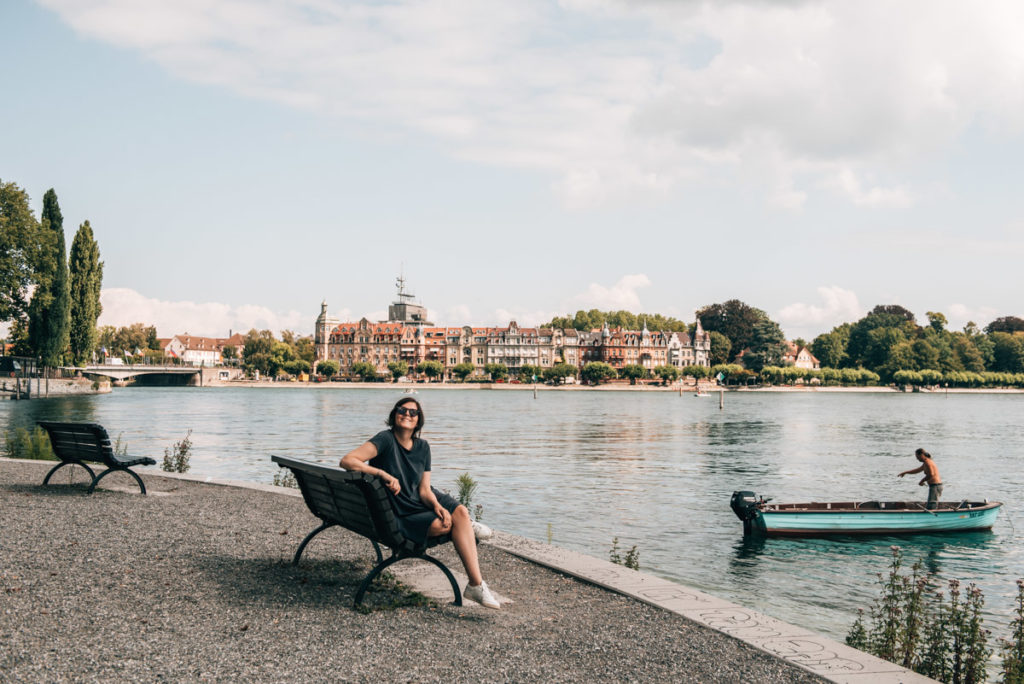
Konstanz Travel Guide: Top Things to Do and See around Lake Constance
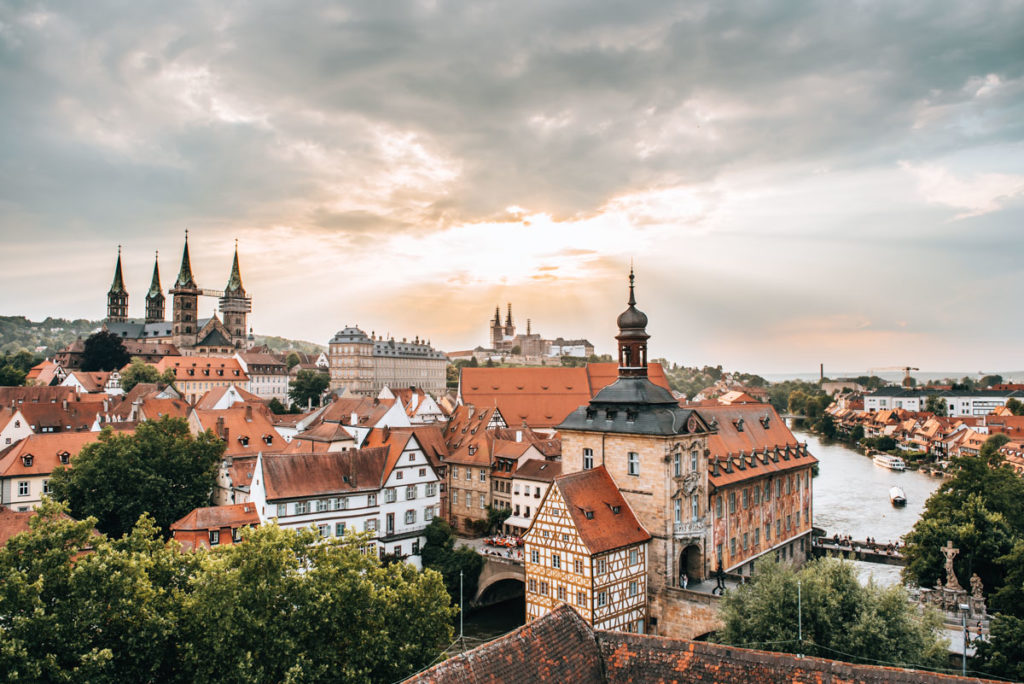
Bamberg Travel Guide: Tips for a Weekend Getaway
Leave a reply cancel reply.
Your email address will not be published. Required fields are marked *
- Privacy Policy
Travel Europe on a Budget
The Savvy Backpacker
City Guides .\33 a132798-3f3b-4585-954d-7e70cf863447{fill:#231f20}
Hamburg travel guide | our in-depth visitor’s guide to exploring hamburg.
The COMPLETE guide to everything you need to know about visiting Hamburg, Germany.
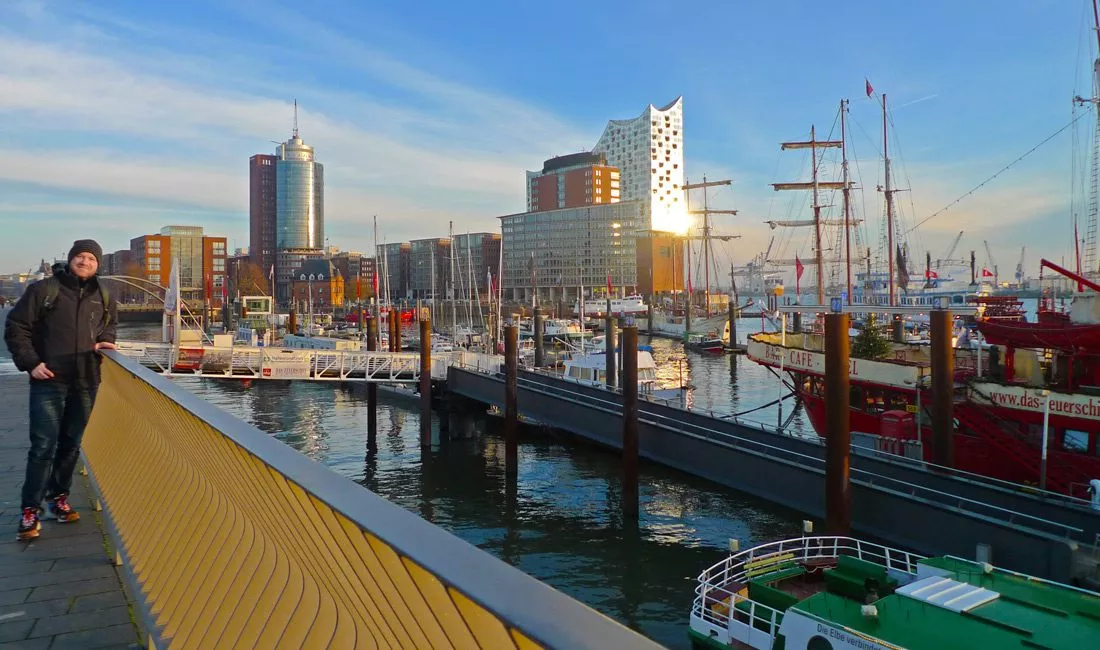
Hamburg often gets overshadowed by the tourism behemoths of Berlin and Munich but this welcoming city has quietly become one of Europe’s must-visit cities for in-the-know travelers. It’s ultra-modern and socially progressive while sticking to its old-world roots. It’s home to some of Germany’s (and Europe’s) best bars, restaurants, and nightlife. It’s no wonder why it’s considered Germany’s most livable city.
In this Hamburg Travel Guide, we’ll cover everything you need to know about visiting this bustling port city — including what to see, where to eat and drink, and how to experience the best that Hamburg has to offer.
I wanted to thank the Come To Hamburg project for inviting me to visit this great city and for the great and budget-friendly Heikotel am Stadtpark for hosting me while I visited.
Daily Costs To Visit Hamburg
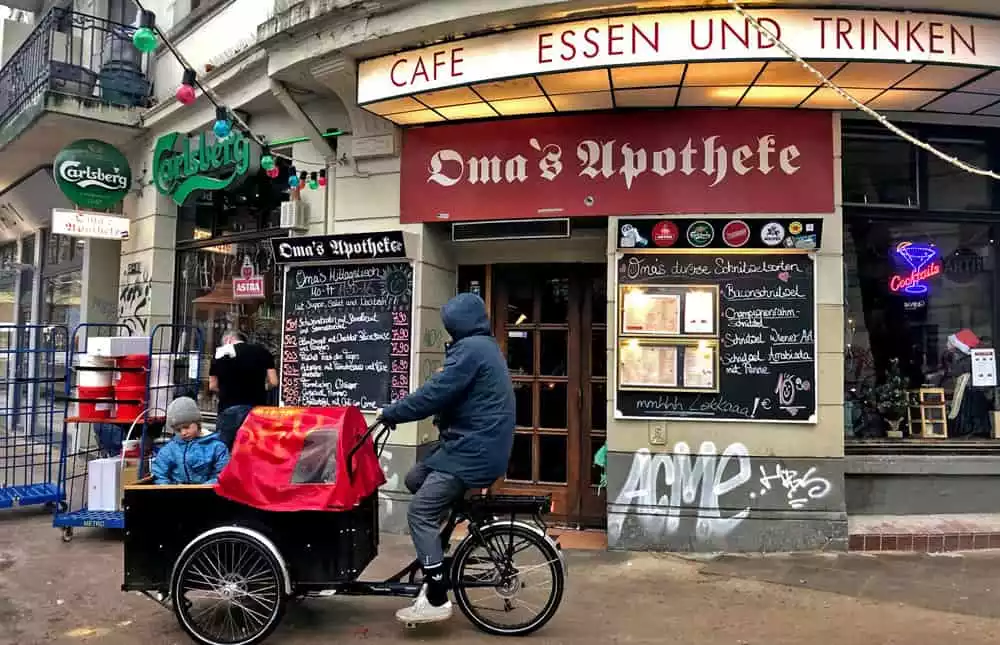
Hamburg is one of Germany’s most expensive cities so budget travelers will have to watch their wallet — but there are plenty of ways visit on a budget. We estimate that budget travelers will spend an average of €40-€70/day. That said, you can easily spend a little less or quite a bit more depending on your travel style. Check out our Hamburg Price Guide to get a better estimate of travel costs.
In general, your biggest expenses will be accommodation, food, and alcohol. Luckily, there are a decent number of budget-friendly restaurants and the beer tends to be fairly cheap if you know where to look.
How Long To Visit Hamburg: 2-4 Days
Hamburg isn’t chock-full of “must see” tourist sights so you can see the highlights in about two days. However, the real charm of Hamburg comes from exploring the city’s neighborhoods, experiencing its famous nightlife, and sampling the city’s diverse cuisine that’s a result of Hamburg’s long history of being one of Europe’s busiest port cities.
Don’t forget that Hamburg is a good home base for multiple day trips to cute neighboring towns and villages.
Hamburg: The Good & Not-So-Good
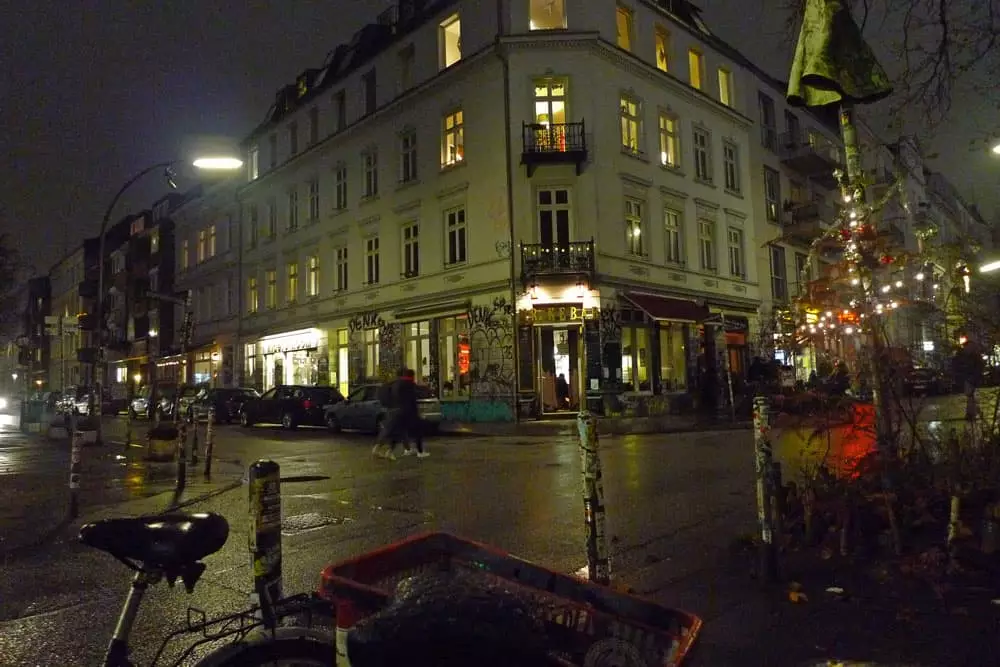
Every city has both good and not-so-good things about it. Below are a few things that stood out to us.
- Nightlife: Berlin may be world-famous for its nightlife but many Germans argue that the country’s real nightlife champion is Hamburg. Either way, it’s easy to find a party if you’re looking for one.
- Not Touristy: Hamburg’s international visitors are rising in numbers but it’s still largely off the well-trodden tourist trail.
- Germany’s Capital of Cool: There seems to be an ongoing battle about which city is Germany’s “Capital of Cool” — some say Berlin, some say it’s Leipzig, and others say it’s Hamburg. There may never be a consensus but it’s safe to say that Hamburg oozes that cool factor.
- The Water: Whether it’s the massive port, the multiple canals (and its 2000+ bridges) or the city’s two lakes, it’s no doubt that Hamburg’s entire history has revolved around the water. This comes very clear when the weather warms up and the locals flock to the water.
- Greenspace: Hamburg has numerous parks and other green spaces so it’s easy to escape the bustle of the city.
- Public Transportation: Public transportation is excellent in Hamburg so traveling around is a breeze. Furthermore, the airport is well-connected to the city center so you don’t have to worry about taking an expensive taxi.
- Diversity: Historically, port cities tend to be more diverse since there is a constant influx of new people coming and going — and Hamburg is no different. The people of Hamburg embrace this sense of diversity so they’re very welcoming to different cultures, ideas, lifestyles, and the LGBT community.
- Architecture: Hamburg was essentially leveled during WWII. When it came time to rebuild, the city embraced both classic German and modern architecture so it’s common to see all-glass buildings next to old-looking brick buildings.
- Not Your Stereotypical Germany: Hamburg feels a bit more like Scandinavia than “traditional” Germany so it’s a nice change of pace if you’re doing a tour of Germany.
- Bike Friendly: While it’s no Copenhagen or Amsterdam, Hamburg is regularly ranked one of the top 20 most bike-friendly cities. There is a successful bike share program or there are multiple ways to easily rent bikes.
Not-So-Good
- Prices: Hamburg isn’t as expensive as Scandinavia but it ain’t exactly cheap either.
- Cold and Rainy Winters: Winters in Hamburg tend to be grey, wet, and windy thanks it’s proximity to the North Sea. Snow isn’t super common but it often gets cold enough for the Elbe river and the city’s lakes to freeze.
- Aggressive Prostitutes: Hamburg is famous for its Red Light District. In fact, it’s one of the city’s most visited areas and it’s also a hub for bars, clubs, and nightlife (it’s also a generally safe area thanks to the heavy police presence). There are parts of the RLD where prostitution is legal after 8 pm so you will get approached by these ladies and they can get aggressively grabby — which might make some people uncomfortable.
Hamburg’s Weather and Seasons
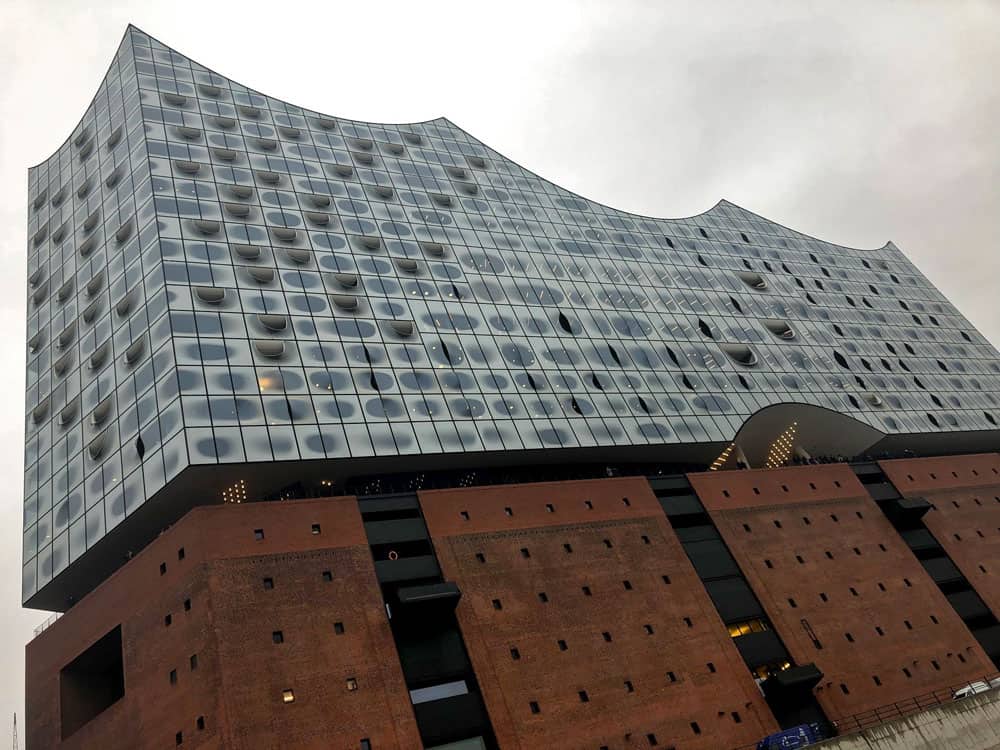
Hamburg tends to be fairly rainy all year with an average of about 10 days of rain each month. The city has a mild climate so summer’s high temperatures average in the mid-70s (but there are usually a few hot days). Winter temperatures also rarely dip below freezing.
Late Spring is a great time to visit because the city’s parks come to life with blooming flowers and Germans ready to break out of the long winter funk — don’t miss the Cherry Blossom Festival in May. The temperatures are also comfortable. Tourism doesn’t really pick up until summer so flight and accommodation prices will be a bit lower.
Summers in Hamburg are nice but can still be a bit rainy. Temperatures are usually in the 70s but a few 85+ degree days aren’t uncommon — you should also expect a bit of rain. The city’s parks, gardens, sidewalk cafes, beer gardens, and water/beaches will be full of people enjoying the nice weather. This is also the height of the tourist season but it’s not too bad.
Fall & Winter
The temperatures start dropping in October but it’s a joy to watch the leaves change colors. Temperatures aren’t too bad in the early fall but start getting cold and gloomy toward the second half of the season. You can find some cheap flights to Hamburg during this time since it’s not a super popular time for international visitors.
The winter is a bit rainy, gloomy, and windy but it’s also very festive thanks to all the Christmas markets and decorations. Tourism drops after the holidays so you can have the city to yourself. You can also find cheaper accommodation and flights.
Be sure to dress properly. Check out these handy articles:
- Winter Packing List for Europe
- Best Waterproof Boots for Men
- Best Waterproof Boots for Women
- Guide To Dressing For Winter in Europe
Hamburg’s Neighborhoods
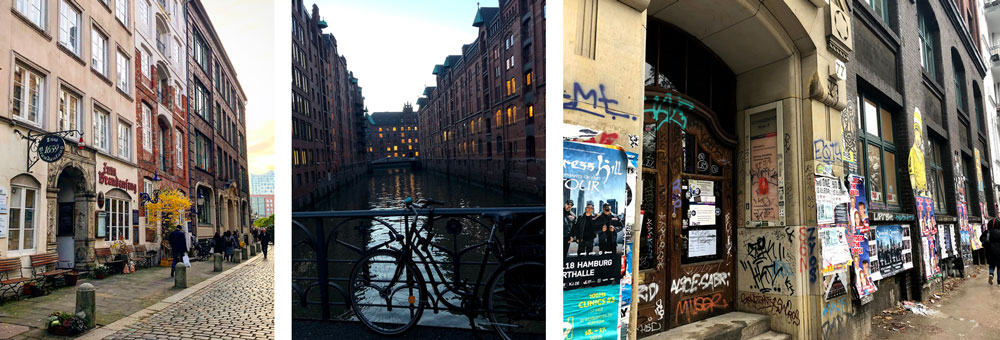
Hamburg has a few distinct neighborhoods and each has its own vibe. In this section, we’ll cover some of the most popular areas of the city that you might want to explore.
Altstadt and Neustadt Neighborhoods
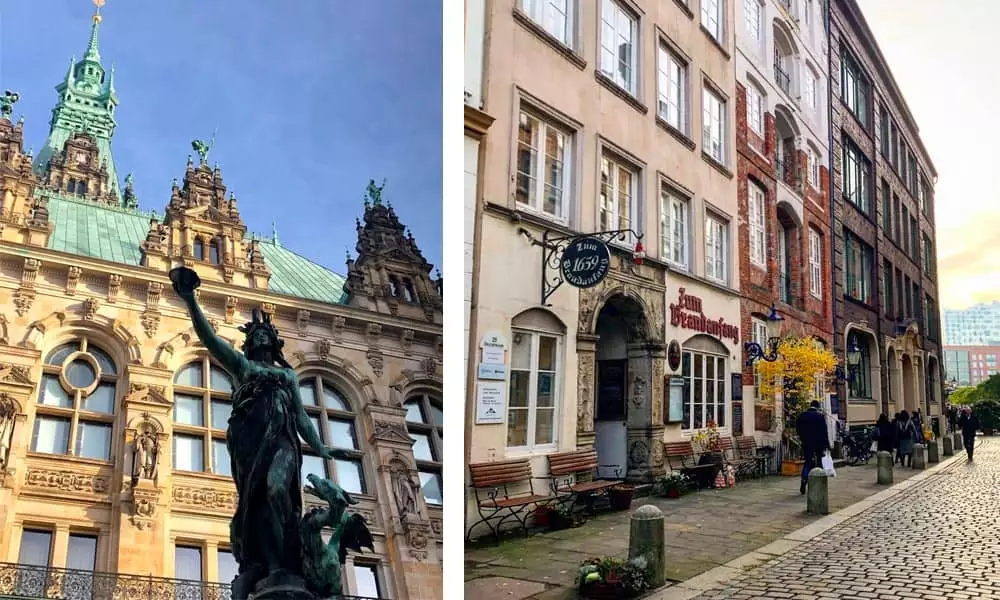
Altstadt (Old Town) and Neustadt (New Town) would be considered the “city center” and this is where you’ll find Hamburg’s impressive City Hall (one of the few buildings that survived WWII) and a few impressive churches. In Altstadt you’ll also find Deichstraße street — the oldest street that survived the great fire of 1848.
Neustadt (New Town) is the main shopping area of town so you’ll find lots of international chain stores as well as
Speicherstadt & HafenCity Neighborhoods
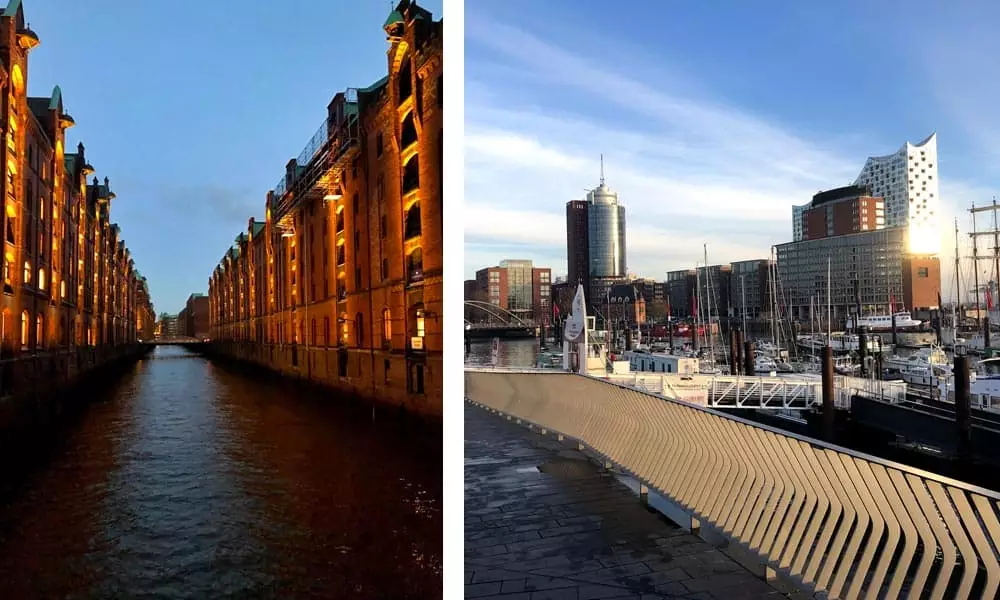
Speicherstadt is the Hamburg’s warehouse district. These beautiful red-brick buildings were built on a series of canals from 1883 to 1927 and it’s the biggest warehouse complex in the world. It’s a nice area to walk around it’s also home to Hamburg’s crown jewel — the Elbphilharmonie concert hall.
Next to Speicherstadt, you’ll find HafenCity — which is Europe’s largest inner-city development project. It’s been called “a utopian cityscape built into the Elbe river” and it’s a series of ultra-modern architecture. Some locals think its a soulless neighborhood for wealthy people. Either way, it’s a fun area to walk through and stop for a drink in a hip coffee shop.
St Pauli Neighborhood
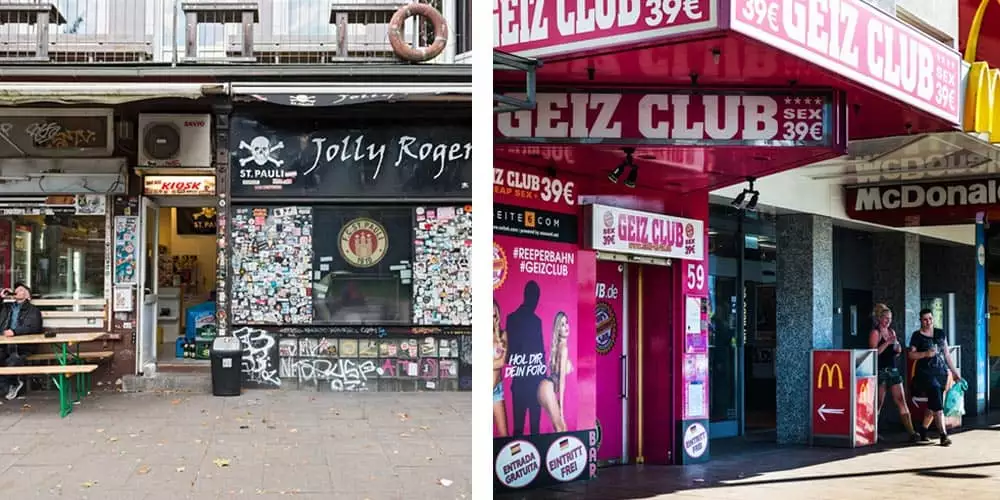
One of Hamburg’s biggest attractions is the St. Pauli neighborhood — which is also home to the city’s Red Light District (it’s also where the Beatles got their start). The main drag of the Red Light District is the Reeperbahn street. Surrounding the Reeperbahn you’ll find tons of bars, clubs, restaurants, strip clubs, adult stores, brothels, and prostitutes. Where else can you find a McDonald’s next to a brothel?
The entire area isn’t XXX-themed so you’ll also find some excellent bars and nightlife spots that have nothing to do with the Red Light District. Furthermore, the area is safe and there is a heavy police presence (including its own police station) since it’s such a tourist draw. They even have their own Christmas market!
Also, be sure to catch a soccer match at FC St. Pauli — if you can actually get a ticket. This local team is famous for their passionate and politically progressive fans who fight for the rights of the LGBT community.
Sternschanze & Karolinenviertel Neighborhoods
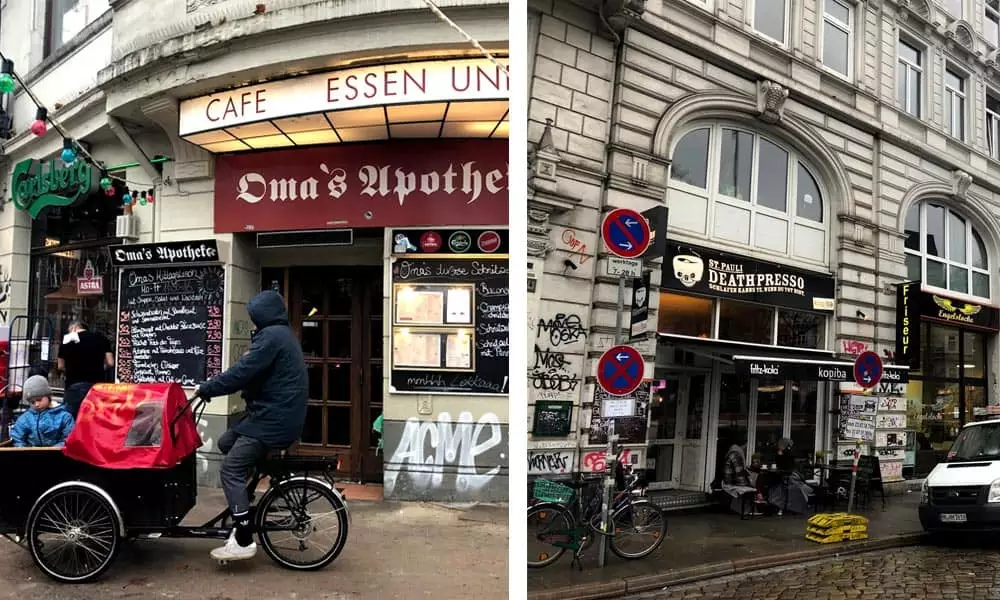
Sternschanze (or Schanze it’s known locally) is a super hip and youthful area full of excellent bars, restaurants, coffee shops, and independent shopping. Basically, it’s a major nightlife destination for people who don’t want the craziness of St. Pauli. Furthermore, it’s a popular spot for locals so it’s a great place to experience real Hamburg (as opposed to most of St. Pauli). It’s also home to graffiti-covered Rote Flora — a former theater that’s been a squat since 1989.
Karolinenviertel is a small neighborhood which borders Sternschanze (it’s essentially the buffer between Pauli and Sternschanze). It’s a trendy but calm area that feels slightly rough because of the abundance of street art but it’s full of coffee shops, second-hand stores, and boutique shops.
Other Neighborhoods
St Georg: St Georg is Hamburg’s gay neighborhood and it’s home to plenty of hip bars, restaurants, and art galleries. The locals call the neighborhood a “global village” since it’s home to multiple international cultures and people from diverse background. It’s located directly to the North/East of the train station.
Eppendorf: This upscale neighborhood was once the suburb to Hamburg’s wealthy residents. It’s a nice place to explore if you’re visiting Hamburg for an extended amount of time. Be sure to check out the walk along the Isbek Canal if the weather is nice.
Hostels & Hotels in Hamburg

Hamburg has a number of solid hostels. That said, the city does attract a party crowd so some hostels have a reputation of being a bit rowdy (which may or may not be something you’re looking for). So be sure to read reviews to get an idea of the hostel’s vibe.
- MEININGER Hamburg City Center
- Generator Hamburg
- Backpackers St. Pauli
- a&o Hamburg Hauptbahnhof
- a&o Hamburg City
- Pyjama Park Schanzenviertel
My Hotel – Heikotel am Stadtpark

During this trip to Hamburg, I was hosted by the nice folks at Heikotel am Stadtpark . It’s a clean, comfortable, quiet, and spacious hotel that’s also budget-friendly.
Best Things To Do In Hamburg

Hamburg has plenty of things to keep you busy. In this section, we’ve divided this section into multiple subsections to give you a better idea about the best of Hamburg.
Kunsthalle Hamburg

Kunsthalle is one of the largest and most important museums in Germany. One interesting thing about the Kunsthalle is that it has European art spanning seven centuries — from the old masters to contemporary art. Additionally, the museum’s cafe at the top of the building offers some of the best city views of Hamburg.
International Maritime Museum
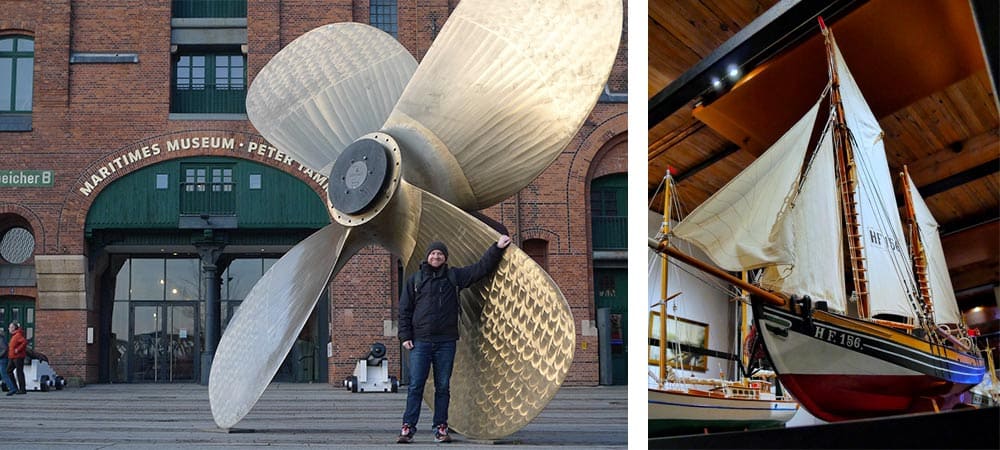
Hamburg has been one of Europe’s most important ports and this museum pays 3,000+ years of maritime history. Here you’ll find a huge collection of model ships, art, uniforms & photographs that came from Peter Tamm. This is an extensive collection that’s spread out over something like nine floors so set aside a few hours if you visit.
Museum of Arts and Crafts (Museum für Kunst und Gewerbe)
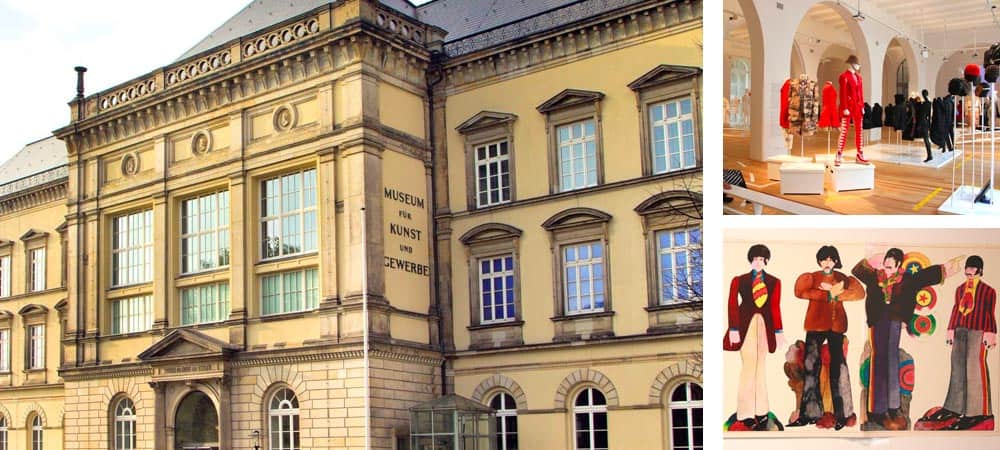
The Museum of Arts and Crafts is one of the largest of its kind in Europe and it covers fine, applied and decorative arts from the past 4,000 years. The exhibits everything from fashion (Coco Chanel, Alexander McQueen, etc.), textiles, and jewelry to photography, poster art, and graphic design.
Sights & Attractions
Miniatur wunderland.

The Miniatur Wunderland is not only the largest model railway in the world, but it’s also the most popular tourist attraction in Germany. Before going we thought it would be a bit kitschy (and it is) but it’s actually a lot of fun. They’ve built multiple massive scenes that are modeled around different parts of the world (and they’re adding more every year).
But the real joy is taking the time to admire all the details and easter eggs of each scene. And yes, some of the little figurines are a bit naughty.
Hamburg’s Street Art

Hamburg has some excellent street art and graffiti. While you can find street art just about everywhere in the city, the best examples can be found covering every inch of the neighborhoods of St. Pauli, Sternschanze, and Karolinenviertel. We suggest taking a few hours to walk around these areas to see what you discover.

The Elbtunnel, sometimes called St. Pauli Elbtunnel, is a long tunnel that runs under the Elbe River and connects the city center with the harbor in the south of the city. Completed over 100 years ago, it’s become a point of pride for the people of Hamburg. It’s open 24/7 to pedestrian traffic and it’s a popular tourist attraction.
City Views From St. Michael’s Church
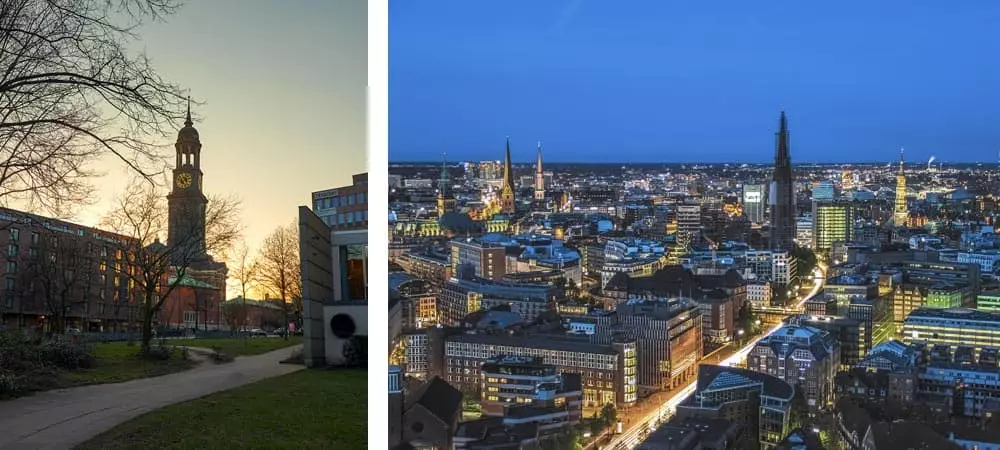
For some of the best views of Copenhagen we recommend heading to St. Michael’s Church and taking the elevator up to the top of its 132-meter high Baroque spire. The church is free to enter but it costs around €5 to visit the tower.
Planten un Blomen & Stadtpark
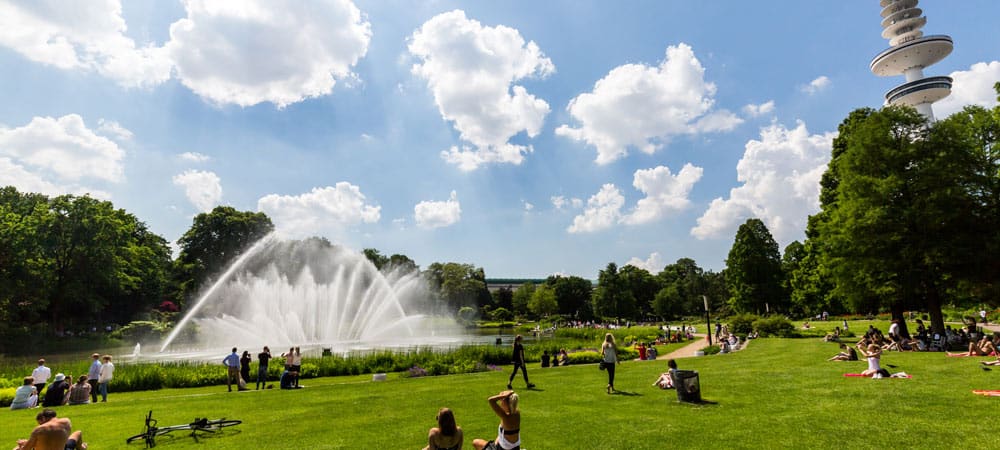
Planten un Blomen, which roughly translates to “Plants and Flowers”, is a large urban park in the middle of Hamburg. It’s an excellent escape on a nice day so pack a picnic and some adult beverages and enjoy nature. It’s also famous for having Europe largest Japanese garden and an impressive tropical greenhouse complex. There are also a number of playgrounds and other attractions for the kiddos.
Stadtpark, often called the “Green Heart” of Hamburg, is a huge park in the northern part of the city that locals flock to during the nice weather. The park features dozens of statues, a lake, playgrounds, a large lawn, and wooded areas.
Elbphilharmonie

The recently opened Elbphilharmonie Concert Hall is the largest and acoustically most advanced concert halls in the world. This €870 million jewel of the Hamburg skyline is made to look like the ocean waves. Concert tickets are tough to score (and they’re not cheap) but you can visit the 360-degree view observation decks for €2 (you can book tickets online to skip the line).
Jungfernstieg
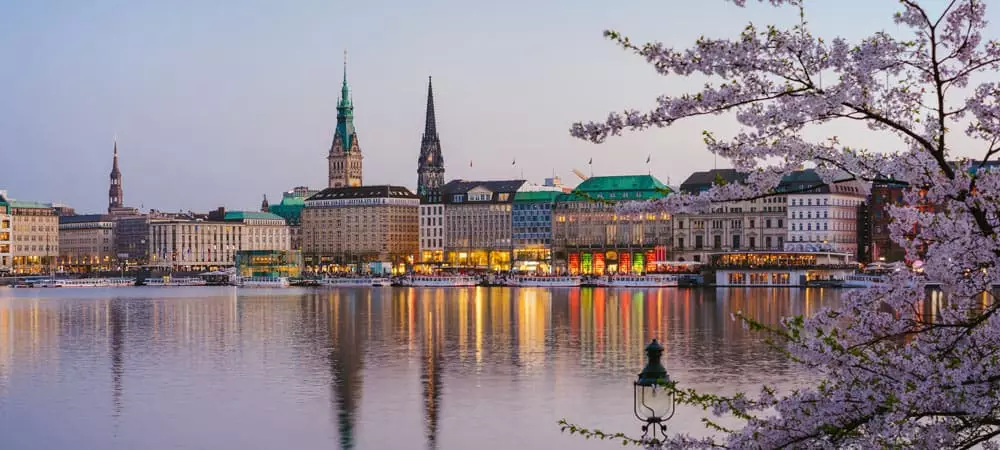
No visit to Hamburg is complete without visiting Jungfernstieg — a picturesque promenade that runs along Lake Binnenalster. It’s understandably touristy and the shops/restaurants there are expensive but it’s worth checking out.
Harbor and Ships

Hamburg is a port city so be sure to head down to the harbor to have a look around. Specifically, check out the two old merchant ships — the Rickmer Rickmers and Cap San Diego. Each has been turned into a museum so you can walk through them or just admire them from afar.
Furthermore, you can also tour the interior of the old Soviet-era U-434 Submarine that’s docked in the harbor.
Free Walking Tours

One of the best ways to get a nice overview of Hamburg is through a free walking tour. We ended up taking two great free walking tours from Robin And The Tourguides . Their Historic City Center tour gave a nice overview of Hamburg’s history and you see a lot of the classic sights like St Michael’s Church, the Rathaus, Nikolaifleet (the old canal). T he next day we took the Harbour, St. Pauli & Reeperbahn tour — which covers some of the seedier parts of the city’s past. We recommend both.
Another interesting option is to request to get shown around town by local volunteer greeters via Hamburg Greeter . This is a volunteer organization so you need to request a greeter at least two weeks in advance.
Harbour Boat Tour

Fans of nautical engineering or people who want a nice view of Hamburg should consider taking a harbor boat tour. I took a tour with Barkassen-Meyer . It was interesting to learn more about Hamburg’s port and to get a super up-close view of the massive ocean cargo freighters and views the city. They have limited tours in English but also have an app with an English audio tour.
Speicherstadt Warehouse District

The Speicherstadt district of Hamburg is an impressive complex of brick warehouses, canals, and bridges. It’s a fun place to walk around for an hour or two. The area also has a handful of coffee shops and cafes in the area if you want to rest for a bit. We recommend visiting at night to see the buildings illuminated.
Flohschanze Flea Market
View this post on Instagram Jeden Samstag Flohmarkt Flohschanze auf dem Gelände der Alten Rinderschlachthalle dirket am Bahnhof Feldstraße???????? @marktkultur_hamburg @marktundkultur #flohschanze #flohmarkt #alterinderschlachthalle #feldstraße #stpauli #schanzenviertel #sternschanze #karoviertel #hamburg #welovehh #view #inspiration #fleamarket #shoppen #weihnachten #hamburguesa #hamburgcity #shoppen #travel #trödeltrupp #geheimtipphamburg A post shared by Flohschanze (@marktkultur_hamburg) on Dec 21, 2018 at 7:35am PST
Looking to pick up some unique souvenirs? Check out the Flohschanze Flea Market that’s located in the Sternschanze neighborhood. This is the biggest flea market in Hamburg and you find all kinds of vintage clothing, trinkets, and other random things. It’s held every Saturday.
Explore On Bike
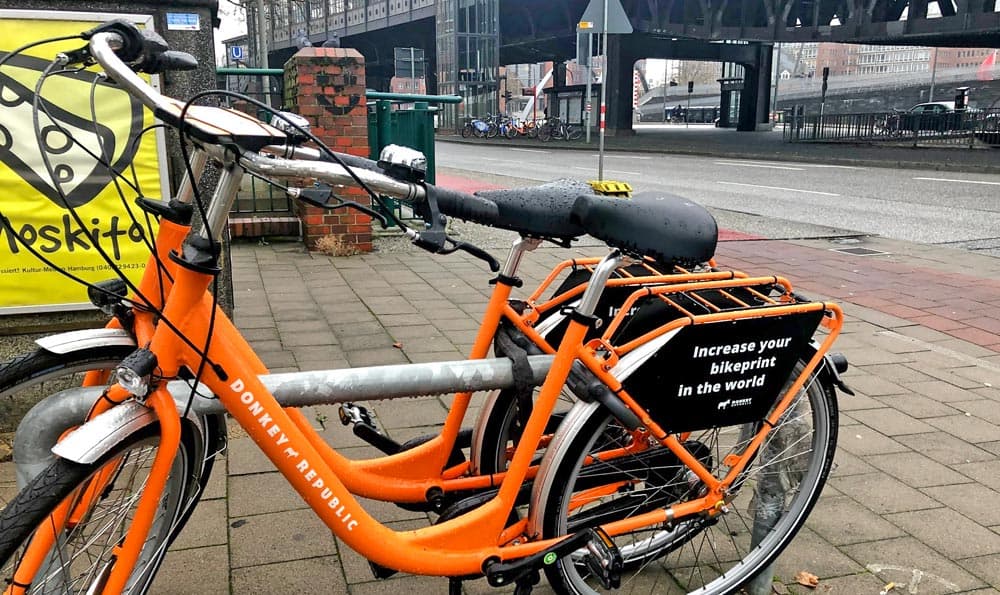
While Hamburg might not be as bike-friendly as its Scandinavian neighbors, bikes are still a popular form of transportation and there is a decent number of dedicated bike lanes. Like most cities in Europe, Hamburg has its own bike sharing program ( StadtRAD ) where you can check out bikes from automated stations throughout the city. You’ll need to first create an account on StradtRAD — the first 30-minutes is free and then rentals cost 8 cents per minute with a maximum fee of €12 per day.
In addition to private businesses that rent bikes, you’ll also see bright orange bikes scattered throughout the city from a company called Donkey Republic — you use a smartphone app to find and unlock the bikes. Prices start at 1.25 for 30 minutes and you just park the bike wherever you like when finished.
Ferry 62 Harbor Ride
Just because you’re on a budget it doesn’t mean you can’t see Hamburg from the water. Check out Ferry 62 which uses a normal public transportation ticket. Learn more here .
Hop-on-hop-off Bus Tour
A great way to get a quick overview of any city is through a hop-on-hop-off bus tour. Check out Hamburg-citytours.de to see their bus tour which takes 1h40m to see all of Hamburg’s highlights.
Other Interesting Attractions
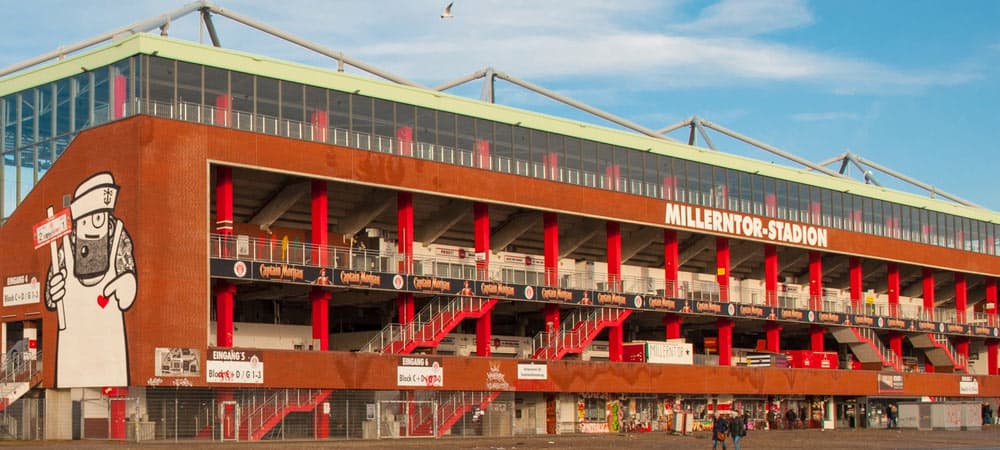
- Deichtorhallen: This is one of the largest art centers for contemporary art and photography in Europe.
- St. Pauli Football Stadium: Catch a match at FC St. Pauli stadium. It’s a great atmosphere but tickets can be tough to get.
- Tierpark Hagenbeck: Hamburg’s Zoo.
- PROTOTYP Automobile Museum: Car fans might want to check out the small but interesting PROTOTYP AutoMuseum — which features a selection of around 50 cars spanning 80 years.
- Lübeck Day Trip: Old German town and Unesco as a World Heritage site that’s a short train ride from Hamburg.
Food, Alcohol, and Coffee in Hamburg

Hamburg has plenty of great restaurants, coffee shops, bars, cocktail bars, and beer gardens at a range of price points. Furthermore, Hamburg’s history of being a port city means it has been exposed to multiple cultures (and their cuisine) so you’ll find more than just schnitzel and currywurst in Hamburg.
Note: Most of our food recommendations will skew towards budget-friendly/good value options since The Savvy Backpacker is all about budget travel so this list won’t include every “best” restaurant — just the best value.
Restaurants

Erika’s Eck: Ericka’s Eck has been a local favorite for over 40 years. Where else can you get a huge schnitzel for around €10, and an excellent selection of local beers in a no-nonsense, old-school atmosphere? This place fills up just about every night so you might want to make reservations. Furthermore, Ericka’s Eck is open all night so it’s a popular spot to get that 3:30 am post-party schnitzel fix. Neighborhood: Sternschanze/Karolinenviertel. See On Google Maps .
Otto’s Burger : Otto’s is a hip burger place that has three locations in Hamburg (we recommend the super-cool Sternschanze location). The burgers are excellent and they’re fairly affordable at €9-€13. Neighborhood: Sternschanze/Karolinenviertel. See On Google Maps .
Better Burger Company: If you’re in the main shopping area and want a quick bite then you should check out Better Burger Company. The burgers are organic and the prices are fair. Neighborhood: Altstadt (Old Town). See On Google Maps .
Frank und Frei: Frank und Frei is another no-nonsense local favorite that serves up classic German food and beer at budget-friendly prices. It’s particularly popular for its weekend breakfast/brunch that’s served from 9:00 am to 3 pm. It’s a fairly large location so it’s a nice spot for groups. Neighborhood: Sternschanze. See On Google Maps .
Frau Möller: This cozy and rustic looking restaurant serves up large portions of Northern German food, burgers, and beer for a fair price. Neighborhood: Altstadt (Old Town). See On Google Maps .
Zum Spätzle: This small family run restaurant specialized in h omemade Spätzle. Prices are reasonable. Neighborhood: Neustadt. See On Google Maps .
Omas Apotheke: Another budget-friendly restaurant serving up simple yet tasty Germany fare — from breakfast to dinner. Neighborhood: Sternschanze. See On Google Maps .
Gaststätte Fisch Imbiss: This small but popular fish restaurant is a favorite with locals so expect a crowd. Prices are reasonable and the fish is fresh. Neighborhood: Sternschanze. See On Google Maps .
BAN CANTEEN: BAN CANTEEN is a hip, modern, and minimalist Vietnamese restaurant that serves up fresh dishes like bao burgers, pho, and other authentic options in large portions. Neighborhood: Sternschanze. See On Google Maps .
Quan Do Hauptbahnhof: When it comes to cheap, tasty, & authentic Vietnamese Pho then you should head to Quan Do Hauptbahnhof. It’s located across from the train station. It’s a small and often-busy restaurant but the service is quick. Cash only. Neighborhood: Altstadt (Old Town). See On Google Maps .
SO NA MU : This small and modest restaurant serves up authentic, tasty, and budget-friendly Korean food. Portions are generous. See On Google Maps .
Mö-Grill: Mö-Grill is a popular snack bar/food stand that serves up brats and sausage but they’re most famous for their currywurst. Prices are cheap and service is fast. This is an outdoor food stand so there isn’t much space to eat other than a few stand up tables. Neighborhood: Altstadt (Old Town). See On Google Maps .
Eppendorfer Grill-Station: This modest and unassuming restaurant is another local favorite that most visitors might pass by. The prices are low, the food is tasty (particularly the fried chicken and currywurst), and the portions are filling. There are a few seats inside and out but it’s mostly a takeaway joint. See On Google Maps .
Schmitt Foxy Food: Our tour guide told us about this no-frills spot serving up tasty sausage and fries at low prices. It’s a popular spot to visit after consuming a few drinks. Neighborhood: Sternschanze. See On Google Maps .
Kiez Curry: One of the most popular currywurst spots in St. Pauli is Kiez Curry and it’s a must-visit after a long night of drinking and partying. Neighborhood: St. Pauli. See On Google Maps .
Souperia: Sometimes there is nothing better than a nice bowl of soup to warm you up. Souperia serves up healthy and tasty soup at affordable prices. This is mainly a takeaway restaurant because there is very little space to eat in. Neighborhood: Sternschanze. See On Google Maps .
Azeitona: This budget-friendly middle eastern restaurant serves up some of the best falafel in Hamburg and plenty of other dishes. Great for vegetarians. Neighborhood: Sternschanze/Karolinenviertel. See On Google Maps .
Kleine Pause: This cheap restaurant is a local favorite thanks to their no-nonsense food and large portions — including hamburgers, currywurst, and lots of other options. It’s open late and it’s located in the party-central St. Pauli neighborhood so it’s popular after a night of drinking. Neighborhood: St. Pauli. See On Google Maps .
Luigi’s: Arguably the best pizza in Hamburg is found at Luigi’s. It’s fresh, home-made, and authentic Italian. It’s not “cheap” but it’s a good value since their pizzas are large. Neighborhood: Neustadt. See On Google Maps .
Restaurante Español Picasso: For authentic Spanish tapas look no further than Restaurante Español Picasso. The atmosphere is nice and the food is great quality. That said, it’s not a cheap restaurant but its a good value for the quality. Reservations are suggested. Neighborhood: Altstadt (Old Town). See On Google Maps .
Hobenköök: Hobenköök is a new “food market” restaurant that’s found in the HafenCity neighborhood. It’s a more upscale dining experience but the food is fresh & very local. Neighborhood: HafenCity. See On Google Maps .
The Fish Market: Every Sunday morning from 5.30-9.30am partygoers stumble to the fish market located along the Elbe river to continue the party with live rock, jazz music, and dancing. The locals chow down on a few traditional fried fish sandwiches so check that out. See On Google Maps .
Coffee and Bakeries

Pastelaria Transmontana: Hamburg has one of Europe’s largest Portuguese populations and Pastelaria Transmontana is one of the city’s most-loved and oldest Portuguese cafes. Try the Galão (Portuguese coffee) and Pasteis de Nata (traditional egg tart pastries). Neighborhood: Sternschanze. See On Google Maps .
Café MAY: A hip, cozy, and cash-only cafe that serves up a solid breakfast and brunch for reasonable prices. There are multiple locations in Hamburg but the most centrally located one is in St. Pauli. They also serve drinks later in the day/night so it’s a nice place to chill out and escape the craziness of the Red Light District. Neighborhood: St. Pauli. See On Google Maps .
elbgold Röstkaffee: Excellent coffee shop in a hip industrial vibe. Top quality coffee. Friendly staff. Tons of space. Neighborhood: Sternschanze. See On Google Maps .
kopiba Kaffeerösterei & Bar: This uber-cool coffee shop is located in the equally cool Karolinenviertel neighborhood. The coffee is really nice and there are some solid breakfast/brunch options. The atmosphere is hip and welcoming. There is also some nice outdoor seating. We found the barista to be a bit cold but the overall experience was still positive. Neighborhood: Sternschanze/Karolinenviertel. See On Google Maps .
Tōrnqvist: Another excellent little coffee shop in the Sternschanze/Karolinenviertel neighborhood and its owner takes his coffee seriously. They also have some nice pastries. And you’ll dig the stunning minimalistic interior. Neighborhood: Sternschanze/Karolinenviertel. See On Google Maps .
ZEIT Café: Good coffee. Modern decor. Nice music. Cozy. And wifi. Nuff said. Neighborhood: Altstadt (Old Town). See On Google Maps.
Speicherstadt Kaffeerösterei: This large coffee shop is located in Hamburg’s warehouse district. The coffee is solid and the industrial chic decor is welcoming. There are a lot of tables but this place is located in a touristy part of town so it can get a bit crowded at times. Neighborhood: Speicherstadt (Warehouse District). See On Google Maps .
Die Rösterei Coffeum: Cozy little coffee shop serving up quality coffee and baked goods. Neighborhood: Altstadt (Old Town). See On Google Maps .
Hermetic Coffee Roasters: Another great hip and cozy third wave coffee shop with a range of top quality coffee and a few snack options. Small inside but plenty of outdoor seating in the summer. Neighborhood: Sternschanze/Karolinenviertel. See On Google Maps .
Milch: This minimalist and quiet third wave coffee shop is located near the harbor and serves up high-quality coffee. They also have a small selection of goodies to eat. Neighborhood: Neustadt/Harbor. See On Google Maps .
Playground Coffee: Located on the edge of the Red Light District of St. Pauli, Playground Coffee is a cozy little coffee shop with a hip atmosphere and good music. Excellent coffee. Friendly staff. Neighborhood: St. Pauli. See On Google Maps .
Die kleine Konditorei: This bakery’s few locations might be a bit outside the city center but people still flock there for their delicious baked goods. We suggest the cinnamon or chocolate franzbrötchen pastry but just about everything is great. See On Google Maps .
Biokonditorei Eichel: Excellent bakery for vegan and gluten -free pastries. See On Google Maps .
Beer, Bars, Pubs & Cocktails

The most popular nightlife destinations for young people is St. Pauli/The Red Light District (for a wild night out) and Sternschanze & Karolinenviertel (for a hip but more chilled out and “local” experience). There are plenty of great placed outside these areas but most suggestions on this guide will be in these areas. By the way, Astra is a famous beer brewed in Hamburg so it’s usually pretty cheap.
Clockers: This super stylish and hidden speakeasy doesn’t have a sign outside (you have to ring the buzzer to get inside) but inside you’ll find excellent cocktails and a DJ playing nice tunes. They also make their own house-distilled gin so many of their drinks revolve around gin. Drinks are expensive but the quality is top notch. Neighborhood: St. Pauli. See On Google Maps .
Le Lion Bar de Paris: Another classic cocktail bar serving up well-crafted cocktails. Swanky and sexy atmosphere. Again, drinks are expensive but expertly made. Neighborhood: Altstadt (Old Town). See On Google Maps .
Boilerman: The Boilerman is another great cocktail bar and the prices are a little more reasonable than the other cocktail bars on this list. Two locations. Neighborhood: HafenCity. See On Google Maps .
20Up Skyline Bar: This bar is expensive but the views from the 20th floor of this fancy high-rise hotel are the best in the city. So treat yo self to a nice drink and some killer views before continuing on with you budget travel lifestyle. Neighborhood: St. Pauli: See On Google Maps .
Braugasthaus Altes Mädchen: This is a great brew house that offers a huge selection of craft beers and good pub food. The atmosphere is excellent (log fire in the winter and a large bustling nice beer garden in the summer) but it can get a bit crowded during the weekend. The prices are a bit high for Hamburg but it’s still a solid place to enjoy a drink or two. Neighborhood : Sternschanze. See On Google Maps .
Ratsherrn: If you’re a beer snob then you should check out the local Ratsherrn microbrewery. They always have an interesting selection of beers available to drink onsite. They also have tours available. Neighborhood : Sternschanze. See On Google Maps.
Zum Silbersack: Old-school and down-to-Earth neighborhood pub in St. Pauli. Mixed crowd of young and old, locals and tourists. Affordable drinks. You can smoke inside. Neighborhood : St. Pauli. See On Google Maps .
3 Zimmer Wohnung: This chilled bar looks like a German living room from the 1970s/1980s — couches, ugly but charming wallpaper, etc. The drinks are affordable and the place is super cozy and a nice break from the craziness of the St. Pauli neighborhood. Neighborhood : St. Pauli. See On Google Maps .
David Quelle: Classic and quaint neighborhood pub in St. Pauli. A mix of locals and tourists. Reasonable prices and friendly staff. Neighborhood : St. Pauli. See On Google Maps .
Barbarabar : Cheap beer and shots. A cool/kitschy atmosphere with great music — but can get crowded on the weekends. Neighborhood : St. Pauli. See On Google Maps .
Albers Bar: A bit of a hidden gem hid among the seedier and party-focused bars normally found on the Reeperbahn. A laidback atmosphere so good for a chilled evening. Pretty good craft beer menu and affordable cocktails. Neighborhood : St. Pauli. See On Google Maps .
Bar 99 Cent : Every drink costs 99 cents… but don’t expect much more. In the Red Light District. Neighborhood : St. Pauli. See On Google Maps .
Lehmitz: Typical neighborhood pub/dive with live rock music. Drink are affordable. Neighborhood : St. Pauli. See On Google Maps .
Zoë 2 Sofa Bar: A unique and cozy dive bar that’s filled with shabby-chic sofas. The atmosphere is chill and the drinks are reasonably priced. Neighborhood : Sternschanze. See On Google Maps .
Dschungel: Dive bar with a friendly and chilled atmosphere. Affordable prices. Neighborhood : Sternschanze. See On Google Maps .
Katze: Laid-back locals bar. Nice for an affordable drink. There are tables outside so it’s nice in the summer. Neighborhood : Sternschanze. See On Google Maps .
Goldfischglas: Another laidback bar popular with the locals — many of whom use this bar as a first stop before heading out of the night. Neighborhood : Sternschanze. See On Google Maps .
Hamburg’s Public Transportation
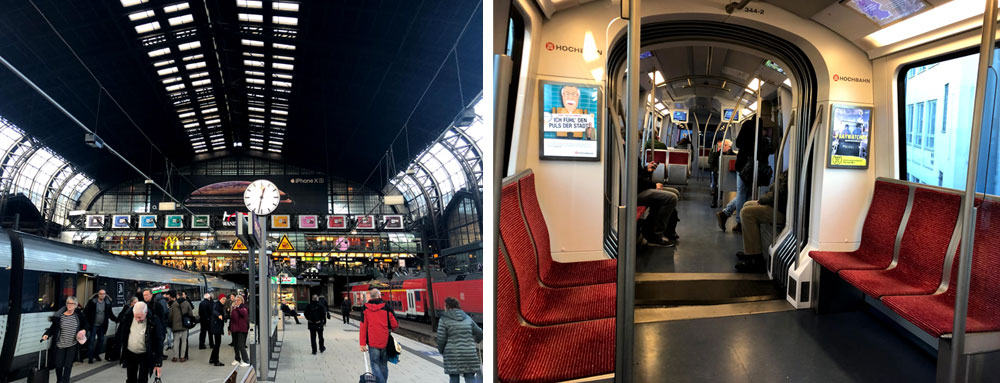
Hamburg has an excellent public transportation network so getting around is quick and easy. I used the Hamburg Card — which gave me unlimited public transportation and a few small discounts at some attractions.
Getting Into Hamburg
The Airport to Hamburg City Center: There is a commuter train the connects the Hamburg Airport to the City Center/Central Train Station. From there you can transfer to the subway. It’s an easy 30-minute ride and uses a standard public transportation ticket.
Hamburg Central Train Station (Hamburg Hauptbahnhof): Hamburg’s Central Station is located in the heart of the city. The train station has connections to four railways (S-Bahn) and six subway platforms (U-Bahn). Note: Hamburg has five train stations so make sure you don’t accidentally get off at the wrong station — Hamburg Hauptbahnhof will almost always be the last stop for most routes.
ZOB Long-Distance Bus Station: Hamburg has a centrally located bus depot that’s located right next to the central train station (most cities put their bus station on the outskirts of town). See more here .
Getting Around Hamburg
The commuter train, subway, buses, and ferries all use the same ticket. The standard ticket covers essentially all the parts of the city you’ll want to see (including the airport) so stick with that ticket unless you plan on adventuring out into the suburbs. Visit the official public transportation website site at hvv.de for more details and a trip planner.
Standard Ticket Prices (Within The City):
- Single Ticket: €3.30
- All-Day Ticket: €7.80
- All-Day Ticket (After 9 am): €6.50
As you can see, in most cases it makes sense to just buy an all-day ticket.
S-Bahn and U-Bahn
The main city-wide transport options are the U-Bahn (underground lines) and S-Bahn (suburban lines). These two trains will get you everywhere you need to go. Both run 4:30 a.m. to 1:00 a.m. the next morning and 24 hours on weekends.
And while there aren’t any ticket turnstiles in the stations, you must still have a valid ticket to ride these trains. Train often randomly come check tickets and there is a big fine for not riding with a valid ticket.
Most visitors more than likely won’t need to use the ferry to get around but there are six lines that will take you different stops along the water. That said, Ferry 61 offers some great views of the city for the cost of a single ticket. It’s a good sightseeing option for travelers on a budget.
Most visitors won’t use the bus but Hamburg has an extensive bus network with frequent service. Buses run 24/7. We suggest downloading a bus route app or use Google Maps to help you navigate the bus.
More Trip Planning Resources
Here are a few other websites you might want to check out as you plan your trip to Hamburg.
- Hamburg Ahoi : Blog about cool things going on in Hamburg.
- Creme Guides/Hamburg : Another blog about hip bars, restaurants, and shops in Hamburg.
- Spotted By Locals/Hamburg : Locals share their favorite restaurants.
- Megan Starr/ Hamburg Craft Beer Guide : A really nice guide to craft beer in Hamburg (bars, bottle shops, tap rooms, etc.)
- Hamburg Tourism Website : The official Hamburg Tourism website has a solid amount of information about visiting the city. It’s worth checking out.
More Travel Tips From Us
- The Best Travel Backpacks : Our favorite backpacks for exploring Europe.
- Europe Packing List For Women : The female’s guide to packing for Europe.
- Europe Packing List for Men : The men’s guide to packing for Europe.
- Travel Insurance 101 : Tips for choosing the right travel insurance.
- Recent Posts
- Paris Pass Review — A Good Value or Waste of Money? - May 13, 2024
- The Best Travel Backpacks | In-Depth Buyer’s Guide & Backpack Reviews - April 28, 2024
- Best Prepaid UK eSIM | Data Plan Buyer’s Guide - April 21, 2024

No Funny Business
The Savvy Backpacker is reader-supported. That means when you buy products/services through links on the site, I may earn an affiliate commission—it doesn’t cost you anything extra and it helps support the site.
Thanks For Reading! — James
Questions? Learn more about our Strict Advertising Policy and How To Support Us .
Related Reads
Hamburg price guide | calculating the daily cost to visit hamburg, germany.
The daily costs to visit Hamburg. How to estimate your budget for food, hostels, hotels, attractions, alcohol & more.
A Backpacker’s Guide To The Best Hostels in Hamburg
The ultimate list of the best places to stay when visiting Hamburg, Germany on a budget.
Heikotel Am Stadtpark | Hotel Review
Our review of the clean, comfortable, and budget-friendly Heikotel Am Stadtpark Hotel in Hamburg
City Guides
Choosing travel insurance, travel packing lists, budget travel newsletter.
The best budget travel tips sent straight to your inbox.
Join My Journey
Europe travel tips, advertising & privacy policies.
TheSavvyBackpacker.com is a participant in the Amazon Services LLC Associates Program, an affiliate advertising program designed to provide a means for sites to earn advertising fees by advertising and linking to amazon.com.
© 2010 - 2024 The Savvy Backpacker
Website Design by FHOKE

Hamburg Travel Guide
This post may contain affiliate links. Read my disclaimer policy.
Located on the Elbe River in northern Germany, there’s so much to love about this beautiful and bustling Hanseatic city – one of Cate’s top 3 favorite cities in Germany (she used to live there).
There are countless attractions in and around Hamburg, lush parks and botanical gardens, a famous fish market with delicious food, an historic harbor, canals and gorgeous neighborhoods to explore by boat or canoe, and so much more.
This guide will help you start planning what to do and see in the Hamburg area, where to stay, best tours, day trip ideas, and more.
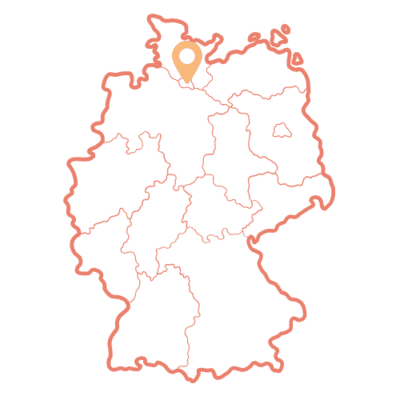
What to Do and See in Hamburg
Northern Germany looks and feels different than southern Germany, and we highly recommend visiting. Cate used to live in Hamburg and it’s one of her favorite cities in Germany. Whether you’re into food, history, architecture, nature, art, or spontaneous adventures, you’ll find plenty to see and experience in and around Hamburg!
Tip: if you have our Germany Travel Planner , be sure to check out our city cheatsheets and our digital planning map so you can see where the top sights, hotels, and day trips are in relation to each other. It makes planning your visit SO much easier!
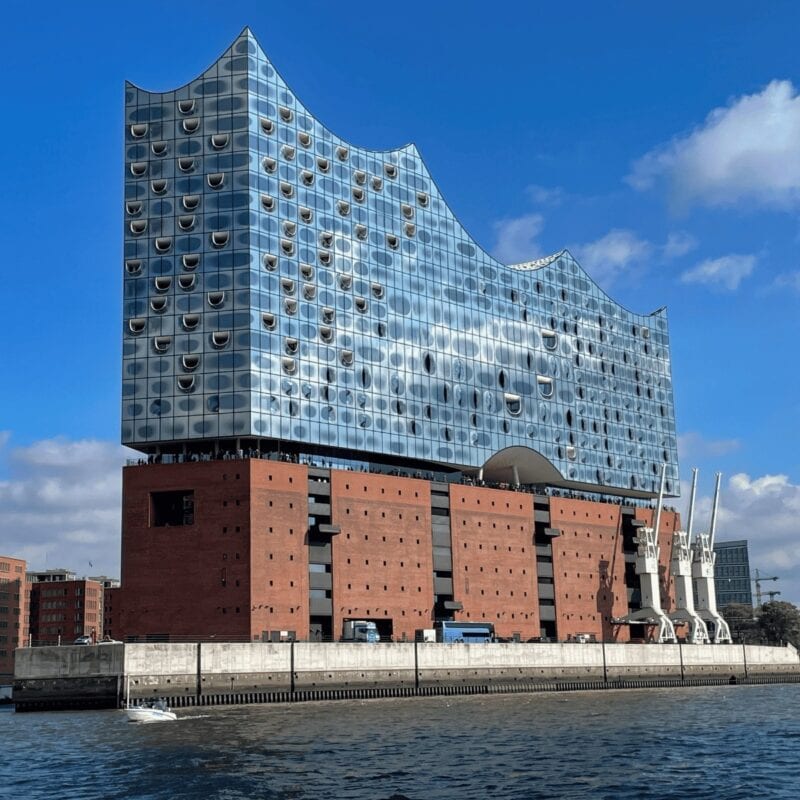
Things to see and do in Hamburg
View our top recommendations!
Hamburg Accommodations
You’ll find a wide variety of accommodation options in Hamburg, including hotels and apartments, from budget to luxury, city center to beautiful neighborhoods on the Elbe River. If you’re looking for an apartment in Hamburg, do a search on Booking.com . We’ve found several great apartments there (less than what we saw on Airbnb for the same apartment) and it’s SO nice to have all hotel and apartment reservations in one place.
Book your Hamburg accommodations in advance! They tend to fill quickly during peak travel times (summer, Christmas, etc.) so we recommend seeing what’s open for your travel dates ASAP.
If you have our Germany Travel Planner you’ll find recommended hotels on our interactive planning map. Seeing where these hotels are in relation to the top sights makes it a lot easier to find the perfect place to stay. If you don’t yet have it, click here to get access.
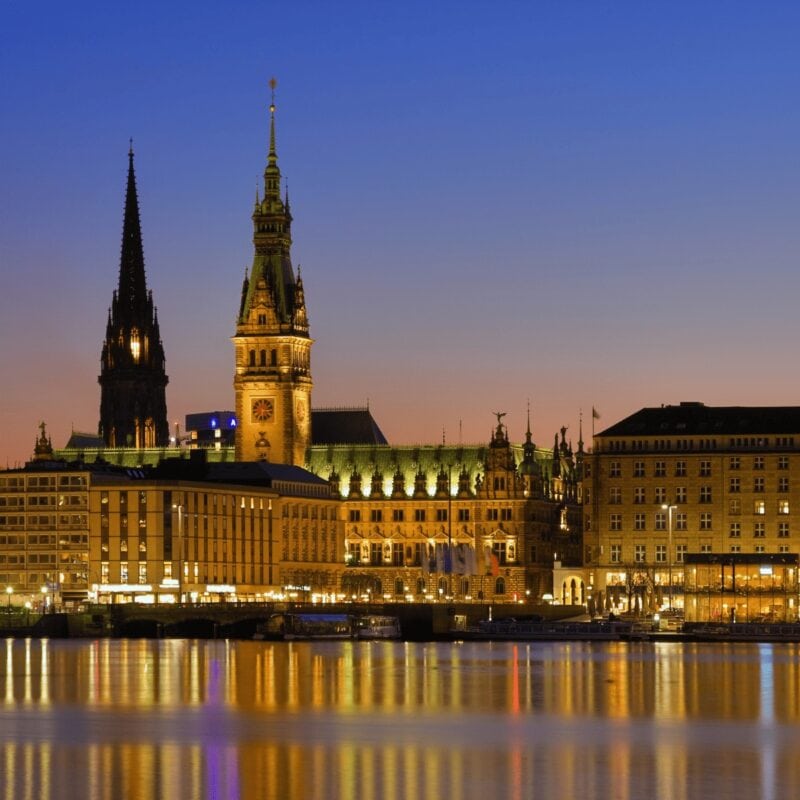
Best Hotels in Hamburg, Germany
Book from a list of our top recommendations!
Hamburg Tours and Tickets
organized activities from our affiliates
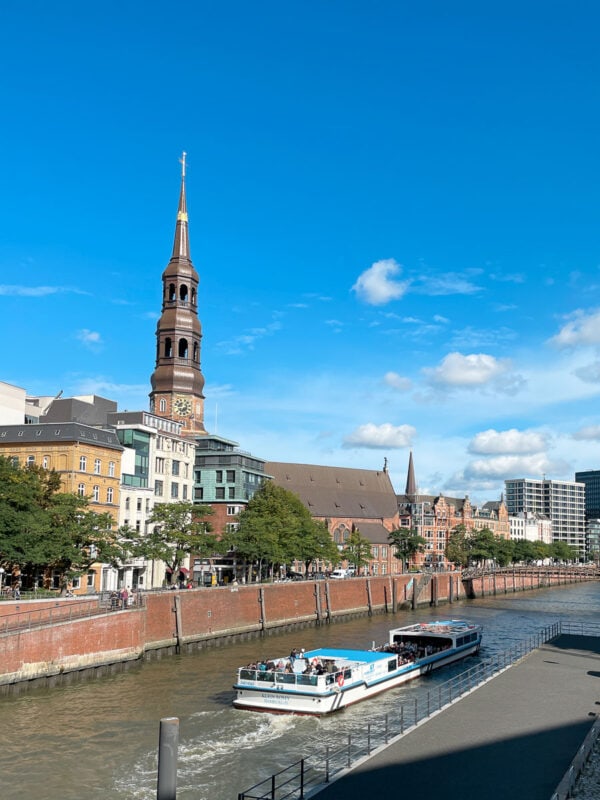
Port of Hamburg Cruise
Click here for price and availability.
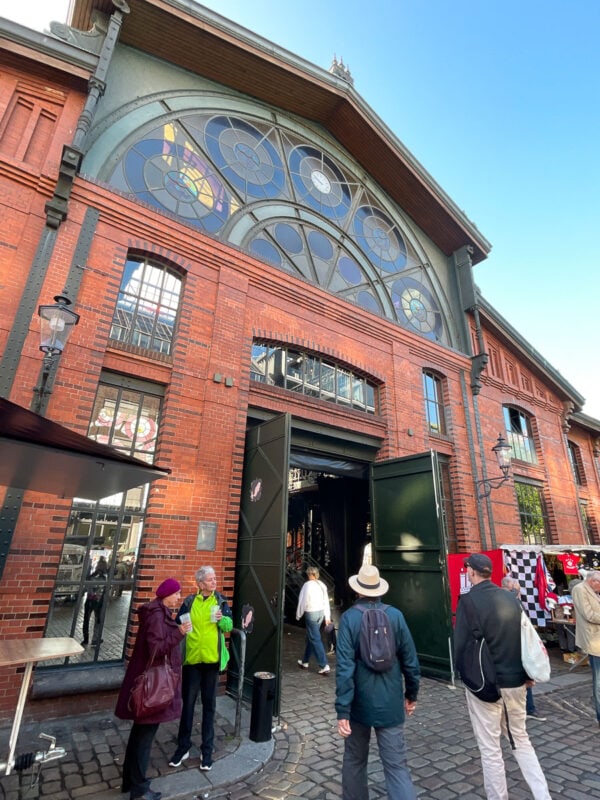
Hamburg Discovery Tour

Hop-On Hop-Off Bus Sightseeing Tour
Click here for price and availability .
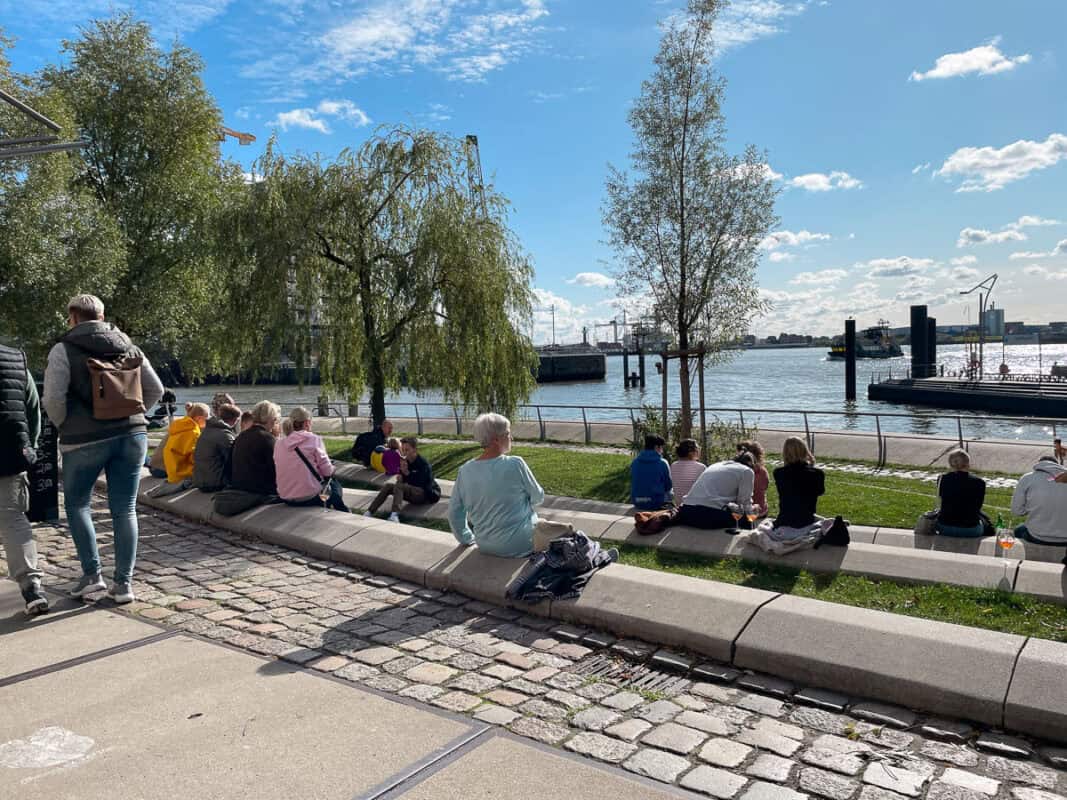
Alster Lake Bike Tour
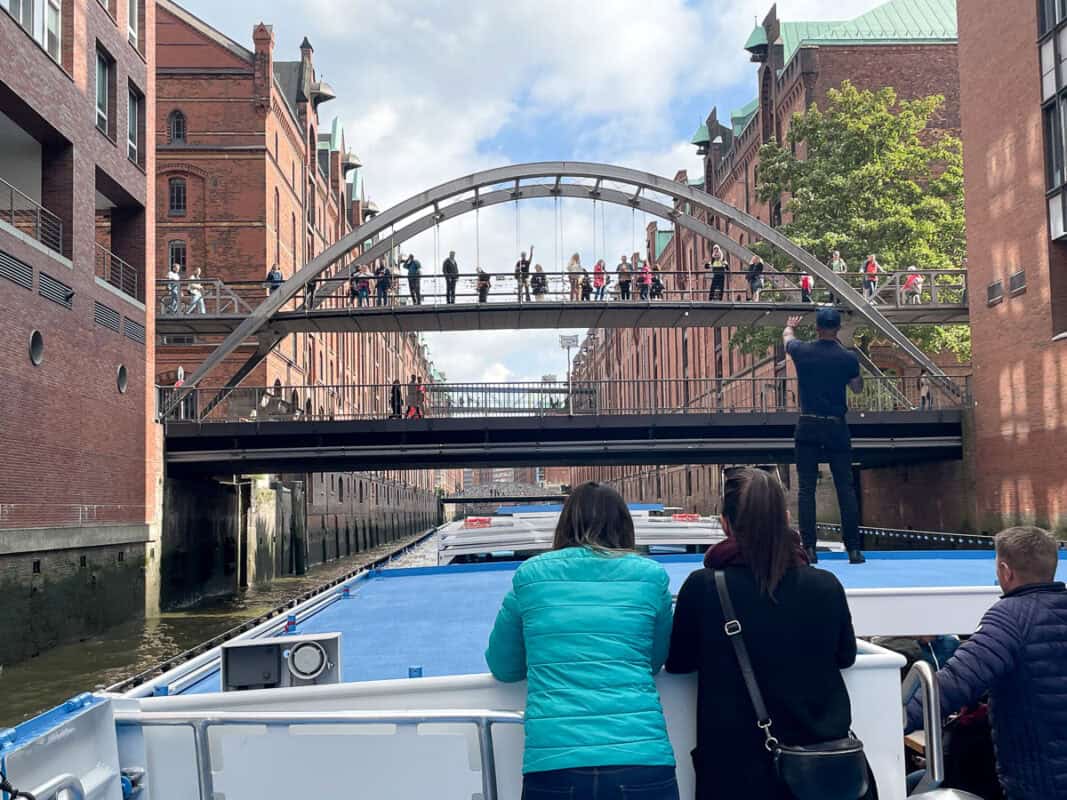
Harbor and Speicherstadt Day Cruise
Click here for price and availability
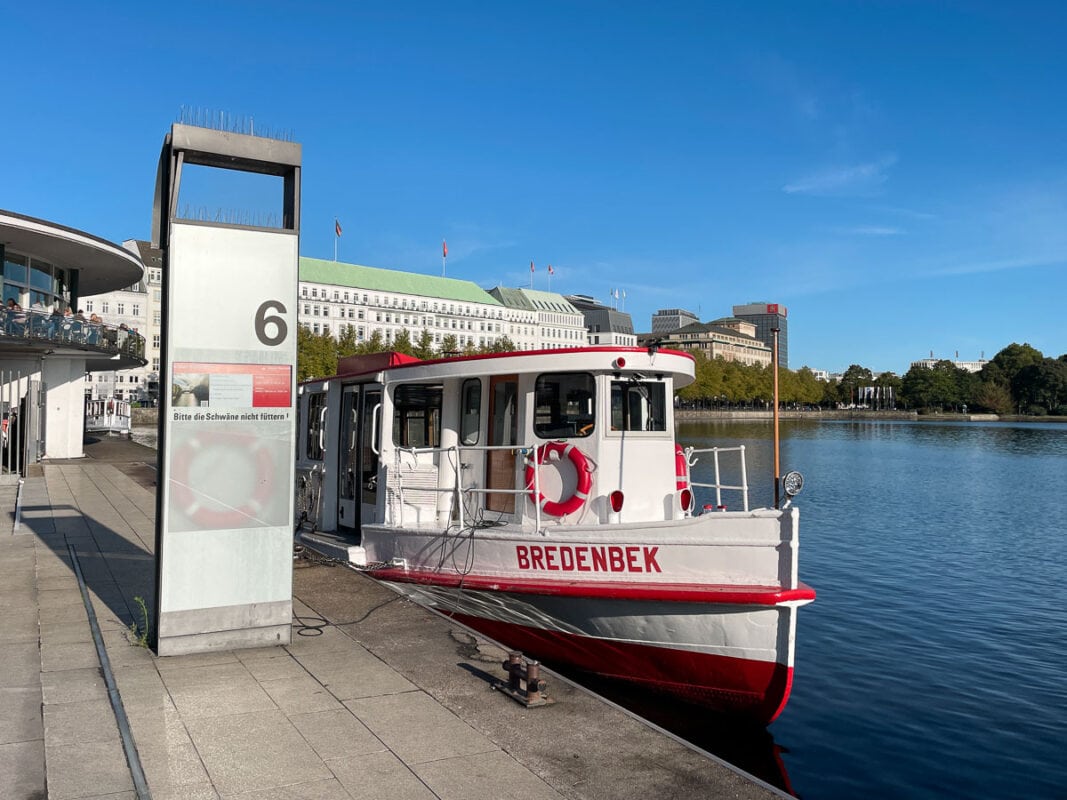
City Cruise on Alster Lake
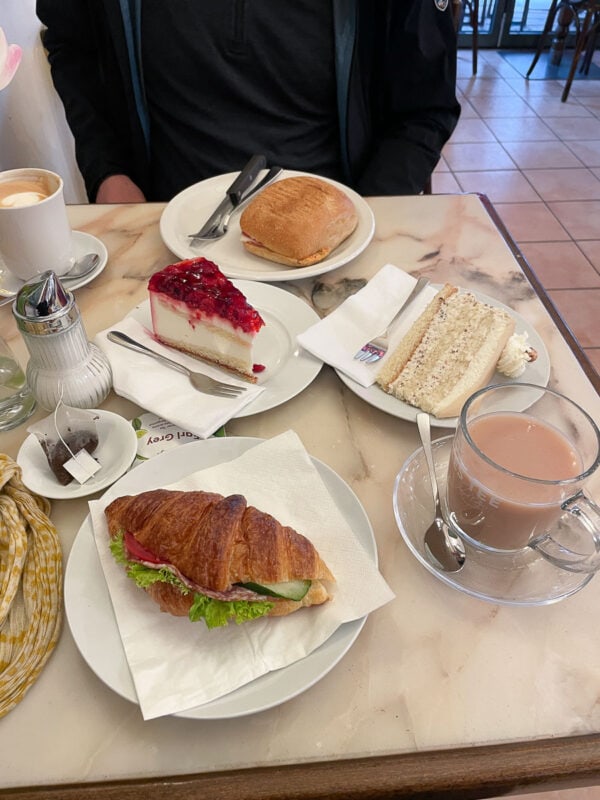
Culinary Tour
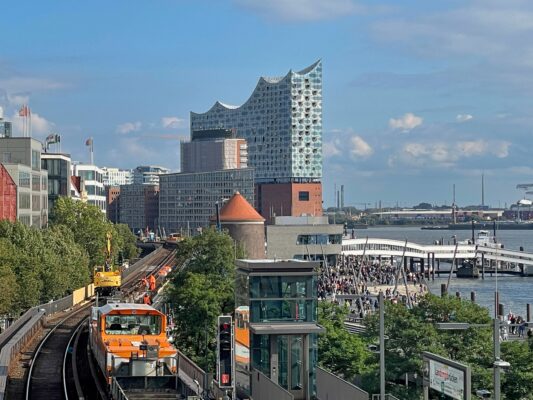
Know Before You Go
Airport : Hamburg International Airport (HAM) Currency: Euro Language: The official language of Germany is German (Deutsch) Time zone: Central European Time (CET / GMT+ 2 / 6 hours ahead of US EST) Germany Visa: tourists from the US, Canada, and several other countries do not need a visa to visit Germany for under 90 days. Germany Electricity Socket: Germany uses different voltage and sockets than in North America, the UK, and other parts of the world. Read our guide to adapters and converters so you can safely use your tech in Germany. Germany SIM card: Read our guide here to SIM cards and other ways to use your phone in Germany. Germany Car Rentals: We find great deals on rental cars here . You can also check out our scenic Germany road trips article here.
Recommended Day Trips from Hamburg
One of the best things about making Hamburg your home base while visiting northern Germany is that you have countless day trip options. You can plan your own day trips for maximum flexibility or book a guided tour for maximum relaxation and convenience. Here are some ideas to get your planning started.
FROM OUR BLOG…
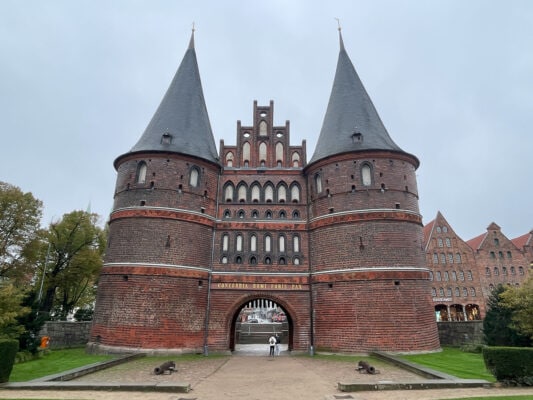
Best Day Trips from Hamburg
Read about our best day trip recommendations from Hamburg!
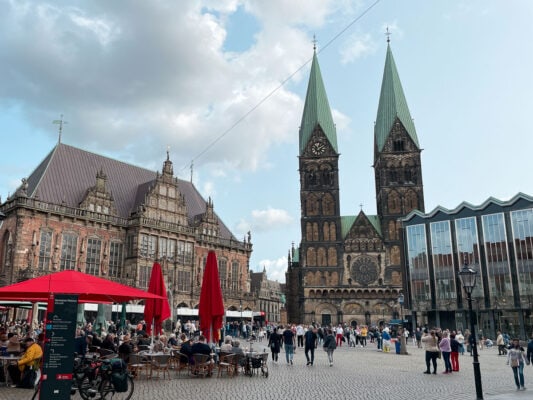
Visit Bremen
Click to learn more… ➔
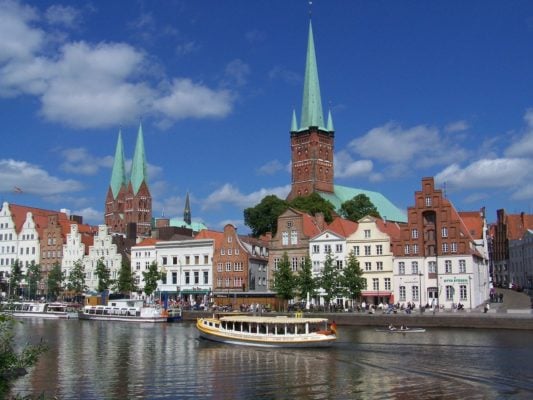
Visit Lübeck
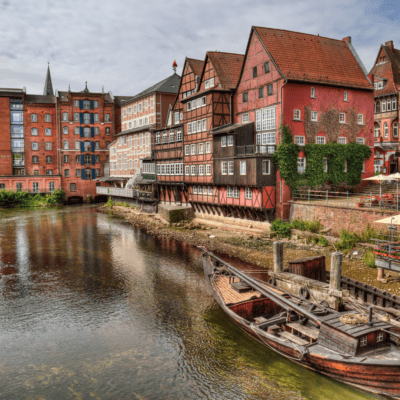
Visit Lüneburg
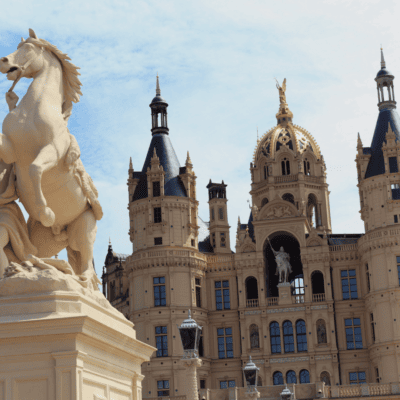
Visit Schwerin Castle & City
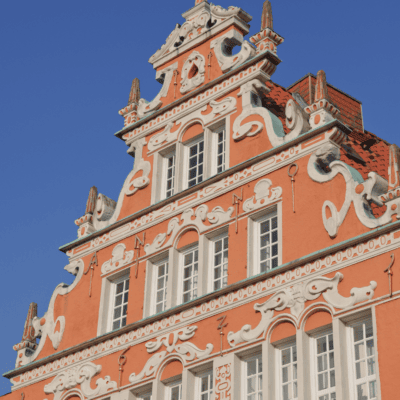
Visit Stade
FROM OUR AFFILIATES…
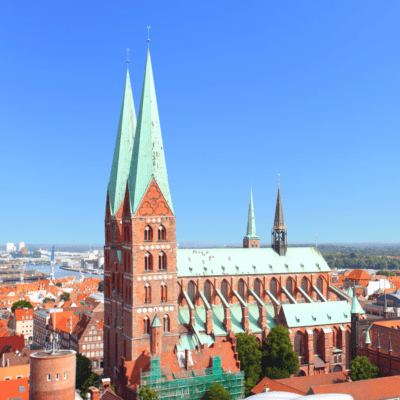
Private Tour – Lübeck from Hamburg by Train
A 1-Day, 6–7-hour private tour.
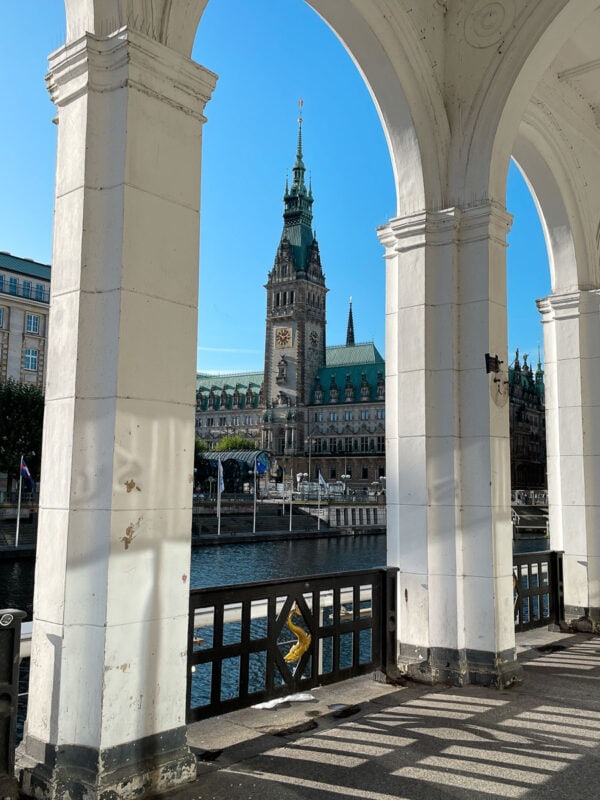
All Hamburg Tours & Tickets
See everything GetYourGuide has to offer for Hamburg!
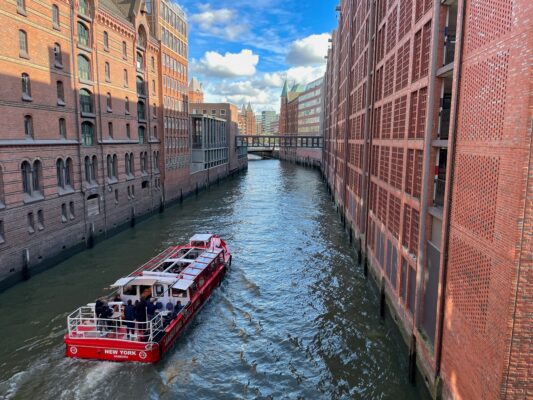
Hamburg Travel FAQ
Where is hamburg located.
Hamburg is located on the Elbe River in northern Germany, north of Bremen, south of Lübeck, and west of Berlin.
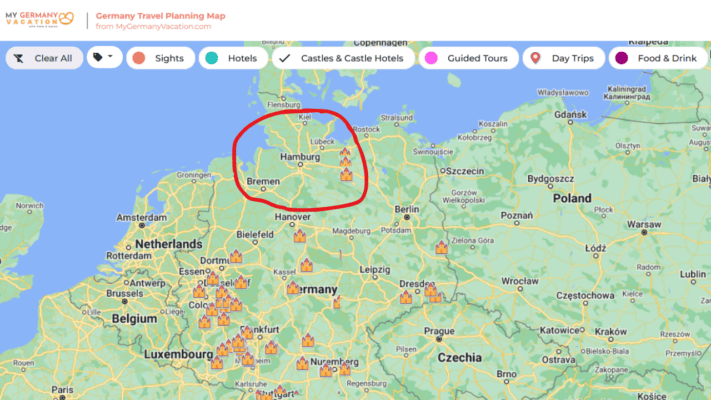
Where do I Get That Map?
If you have our Germany Travel Planner, you’ll find recommended hotels on our interactive planning map. Seeing where these hotels are in relation to the top sights makes it a lot easier to find the perfect place to stay. If you don’t have it yet, click here to get access.
Does Hamburg Have an Airport?
Yes! Hamburg has a good-sized international airport that you can easily reach from the city with flights all over Germany, Europe, and beyond. I’ve flown in and out of this airport several times.
How to Get to Hamburg ?
Hamburg is easy to reach via train, bus, car or plane. If arriving from the US, consider flying directly into Hamburg’s international airport. We’ve started doing this and usually transfer in London or Frankfurt after an international flight from the US. You can take an U-bahn (metro) from the airport into the city in about 40 minutes, hop in a taxi or book an easy airport transfer here .
How to Get Around Hamburg?
Hamburg has an excellent public transport system that you can use to go all over the city. If you’re flying into Hamburg you can easily take the U-bahn into the city center from the airport or arrange an easy airport transfer to your lodging.
If arriving via the main train station or bus station, you can walk to many hotels, catch a bus, U-bahn or S-bahn or grab a taxi. Hamburg’s public transportation is excellent and will easily get you where you want to go. If you use public transportation during your visit, I highly recommend getting a day pass over continually buying individual tickets.
Another way to get around Hamburg, at least for part of your visit, is the Hop On Hop Off bus ! We did this one day and actually had a lot of fun seeing a lot of the city in a short amount of time.
You don’t need a car to explore Hamburg. It’s better to take the S-bahn, U-bahn, bus, and ferry to get everywhere you want to go in Hamburg. There are also taxis, Uber, and the HOHO bus.
If you drive to Hamburg make sure your lodging has parking. It’s often possible to find on street parking but it’s not always easy, especially in some parts of the city. The last time we were in Hamburg we spent about 40 minutes looking for a place to park our car and then another 20 minutes walking to our Airbnb. It wasn’t a big deal for us on that trip but it’s something to be aware of.
Does Hamburg Have Uber?
Yes, you can use Uber in Hamburg. FreeNow is another good option.
Is Hamburg Worth Going To?
Yes! Hamburg is the largest city in northern Germany and is unique because it’s a city-state, meaning that Hamburg is both a city and Bundesland (state). There’s a lot to do and see in this beautiful maritime city, plus there are several options for day trips to cute town full of gothic brick, as well as beaches on the North and Baltic seas. You can even visit the islands of Sylt and Heligoland from Hamburg
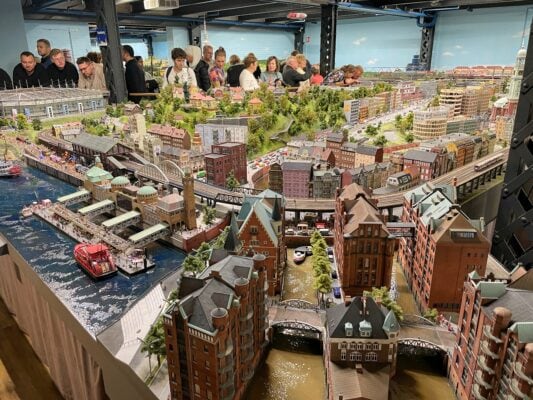
Hamburg Basics
Population 1.9 million (city) 5.1 million (metro)
Airport International Hamburg Airport Helmut Schmidt
Bundesland Hamburg (it’s one of 3 “city-states” in Germany)
Schleswig-Holstein is the state north of city
Lower-Saxony is the state south of city
Train Travel Times to Hamburg Berlin ➔ Hamburg = 2 hrs Frankfurt ➔ Hamburg = 4 hrs Munich ➔ Hamburg = 5.5 hrs Salzburg ➔ Hamburg = 8 hrs Paris ➔ Hamburg = 8 hrs Rome ➔ Hamburg = 20 hrs Prague ➔ Hamburg = 7 hrs
Fun Facts The greater Hamburg area has as many inhabitants as Norway!
Hamburg has more bridges in its city limits than any other in the world and more canals than Amsterdam and Venice combined!
Hamburg is often shortened to HH, which is what you’ll see on Hamburg license plates.
All Hamburg Posts…
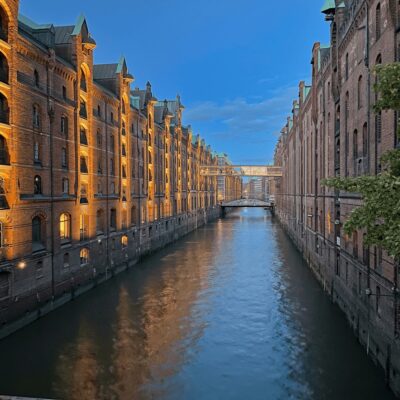
Best things to do in Hamburg
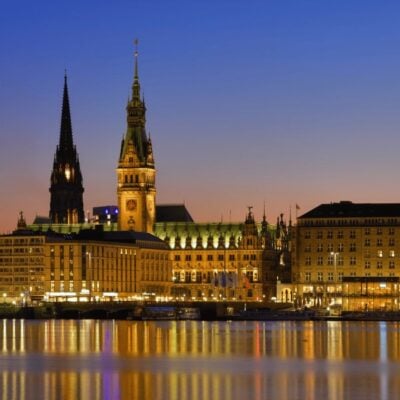
Where to stay in Hamburg

Best day trips from Hamburg
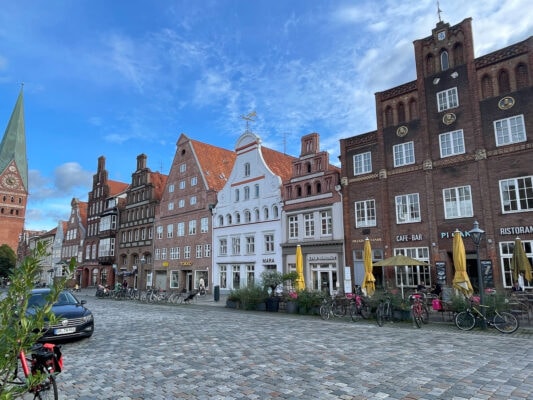
Road trip ideas and routes

- Interactive
- Comprehensive
- Informative
The Easy Way to Enjoy the BEST of Germany.
Planning a trip to Germany is surprisingly overwhelming – even for seasoned travelers!
That’s why we created the Germany Travel Planner .
With our 30+ years Germany travel experience and expertise by your side, you’ll navigate the complexities of trip planning effortlessly. And then enjoy a relaxed and memorable adventure filled with unique experiences tailored to your preferences!
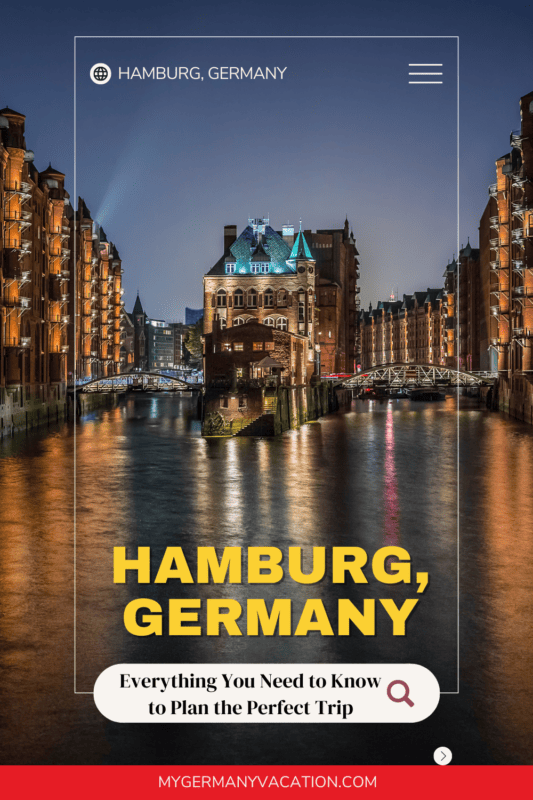
Grab our FREE Germany Trip Planning Checklist Now!

How To Spend 3 Days in Hamburg: The Perfect 3 Day Itinerary
Hamburg is a city that has been on my radar for many years. After my first trip to Europe back in 2007, I became obsessed with taking a month-long leave of absence from work to backpack in Europe and the many things to do in Hamburg were at the top of my list.
While dreaming about this endeavor, I googled in vain the places in Europe I may want to visit and still remember the day that Hamburg came up in one of my searches.
If you’re like me, I prefer to see things from a visual perspective before delving into the text and learning more. So I would spend countless hours scanning the image databases searching for cities to add to my faux itinerary to Europe.
I remember seeing images of Hamburg that invoked such a strong sense of wanderlust that it’s been on my list of places to see in Europe ever since then.
We spent 3 weeks in Germany. Check out our Germany articles !
No surprise, we added Hamburg to our itinerary on our 2 month trip through Europe this summer. Despite being caught in some summer rainstorms for most of our visit, we were both absolutely taken with the city and think anyone who doesn’t spend 3 days in Hamburg is crazy.
However, we do realize not everyone has the luxury to travel for long periods as we do, so I am going to make a strong case for why you should spend 3 of your precious vacation days in this cool city.
Tune into the comments below and let us know if we have convinced you to add Hamburg to your travel lists.
Don’t leave home without Lonely Planet Germany (Travel Guide)
Things to do in Hamburg, Germany
Table of Contents
Learn the Pirate History
As one of the great European port cities, Hamburg has a strong pirate history dating back to the 1300’s. A place that has been frequented by pirates throughout the centuries mostly tends to revolve its legend and lore around the famous Klaus Störtebeker.
He and his crew were captured and tried for piracy in Hamburg. Legend has it that Störtebeker offered a gold chain, long enough to enclose all of Hamburg in exchange for his life. It didn’t work and he, with his companions, was sentenced to death by beheading.
Upon execution day, Störtebeker is said to have asked the mayor of Hamburg to release as many of his companions as he could walk by after being beheaded.
Intrigued, the mayor granted the request agreeing to free every man his headless body would pass. Legend has it that Störtebeker’s headless body walked past 11 of his men before the executioner tripped him. 3 days in Hamburg is the perfect amount of time to listen to all the pirate lore.
Speicherstadt Warehouse District
This is the most picturesque place you can visit in Hamburg and in my opinion, in all of Europe. Ripe in history, the Speicherstadt is the largest warehouse district in the World with all the buildings standing on massive oak timber piles.
The district started to be built in 1883, finishing in 1927 and was operated as a customs-free zone. Originally the heartbeat of the city, today it is a protected UNESCO site and a place you can take some time to get lost in during your visit.
The contrast of the brick buildings with the dark blue water of the canals makes for an eye-pleasing experience. Spending 3 days in Hamburg will give you ample opportunity to explore this cool area of the city.
If it is seedy streets, pumping clubs and food from around the world that you seek, then you’d be on track to have a wander through Hamburg’s Reeperbahn district.
The area is famous for its prostitution history and contains Germany’s largest red-light district . It is an area that would have rivaled Amsterdam in its prime.
Today the scene on the Reeperbahn is less intense but street prostitution is still legal during certain times of the day on Davidstrasse.
There is also a small area that still exists featuring prostitutes behind windows that mirrors the scenes you’d get in Amsterdam.
As of 1933, large screens were installed to block the view of Herberstasse and signs were placed prohibiting the entrance of women and underage teens.

Testa Distribution Factory
While it is not possible to visit the inside, you can stand at the doors to the company that was hired by the Nazi regime to produce the toxin Zyklon B.
This toxin was the exact poison used in the gas chambers during WWII to exterminate people. The crazy twist is that the employees of the company didn’t even know they were producing the poison used in the concentration camps.
They thought it was being used for agricultural purposes. The owners of the company were directly collaborating with the SS to produce odorless poison. Both were tried and executed for their roles in WWII.
Save as you sight see around Hamburg with the Hamburg Card , yours for one great-value price. With your card, enjoy free or discounted entry to over 130 attractions and tours.
St Nicholas Church
Surprisingly, this site turned out to be my favorite during our visit. Which would seem odd to anyone who knows the church. Once part of the five main churches in Hamburg, St Nicholas Church now lies in ruins after being bombed during WWII.
Only the tower remains of this important Hamburg landmark which is impressive seeing as St Nicholas church was the tallest building in the World from 1874 to 1876. What really captivated me about this site is the single statue that stands in the destroyed courtyard.
At the top of a large column is a woman, looking down towards the ground. Along the column are sculpted hands that are reaching, grasping and holding their way in the direction of the woman. Long contemplation left me wondering if they were there to help her up or tear her down.
Landungsbrücken
The absolute essence of Hamburg is its spectacular waterfront port along the Elbe River. It is done great justice by offering a beautiful walkway along the river that offers you the opportunity to show a little, enjoy the ice cream shops and take in the shipping scene on the river.
You’ll also enjoy a panoramic view of the harbor and the new Elbphilharmonie concert hall. This area is especially great to visit in the evening light while the sun is setting and lighting up the sky in shades of pink.
St Michael’s Church
The main draw to this church is a climb up the stairs of the tower for a view of Hamburg. St Michael’s church is the most popular church in Hamburg and has been rebuilt 3 times over the course of its existence. It has been replicated in nine different cities in the World and is worth a visit when out exploring Hamburg.
Need to stay connected? Enjoy unlimited internet in Hamburg and everywhere in Germany with a 4G-LTE Pocket WiFi.
Hamburg Historic City Center
If you’ve done some traveling in Europe, you’ll know that every city has a main center point to it. It is usually a square surrounded by iconic architecture from the region you revisiting. Some of them are great, some of them not so much.
Rest assured, Hamburg has a stunning historic city center. During our 3 days in Hamburg, we made a point to visit this area every day. The layout is welcoming and you can’t beat the canals that run along the edge of the square.
When you’ve had enough sightseeing and you want to find that one district with the hip bars, trendy shops, and relaxed attitude than you should head straight to St Pauli.

In fact, we suggest you stay in this area. Well connected by public transport, this is the area to immerse you into today’s culture of Hamburg. We never tired of walking the streets in St Pauli when we were in need of a beer, coffee or meal.
Each little place has its own vibe and its all you can do to not let yourself wander inside each one of them as you pass by. Without a doubt, this is the place you want to spend your downtime while visiting Hamburg.
Why not get the keys to the city? Hamburg City Pass: One Day or Multi-Day Pass gives you the key to discovering everything in Hamburg Germany.
Tips for Visiting Hamburg
Besides saying that you should spend 3 days in Hamburg- that’s our first trip, we wanted to highlight some of the things that made our stay so great.
Our tips are designed to make your trip to Hamburg easier and give you some recommendations for your stay.
Transportation

We utilized two different forms of transport during our 3 days in Hamburg. First and foremost, public transportation is brilliant and routes around the city in a seamless way.
The Hamburg card gave us free transportation options on all buses, trams, ferries and metro trains during our stay. In addition to public transport, we also used the Hamburg Hop On Hop Off bus for another look at the city.
Hamburg Card

If you’re planning to spend 3 days in Hamburg (like we recommend) then you shouldn’t hesitate on purchasing a Hamburg card . This handy pass gets you discounted entry into over 150 attractions and offers free public transportation.
Accommodation
We’ve said it before and we’ll say it again now, stay in St Pauli. It’s the best district for a base. Our days were spent at the Superbude St Pauli , a place that is a marriage between a traditional hostel and a hotel.
If you want the hostel atmosphere, they have it. If you want a private room, they have that too. We saw people of all ages staying there, couples and even a couple of families.
Read reviews and check prices with our Hotel Search Engine , that gives you the best hotel deals found on the web. Our search engine pulls results from all of the major booking places, including Expedia, Hotels, Booking and more. All the options, all the deals, all in one place and just for you.
Free walking tour of Hamburg

As with any European city, we highly recommend joining one of the free walking tours of Hamburg that leaves from the historic city center on your first day in the city.
This is a great way to pick up some history, hear some stories and see some of the main sites. We took the free walking tour in Hamburg with Sandemans New Europe-Hamburg. If you’re lucky, you’ll get Julian for your guide.
Need to book a car for your road trip adventure? We use Discover Car Hire for comparing car prices to find the best deal. They search both local & international rental companies.
Fantastic Hamburg Tours:

Highlights of Germany Tour
Start and end in Frankfurt-am-Main! With the in-depth cultural tour Highlights of Germany, you have a 12-day tour package taking you through Frankfurt-am-Main, Germany and 13 other destinations in Germany. Highlights of Germany includes accommodation in a hotel as well as an expert guide, meals, transport and more.
Germany’s Cultural Cities Tour
Start in Berlin and end in Munich! With the discovery tour Germany’s Cultural Cities featuring the Romantic Road (Berlin to Munich), you have a 10-day tour package taking you from Berlin to Munich and through Berlin, Germany and 11 other destinations in Germany. Germany’s Cultural Cities featuring the Romantic Road (Berlin to Munich) includes accommodation in a hotel as well as an expert guide, meals, transport and more.
Central Europe Tour
Start in Hamburg and end in Krakow ! With the in-depth cultural tour Germany, Czech Republic & Poland Hamburg, Berlin, Leipzig, Dresden, Prague & Krakow, you have a 17-day tour package taking you through Hamburg, Germany and 15 other destinations in Europe. Germany, Czech Republic & Poland Hamburg, Berlin, Leipzig, Dresden , Prague & Krakow include accommodation in a hotel as well as an expert guide, meals, transport and more.
More on Germany:
- Ultimate Germany Road Trip Guide
- 30 Germany Photos That Will Spark Your Wanderlust
- 4 Days in Munich Itinerary-Things to do in Munich
- Germany Travel Guide
- Things to Do in Nuremberg-2 Day Nuremberg Itinerary
- Germany’s Romantic Road: The Only Guide You Need
- When is the Best Time to Visit Europe?
- 20 Simply Unreal Castles in Germany to Visit
- 10 Best Day Trips from Munich Worth Doing
- How to Visit Neuschwanstein Castle from Munich
- Elegant Elbe River Cruise with Viking River Cruises
- Viking River Cruises in Europe-What to Expect
Did you like this story? Share it!
Travel planning resources, about lina stock.
Lina is an award-winning photographer and writer that has been exploring the world since 2001. She has traveled to 100 countries on all 7 continents. Member: SATW, NATJA, ATTA, ITWA
6 thoughts on “How To Spend 3 Days in Hamburg: The Perfect 3 Day Itinerary”
Thank you so much for your detailed and interesting descriptions. we are going to Hamburg in the winter of 2020. your advice will help us make the trip even more interesting.
You’re welcome! Enjoy Hamburg, it’s a beautiful city.
Now you can visitit the St Nicolai steeple. There you can have a great view to Speicherstadt and Hafencity with Elbphilharmonie.
I would have never have thought to visit until seeing this. The pirate story alone is soo badass!
DO NOT TELL ME that you didn’t go to Miniature Wunderland!!!!
We didn’t! 🙂
Leave a Comment Cancel reply

Hamburg Travel Guide

Courtesy of Westend61 | Getty Images

Why Go To Hamburg
For travelers interested in a German vacation, Hamburg might not be an obvious choice – after all, the country also contains capital city Berlin and Munich – host of the annual Oktoberfest celebration. But as many visitors have already discovered, this thriving harbor city is almost sure to surprise and please you. What's more, Hamburg is also Germany's largest cruise port and the fact that passengers can walk to the city center from their ships is a big bonus.
Hamburg's bubbly energy is displayed in everything from HafenCity – a reinvigorated riverfront district – to its cutting-edge fashion design industry to its humming nightlife to its evolving dining scene. This northern city is also a watery one, crisscrossed by canals, sidling the River Elbe and wrapping around a lake. In fact, it has more bridges than Amsterdam and Venice, Italy, combined. You'll undoubtedly enjoy its beauty, but this cosmopolitan city also prizes its musicals, nightclubs, shopping and unparalleled Fish Market .
Find Flight and Hotel Deals
Navigate forward to interact with the calendar and select a date. Press the question mark key to get the keyboard shortcuts for changing dates.
Navigate backward to interact with the calendar and select a date. Press the question mark key to get the keyboard shortcuts for changing dates.
- # 15 in Best Places to Visit in Germany
Best of Hamburg
Best hotels in hamburg.
- # 1 in SIDE Design Hotel Hamburg
- # 2 in The Fontenay Hamburg
- # 3 in Hotel Louis C. Jacob

Best Things to Do in Hamburg
- # 1 in Elbphilharmonie
- # 2 in Alter Elbtunnel
- # 3 in Planten un Blomen

Popular Tours

Guided Hamburg City Bike Tour
(504 reviews)
from $ 39.94

Hamburg 2-hour harbor tour on the beautiful Elbe
(35 reviews)
from $ 37.72

Private Small-Group Hamburg City Tour with a Luxury Vehicle
(220 reviews)
from $ 265.17
Hamburg Travel Tips
Best months to visit.
The best time to visit Hamburg is the months between May and September when 70-degree temps sweep through the city. Room rates might be a bit higher and you may have more tourists to contend with, but the pleasant weather makes up for the elevated prices. For fewer crowds and potentially lower hotel prices (room rates remain pretty steady year-round), visit in the fall. The weather will be brisk with temperatures in the 50s and 60s, but the benefits might be worth the chill.
Weather in Hamburg
Data sourced from the National Climatic Data Center
What You Need to Know
- Pack a swimsuit In the summertime, the banks along the River Elbe are filled with swimsuit-clad locals sipping cocktails and consuming the sweet sunshine.
- Go the distance If you want a unique German experience, daytrip out to cities like Lubeck (think castles and marzipan) or Helgoland (Germany's sole offshore island). These are accessible by train, and in the case of Helgoland, both train and ferry.
- Sprechen Sie Englisch? Many locals speak English confidently, but knowing a few pleasantries in German can't hurt: "hello" is guten tag , "please" is bitte and "thank you" is danke schön . Locals greet each other with moin, another way to say hello.
How to Save Money in Hamburg
- Take a weekend trip Spending just a few days in Hamburg is enough time to see many of the top things to do, so book your trip over a weekend when business travelers have returned home and some hotels offer lowered rates.
- Purchase a Hamburg CARD This card offers unlimited travel on public transportation and discounted admission to a handful of museums. Cards can be purchased for one- to five-day intervals.
- Look, but don't buy Window-shop in the upscale malls on the Jungfernstieg waterfront, and you won't leave Hamburg with buyer's remorse.
Culture & Customs
Although German is the official language, many Hamburg residents speak English as well. But brushing up on a few German phrases is a good idea. Saying guten tag or hallo for "hello," bitte for "please" and danke for "thank you" is a good way to show respect to locals.
Punctuality and order are two characteristics highly prized by German culture, so be on time to any business meeting or formal engagement. When in a restaurant, do not leave your money on the table after receiving the check. Hand the money to the waiter and ask for your change. Tips are already included in your bill, but if the service was exceptional, it's customary to tip an extra 10 to 15%. For taxi rides, rounding up to the nearest euro is a sufficient tip.
Germany's official currency is the euro (EUR). Since the euro to U.S. dollar exchange rate fluctuates often, check what the current exchange rate is before you go. Major credit cards are accepted at most restaurants and shops.
What to Eat
Although Hamburg is probably not among the top culinary destinations of the world, the city's proximity to the sea gives its chefs lots of fresh fish to cook with ( Fischereihafen Restaurant is one of the city's most popular seafood eateries). And as Hamburg's a very green city, restaurants serve up a lot of seasonal and organic dishes, such as asparagus soup in the spring and cauliflower dishes in the summer.
Still, Hamburg holds to its roots, too, and traditional restaurants offer grilled or pickled herring, bratwurst, hamburger steak and eel soup. Hamburg's most traditional dish is the labskaus, which is described as sailors' food made of mashed cabbage, potatoes and beets, covered with a fried egg, pickled herring and pickled cucumbers on the side. Don't miss the delicious franzbroetchen , which is like a cross between a cinnamon roll and a croissant, and only found in Hamburg.
Beer is a big part of German culture; the legal drinking age for fermented beverages is 16 (or 18 for distilled alcohol). Germany also takes the quality of its suds seriously. There are a number of regulations, known as Reinheitsgebot (literally translated to "purity order"), that limit the number of ingredients used in the brewing process to only malt, hops, yeast and water. You'll find plenty of craft brews to sample around town; Braugasthaus Altes Mädchen is a particularly popular spot.
Be leery of pickpockets, especially in and around the Reeperbahn area. Women traveling alone should also take particular care when touring this area after dark. If you're planning to swim in the Elbe River, travelers warn of strong undercurrents and large waves (from passing ships) that can pull you under. You can also take a dip in the Outer Alster Lake, but keep in mind its relatively shallow depth (six feet in some areas to 16 feet in others). The U.S. Department of State urges travelers to exercise an increased level of caution when visiting Germany due to threats of terrorism. To receive alerts regarding security threats, sign up for the free Smart Traveler Enrollment Program .
Getting Around Hamburg
The best way to get around in Hamburg is by foot and the city's extensive and competent public transportation system. A suburban train (S-Bahn), a subway (U-Bahn) or a bus can take you everywhere your own two feet cannot. In fact, the system can take you from Hamburg Airport (HAM) into the city center with relative ease and for only a few euro. Taxis and MOIA, a ride-share service that operates similar to Uber, are available. Rental cars, though an option, are not recommended.
Entry & Exit Requirements
United States citizens who are visiting Germany will need a passport to enter and exit the country; it should be valid for up to three months from the date of departure from Germany. As party to the Schengen Agreement, U.S. citizens are able to visit Germany for up to 90 days without a visa. For more information on entry and exit requirements, visit the U.S. Department of State's website .
Did you know that Hamburg has more canals than Amsterdam and Venice , Italy, combined?
Explore More of Hamburg

Things To Do
Best hotels.

You might also like

New York City
# 1 in Best U.S. Cities to Visit

# 3 in Best Winter Vacations in Europe

# 2 in Best Places to Visit in Germany
If you make a purchase from our site, we may earn a commission. This does not affect the quality or independence of our editorial content.
Recommended
The 28 Best Water Parks in the U.S. for 2024
Holly Johnson|Timothy J. Forster May 8, 2024

The 18 Best Napa Valley Wineries to Visit in 2024
Lyn Mettler|Sharael Kolberg April 23, 2024

The 25 Best Beaches on the East Coast for 2024
Timothy J. Forster|Sharael Kolberg April 19, 2024

The 50 Best Hotels in the USA 2024
Christina Maggitas February 6, 2024

The 32 Most Famous Landmarks in the World
Gwen Pratesi|Timothy J. Forster February 1, 2024

9 Top All-Inclusive Resorts in Florida for 2024
Gwen Pratesi|Amanda Norcross January 5, 2024

24 Top All-Inclusive Resorts in the U.S. for 2024
Erin Evans January 4, 2024

26 Top Adults-Only All-Inclusive Resorts for 2024
Zach Watson December 28, 2023

Solo Vacations: The 36 Best Places to Travel Alone in 2024
Lyn Mettler|Erin Vasta December 22, 2023

26 Cheap Beach Vacations for Travelers on a Budget
Kyle McCarthy|Sharael Kolberg December 4, 2023

- 1 Day Itinerary
- 2 Days Itinerary
- 3 Days Itinerary
- How Many Days
- Photography Spots
- Hiking Trails
- Historical Sites
- UNESCO Sites
- Art Galleries
- Churches and Cathedrals
- Christmas Markets
- Live Music Venues
- Comedy And Theater
- Spa & Massage
- Cologne Carnival
- Cologne Cathedral
- Cologne Old Town
- Belgian Quarter
- Chocolate Museum
- Flora & Botanical Garden
- Cologne Zoo
- Fragrance Museum (Farina House)
- Museum Ludwig
- Rhine River Cruise And Boat Tours
- Walking Tours
- Brewery (Brauhaus) Tours
- Street Art Tours
- Self-Guided Tours
- Wine-Tasting Tour
- Segway Tour
- Ford Factory Tour
- Festivals and Holidays
- Does It Snow?
- Cologne or Koln? koeln? Is it the same?
- Best Restaurants
- Best Schnitzel
- Best Burger Joints
- Best Michelin Star Restaurants
- Best Breakfast and Brunch
- Best Italian
- Best Korean
- Best Mexican
- Best Chinese
- Best Indian
- Best Wine Bars
- Best Bars and Clubs
- Best Beer Gardens
- Best Romantic Restaurants
- Best Vegan and Vegetarian
- Is Cologne Worth Visiting?
- Koln Card (Cologne Card)
- Best Hotels In City Centre (Old Town)
- Best Boutique Hotels
- Best Business Hotels
- Best Luxury Hotels
- Best Cheap Hotels
- Best Family Hotels
- Best Gay Hotels
- Best Spa Hotels
- Near Train Station
- Near Cologne Airport
- Near Cologne Cathedral
- Near Cologne Christmas Market
- Near Koelnmesse Exhibition Centre and Lanxess Arena
- Hotels With Swimming Pool, Balcony And Parking
- Best Castle Hotels
- Best Bed And Breakfast
- Best Hostels
- Camping Sites
- Train Stations
- Cologne Bonn Airport
- Airport to City Centre
- Luggage Storage
- Renting a Car
- To Phantasialand
- Cologne to Dusseldorf
- Cologne to Bonn
- Cologne to Aachen
- Cologne to Dortmund
- Cologne to Essen
- Cologne to Munster
- Cologne to Duisburg
- Cologne to Bochum
- Cologne to Gelsenkirchen
- 1-Day Itinerary
- 2-Day Itinerary
- 3-Day Itinerary
- Basilika St Lambertus
- Stadtmuseum (City Museum)
- Goethe Museum
- Hetjens Museum
- Theatermuseum
- Classic Remise (Car Museum)
- Aquazoo Lobbecke Museum
- Museum Kunstpalast
- Botanical Garden
- Japanese Garden
- Apollo Theatre
- Capitol Theatre
- Savoy Theatre
- Photo Spots
- Dusseldorf Old Town
- Rheinuferpromenade
- Medienhafen
- Königsallee
- Schloss Benrath
- Schlossturm
- Little Tokyo
- Düsseldorf Kaiserswerth
- Kaiserpfalz Kaiserswerth
- Segway Tours
- Brewery Tours
- River Cruise & Boat Tour
- What to Pack
- Is Dusseldorf Worth Visiting?
- Best Burger
- Best Breakfast & Brunch
- Best Japanese
- Best Halal Restaurants
- Düsseldorf Card
- Best Hotels In Old Town (Altstadt)
- Best Hotels In City Centre (Stadtmitte)
- Near Dusseldorf Christmas Markets
- Near Dusseldorf Airport
- Near Train Station (Hbf)
- Near Messe Dusseldorf (Exhibition Centre)
- Best Campsites
- Dusseldorf Airport
- Dusseldorf to Cologne
- Dusseldorf to Dortmund
- Dusseldorf to Bonn
- Dusseldorf to Aachen
- Dusseldorf to Essen
- Dusseldorf to Munster
- Dusseldorf to Duisburg
- Dusseldorf to Bochum
- Dusseldorf to Gelsenkirchen
- Dusseldorf to Phantasialand
- With Family
- For Couples
- On A Rainy Day
- One Day Itinerary
- Two Days Itinerary
- Three Days Itinerary
- Flea Markets
- Fish Market
- Comedy Clubs
- Hamburg Old Town
- Miniatur Wunderland
- Elbphilharmonie
- Planten un Blomen
- Alter Elbtunnel
- Schanzenviertel (Sternschanze)
- Karolinenviertel
- Beatles Platz
- Hamburg Dungeon
- Harbor Tours
- Red Light District Tours
- St Pauli And Reeperbahn Tours
- Speicherstadt Tours
- Beatles Tour
- Best Hotels In City Centre (Altstadt & Neustadt)
- Near Hamburg Airport
- Near Hamburg Train Station (Hbf)
- Best Hotels In St Pauli
- Best Hotels In Reeperbahn
- Best Hotels In Blankenese
- Best Hotels In HafenCity
- Best Hotels In Sternschanze (Schanzenviertel)
- Best Bed And Breakfast (B&Bs)
- Hamburg Card
Is Hamburg Worth Visiting?
- Best Burgers
- Best Beer Halls
- Romantic Restaurants
- Vegan and Vegetarian
- Best Breakfast Places
- Best Cafes & Coffeeshops
- Best Brunch Spots
- Public Transport
Ultimate Hamburg Travel Guide: All You Need to Know
Updated on February 8, 2024
Hamburg Travel Guide
Planning a trip can be as exciting as it is overwhelming, especially when the destination is rich in culture and attractions like Hamburg, Germany. Known for its unique blend of maritime charm and urban flair, Hamburg captures the hearts of travelers from around the world.
Our travel guide zeroes in on all you need to know about this bustling city — from hidden gems to culinary delights, ensuring your Hamburg adventure is smooth sailing. Get ready to explore!
Yes, Hamburg is worth visiting . Visitors often find themselves enthralled by Hamburg's bustling port and cultural vibrancy. Those looking for an unforgettable culinary experience will be delighted with fine dining options that showcase a fusion of global flavors and traditional German fare.
Experience Hamburg's exciting nightlife where live music venues, bars, and clubs light up the night. Families enjoy outings to local attractions such as the zoo or one of many museums, while boat excursions offer a unique perspective on this maritime city.
Whether you're in town for business events or simply seeking leisure, Hamburg envelops guests in a dynamic atmosphere that combines relaxation and adventure seamlessly.
Planning Your Trip To Hamburg
Airport and transportation in hamburg.
Getting to and around Hamburg is a breeze thanks to its modern airport and an exceptional transportation network. Flughafen Hamburg serves as the city's gateway, whisking travelers from the sky to the heart of the action effortlessly.
Once you land, immerse yourself in comfort at the Hamburg Airport Lounge before diving into your adventure.
Navigating through Hamburg could not be simpler with the public transport system managed by HVV. Choose between swift U-Bahn metro rides, scenic ferry trips along sparkling waters or efficient buses that crisscross every corner of this bustling metropolis.
With trains zipping across both cityscapes and countryside views on regional routes, exploring beyond downtown becomes just as easy. For each journey within this vibrant city, public transportation offers a convenient, reliable option—ensuring your visit remains stress-free from start to finish.
Language And Visa Requirements
In Hamburg, navigating language barriers is a breeze for English speakers. Most locals and especially those in the service industry communicate comfortably in English, making your trip planning smooth.
Carry a handy phrasebook or translation app if you're eager to try some German phrases, but rest assured, you won't be left struggling to find your way around.
Before zipping off on your Hamburg adventure, take a moment to check visa regulations if you're not from the EU. European Union citizens can travel freely without worrying about visas.
However, travelers from outside the EU will need to review their country's specific requirements regarding travel to Germany - some may enjoy visa exemptions while others could require an application before arrival.
Double-check these details well in advance; this small step ensures nothing stands between you and exploring Hamburg's historic streets!
Electricity Socket And SIM Cards in Hamburg
The power supply in Hamburg operates at 230 volts and 50 Hertz, with two-round plugs commonly used. [ 1 ] Don't forget to pack the appropriate electrical adapter for your devices to ensure they can be plugged into the sockets.
If you need mobile internet access during your trip, consider getting a SIM card upon arrival; these cards can be used throughout Europe for up to 30 days, making them a convenient option for travelers needing seamless connectivity.
Moving on from planning essentials, let's explore the best time to visit Hamburg and what makes this city worth visiting throughout the year.
Car Rentals in Hamburg
Car rentals in Hamburg offer various options from companies like Avis Rent a Car, Enterprise, and Economy Car Rentals. Prices start at just $13 per day for a mini car, with full-size cars available for as low as $44 per day.
It's recommended to plan ahead and book a rental car in Hamburg to secure great rates; visitors can save up to 30% by comparing rates and booking in advance.
BEST GERMANY CAR RENTAL COMPANY: DISCOVER CARS
I never fail to recommend Discover Cars . After looking everywhere, I've found that they consistently offer the best deals around. To top it off, they also throw in free cancellation!
Best Time To Visit Hamburg
The best time to visit Hamburg is during the spring and summer months, from mid-April to mid-September. The city experiences a humid continental climate with a high chance of rain throughout the year.
July is the hottest month in Hamburg, while February is the coldest. If you want to avoid crowds, it's best to visit in April, May, or September.
So plan your trip accordingly and enjoy all that Hamburg has to offer during its recommended season!
Things to Do In Hamburg
Speicherstadt.
The Speicherstadt in Hamburg ranks as one of the largest warehouse districts worldwide and is a top thing to do for history enthusiasts. This historic neighborhood boasts renovated red brick buildings intersected by canals and bridges.
With its proximity to the port, a leisurely walk around the old warehouses presents an enjoyable experience on a sunny day. Moreover, visitors can explore some of Hamburg's finest museums in the Speicherstadt and neighboring HafenCity, such as the renowned Miniatur Wunderland.
Adjacent to the Speicherstadt lies the Kontorhaus district, offering an array of activities for curious tourists. The area’s rich heritage, coupled with its modern appeal, makes it an essential stop on any traveler's itinerary when visiting Germany's vibrant city of Hamburg.
Explore Old Town Hamburg
Explore the historic district of Old Town Hamburg, known as Altstadt, where visitors can soak in the city's rich cultural heritage and enjoy enchanting architecture. The area is a treasure trove of landmarks and historical sites, offering an immersive urban exploration experience.
With its scenic waterfront, charming art galleries, and captivating walking tours, Old Town Hamburg is a perfect destination for sightseeing enthusiasts.
Wander through cobblestone streets lined with stunning buildings that showcase 19th-century architectural splendor. Immerse yourself in the local culture as you discover the many hidden gems within this picturesque neighborhood - making it an essential stop on your visit to Hamburg.
St. Michaelis Church
After exploring the charming streets of Old Town Hamburg, a visit to St. Michaelis Church is a must for anyone wanting to experience the city's iconic landmarks. Also known as the 'Michel', this Protestant church stands as an impressive symbol of Hamburg's cultural heritage and maritime history.
The church's bell tower offers visitors a breathtaking panoramic view of the city, making it a popular sightseeing spot for tourists and locals alike.
St. Michaelis Church boasts stunning Hanseatic architecture and can accommodate up to 2,500 people, solidifying its status as Hamburg’s largest church. With its rich historical significance and commanding presence on the city skyline, this landmark is an essential stop for those eager to immerse themselves in Hamburg's unique charm and character.
Port of Hamburg
When you're ready to experience the maritime history and waterfront activities, a visit to the Port of Hamburg is a must. This bustling port welcomes tourists with its rich maritime heritage and exciting attractions.
Discover museums such as the German Customs Museum to delve into the port's fascinating past, or simply soak in the atmosphere at this major cruise destination.
Immerse yourself in the annual Hamburg Port Anniversary, celebrating the city's nautical legacy and drawing visitors from around the world. Whether you're interested in Baltic Sea attractions or want to explore a significant part of Hamburg's culture, there is something for everyone at this iconic tourist location.
Elbphilharmonie Hamburg
Continuing from the bustling Port of Hamburg, a visit to the Elbphilharmonie Concert Hall is a must for music enthusiasts and architecture admirers alike. This new cultural landmark offers a perfect symbiosis of stunning architecture and extraordinary music experiences.
Situated in the historic city port, it provides spectacular views of the Elbe River and harbor. The building complex includes both a philharmonic hall and a chamber music hall, along with restaurants, bars, and a panorama terrace offering breathtaking views of the city and harbor.
Visitors can book tickets online to ensure they make the most out of their experience at this iconic attraction.
Top Tours in Hamburg
In Hamburg, a wide range of tours awaits to cater to diverse interests and preferences. Whether you're a history buff, a culinary enthusiast, or an adventure seeker, there's a tour just for you. Here's a selection of some of the best tours in Hamburg:
- 1.5-Hour Harbor and Speicherstadt Day Cruise
- St. Pauli Highlights Guided Tour with Beer for 18+
- UNESCO-World Heritage Sites Tour
- Treasure Hunt Game through HafenCity
- Sex and Crime in St. Pauli Tour for Ages 18+
- Guided Walking Tour for Harry Potter and Magic Fans
This guide on Hamburg tours will provide insights into each of these tours, highlighting their unique features, advantages, and potential drawbacks.
You'll also find tips to help you choose the tour that best suits your interests and preferences. Taking a guided tour in Hamburg offers a wealth of benefits, including expert knowledge, a hassle-free experience, and personalized insights.
To make the most of your tour experience, it's recommended to read reviews, consider ratings, and opt for guides with extensive experience and knowledge.
Where To Stay In Hamburg
Best places to stay in hamburg.
The best places to stay in Hamburg include the City Center, St. Georg, and Hafencity, which are vibrant neighborhoods offering attractions and amenities for tourists. City Center is recommended as the top area due to its numerous attractions, unique bars, and amazing amenities.
Additionally, St. Pauli and Reeperbahn are ideal for those seeking nightlife hotspots with fresh and lively scenes.
Schanzenviertel is another popular neighborhood known for its entertainment options while Blankenese offers a more tranquil setting near the water. For those looking to experience the local culture or enjoy a beach atmosphere, Altstadt & Neustadt are excellent options with their array of attractions.
Budget Accommodations
Visitors to Hamburg can find a range of wallet-friendly accommodations, from hostels to alternative options like Couchsurfing. The city offers economical lodging choices in various areas for all budgets and preferences.
While Hamburg may not be considered cheap for tourists, the average daily cost for budget travel is estimated at around €80 (Approx. $86), allowing travelers to find reasonably priced accommodations while exploring the city's attractions.
Mid-range Hotels
The Renaissance Hamburg Hotel stands as a prime mid-range option, conveniently situated in the city center. It caters to visitors seeking affordable yet comfortable accommodations.
The article provides insight into where to stay in Hamburg for first-time visitors, nightlife enthusiasts, shopping lovers, and budget-conscious travelers.
Luxury Hotels
For those in pursuit of opulent lodging, Hamburg offers an array of deluxe accommodations to cater to discerning travelers. Tortue Hamburg, situated in the city center and conveniently near various attractions, is the recommended choice for a lavish stay.
This upscale hotel provides premium stays and trendy accommodations ideal for those seeking sophisticated hotels within walking distance of many sights.
Elegant options such as Tortue Hamburg boast exclusive amenities and stately suites suitable for travelers looking for high-end hotels in the heart of Hamburg. The article aids readers in finding the best deals on luxury accommodations while also providing insights into different budget ranges when choosing from the list of refined stays available across the city.
What To Eat In Hamburg
Traditional german cuisine in hamburg.
Hamburg's culinary scene offers a delectable array of traditional German cuisine, reflecting the city's rich seafaring heritage.
From classic seafarer meals like Labskaus and Finkenwerder Scholle to gourmet options in fine dining establishments, visitors can indulge in authentic flavors unlike anywhere else.
The hearty and rich dishes served in Hamburg are a testament to German culinary traditions, providing locals and tourists alike with an unforgettable gastronomic experience.
Breweries And Beer Halls in Hamburg
After indulging in traditional German cuisine in Hamburg, visitors can explore the city's vibrant beer culture at its breweries and beer halls. Hamburg offers a rich local beer scene with must-visit breweries that provide an authentic taste of locally made beer.
Beer enthusiasts can also enjoy the unique pub atmosphere at cozy beer halls and large outdoor beer gardens, making it a perfect place to start a night out in the city.
Craft beer lovers will find plenty to explore in Hamburg, which is known for its brewery tours and craft beers. The city’s lively and social atmosphere offers an excellent opportunity to experience authentic German beer while mingling with locals and tourists alike.
International Cuisine Options in Hamburg
Hamburg is a hub for culinary diversity, boasting an array of international dining options representing various world flavors.
From aromatic Indian curries to authentic sushi and tantalizing Lebanese mezze, the multicultural cuisine scene in Hamburg promises diverse dining experiences that cater to every palate.
Visitors can indulge in global food options at numerous restaurants scattered across the city. Whether you're craving spicy Mexican tacos or an elegant French meal, Hamburg's international culinary choices are sure to impress with their ethnic food offerings.
Unique Cafes And Bars in Hamburg
Hamburg boasts a wide array of dining and drinking options, ranging from trendy cafes to unique bars. Visitors can indulge in high-quality coffee at the city's many roasteries, or savor luxurious dining experiences at hip establishments along the waterfront.
The thriving nightlife scene offers a mix of vegan restaurants, sushi and ramen bars, beer houses, and döner eateries, catering to diverse preferences. With old brick buildings now housing these chic venues, Hamburg exudes an undeniable charm that is not to be missed.
The city invites visitors on a walking tour of its cafes and coffee roasteries for an immersive experience into its culinary offerings. Whether seeking trendy hotspots or more laid-back locales serving high-quality fare, Hamburg's dining scene promises something for everyone.
Getting Around Hamburg
Public transportation in hamburg.
Hamburg boasts an efficient public transportation system that includes underground trains, light-rail networks, buses, and ferries. Operated by the Hamburg Transport Authority (HVV), the U-Bahn Metro and S-Bahn provide convenient access to various parts of the city.
In addition to this, a comprehensive bus network offers extensive coverage within Hamburg and its surrounding areas.
The HVV tickets are easily accessible for tourists, with options such as single tickets, day passes, group tickets, and even special tourist cards like the Hamburg CARD that offer free access to buses, trains, and harbor ferries.
The transport network in Hamburg is robust; with over 450 lines departing per week it provides ample options for commuters seeking urban mobility or tourists exploring the city's attractions.
Bike Rentals in Hamburg
Explore Hamburg on two wheels with the convenient bike-sharing program, StadtRAD Hamburg. With over 220 stations scattered across the city, renting a bike is easy and affordable for both visitors and locals.
The racy red wheels of StadtRAD make it simple to pedal through Hamburg's charming streets or take a leisurely ride along the scenic waterfront, offering a low-cost way to access bicycles for exploring this vibrant city.
With easy access to bicycles in Hamburg, visitors can immerse themselves in local culture and seamlessly navigate the city's attractions at their own pace.
Whether cruising through historic neighborhoods or discovering hidden gems off the beaten path, renting a bike in Hamburg provides a convenient and eco-friendly way to experience everything this captivating city has to offer.
Safety And Expenses In Hamburg
Is hamburg safe.
Hamburg maintains a well-organized police force, contributing to its reputation as a safe city with low to moderate crime rates. The overall safety level in Hamburg is comparable to other major European cities.
However, visitors should remain cautious of pickpocketing in tourist areas, especially in the Reeperbahn district. As with any destination, it's important for tourists to be aware of their surroundings and avoid risky areas.
Despite this, Hamburg is generally considered safe for solo female travelers.
Is Hamburg Expensive?
Hamburg ranks as one of the most costly cities in Germany. The average daily expense for budget travel in Hamburg is around €80, not including additional costs for attractions and dining.
When considering living expenses such as accommodation, food, and local activities, the cost of living in Hamburg is notably higher compared to other German cities .
You might also like: Astonishing Facts About Hamburg that Will Amaze You!
Key Takeaways
- Hamburg's public transportation is user-friendly and includes U-Bahn, S-Bahn trains, buses, and ferries; tickets such as the Hamburg CARD offer unlimited access.
- The city accommodates all types of travelers with diverse lodging options from budget hostels to luxurious hotels in neighborhoods like City Center and St. Georg.
- Visitors can enjoy a variety of experiences including exploring historic sites like Speicherstadt, taking boat tours on the Port of Hamburg, or enjoying music at Elbphilharmonie Concert Hall.
- Culinary delights range from traditional German cuisine to international dining with plenty of breweries and beer halls for those interested in local brews.
- Renting a bike through StadtRAD Hamburg is a great way to see the city up close while walking offers an intimate view of its beautiful canals, architecture, and hidden gems.
References:
1: Germany – Power plug, socket & mains voltage in Germany, retrieved from https://www.worldstandards.eu/electricity/plug-voltage-by-country/germany/
About the Author
Stephan Drescher
Stephan Drescher, founder of germanytravel.blog, is a German travel expert and insider, providing trusted tips and advice for a perfect trip to Germany. Born & bred German.
- 1 Districts
- 2.1.1 Ich bin ein Hamburger
- 2.2 Climate
- 2.3 Tourist information
- 3.1.1 Airport Hamburg-Fuhlsbüttel
- 3.1.2 Hamburg-Uetersen Airport
- 3.1.3 Alternative airports
- 3.2 By train
- 3.5 By bike
- 3.6 By boat
- 3.7 Hitchhike
- 4.1.1 S-Bahn
- 4.1.2 U-Bahn
- 4.1.3 Buses
- 4.1.4 Ferries
- 4.1.5 Tickets
- 4.1.6 Jungfernstieg ferries
- 4.2 By bike
- 4.3 By ride pooling
- 4.4 By e-hailing
- 4.5 By taxi
- 4.6 Parking
- 6.1 Ferries across Elbe
- 6.2 Boat trips
- 6.3.1 Musicals
- 6.5.1 Street parties
- 6.5.2 Street parades
- 6.6 Beaches
- 6.7 Open Air
- 10.1.1 Vegetarian and vegan food
- 14.1 Swimming
- 14.2 Emergencies
- 15.1 Hospitals
- 15.2 Pharmacies
- 16.1 Religious services
The Free and Hanseatic City of Hamburg ( Freie und Hansestadt Hamburg ) is Germany's second-largest city and, at the same time, one of Germany's 16 federal states or Bundesländer . Prior to the formation of the modern German state, Hamburg for centuries enjoyed a status as de facto independent city state and regional power and trade hub in the North Sea. Although situated over 100 km (62 mi) upriver from the North Sea on the Elbe, Hamburg has been one of Europe's most important ports for centuries, as reflected in its full name referencing the Hanseatic League . The city was built upon a number of islands formed by the wide river and its larger and smaller tributaries, and a huge part of its southern half is occupied by the massive port.
With a tumultuous history preserved in more than just the ancient name, Hamburg grew to become one of Germany's most affluent cities, today hosting almost 1.8 million inhabitants and forming a metropolitan centre for many smaller cities and towns in neighbouring federal states. Its riverine location allows it to compete with Amsterdam or Venice with the number of canals, most of which (called "Fleet" or "Brook") are actually former small rivers and streams regulated to allow the sprawling city to expand over their banks. And on top of that, Hamburg has more bridges (over 2,300) than Amsterdam, Venice and London combined. There is plenty to enjoy in Hamburg, both in terms of views, culture and the general high standard of living Hamburg has come to be known for.
Districts [ edit ]

Understand [ edit ]
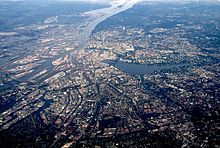
One of the most important harbours in Europe and the world, Hamburg takes great pride in its mercantile background, which built the city's wealth in the past centuries. From 1241 on, it was a member of the Hanseatic League , a medieval trade alliance across Northern Europe. In the 19th and beginning of the 20th century, millions left Europe on their way to the new world through the Hamburg harbour. Today, the harbour ranks second in Europe and eleventh world-wide. Consequently, one of Hamburg's tag lines is "the Gateway to the World" (derived from the city’s coat of arms, showing a white city wall with a gate and crowned by three towers on a red background). Hamburg is known to be one of the richest metropolitan areas in the European Union, in the company of Brussels and London .
The harbour is the heart of the city; however, Hamburg is also one of the most important media hubs in Germany. Half of the nation's newspapers and magazines have their roots in Hamburg. And, unknown even to some locals, is the fact that, with one of the Airbus aircraft assembly plants, Hamburg is a major location of the world's aerospace industry, after Seattle (USA) and Toulouse (France).
The city's mercantile background is reflected in its architecture. The only palace in Hamburg is the town hall, which houses the citizens' parliament and the senate. Apart from that, the city still has large quarters with expensive houses and villas. These residences were home to merchants and captains, surrounded by lots of greenery. Large parts of the city were destroyed during the devastating air raids of World War II, particularly the port and some residential areas, killing tens of thousands and leaving more than a million homeless, yet much of historic value has been preserved.
Hamburg still keeps its tradition of being an open, yet discreet city. Citizens of Hamburg, just like most Northern Germans, may appear to be quite reserved at first. Once they get to know you, they'll be as warm and friendly as you'd like.
History [ edit ]
Hamburg was apparently built as a defensive castle on the orders of Emperor Charlemagne back in 808 AD. Being on the frontline was a very auspicious position, and Hamburg has been raided and destroyed multiple times by the Vikings , Danes and Poles during its history. Despite this, it was rebuilt every time and was even afforded the title of "Imperial Free City" ( Freie Reichstadt ), which it proudly bears to this day, in 1189 (just in time for the Danes to invade it again).
Once Hamburg became an Imperial Free City, it established itself as one of the prime ports of Northern Europe, thanks to its favourable location up the navigable river Elbe, which prevented major storms from reaching it, and being almost equidistant from the North Sea and the Baltic. To gain access to the latter, Hamburg formed an alliance with Lübeck , which became the cornerstone of the Hanseatic League of ports of call and major trading centres around both seas, lasting up until the 17th century.

Hamburg found itself constantly changing, rebuilding and expanding, both due to being constantly ravaged by either foreign invaders or more mundane fires and diseases, and due to the rapid growth in its wealth and might. This provided for both the expansion of the harbour and allowed for ambitious building projects to be completed (including the almost complete regulation of Elbe's tributaries, or Fleeten ), and required the constant improvement of the city's defences. The most important thereof occurred when a new line of fortifications were created at the wake of the Thirty Years' War in the 17th century, effectively defining today's city centre ( Altstadt - the former old town - and Neustadt , one formed by expanding the range of the walls), not only in shape but also in the street structure preserved to this day.
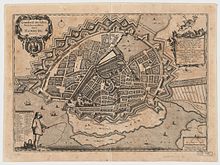
Meanwhile Hamburg saw itself become a "free" city more than in just the name, first adopting Lutheranism during the Reformation and accepting protestant refugees persecuted in their home cities, and later allowing pretty much full religious freedom, becoming home to all kinds of religious minorities, including Sephardic Jews and even Catholics. The citizens (particularly the wealthy merchant elite) pressed against attempts to impose laws on them, and negotiated "recesses" from their rulers, which meant that Hamburg was governed by a bicameral parliament with a relatively high degree of democracy and personal freedoms.
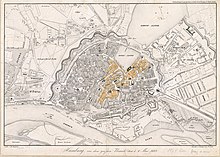
The last ruler to occupy Hamburg before the Second World War was Napoleon, driven away by the Russians in 1814. Continuing as a sovereign state in its membership of the various forms of German union, Hamburg evolved to become a modern republic. Exploding thanks to its prosperity, the city suffered a major drawback when a fire destroyed a quarter of it (yet killed only about 50 people) in 1842. Seizing the opportunities, the elders consulted architects, town planners and engineers to completely modernise the city. Among them was the British engineer William Lindley, who created a modern waterworks and sewage system for Hamburg, before going on to provide it to other cities like Budapest , Cologne , Düsseldorf , Frankfurt , Leipzig , Prague , St Petersburg and Warsaw .

Altona used to be an independent city and emerged as a fishing village west of Hamburg in the 16th century. For much of its existence, Altona was under the rule of the Danish king, competing with Hamburg in trade and militarily. Because of a comparatively liberal regime Jews, Calvinists, Mennonites and Catholics settled there, as they were put under less restrictions in Altona than in Hamburg. Altona was the second biggest city in the Kingdom of Denmark after Copenhagen and an important port for Danish trade. During its widest reach the Danish crown ruled a vast area from Altona to the North Cape to Iceland. The border between Danish rule and Hamburg partly ran through the built up area between the streets Große Freiheit (Altona) and Thalstraße (St. Pauli) near what is now Reeperbahn S-bahn station. After the 1864 "Schleswig War", which was mostly fought over Schleswig-Holstein , Altona was annexed to the Prussian state and took part in the founding of the German Empire in 1871. While it remained distinct from Hamburg (which was and is a "Free City" within German federalism), it was absorbed into greater Hamburg in 1937. Between Altona and Hamburg stood Hamburgischer Berg, a buffer zone that became Hamburg's borough of St. Pauli (named after the parish) in the 19th century. St. Pauli absorbed a part of the former fortifications of Hamburg, which were replaced by a ring of parks along the border of Neustadt.
Thanks to the improved living conditions, peaceful environment and economic prosperity, Hamburg boomed to 800,000 inhabitants in the second half of the 19th century, while also becoming a transatlantic port, home to Albert Ballin's Hamburg-America Line, the largest transatlantic line at the beginning of the 20th century. Hamburg became the gate to the New World for many emigrants and at the same time served as a gateway for produce from all over the world to enter Germany and Europe. Not only free and Hanseatic, the city became cosmopolitan in the strictest sense with the influx of traders and workers from all continents.
Hamburg had been a republic since the 13th century. In 1937 the Greater Hamburg Act transferred areas surrounding Hamburg proper from Prussia to the Hamburg. Altona, Harburg-Wilhelmsburg and Wandsbek were then incorporated into Hamburg. The area under Hamburg's rule increased by 80 percent and the population by 40 percent.
The cosmopolitan Hamburg suffered the loss of its independence under the Nazi regime (although not as much as Lübeck , whom Hitler disliked so much he had its "Free and Hanseatic" status revoked), but in turn its territory was expanded to include among others Altona and Wandsbek. During the Second World War , Hamburg was hit by devastating Allied air bombing, and the British became the last to occupy Hamburg after the War. Hamburg's independent status was restored by the British during allied occupation. In 1949 Hamburg was included in the Federal Republic of Germany created after the war.
After the war Hamburg was hit by the last major North Sea flood in Germany in the 1960s. Helmut Schmidt, then a local politician, distinguished himself by organising the rescue efforts and - constitutionally questionably at the time - using the military to help. This jumpstarted the career of the later chancellor of the Federal Republic. As Hamburg is more than 100 km inland nowadays flood warnings are broadcast as "German coast, Hamburg and Bremen" and not only "German coast" as before the flood.
Within post-war West Germany, Hamburg retained its status as a separate state on par with the likes of Bavaria or neighbouring Lower Saxony . Larger in area only than fellow Free and Hanseatic Bremen , when it comes to population count and especially economic might (measured in GDP) it easily outshines many other states, including neighbouring Schleswig-Holstein and nearby Mecklenburg-Vorpommern , and rivalling the potent Saxony up the Elbe. Being relatively urban with a long tradition of organised labour, Hamburg is often considered reliably "red" politically and has both produced several high profile Social Democratic Party politicians (including Helmut Schmidt) and been governed by Social Democrats for most of its postwar history.
Ich bin ein Hamburger [ edit ]
A Hamburger (with a capital "H") is indeed a citizen of Hamburg, and all of them would proudly refer to themselves as such. If you find it funny, you won't find many people to share the joke with in the city. The modern beef patty sandwich you might have in mind is an American invention, even if there are many theories somehow linking its name to that of Hamburg, and has only come to Germany (and Hamburg) with the spread of American culture and fast-food chains. Meanwhile, Hamburgers have been referring to themselves this way for centuries. The "burger" meanwhile is always pronounced in the American way, while the "Hamburger" referring to a person is always pronounced the German way with the food item sometimes pronounced the English way.
Climate [ edit ]
Tourist information [ edit ].
- Hamburg tourism website
Get in [ edit ]
By plane [ edit ].

Airport Hamburg-Fuhlsbüttel [ edit ]

The airport has been thoroughly modernised with new terminals, airport hotel, streamlined infrastructure, and facilities that are by and large adequate, so you won't get lost. Depending on the gate your flight arrives at or leaves from, walking longer distances might be necessary as with any other airport.
Hamburg Airport is connected to the city by the S-Bahn S1 commuter train line, which connects to the Central Station ( Hauptbahnhof ) and the city centre in about 30 minutes. There are trains every 10–20 minutes, and a single fare is €3.30. Beware on the way back from the city centre to the airport: All trains are divided at Ohlsdorf, with only the first three cars going to the airport, and the rest going to the suburb of Poppenbüttel. The stop at Ohlsdorf does last about two minutes as they uncouple the cars, giving passengers one more opportunity to make sure they're in the right train. There are no trains between midnight and 04:00, but bus 606 runs along the same route. As there aren't any flights between 23:00 and 06:00 this may not affect your journey at all. Do consult the timetable for S1 for details.
The airport, which is hugely popular with plane-spotters, is surrounded by Schrebergärten (meticulously maintained allotments), park lands, and open green spaces, criss-crossed by bicycle and walking trails. The popularity of this area is not only due to the many viewpoints, but also because Lufthansa Technik (Lufthansa's maintenance service) operates some large hangars on the airport, which means that the site is visited by a variety of rare and interesting aircraft (including VVIP).
Hamburg-Uetersen Airport [ edit ]
Alternative airports [ edit ].
You may also want to consider flying to the airports of Bremen , Berlin , Frankfurt , Hanover or Düsseldorf . From there you can take a train or intercity bus to Hamburg.
By train [ edit ]

- The Berlin to Hamburg route is a bit special; it has both ICE (fast, frequent, expensive) along with a few IRE (slow, infrequent, cheaper) trains. The IRE takes twice as long, but has a fixed price of €19.90 and €29.90 round trip [dead link] as of 2018. This can be a great deal if booking on short notice.
- Flixtrain serves the city.
- Direct service to or from Copenhagen and Aarhus ( Denmark ), Budapest ( Hungary ), Prague ( Czech Republic ), Vienna ( Austria ), Bratislava ( Slovakia ) (via Dresden ) and Stockholm ( Sweden ).
- An overnight train runs from Stockholm taking 12 hours.
Use the German railway's online trip planner to find connections to/from Hamburg and buy tickets.
The central station (Hauptbahnhof) is Germany's busiest and Europe's second busiest train station. Hence, it tends to be very crowded during rush hours. You might consider getting on or getting off the train at other stations such as Dammtor or Altona, if possible, especially if you don't have a seat reservation - while the trains fill up at central station, non-reserved seats are still free in Altona and Dammtor.
By car [ edit ]
via the Autobahn :
- A1 to/from Lübeck (north-east) — To get to the city change to the A24 at "Autobahnkreuz Ost".
- A1 to/from Bremen , Cologne (Köln) (south/south-west) — To get to the city change to A255.
- A7 to/from Kiel , Flensburg (north) — To get to the city exit at "Bahrenfeld".
- A7 to/from Hanover , Kassel (south)— To get to the city exit right after the "Elbtunnel" at "Othmarschen" or "Bahrenfeld". Use the rightmost pipe of the "Elbtunnel" to exit at "Othmarschen".
- A23 to/from Husum .
- A24 to/from Berlin .
Be prepared to pay for parking. Hamburg has a wide selection of P+R (Park+Ride) parking areas outside the city centre, where you can park either for free or for €2 a day and very easily use public transport to get into the city.
By bus [ edit ]
- 53.55188 10.011479 8 Intercity bus station .
Hamburg is one of just a handful of German cities that had a dedicated intercity bus terminal prior to the opening of the market in 2012/13. As such, the station amenities of ZOB Hamburg as it is known locally are likely a breath of fresh air compared to the city you arrived from. Flixbus has all but cornered the domestic market, but there are several operators for international destinations both near and far.

By bike [ edit ]
The Elbe Radweg , one of the most popular cycle routes in Germany, passes through Hamburg. As it follows the valley of the not very steep river Elbe for most of its course it is a good choice for inexperienced cyclists as well as aspiring Tour de France participants.
The North Sea Cycle Route (Nordseeküsten-Radweg) is the longest cycle route in the world that is continuously equipped with signposts. Circling the entire North Sea , it connects Hamburg with Denmark, Sweden, Norway, Scotland, England, and the Netherlands.
By boat [ edit ]
A lot of cruise ships visit Hamburg, so you may put your foot on Hamburg ground at one of the Cruise Centers. The most likely places are the Hamburg Cruise Center Altona (near to the fish market) and the Hamburg Cruise Center HafenCity (next to the Unilever-Haus), check out the Hamburg Cruise Center home page [dead link]
- 53.53861 9.99551 1 Hamburg Cruise Center HafenCity , Chicagokai .
- 53.5436 9.9375 2 Hamburg Cruise Center Altona (Dockland) , Van-der-Smissen-Straße 5 . This cruise terminal was inaugurated in 2011. With its glass facade, the single-storey terminal building blends perfectly into the architectural “string of pearls” along the Elbe. ( updated May 2018 )
There is a regular yet expensive ferry between Hamburg, Cuxhaven and Helgoland . Lübeck's port suburb Travemünde , about an hour away by train, is a major Baltic ferry port.
Hitchhike [ edit ]
You can leave Hamburg to the south (A7-Hannover/Frankfurt/Munich) and southwest (A1-Bremen/Cologne/Netherlands) from the filling station known as "HH-Stillhorn" you can get there with the number 351 bus to Freiluftschule-Moorwerder from suburban station S-Wilhelmsburg and exit at Schützenhof.
To the east (A24-Berlin) and northeast (A1-Lübeck/Rostock/Puttgarden-ferry to Denmark), you can start at the "Horner-Kreisel" and take the number 261 bus from U-Burgstraße to U-S Barmbek (exit BAB-Auffahrt Horn or walk from U3-Rauhes Haus.
Get around [ edit ]
Hamburg is an extensive city given its over 700 km², and visitor attractions are not all contained within the city centre. The city centre, however, is not very big and its attractions are all easily walkable. For other attractions fortunately, getting around is made easy by the extensive public transportation system. Walking is a good way of getting around in the centre, as pretty much around every corner is a sight to behold or a scenic lookout you might have missed otherwise. As many Hamburgers do, you may also opt to bike around. Driving is made relatively easy too by the wide thoroughfares intersecting the city in every direction, parking is paid but rates palatable and there is no requirement for your car to have an Umweltplakette .

Public transport [ edit ]
Hamburg's public transportation system, operated by the HVV , consists of:
- six S-Bahn (commuter railway) lines,
- four U-Bahn (subway) lines
- seven R-lines (regional trains),
- three A-lines (AKN)
- a dense network of bus lines,
- as well as ferries across the Elbe.
Hamburg is the biggest German city without a Straßenbahn (light rail/streetcar/tram) since it shut down its legacy system in the 1970s and despite numerous proposals and attempts to change that, there are no plans for a Straßenbahn network as of 2018. Hamburg has the S-Bahn and U-Bahn lines run partly over and underground, in the city, and in the outskirts. Sometimes you might meet the diesel powered AKN train as well in the northern districts. The only difference is that these are three companies, but there is a unified fare system.
All train platforms have signs showing the next train, where it is headed, and how many minutes until it arrives. Trains are described by a number and the final station. The final station may vary. For example, half of the S1 trains heading west go all the way to Wedel , but the other half go only as far as Blankenese.
Note that train doors do not open automatically. You have to press a button or pull a handle on the door. Wait for the passengers to get off first before you enter. In the cold season, close the door after getting on the train if it looks like a longer stop. Either push the handle or press the closing buttons on the inside until the door is closed. All signs and notifications at stations and in trains are shown in at least two languages (German and English).
Bizarrely Hamburg still had Bahnsteigkarten until 2024, otherwise long since abolished in all German cities except Hamburg. Basically they were required for people who wish to enter the platform area but do not wish to take a train. A Bahnsteigkarte would cost 10 cents and may have been worth buying for novelty value alone. They are no longer being sold, but you may still encounter signage referring to them.
S-Bahn [ edit ]
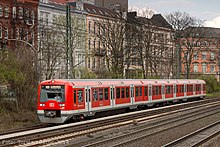
S-Bahn stations are marked with a green "S" and are often colocated with major long-distance railway stations and U-Bahn stations, allowing convenient transfers. While the S-Bahn logo is green, the trains are white-and-red like most German trains, and operated by Deutsche Bahn and feature a DB logo rather than the "S". It is easy to get confused by the variety of similar DB trains, so it is good to make sure you are boarding the S-Bahn you want and not a regional train.
There are six S-Bahn lines in Hamburg, with some confusing numbering and arrangements.
- all S-Bahn trains with single-digit numbers take the south underground route via Jungfernstieg, Landungsbrücken and Reeperbahn,
- while all S-Bahn trains with two-digit numbers take the north route via Dammtor, Sternschanze (Messe) and Holstenstraße.
All of the lines meet at Hauptbahnhof , which is also a station for all U-Bahn lines, and all lines save for the S21 also meet at Hamburg-Altona . From there, the S-Bahn lines radiate in 5 different directions.
- S1 links the far westward Wedel in Schleswig-Holstein and the neighbourhood of Blankenese with Poppenbüttel in the far north. In an unusual and potentially confusing arrangement, the first three cars of every train go to Hamburg Airport instead of Poppenbüttel , the division occurs at the station of Ohldorf. Note that the train reverses direction in Blankenese, so if you get on west of Blankenese, you have to take the last three cars to be in the front after the change of direction.
There is, however, an announcement made on the train (also in English) before the trains are separated to let you know if you are in a car going to the airport or not.
- S11 is a truncated version of S1 operated in peak hours only, without the option to go to the Airport . This means that there is no direct link between the Airport and Messe Hamburg.
- S2 , confusingly, is a rush-hour-only service that runs between Altona in the west and Bergedorf in the south-east.
- S21 , a permanent service, is even more confusingly running along a different route than S2. It reaches farther south-eastwise, down to the suburb of Aumühle , but does not go to Altona and instead to Elbgaustraße in the far northwest.
- S3 serves both sides of the Elbe - in a winding loop, it starts on its southern (left) bank in Stade in Lower Saxony , runs all the way east through Neugraben to cross the river at Hammerbrook and then through the Hauptbahnhof further east to both Altona and Elbgaustraße
- S31 is a truncated express version of S3 from Neugraben to Altona , operating permanently but skipping or alternating stations between peak hours and regular daytime.
S-Bahn runs from approximately 05:00 until 01:00 in the central city, but there is often no service past 23:00 in outlying districts. On weekends, it runs all night.
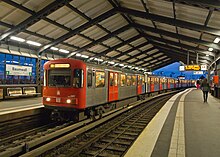
U-Bahn [ edit ]
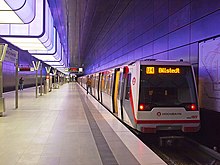
There are four U-Bahn (subway/underground) lines in Hamburg. They all run through the city centre and meet at Hauptbahnhof (although they stop at two separate stations - U1 and U3 at Hauptbahnhof-Süd , while U2 and U4 at Hauptbahnhof-Nord - both at opposite ends of the large Hauptbahnhof complex):
- U1 (blue) forms a huge V with the bottom south in the Altstadt and top northern ends (both actually splitting in two) into residential suburbs. This line may be useful if you want to visit the western bank of Aussenalster, as it has stations relatively close to it.
- U2 (red) runs from the east to northwest. One particularly useful feature is that it stops at Messehallen (fairgrounds), allowing one to quickly move there from Jungfernstieg.
- U3 (yellow) is by far the most useful to a tourist, as it forms a loop around the Altstadt and Aussenalster. It can take you to the Rathaus , the old harbour (next to HafenCity), Landungsbrücken, St. Pauli and even to the Stadtpark. It also stops at Sternschanze , the other entrance to the Messe (fairgrounds). While the loop is around the Aussenalster in the broad sense, none of the U3 stations are close to it, so you need to change to a bus line to get to the lake.
- U4 (aqua) shares the eastern branch with the U2, but rather than northwest it loops south to HafenCity.
All U-Bahn lines except U3 meet at Jungfernstieg , though U3 stops at the nearby Rathaus station and is accessible through an underground passage.
Note that none of the lines goes to Altona - you need to take the S-Bahn or a bus to get there. U-Bahn runs from approximately 05:00 until 01:00 in the central city, but there is often no service past 23:00 in outlying districts. On weekends (meaning Friday and Saturday, but not the night from Sunday to Monday), it runs all night.
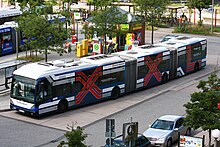
Buses [ edit ]
Buses go around the clock. At night, a special "Nachtbus" (night bus) service connects the outlying districts and the city centre. These buses depart and arrive at "Rathausmarkt", near the town hall and operate all through the night. Night buses are recognizable by their numbers which reach from 600 to 688.
Apart from regular and nighttime bus lines, there are also Metrobus lines, designed to carry heavy loads on the most popular routes, in a way replacing a tram system that Hamburg does not have (similar to the situation in most of West Berlin ). Metrobuses are designed to serve commuters mostly, and as such are not that useful to the tourists - in fact most lines do not even reach the core city centre. Public transport lovers will be delighted, however, to know that those lines are served by the longest bi-articulated low-floor buses in the world (the Van Hool AGG 300, also used by public transport operators in Utrecht ).
Be aware that there are a few special bus lines, called Schnellbus (fast bus). These have numbers in the 30 region, e.g. 37. These cost extra money, you can buy a Zuschlag ticket for €2.20 for any normal ticket you own (e.g. single or day ticket). In most circumstances you can avoid them because they are not really fast and most destinations can be reached by normal busses or trains.
Riding on a bus is easy. You have to enter a bus at the front door and show your ticket to the driver or buy one. You leave through one of the back doors. On the lines 4, 5 and 6 this rule does not apply, you can enter through all doors. All busses feature information systems providing you with information about the next stop. Some even feature large information screens and free Wifi.
Ferries [ edit ]
Six ferry services operate in the harbour and along the River Elbe as part of the regular public transport system. Tip: take ferry line 62 from "Landungsbrücken" to "Finkenwerder" and then line 64 to "Teufelsbrück" or take ferry line 72 from "Landungsbrücken" in the HafenCity to "Elbphilharmonie". Sit back to enjoy a scenic trip through the harbour on a day ticket.
Tickets [ edit ]
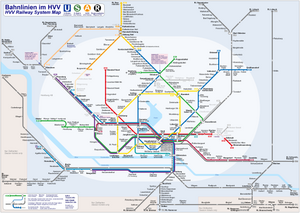
Hamburg's public transit operates on a proof-of-payment system; the tickets have date and time of purchase imprinted. Ticket inspectors make spot checks, but aside from that, you simply get on and off as you wish with no turnstiles or gates. You are required to show your ticket while entering a bus to the driver though.
Single tickets range from €1.70 or €2.30 for short trips and €3.40 for Hamburg area to €10.60 for the entirety of Greater Hamburg. Vending machines in the rail stations (and at some bus stops) sell short-distance, single-ride, and day tickets. Group tickets are also available. On the buses, the driver will sell you what you need but only for cash. They will give you change but mostly won't accept larger notes like €50.
An all-day ticket for Hamburg area (Ganztageskarte) costs €7.90; if you travel exclusively between 09:00 and 06:00 the next day on weekdays or all day until 06:00 on the next day on weekends, a "9 Uhr Tageskarte" (€6.60, Group Ticket up to 5 persons: €12) will be more worth it. You can also buy a Hamburg Card [dead link] , which includes the public transport system, museums, and other things, and is available at all ticket offices and from the bus drivers. To buy tickets for a week or longer, go to Hauptbahnhof or station Altona, get passport photos in the automated photo booth, and buy your pass in the information office.
If your German is good or you have friends to help, you can also use the HVV App on your smartphone to buy tickets. This is easy and also will save you 7% on any ticket you buy. After registration, you can use PayPal, a Visa or Mastercard debit/creditcard or a SEPA direct debit as a payment method.
If you are travelling to Hamburg using a Niedersachsen-Ticket (Lower-Saxony-Ticket) [dead link] , Schleswig-Holstein-Ticket [dead link] or Mecklenburg-Vorpommern (Mecklenburg-West-Pommerania-Ticket) [dead link] for one to five people (€22-39), you have access to all the HVV lines.
Try to avoid rush-hour before 09:00 and between 16:00-19:00. You are not allowed to take bicycles into subways before 09:00 and 16:00-18:00, unless it is a folding bike like a Dahon, Brompton, or Bike Friday. Folders are allowed on Hamburg public transit at any time of the day.
Jungfernstieg ferries [ edit ]
On the two Alster lakes, a ferry boat travels once every hour from Jungfernstieg in the city centre to Winterhuder Fährhaus. These boats are not in the general HVV ticket system , thus more expensive, however, they offer a splendid view to some of the wealthiest neighborhoods of Hamburg.
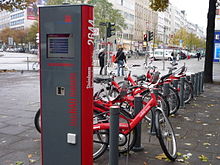
You will see a lot of bicycles on the roads during the warmer months, many of the city's residents will use bicycles as their normal form of transportation. Drive ways for bicycles are not available on all roads. In fact you will have to shift from on the road to a mixed foot and bike strip to a separated bike strip frequently. Drive safely! Several hotels within Hamburg provide residents with access to hotel bicycles.
The city itself also offers bike rental services. This service is called StadtRAD , and there are kiosks located all around the city. To use this service, customers must register on the StadtRAD website or smartphone app and create an account with a credit card. Once the account has been created, you can go to any one of these terminals and use one of their bikes as long as you want. The first 30 minutes are free, any subsequent time costs 8 cent/minute and the maximum charge is €12 per day. The bikes are sturdy with an integrated lock, lights and bag rack.
Alternatively, Hamburg City Cycles (working with the bicycle store next door) rents bicycles for €23 for 2 days and €7 for each additional day. Hourly rates are also available. The bicycles are large "cruiser" style bikes and the rental includes a lock, air pump, and toolkit if desired.
You can take your bike with you on the harbour ferries (e.g. line 62) free of charge.
By ride pooling [ edit ]
MOIA is an innovative service placed between bus and taxi . ( updated Jan 2024 )
By e-hailing [ edit ]
Uber and Free Now cover the city.
By taxi [ edit ]

There is a good supply of taxis in Hamburg 24 hours a day, both at taxi stands and in the streets. You can identify a taxi rank by a green box on a post somewhat like an oversized parking meter or alarm post. You will have to wait there or phone one of the numbers below, since the boxes can not be used to call a cab. Almost all vehicles are still in the traditional ivory white colour, but even if not, a yellow and black sign on the roof reading "Taxi" indicates a licensed cab. As usual, the sign is switched on to indicate vacancies. The taxi start at €2.90 plus €2.20/km. A trip in the city area will between €7-15. For a trip from the city to the airport, expect to pay between €20-30. Most taxis accept credit card payments.
Parking [ edit ]
There are generally 2 options:
- Parking in the city centre: most possibly, you will have to pay for parking. However, the maximum fee is €12 for 24 hours. This is a viable option if you would like to walk around the central area and you/your friends will not use the public transport.
- Parking in HVV P+R (Park & Ride): HVV offers free parking lots outside of the city centre. The idea is that you leave your car there and use the public transport to get around. If you and/or your company merely would like to travel around the city centre on foot, the first option is cheaper and makes more sense.
Hint: something in between the two options: select a suitable area of the city with good public transport link were you can park your car next to the road and then take the bus or subway (e.g. areas next to the bus line 5 or the U1)
See [ edit ]
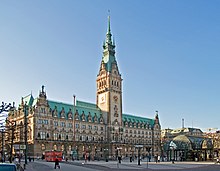
The entirety of the city centre is worth walking throughout, as it is jam-packed with varied and truly interesting sights. Those range from the iconic Speicherstadt and Hamburg's five main historic churches, through the upscale area around the Binnenalster artificial lake and the town hall ( Rathaus ) to the ultra-modern Hafen-City . The centre is where the majority of Hamburg's canals and bridges are, as well as the old quays providing great views across the Elbe. There is also an unusual array of museums to visit.
St. Pauli is the bustling district for party, non-mainstream shopping and Hamburg's largest funfair. The city's trade fairground ( Messe Hamburg ) and CCH (Conference Centre Hamburg) are also there. Altona has a long quay, with both the historic Landungsbrücken and parts still in active use, such as the Cruise Terminal and fishing harbour.
St. Georg immediately east of the Hauptbahnhof is a warm and welcoming area full of cafes and renowned for its gay culture, and it has the most upscale part of Außenalster's lakeside. The North is the greenest part of Hamburg, with the rest of Außenalster and numerous other parks, like Hagenbecks Tierpark the famous zoo established 1907 by Carl Hagenbeck, who was the pioneer behind "Zoos without bars".
The South is a mostly industrial area, with some unexpectedly interesting views of the decoratively lit up Borhardt quays and the planespotter's favourite Finkenwerder airport. Further south is the historic Harburg , formerly an independent city
Hamburg publishes a thick, detailed booklet of local museums called "Museumswelt Hamburg". You can find the Museumswelt Hamburg at the information desk at any of the museums. Hamburg is part of the worldwide Global Greeter Network (free sightseeing tours given by local volunteers).
Do [ edit ]
Ferries across elbe [ edit ].
You can make a trip on the river Elbe with line 72 from Landungsbrücken to Elbphilharmonie, or line 62 via Museumshafen Oevelgönne to Finkenwerder, and line 64 to Teufelsbrück. Bicycles free of charge. Adults one trip: €1.90/€2.95, day card: €5.80/€7.10. The public ferries are part of the public transport system, meaning day tickets for buses, subway and interurban trains are valid for the ferries as well. These public ferries (which prominently feature their line numbers) must not be confused with sightseeing ships and the private ferries that operate between Landungsbrücken and the musical theatres on the other side of the Elbe.
Boat trips [ edit ]
The best way to explore Hamburg's extensive waterways (Hamburg has more bridges than Amsterdam, Venice and London combined) is on a ferry or pleasure boat. A variety of boat tours lasting from 50 minutes to 3 hours depart regularly from the Jungfernstieg on the Inner Alster lake. The exact offer varies depending on the season, so do check in advance or at the landing stage to see what's available. The simplest and shortest tour is the Alsterrundfahrt or Alster tour that lasts 50 minutes and takes in the Inner and Outer Alster lakes (adults €15). The small cruise boats are often hired for weddings. One is an old steamer. Contact Alster Touristik on 35 74 24-0 or check out the website at www.alstertouristik.de [dead link] .
Theatre, opera and musicals [ edit ]
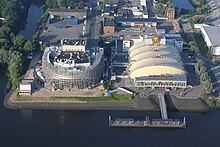
Hamburg has an opera house, venues where classical music is performed and many theaters. The city offers a number of different musicals , as well as other music events. Most of these venues are located either in the central or the eastern parts of the city. If you prefer less formal venues, head to St. Pauli .
Musicals [ edit ]
- Neue Flora: Das Phantom der Oper produced by Andrew Lloyd Webber.
- Operettenhaus: Rocky - Das Musical
- Theater im Hafen: König der Löwen (The Lion King) produced by Disney.
All musicals are in German language, regardless of their origin. If you're still interested, make sure to buy tickets early, many shows are sold-out. But, midweek there is a good chance that you will be able to buy last minute tickets at a highly discounted price of €40 regardless of price category, age, or occupation.
Sports [ edit ]
- Football: Hamburger SV and FC St Pauli soccer teams are both based in the St Pauli district.
- Hamburg Towers play in the Basketball Bundesliga.
- HSV Hamburg is the local handball team, playing in the Sporthalle Hamburg in Hamburg-Winterhude (2. Bundesliga)
- Hamburg Blue Devils — four times German American Football Champion due to financial struggles they had to relegate themselves into a lower division prior to the 2014 season. They are making their way back up through the leagues.
- American Football team Hamburg Huskies play in the German Football League 2
- Hamburg Stealers play in the first German baseball league
- Hamburg European Open in Men's Tennis are held at the Rothenbaum in Hamburg. The tournament is one of nine ATP Masters Series tournaments.
- Haspa Marathon Hamburg — April
- Hamburg Wasser World Triathlon — the only German Triathlon World Cup (July)
- Vattenfall Cyclassics — World Cup and public bike race (August)
- Go hiking around the city - there are plenty of options to choose from, such as Stellingen - Ohlsdorf hiking trail or the Ohlsdorf Jenfeld route .
- Shooting from a real gun at Hamburg Shooting Club in the city centre.
- Skateparks include Skatepark Holstenstraße or indoor I-Punkt Skateland .
Events [ edit ]
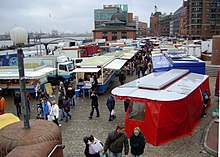
- Night of Museums in April is big in Hamburg. Over 50 places take part and are open till 02:00. Entrance to museums is not free, but the cost is symbolic, ticket everywhere (plus public transportation) costs €12 (discounted €8).
- Fischmarkt (Fish Market) — Every Sunday morning vendors praise wares of virtually every type at Hamburg's oldest open-air market, dating back to 1703. The market takes place at the foot of the century-old Fish Auction Hall, where live-bands perform jazz, skiffle, country, or western music. Open every Sunday from 05:00-09:30, in winter from 07:00-09:30.
- Hafengeburtstag ( Harbour Birthday ). Every year in May the harbour birthday attracts millions of people. Dozens of stands and stages, a ship parade, and changing events are organised to celebrate the cities spring of wealth. The harbour dates from 1189. Since then, the Harbour Birthday has grown into the greatest harbour party in the world. It is generally in early May.
- Kirschblütenfest ( Japanese Cherry Blossom Festival ). On May 19, the Japanese community of Hamburg celebrates the Japanese Cherry Blossom Festival by the Lake Alster. Enormous fireworks and a peaceful atmosphere are characteristics of this event.
- Hamburger Dom ( U3 to St Pauli ). The Dom is one of the largest fairs in Germany. The streets of the fairground, lined on both sides with rides, amusements and food and drink stalls, are some 3.3 km long. It takes place for three separate months in spring, summer, and early winter. ( updated Dec 2022 )
Street parties [ edit ]
Watch out for neighbourhood and street parties during summertime. Some of the biggest are:
- Altonale , in Ottensen.
- Bergedorfer Stadtfest , in Bergedorf.
- Osterstraßenfest , in Eimsbüttel.
- Schanzenfest , in Schanzenviertel is self-organised and full of peace and happiness until it ends around 22:00 in fighting between a crowd and the police.
- Stuttgarter Weindorf — Vintners from southern Germany present their products at the Rathausmarkt (town hall square).
Street parades [ edit ]
- Schlagermove Parade , a parody on the Berlin Loveparade with schlager instead of techno music.
- Hamburg Pride , the Gay Pride Parade usually takes place in August and moves from the Central Station through the shopping streets to end at the Jungfernstieg with the set up party tents.
Beaches [ edit ]
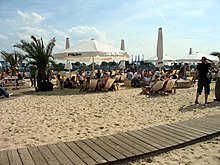
There are a number of small beaches on the North side of the Elbe river between Övelgönne and Rissen, the one in Övelgönne being the most popular one due to its proximity to the city centre. Swimming in the Elbe is not forbidden, but the water is not of high quality, and strong currents occasionally lead to casualties. Swimming is more common at Blankenese beach and Falkensteiner beach than at Övelgönne beach. Stay close to the shore. You may have a barbecue there in the evenings, as long as you bring a grill and clean up after yourself. Watch out for surprisingly large waves created by large ships passing by and stay clear at least 50m of any structure in or reaching into the water! See Stay Safe below!
In addition, there are a usually number of commercial beach clubs during the summer, usually between Fischmarkt and Övelgönne. Other than the name might indicate, these are bars open to the public.
From Altona, bus 112 leads to (and terminates at) Övelgönne. Commuter railyway S1 leads to Blankenese, from there bus 48 leads to the beach. Falkensteiner beach can be reached from commuter railway stop Othmarschen with bus 286 (stop at Tinsdaler Kirchenweg, then it's a 15-minute walk).
Open Air [ edit ]
- There are some OpenAir Festivals around Hamburg. One is the Wutzrock Festival . It is free of charge and near the city, so you might check it out if you happen to visit Hamburg in late August. It takes place at the "Eichbaumsee" next to the Trainstation "Mittlerer Landweg" (via S-Bahn 21 to Aumuehle/Bergedorf) usually the last weekend of August.
- Wacken Open Air .
Learn [ edit ]
There are 11 universities in Hamburg, the biggest of which is the University of Hamburg . Many courses and programmes are held in English.
Hamburg is home to schools from countries such as Japan, Sweden, France, Britain and more, where the pupils are taught in their native language. The International School Hamburg opened in 1957 as the first of its kind in Germany.
Work [ edit ]
The harbour is the fastest growing job sector in Hamburg. Numerous minor and major companies work in that area. You should be able to speak German because due to the high unemployment rate in Germany's jobseekers are attracted by the relative lower unemployment rate in Hamburg. This results in high numbers of applications. Hospitality and media are the two main other industries.
Living costs in Hamburg may be significantly higher than in other big cities in Germany depending on your demands. Inner city areas have become quite popular among doctors, lawyers and architects. Especially flats in early-20th-century Victorian-style houses – rare due to heavy destruction during World War II – are highly demanded. If you want a flat in an attractive area, be prepared to compete with well-off locals.
Buy [ edit ]

The main shopping area of Hamburg is the 53.5514 10.0028 1 Mönckebergstraße in the centre of the city. This area features the stores you're guaranteed to find in major German cities such as Galeria Kaufhof, Karstadt, C&A and Saturn and further west fashion stores of common international brands. Take the subway to either central station, Rathaus (town hall), or Mönckebergstraße. Also check the side-street Spitalerstraße. Northwest of town hall towards Gänsemarkt are the more pricey shops like Hugo Boss.
The 53.5617 9.9659 2 Schanzenviertel is also getting more popular nowadays for unique designer boutiques. Younger people especially enjoy being here. Subway "Sternschanze"/"Feldstraße"
Shops are mostly open daily 10:00-20:00 and on Thursday and Friday until 22:00.
Eat [ edit ]
Cuisine [ edit ].
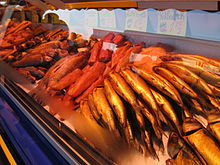
Original Hamburg dishes are Birnen, Bohnen und Speck (Low Saxon Beren, Bohnen un Speck , green runner beans cooked with pears and bacon), Aalsuppe (Low Saxon Aalsupp/Oolsupp , often mistaken to be German for “eel soup“ ( Aal / Ool translated ‘eel’), however the name probably comes from the Low Saxon allens [ʔaˑlns], meaning “all”, “everything and the kitchen sink”, not necessarily eel. Today eel is often included to meet the expectations of unsuspecting diners.), Bratkartoffeln (Low Saxon Braatkantüffeln/Brootkantüffeln , pan-fried potato slices), Finkenwerder Scholle (Low Saxon Finkwarder Scholl , pan-fried plaice), Pannfisch (pan-fried fish), Rote Grütze (Low Saxon Rode Grütt , related to Danish rødgrød , a type of summer pudding made mostly from berries and usually served with cream, like Danish rødgrød med fløde ) and Labskaus (a mixture of corned beef, mashed potatoes and beetroot, a cousin of the Norwegian lapskaus and Liverpool 's Scouse (food), all offshoots off an old-time one-pot meal that used to be the main component of the common sailor's humdrum diet on the high seas).
Alsterwasser in Hamburg (a reference to the city's river Alster with two lake-like bodies in the city centre thanks to damming), a shandy of equal parts of beer and carbonated lemonade ( Zitronenlimonade ), the lemonade being added to the beer. Mexikaner is another local speciality, a shot drink with vodka (or similar), tomato juice, chili and Worcester sauce that resembles a bloody Mary, but is knocked back in one go. There is a lot of good-natured rivalry between bars as to who can concoct the best Mexikaner, so if the concept appeals, be sure to taste how it differs from place to place.
Hamburg is also home to a curious regional dessert pastry called Franzbrötchen . Looking rather like a flattened croissant, the Franzbrötchen is somewhat similar in preparation but includes a cinnamon and sugar filling, often with raisins or brown sugar. The name may also reflect the roll's croissant-like appearance – franz appears to be a shortening of französisch , meaning "French", which would make a Franzbrötchen a “French roll.” Being a Hamburg regional food, the Franzbrötchen becomes quite scarce outside the northwest German region.
Ordinary bread rolls tend to be oval-shaped and of the French bread variety. The local name is Rundstück (“round piece” rather than mainstream German Brötchen , diminutive form of Brot “bread”), a relative of Denmark's rundstykke . In fact, while by no means identical, the cuisines of Hamburg and Denmark, especially of Copenhagen have a lot in common. This also includes a predilection for open sandwiches of all sorts, especially topped with cold-smoked or pickled fish. The American hamburger seems to have developed from Hamburg's Frikadelle : a pan-fried patty (usually larger and thicker than the American counterpart) made from a mixture of ground beef, soaked Staling, egg, chopped onion, salt and pepper, usually served with potatoes and vegetables like any other piece of meat, not usually on a bun. Many Hamburgers consider their Frikadelle and the American hamburger different, virtually unrelated. The Oxford Dictionary defined a Hamburger steak in 1802: a sometimes-smoked and -salted piece of meat, that, according to some sources, came from Hamburg to America.
Vegetarian and vegan food [ edit ]
A very easy Turkish food to find in Hamburg is Kumpir, a stuffed baked potato, served with salads, appetizers and sauces. Mostly veg, non vegetarian options are also available. Impossible to find in the Turkish neighborhoods in Berlin, it's very popular in Hamburg. Vegan-friendly restaurants include Chay, Holy Taco, TA Vegan House and Vincent Vegan (one of many snack bars at the Hauptbahnhof (Central Station).
Drink [ edit ]
Reeperbahn in St. Pauli is the place to go for late-night, all-out partying . Matter of fact, that corner of the city has the highest concentration of all kinds of places to go out for a drink, from beach clubs along Elbe river to different music clubs , nightclubs and bars .
If you want to relax and drink a coffee in some cafes go to Lange Reihe . Many bars, cafes and restaurants all along the street. Although the Lange Reihe is the heart of the gay community , most places are jointly visited by straight and gay people of any age. All places are gay-friendly, and many are gay-owned or gay-run. Here [dead link] is some information on parties and other news from the gay scene.
Sleep [ edit ]
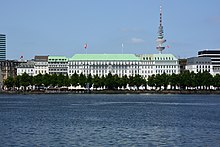
There are plenty of hotel rooms across Hamburg and, although not a cheap city in general, you may find the price range to include much more affordable choices than in other northern metropoles. There are many higher-end hotels within the small central Neustadt-Altstadt area, but you options are certainly not limited to those. Hotels around the Aussenalster in the North provide relaxed comfort, while further up north you will find hotels closer to the airport, convenient for those arriving by air. The Atlantic and the Vier Jahreszeiten share the prize of Hamburg's best hotels over the last one hundred years. Emperors and movie stars have stayed there. The luxurious hotels at the waterfronts of the Alsters is actually reminiscent of Geneva .
Altona and St. Pauli contain both hotels aimed at business travellers arriving at the trade fairs and those along the coastline, offering great views at different prices. There you can find hotels at the other end of the price scale, catering to people who've come to take part of the city's nightlife. East of the centre, in turn, you will find more business hotels and budget accommodations, usually very conveniently linked with the centre, but often less expensive due to their unspectacular location. Finally, the South has a very small supply of accommodation options, but those can be worth reviewing by those arriving by car.
Connect [ edit ]
Contrary to what one might suspect from a city with such a cosmopolitan perspective and media presence, Hamburg does not have that many free WiFi spots. This is due to peculiar German legislation, which Hamburg's senate has had decided to challenge in late 2014 with the goal of providing free wireless Internet at least in the city centre by 2020.
Free WiFi has been implemented at most U-Bahn stations and some S-Bahn stations in the city centre, including the main stations and in a few public spaces (e.g Rathausmarkt).
Also, free WiFi can be obtained in some cafes and restaurants. Do note that not all gastronomic outlets provide free WiFi - do check before you sit down there to avoid disappointments. Another way is to simply buy a German prepaid SIM-card - as of 2015, 1GB can come as cheap as EUR 10, and 5GB at EUR 20. If you do not want to carry two phones or change the SIM-card in your regular phone, a solution can be to buy a standalone WiFi device to put the card into.
Stay safe [ edit ]
Hamburg is generally a safe city. Watch out for pickpockets, especially in the area around the Mönckebergstraße, Central Station, on the Reeperbahn, in buses and trains, but also on crowded escalators and other crowded places. Keep your distance from protest marches unless you wish to get involved: both leftist groups and the Hamburg police are known for their heavy reactions in such situations.
Swimming [ edit ]
Bathing in the River Elbe is possible but, of course, you must keep out of the way of ships. Swimmers can be thrown about and even totally swamped by the wake from ocean liners. Swimmers should also stay away from structures in the river and strictly avoid an area about 50 m around those extending into the river.
Strong underwater swirls going down as deep as 10–15 m and even close to the beach may pull the strongest swimmers under water. When relaxing on one of the beaches along the riverside, keep several metres away from the water's edge and keep an eye on children playing in or near the water. Container ships passing by sometimes create surprisingly large waves that won't just get your feet wet on the beach, but may also drag you into the Elbe.
Swimming in the Outer Alster lake is possible, though swimmers are rarely seen. The water is fairly clean. The lake is only about 2–3 metres deep.
Emergencies [ edit ]
Important phone numbers for emergencies (dial without any local prefix anywhere in Germany, always free of charge):
112 = Medical emergency and fire department
110 = Police
Note that the Hamburg police wear dark-blue uniforms, unlike the federal German police and many of the other state police forces in Germany, which still wear green uniforms.
Stay healthy [ edit ]
Tap water is very clean and you can drink it without any exception, even use it to provide baby food. Hamburg has a very reliable healthcare system. You can be sure that an ambulance will arrive within 10 minutes after the call. The emergency number is 112 , as in most of Europe. For non-emergency situations, call 116 117 to reach the federal KVHH service, where you can get advice from a doctor, book an appointment, and if they deem the situation serious they'll connect you to 112.
Hospitals [ edit ]
In addition here is a list of the emergency rooms in the city, and here [dead link] of some more that are open mostly during the evenings.
Pharmacies [ edit ]
There's a comprehensive network of phramacies that are open late or even around the clock. Apotheken-Notdienst -pharmacies also have healthcare professionals on duty.
Cope [ edit ]
Religious services [ edit ].
- 53.5575 10.0135 4 St. Marien , Danziger Str. 60 ( St. Georg, near to central station ). Holy Mass Su 08:30, 10:00, 12:00 (Portuguese), 15:00 (Croatian), 18:15, M-Sa 18:15; Th 21:30 . Catholic cathedral ( updated Mar 2015 )
- 53.5779 9.9853 5 St. Elisabeth , Oberstr. 65 ( district Harvestehude ). Holy Mass Sa 18:00, Su 10:00, 12:00 (English), 17:30 (Spanish), 19:30 (3rd Su only), Tu Th F 19:00, W 15:00 . ( updated Mar 2015 )
- 53.54917 9.98308 6 St. Ansgar ( kleiner Michel ), Michaelisstr. 5 ( district Neustadt ). Holy Mass Su 09:30, 11:30, 15:30 (Tagalog), 19:30. M F 18:30, W 09:30, 19:00 (Tagalog) . ( updated Mar 2015 )
Go next [ edit ]
Both North Sea and Baltic Sea beaches are reachable within an hour by car, railway, or bus. As Hamburg is a port city several ferries and cruises as well as freight ships can get you to (almost) everywhere in the world as well.
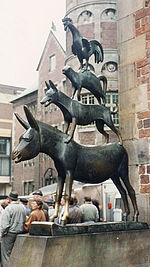
- Bremen — A hanseatic city 95 km away, famous for the Bremer Stadtmusikanten (Town Musicians of Bremen).
- Helgoland — Germany's most off-shore North Sea island. Reachable by express ferry from St. Pauli Landungsbrücken.
- Kiel — Kiel's main tourist attraction is the "Kieler Woche" (Kiel Week) at the end of June, the largest sailing event of the world and one of Germany's largest festivals. Kiel is also notable as one of the most important historic bases of the German Navy as well as its U-Boats, and several sights related to this history can be viewed in Kiel and the suburb of Laboe. Trains to Kiel leave at least once per hour from Hamburg main station and the trip takes about an hour. A trip to Kiel on the Autobahn (A7) takes about an hour, too.
- Lübeck — The city is connected to the Baltic Sea by the Trave river. The old city (Altstadt) survived from medieval times and is part of the UNESCO World Heritage List. About 60 km northeast of Hamburg, direct trains leave from main station every hour.
- Lüneburg — A city in Lower Saxony, about 50 km southeast of Hamburg. Like Lübeck, Lüneburg's old town has kept a medieval look with old buildings and narrow streets. The town is situated in the beautiful Lüneburger Heide. South of Hamburg, direct trains leave from main station every hour.
- Travemünde – The old town at the Baltic Sea maintained its sleepy character despite the fact that at weekends there are loads of tourists. It also serves as the port of Lübeck and has done so since the Middle Ages. There are various connections throughout the Baltic, as well as cruises that leave from this port
- Altes Land — The region is the biggest connected fruit growing area of Central Europe and one of the furthest north in the world. The main product grown in this area is apples in astounding variety. Altes Land is an area of marshland south of the river Elbe in Hamburg and Lower Saxony around the old towns of Stade , Buxtehude , and Jork. A characteristic feature is the richly-decorated farmhouses with their elaborate gateways.
- Ahrensburg — Northeastern suburb of Hamburg, situated in Stormarn district. Its outstanding sight is the Renaissance castle dating from 1595. Ahrensburg is easily accessible by car and train (Hamburg public transport).
- Sankt Peter-Ording — Germany's most popular tourist destination by the sea. Features a broad surfer's beach and stilt houses. Easily accessible by car (Autobahn 23, about 120 km) and train .
- Previous Destinations of the month
- Has custom banner
- Huge city articles
- Has mapframe
- Maps with non-default size
- Has map markers
- Airport listing
- Articles with dead external links
- Do listing with no coordinates
- Drink listing with no coordinates
- Has routebox
- Guide cities
- Guide articles
- City articles
- Cities with categories
- All destination articles
- Has Geo parameter
- Pages with maps
Navigation menu
- Where to Eat
- Where to Drink
- Where to Stay
- How to Get Around
- Hamburg Neighborhoods
- Schleswig-Holstein
- Lower Saxony
- Mecklenburg-Vorpommern

25 Things to Know Before Visiting Hamburg

This post may contain affiliate links. If you purchase something through that link, I will make a small commission at no additional cost to you. Thanks in advance for your continued support!
Hamburg usually isn’t a traveler’s first choice when visiting Germany. However, with its harbor area, old warehouse district, rich history, proximity to the Baltic Sea and the North Sea, and charming northern spirit, Hamburg should be on every traveler’s Germany bucket list.
I fell in love with Hamburg during a dark, grey January day. It was an easy decision for me to move to Hamburg later that year, and I’ve now spent the past few years exploring Hamburg and everything it has to offer.
Before moving to Hamburg, I wish I had learned more about the city. It’s completely different from anywhere else in Germany and feels much more hip and cool due to its modern architecture and lack of historic city center. Here are some fun facts and information to know before visiting Hamburg for the first time!
Hamburg is unlike any other city in Germany – it doesn’t look traditionally, fairytale old and the city is quite modern compared to the rest of the country. Even for being a large city, the city still is quite “German” with fewer expats and a higher need for the local language. However, in my biased opinion, it is one of German’s best cities to visit with the abundance of water, weekly festivals, and amazing food scene. Here are 25 things to know before visiting Hamburg for the first time!
Second-Largest German City
Hamburg is Germany’s second-largest city. Contrary to popular belief, Hamburg is larger than Munich and Frankfurt with a population close to 2 million people. Berlin, Germany’s capital city, is the largest city in the country. It’s jokingly said that the starving artist goes to Berlin while the artist that’s made it comes to Hamburg.
Long Winters and Midnight Sun
At almost 54 degrees latitude, Hamburg is higher than any of the continental United States. Hamburg cuts directly through the middle of Canada and the bottom of Alaska. This is what accounts for Hamburg’s long, dark winter days (7.5 hours of sunlight a day) and Hamburg’s almost midnight sun (17 hours of sunlight a day).
Model Train Museum
Minatur Wunderland, a model railway museum, is Germany’s most-visited tourist attraction. What began as a hobby for the founders evolved into an elaborate and much-loved museum. Open year-round, this is the perfect activity for both families and couples!
- Hint: Tickets must be reserved ahead of time and it gets especially packed during rainy weather, summer months, weekend, and school holidays. Book your tickets ahead of time to avoid waiting .

Germany’s City-State
Hamburg is both a German city and a German state. Known as a “city-state,” it has its own local government and state parliament. This special status stems from its participation in the Hanseatic League, a customs union between Northern European port cities dating back to 1358. This kept Hamburg an independent city and entity until Germany’s unification in 1871.
An Free and Independent City
Going off number 4, Hamburg’s official name is Freie und Hansestadt Hamburg . The “Freie” denotes its status as a free and independent city prior to German unification and Hansestadt represents its membership in the Hanseatic League. Hamburg is commonly abbreviated as “HH” (Hansestadt Hamburg).
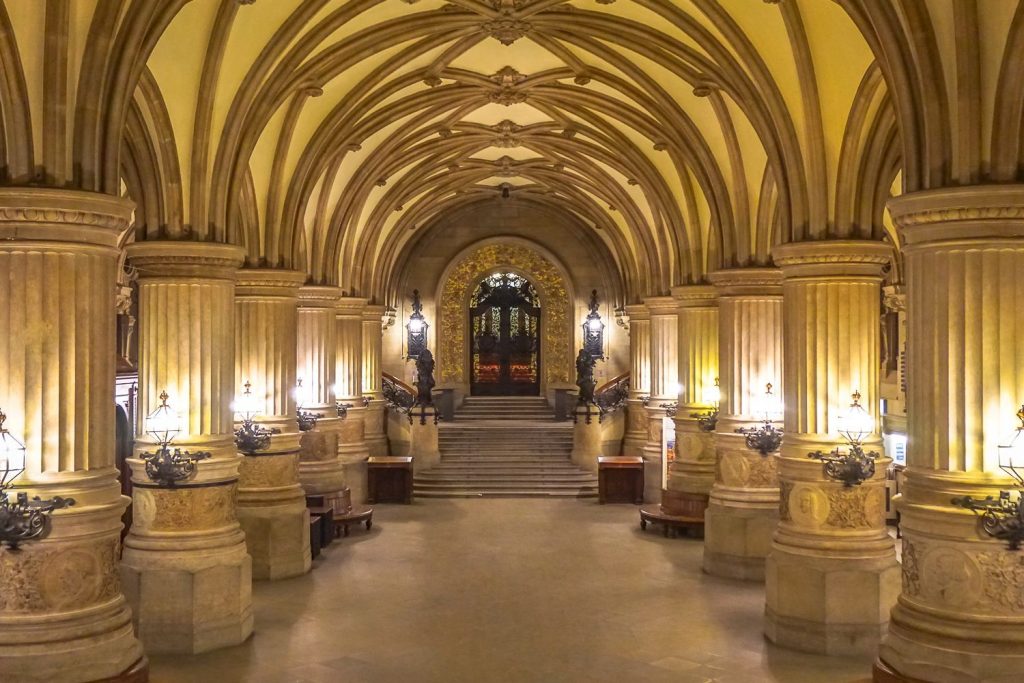
The Great Fire of 1842
The Great Fire of 1842 destroyed ¼ of the city. It started on Hamburg’s oldest street, Deichstraße, and there are rumors that it was purposely set in order to rebuild and expand Hamburg. During the Great Fire of 1842, the first known photographs of Hamburg as a city were taken. These photographs were published in Illustrated London News , marking one of the first times that photographs accompanied news stories.
7 Counties and 104 Neighborhoods
In terms of size, Hamburg has 7 counties (“Bezirken”) and 104 neighborhoods (“Stadtteilen”). The “Bezirken” are Harburg to the south; Bergedorf to the east; Mitte in the middle; and Altona, Eimsbüttel, Nord, and Wandsbek in the north. Bergedorf is the largest in terms of area and population while Mitte had the most “Stadtteilen.”
Most Bridges in Europe
With 2,500 bridges, Hamburg has the most bridges in all of Europe and more bridges than Amsterdam and Venice combined (and arguably, the most bridges of any city in the entire world). The city is a web of canals and bodies of water, all leading to the Elbe River (which eventually empties into the North Sea). This is also why Hamburg is nicknamed the “Venice of the North.”

Wealthy City
Hamburg is one of Germany’s wealthiest cities. Home to numerous German celebrities, there are 42,000 millionaires in the city and 18 billionaires. Almost 2% of the population are millionaires, making it one of the richest cities in all of Europe!
Rainy? Or Not!
Contrary to its reputation as a rainy city, Munich actually receives more rain per year than Hamburg. People just assume that Hamburg receives an above-average amount of rain due to the greyness and darkness of the city. However, there is rarely a downpour of rain. Instead, it is just a sense of mist a lot of times.
Moin! Moin!
The standard greeting in Hamburg is “Moin” – it works for all times of the day and all greeting situations. There’s debate as to whether you should “Moin” (once) or “Moin Moin” (twice). I’m a fan of only one ;) Northern Germany also has its own language – Plattdeutsch! While similar to German, it is technically its own language. Most children learn it through family members and some schools teach it. Currently, there are around 5 million native speakers in Germany.

Not Southern Germany
Northern Germany, and Hamburg, in particular, is not your stereotypical castles, dirndls, lederhosen, and everything else typically associated with Germany. Northern Germans are very proud of their Northern German heritage and do not appreciate it if you ask about these Bavarian traditions. (Fun Fact: my fiancé, born and raised in Northern Germany, just bought his first pair of lederhosen at almost 30 years old).
Red Light District
The Reeperbahn is the second-largest red-light district in Europe. Prostitution is legal in Germany and it’s common for lots of bachelor(ette) parties to be held in this area of Hamburg. Women beware: Herbertstraße is only open to men! It’s the only place on the Reeperbahn in which female prostitutes are still in windows (much like Amsterdam). At one point, there were over 3,000 prositutes working here. Now, the Reeperbahn has closer to 300 prostitutes.
- Take a tour of the Reeperbahn: There are lots of tours and various opportunities to go behind-the-scenes of the Reeperbahn (both in English and German). Check out all your tour options .

The Beatles Began in Hamburg
The Beatles got their start in Hamburg! As John Lennon famously said, “I was born in Liverpool, but I grew up in Hamburg.” Before making it big, the Beatles lived and performed in Hamburg for 2.5 years. It’s here that the Beatles got the opportunity to hone their skills, performing almost nightly in clubs along the Reeperbahn.
- Learn the entire story of the Beatles in Hamburg through this fantastic tour!
Christmas Markets
With over 25 Christmas markets in Hamburg, there’s a bit of something for everyone! St. Pauli’s Christmas market is the most unique Christmas market you’ll visit – complete with a stripper, risque ornaments, and naughty gifts. Don’t worry, there’s also a child-friendly section of the Christmas market :) The Christmas market at the Rathaus is the largest in Hamburg and the Fleetinsel Christmas market has its own champagne bar. Looking for something a bit smaller and more local? Check out the Osterstraße Christmas market or the Apostelkirche Christmas market – two of my favorites!

Bombing of Hamburg
The bombing of Hamburg during WWII, codenamed Operation Gomorrah, took place over several days in July 1943. Conducted by the USA and UK Air Forces, over 35,000 civilians were killed and 125,000 civilians wounded. Due to the firestorm created from the mixture of high temperatures and no rain, over 90% of the inner city was completely destroyed. Hamburg was targeted by the Allied forces due to its shipyards, u-boat pens, and oil refineries. St. Nicholas Church in the city center has been left ruined as a memorial against war. Additionally, it isn’t uncommon to find unexploded bombs during construction! The city probably still has hundreds (thousands!) or unexploded bombs buried all around.

Hamburg’s Jewish Population
Prior to 1933 and the rise of Hitler, Hamburg had a flourishing Jewish population. In fact, Hamburg had, at one point, the largest Jewish population in all of Germany. By 1925, over 20,000 Jews lived in Hamburg, primarily in the Grindel neighborhood of Eimsbüttel. About half of the Jewish population was deported and killed in concentration camps during WWII. However, there’s been a revival in Jewish life and culture in Hamburg. In 2007, the Talmud Torah School reopened – this was the first time the school was reopened since 1942. Having been established in 1805, it was the first Jewish school in Germany. The Grindel neighborhood is still home to Jewish cafes, bakeries, restaurants, and cultural centers.
Elbphilharmonie – the new Opera House
The Elbphilharmonie – the pride and joy of Hamburg. Opened in late 2016, it’s the newest landmark of the Hamburg skyline. This majestic concert hall was built on top of an old factory and resembles a wave with its glass paneling. It is one of the largest and most acoustically advanced concert halls in the world. Even if you don’t have an opportunity to see a show, make sure to at least go up to the viewing platform (it’s free).
- Take a behind-the-scenes tour of the Elbphilharmonie , including the viewing platform!

Harbor of Europe
As the third-busiest harbor in Europe, the port of Hamburg is still an important economic aspect of the city. In the 19th century, the Hamburg-American Line became the world’s largest transatlantic shipping company and Hamburg became an important starting destination for those emigrating to the United States. Nicknamed the “Gateway to the World,” Hamburg is still one of the largest exporters of coffee, cocoa, and tea, and handles textile imports from Middle Eastern countries before shipping them onwards. The Speicherstadt is the largest warehouse district in the world and a UNESCO World Heritage Site.
- Harbor Tour: What better way to see Hamburg’s harbor than by water? Take this one-hour harbor tour (available in multiple languages).
“HafenCity” – or Harbor City
The HafenCity is the largest inner-city renewal project in all of Europe. Located along the Elbe River, it is totally changing Hamburg’s waterfront. The area not only has the newly-constructed Elbphilharmonie, but it is also home to a mix of modern apartments, shops, and office buildings. The goal is to increase housing and job opportunities in this area.

Denmark’s Influence
The area of Altona was under control of Denmark for over 200 years (from 1640 – 1864). After two wars in the 1860s, Altona officially became part of Prussia and was eventually incorporated into the German Republic in 1871. Altona was independent from Hamburg until 1938, when it officially merged into the Free and Hanseatic City of Hamburg. There’s a gold line that indicates where the former border was between Hamburg and Altona!
First Ethical Zoo
Tierpark Hagenbeck, also known as the Hamburg Zoo, is considered the first modern zoo in the world. Founded in 1907, it introduced ethical conditions for housing animals by using moats and ditches, instead of traditional fences and cages. Today, Tierpark Hagenbeck still prioritizes the ethical treatment of animals along with making conservation efforts the main focus of the zoo.
The Staircase Quarter
Blankenese, a wealthy suburb neighborhood of Hamburg, has more stairs than any other neighborhood in the world. Dotted with stunning villas and old captains’ homes, there are over 5,000 stairs alone in this neighborhood. It has affectionately earned the German nickname of “Treppenvietel” or “Staircase Quarter” for the amount of stairs. It’s also one of the best day trips to take from central Hamburg.

Hamburg’s Islands
Despite not being located on the North Sea or Baltic Sea, Hamburg still owns seven islands. Four of the islands are located in the vicinity of the city – Cremon, Grimm, Veddel, and Wilhelmsburg. The other three islands are located at the mouth of the Elbe River and are approximately 70 mi (120 km) from downtown Hamburg – Neuwerk, Nigehörn, and Scharhörn. While the latter two are uninhabited, the island of Neuwerk currently has 39 residents.
Where to Stay in Hamburg
Hamburg is one of the more expensive cities in Germany, especially when it comes to finding affordable hotels! However, there are still accommodation options in Hamburg for all budgets. Prices can vary depending on the time of year.
Budget: Under 100 Euros a night (cheaper if you have a shared dorm) Mid-Range: 100 Euros – 300 Euros a night Luxury: More than 300 Euros a night
Generator Hostels is consistently my favorite hostel chain in Europe. I’ve stayed at their locations all over Europe because they’re clean, affordable, and well-located. The Generator Hostel in Hamburg is situated close to the main train station, making it easy to explore Hamburg and the surrounding region.
- Check rates, reviews, and availability here.
One of the coolest hostels ever, Pyjama Park has two locations – in the Schanzenviertel and St. Pauli . With a mix of both shared dorms and private rooms, this hostel is like a green oasis in the center of an urban jungle.
- Check rates, reviews, and availability in Schanzenviertel here.
- Check rates, reviews, and availability in St. Pauli here.

25hours Hotel , located in both Altes Hafenamt and HafenCity , is the hippiest new hotel chain in Europe. As part of AccorHotels, they cater to a younger audience looking for a more boutique feel and personalized experience. Most 25hours hotels have a hip bar and classy restaurant within it.
- Check rates, reviews, and availability for Altes Hafenamt here.
- Check rates, reviews, and availability for HafenCity here.
Motel One hotels are deceiving in the name – they are far from a motel! This fast-growing hotel chain in Europe is hip, cool, and always at an affordable rate (sometimes under 100 Euros). Both locations in Hamburg, am Michel or at the Alster , are in excellent locations.
- Check rates, reviews, and availability for am Michel here.
- Check rates, reviews, and availability for the Alster here.
Fairmont Hotel Vier Jahreszeiten is Hamburg’s premier hotel. Located overlooking the Alster in central Hamburg, this 5-star hotel has routinely been ranked as one of the best hotels in the world. Indulge in yourself and book at a state at this luxurious hotel.
Hotel Atlantic Kempinski is located on the opposite of the Alster from the Fairmont Hotel Vier Jahreszeiten and just as opulent as the other hotel. A historical building in Hamburg, this hotel used to be the hotel of 1st-class passengers emigrating to the United States before their journey started. It’s now a favorite hotel of celebrities.

What to Pack for Hamburg
As a local living in Hamburg but originally from the USA, I’ve had to adjust my wardrobe to fit the Hamburg lifestyle! This includes embracing the rain, cold weather, and wind as well as navigating the massive public transportation (lots of walking!).
- Camera : An extremely photogenic city, my camera is always with me. You never know what you might see or stumble upon while out and about in the city.
- Chunky Sweater : As the weather is unpredictable and Hamburg can be quite cold, you want to make sure you’re wearing layers – specifically a sweater that you can easily throw on and take off. If you’re wanting to stick with a nautical theme to match the city’s vibe, I especially love these two sweaters: option 1 and option 2 .
- Rain Jacket : It’s not unusual at all to have intermittent rain showers in Northern Germany. Makes sure you’re covered (no pun intended) and stay dry with a bright and cheerful rain jacket!
- Wellies : I swear by my Joules wellies to keep my feet warm and dry. With the unpredictable weather in Hamburg, wellies are a must for exploring the city.
- Umbrella : Along with wearing wellies, I highly suggest bringing along a sturdy umbrella for the rain and wind that can spontaneously hit the city!
- Small Backpack : If you’re not wanting to lug around a purse all day, I suggest getting a small backpack (with a zipper – no straps!). I have a similar backpack and love how it still looks “cool” while holding my wallet, camera, and anything else I might need for a day trip!
- Sturdy Shoe : I’m not a huge fan of sneakers but definitely recommend a sturdy shoe for walking around Hamburg. My personal favorite shoes for walking are anything by Sperry , especially their boat shoes (I own quite a few pairs), or classic Keds . Both are a bit chicer than normal sneakers while providing ample support to your feet.
- Winter Coat : If you happen to visit in a month that’s not June, July, or August, definitely make sure to bring your parka with you. It’s important to get a parka that goes below your butt and comes with a hood to help block out the wind!
- Boots : On extra cold days or days with snow/ice, it’s always great to have a sturdy, warm boot. I particularly love mine by Sperry .
- Winter Items : Other must-have winter items include fleece gloves , a warm hat , a wool or cable-knit scarf , and cozy socks !
- Guidebooks : Looking for a few books to help you on your trip to Hamburg? Check out this book on the history of Hamburg , this travel guide to Hamburg, or this updated travel guide to Hamburg .
- Plug Adapters : Coming from outside the EU? Make sure to pick up a plug adapter ahead of time so you can charge all of your electronics.
- Power Bank : If you’re afraid of your electronics dying while you’re out touring the city, make sure to bring your power bank along to charge them!
Further Reading...

Tips for Visiting Miniatur Wunderland in Hamburg: How to Plan Your Visit to Miniatur Wunderland
No comments, leave a reply cancel reply.
Save my name, email, and website in this browser for the next time I comment.
By using this form, you agree with the storage and handling of your data by this website. For more information and a disclaimer, see the Privacy Policy (English) or Datenschutz (German). *
hamburgbeyond
Please go to the Instagram Feed settings page to create a feed.
Book your individual trip , stress-free with local travel experts
Select Month
- roughguides.com
- hamburg-and-schleswig-holstein
- Travel guide
- Itineraries
- Local Experts
- Travel Advice
Accommodation
Plan your tailor-made trip with a local expert
Book securely with money-back guarantee
Travel stress-free with local assistance and 24/7 support
HAMBURG suffers from image schizophrenia. To many of its tourists, Germany’s second metropolis is simply sin city – a place of prostitutes and strip shows in the Reeperbahn red-light district – while in its homeland it is revered as a cosmopolitan, stylish city-state, rapaciously commercial and home to the highest head-count of millionaires in the country. Either way the cause is the same: through one of the greatest ports in Europe it has sucked in wealth – and probably vice – ever since a canny piece of diplomatic manoeuvring in 1189 led Emperor Friederich I (also known as Emperor Barbarossa) to grant tax-free imports down the Elbe. Hamburg never looked back. The good times began to roll in the early Middle Ages after it fostered links with Hanseatic leader, Lübeck, and the city paused only to congratulate itself when declared a Free Imperial City by Emperor Maximilian I in 1510.
Around Jungfernstieg
Around the aussenalster, a taste of hamburg, destination america, eating and drinking, gay and lesbian hamburg, nightlife and entertainment, operation gomorrah, july 1943, speicherstadt, summer beach-bars, the beatles in hamburg, the fischmarkt, a party just for the halibut, the historic altstadt, the rathaus, the schanzenviertel.
Today a restless boom-town, forever reinventing itself, Hamburg still flaunts its “Freie und Hansestadt” (Free and Hanseatic Town) title. And that umbilical link to maritime trade continues in a sprawling container port that grounds the city, adding a workaday robustness to the sophistication that comes with its postwar role as Germany’s media capital. Though the port makes Hamburg fairly grimy in places, seedy even, it adds an earthy flavour to the rich cosmopolitan stew. It brings dive bars to a city renowned for its arts and theatre; nurtures a strong counter-culture movement alongside hip media types; and helps support a nightlife that is as depraved as it is refined. Even the drizzle that blankets the place for days at a time can’t dampen the spirit of Germany’s most life-affirming city.
The surprise, then, is that Hamburg is so manageable. Despite a population that nudges towards 1.8 million, just under a fifth of which has immigrant roots, Hamburg has the lowest population density of any European city. Only around a third of the land area is urban development, the rest is parks and water. Canals that once carried produce now provide breathing space among the offices as they thread from the mercantile heart on the Elbe’s banks to the shimmering Alster lakes. The city’s 2302 bridges are more than Venice, Amsterdam and London combined.
Travel ideas for Germany, created by local experts
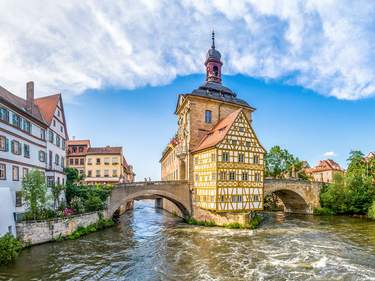
9 days / from 2263 USD
A self drive exploration of UNESCO Sites in Southern Germany
Explore UNESCO World Heritage Sites across different German states. This self drive trip allows you to design your own days with recommendations stated for each day.
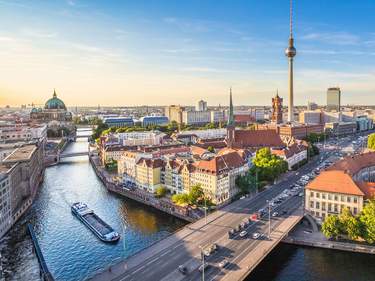
7 days / from 2905 USD
Explore Berlin and Potsdam in depth
The German capital Berlin has plenty to offer: from historical sites to world-class museums and a vibrant nightlife. Enjoy this private tour to explore a wide range of activities in Berlin and Potsdam, including several UNESCO World Heritage Sites.
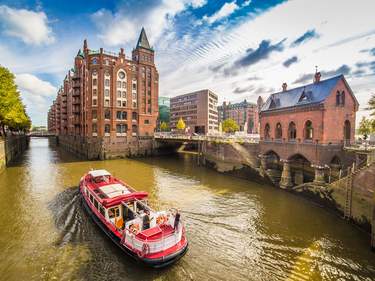
8 days / from 1501 USD
Explore Northern Germany on Your Own
From Bremen to Stralsund - Northern Germany offers plenty of gems to explore. With well-developed public transportation links, this itinerary is suited for everyone wanting to explore on their own - getting lost on the cobble-stoned streets of many UNESCO World Heritage Highlights.
Accommodation in Hamburg is among the most expensive in Germany, but while the city boasts a quota of design hotels that are big on the wow factor there are also some excellent hostels . Reservations are advisable for all. Which area you stay in depends as much on your plans as your budget. Hotels in the city centre provide sights on your doorstep, but leave you marooned from the nightlife. Gay-friendly St Georg is another option, although a minor red-light district means you should be wary of any bargain hotel around the Hauptbahnhof and Steintorplatz. St Pauli and the Schanzenviertel are the best bets for hostels and nightlife. Private agency St Pauli Tourist Office (Beim Grünen Jäger 7–8; 040 98 23 44 83, pauli-tourist.de) is a good source of budget flatstays in the St Pauli area.
Altona is the Schanzenviertel thoroughly gentrified. It is the first in a series of ever more exclusive districts west of the centre, an erstwhile working-class district of immigrant settlers that has been colonized by Hamburg’s thirty-something hipsters and, with them, all the requisite fashion outlets and bars – a sort of Hamburg-style Notting Hill, albeit less affluent. At least part of the appeal is that Altona retains the feel of the separate town it was until the Nazis dragged it within Hamburg’s jurisdiction in 1937. Before then, the free city of Altona was an upstart to its larger neighbour; an irritating one, too, since it poached Hamburg trade when Napoleon mounted a continental blockade against England in 1806.
As the port characterizes the south of the city, the Binnenalster and Aussenalster lakes define the centre. Created when the Alster rivulet was dammed in the thirteenth century, the lakes were ignored until the 1800s, when they caught the eye of the city’s wealthy burghers, who colonized the area around them and strolled their banks. During a Sunday constitutional, families paraded their unmarried daughters (“Jungfern”) beside the Binnenalster’s banks on Jungfernstieg , still a pleasing promenade lined by cafés despite its current incarnation as a busy road. Eligible offspring in tow or not, the Alsterwanderweg path remains a popular walk around the adjacent Aussenalster lake – the picture-postcard view across the Binnenalster to the city spires is from Lombardsbrücke. Alternatively, cruises on the Alster lakes depart from quays on Jungfernstieg and also tour into canals of the wealthy northern suburbs; maps from tourist information have details.
The lakeside enclaves around the Aussenalster north of the centre are among the flashest in Hamburg. Rotherbaum and Harveststude remain as prestigious now as when they emerged in the late 1800s as the des res of business tycoons, their smart villas still home to the affluent and foreign consulates. One favoured hangout is Pöseldorf , located just behind Fährdamm wharf in the northwest. Between lunch with Hamburg’s media high-rollers and browsing the boutiques and galleries in Milchstrasse, there is superb Jugendstil architecture in the side streets to discover – nowhere else in Hamburg boasts such a diverse mix of large white villas, courtyards and mews. Allow three hours for a straightforward eight-kilometre circuit of the lake – or you can take one of the hop-on, hop-off tourist ferries operated by ATG Alster-Touristik, which call at the nine quays around the lake every hour.
Cosmopolitan flavours rule in Hamburg, fusion food is a favourite. Nevertheless, many restaurants offer at least one time-proven traditional dish on the menu.
Aalsuppe The soup is largely vegetable despite the seeming reference to eel; “aal” means “all” in Low Saxon, apparently, though most chefs now add eel to avoid arguments.
Alsterwasser Fortunately not the water of the Alster lakes but shandy in a fifty-fifty ratio of beer and lemonade.
Bohnen, Birnen und Speck Literally, green beans, pears and bacon – a tasty, light dish that’s ideal for summer.
Hamburger The world’s favourite fast-food has its origins in the mists of time, but was introduced to the States in the late 1800s by emigrants from Hamburg, who knew it as a dockers’ street-snack. Ironically another immigrant food, the doner kebab, is far more popular in the “home” town.
Labskaus A sailor’s hash that minces corned beef, potatoes and beetroot and is topped with a fried egg and rollmop herring. The result: a bright pink stodge that locals swear cures hangovers. One theory also attributes the dish as the linguistic derivation of the Liverpudlian nickname “Scouser”.
Rotes Grütze Rich dish made of red berries swimming in cream, popular in summer.
Though Blankenese is the next Elbvororte (Elbe suburb) west of Övelgönne, it feels more coastal village than city suburb. The sea captains of old have long made way for captains of industry – probably the only people who can afford some of the most expensive real estate in Germany. For the tourist, there’s little to tick off, which is a relief after the high culture of Hamburg, and Blankenese demands little more than exploring a nest of paths and ambling along the riverside.
It’ll take strong legs, though. Blankenese is a suburb of stairways – 58 in total – which spill off Blankenese Hauptstrasse then trickle like tributaries down to the Elbe, threading through the half-timbered cottages, nineteenth-century villas and modern glass-and-wood statements shoehorned onto the hillside. A surprisingly fine beach fronts the river. Go west along Strandweg, past a varied selection of restaurants and cafés, and the sand becomes purer, the beaches more isolated, and you find the bizarre summer scene of beach balls and bikinis as the container ships chug past.
Such is the hubris of boom-town Hamburg that its role as the principal emigration point in Germany is largely overlooked. Yet the unprepossessing patch of wasteland opposite HafenCity was the last piece of Europe experienced by millions of Europeans and Russians. Nearly five million people embarked at Hamburg for a new life in the New World – almost 1.9 million people left during the peak period of mass migration between 1891 and 1914, when poverty and pogroms proved the final straw for many in southern and eastern Europe. A cholera epidemic that claimed ten thousand lives in three months prompted city authorities to demand that the emigration shipping lines relocate from the docks at St Pauli to Veddel island opposite Speicherstadt. Located beside the south exit of Veddel S-Bahn station, the last brick Emigrant Hall to house the masses is the centrepiece of the BallinStadt museum (Veddeler Bogen 2; daily 10am–6pm; €12; ballinstadt.de), whose interactive exhibits seek to re-create the emigrant experience with dioramas that combine contemporary exhibits and personal narratives. Most emigrants were bound for the United States – a research area provides access to online records of émigrés from 1850 to 1934, plus a partner database with 34 million records.
Hamburg has blossomed into the great gourmet centre of Germany, its role as a prosperous media metropolis nurturing a community of discerning diners with a penchant for eating in style – traditional restaurants are thin on the ground compared to the rest of Germany – and a voracious appetite for the next big thing. For the hippest new openings, source Szene Essen & Trinken (€7) at larger newsagents and some tourist information centres. There are two caveats. First, your options are limited in the city centre , especially in the evenings. Streets such as touristy Deichstrasse and Colonnaden or squares such as Grossneumarkt provide choice in one location, as does Ditmar-Koel-Strasse near the port. The second caveat is that, notwithstanding student-budget dining in the Schanzenviertel, eating out in Hamburg is notably more expensive than in many German cities. Cheaper brasserie and bar options are listed with cafés.
It should come as no surprise that a liberal metropolis such as Hamburg has a thriving gay and lesbian scene. Its centre is the St Georg district, with a number of mainstream gay cafés and bars sited along main-drag Lange Reihe. Café Gnosa at no. 69 is the daytime lynchpin and best source of information for what’s on. There’s usually a copy of local gay listings magazine Hinnerk (hinnerk.de) knocking around. The best clubbing tends to be found in the one-nighters that shift between venues, many in St Pauli; again consult listings and local knowledge. Hamburg also has a separate but important leather scene – the annual Hamburg Leather Party, organized in the second week of August by fetish club, Spike (spike-hamburg.de), is a major event on the scene’s European calendar.
Ever ambitious, Hamburg is shoring up its economic clout with a €5bn redevelopment of derelict docklands that will extend the centre by forty percent south and east of Speicherstadt. By its completion in 2025, the area is expected to provide sufficient office space for 40,000 people and 5500 apartments. Notwithstanding the fact that HafenCity makes the former building site at Potsdamer Platz, Berlin, seem like minor roadworks – its 1.55-square-kilometre area is fifteen times bigger – Europe’s largest construction site is rapidly resolving into showpiece steel-and-glass offices and modernist apartments that are cantilevered over former quays – a must-see for any fan of modern architecture that presently looks its best from Marco-Polo-Terrassen. A fleet of traditional ships is moored incongruously in the middle dock.
Elbphilharmonie
The figurehead building over the Elbe, at the symbolic convergence of river, city and harbour, will be the Elbphilharmonie concert hall at the tip of Am Kaiserkai. A bold design by Swiss architects Herzog & de Meuron of London’s Tate Modern fame, it places a futuristic tower of glass on the shell of a brick industrial warehouse. When open in 2013, it should be worth a visit for the views from its public plaza 37m above the river alone. Former boilerhouse Kesselhaus at Am Sandtorkai 30 provides information on the HafenCity project, plus occasional tours of the development.
Hamburg rivals Berlin for nightlife. Freesheets in visitor information centres provide what’s-on basics; they’re especially useful for a rundown of which blockbuster musicals have settled in for a long run. But for a breakdown of the fun – clubnights, bands, art-house cinema and the gay scene – look to local listings magazines such as Szene (€3) or Prinz (€1.50), or check out their websites, szene-hamburg.de and hamburg.prinz.de. Visitor information centres at the Hauptbahnhof and St-Pauli-Landungsbrücken have ticket bureaux that can handle most mainstream venues or try Ticketmaster-affiliate Kartenhaus at Schanzenstrasse 5 (Mon–Fri 10am–7pm, Sat 10am–2pm; 040 43 59 46, www.kartenhaus.de).
The port that nourished Hamburg also made it a prime target for the Allies. In retaliation for earlier Luftwaffe raids, British and US raids wiped ten square kilometres of Hamburg off the map and obliterated eighty percent of the harbour during a week of relentless sorties at the end of July 1943. Over seven thousand tonnes of high explosives and incendiaries rained onto the city, killing nearly 40,000 people ; by way of comparison, the famous Luftwaffe raid on Coventry killed 538.
As the flames sucked in oxygen, typhoon winds blasted western residential districts and the Germans had to create a new word to describe the apocalypse – “ Feuersturm ” (firestorm). Winds of nearly 1000°C set asphalt streets ablaze, trees were uprooted, cars flung into superheated air. “Every human resistance was quite useless,” Hamburg’s police chief reported later. “People jumped into the canals and waterways and remained swimming or standing up to their necks for hours … Children were torn away from their parents’ hands by the force of the hurricane and whirled into the fire.” Third Reich architect Albert Speer later revealed that Hitler and Hermann Göring had been shocked at the devastation. Even Air Chief Marshal Arthur “Bomber” Harris conceded that the attacks on the Reich’s second city were “incomparably more terrible” than anything previously launched at Germany. Operation Gomorrah was well named.
The waterfront beneath Altonaer Baalkon is a throwback to a bygone era of neat gardens and gas lanterns. This is the introduction to Övelgönne , one of the most prestigious addresses in Hamburg. Twenty or so restored craft nod at their moorings as an open-air harbour museum beside the city’s finest beach, where passing container ships provide waves and locals linger over lattes at the Strandperle café.
Return towards the centre along the river and you’re on the Elbemeile , a former fishing docks that is rapidly morphing into an epicentre of gourmet Hamburg. Part of this redevelopment is the cutting-edge Dockland office building on the Fischereihafen; from the top of its glass-and-steel wedge (steps up on the outside) – intended to suggest the superstructure of cruise liners – you get great views downriver.
Not just the name, Speicherstadt (Warehouse Town), but also the atmosphere of cobbled streets, gables and turrets combine to make the area on the other side of Zollkanal (Tax Canal) a world apart from the city opposite. The red-brick architecture – a deliberate nod to Hanseatic days – of the largest continuous warehousing in the world sprang up from 1885 to 1927, providing storage for a city that had recently signed up to the fledgling Customs Union (1888) of the Second Reich. An entire residential district was razed, and nearly 24,000 people displaced to make way for it. Trade has leached away to deeper water, but things haven’t changed much in concept. A few importers still hoard goods tax-free until market prices provide a tidy profit and so strict are preservation orders on the area that goods are hoisted by block and tackle. Carved up by canals, its warehouses are piled high with crates and Middle Eastern carpets (it still houses Europe’s largest stock). While a museum provides details of the area’s past (see Speicherstadt museums), much of the pleasure comes in simply nosing about, especially from dusk, when spotlit warehouses rising sheer from the waterways is one of Hamburg’s most evocative sights. You can also experience the area at water-level on boat trips from St-Pauli-Landungsbrücken and Jungfernstieg.
Here it is then, the Sündermeile (Sin Mile) counterweight to the Kunstmeile on the opposite side of the city. Hamburg’s citizens are miffed that the Reeperbahn ’s red lights still attract so much attention abroad. While the “Kiez” (the local term for the Reeperbahn area) is a far cry from the road where immigrant ropemakers weaved hemp warps for the docks ( Reep is rope), and its seedy underbelly attracts more than the usual quota of dubious characters – a few don’t seem far removed from those in Tom Waits’s lowlife bar ballad, Reeperbahn – the area has come a long way from the rough dockers’ quarter where sailors spent shore leave. Gone are the excessive prostitution and hard drugs that characterized the late 1970s to be replaced by theatre venues that trade on tourist-friendly titillation. A few grungey bars and clubs hark back to a counter-culture past evident in the arts-squat communes along Bernhard-Nocht-Strasse/Hafenstrasse, but nowadays they sit alongside a five-star hotel. A no-nonsense police force keeps crime figures among the city’s lowest, too, despite the legion of stag parties.
The street-spanning neon along Grosse Freiheit recalls the area’s rollicking Sixties prime, popularized during The Beatles’ residence. The street’s name – Great Freedom – alludes to a liberal area of free trade and religion in the seventeenth century, rather than loose morals. Spielbudenplatz , on the other side of the Reeperbahn from Grosse Freiheit, is the hub of the area’s regeneration. Its latest incarnation as home to musicals in the Operettenhaus , Spielbudenplatz 1, and waxwork figures in the Panoptikum , Spielbudenplatz 3, follows the pattern set two centuries ago when tightrope walkers, snake charmers and acrobatic riders performed stunts. Nearby on the corner of Taubenstrasse, a condomerie (noon–midnight; free) that peddles saucy tourist tat as a pseudo-museum typifies the area’s makeover.
The focus of local boozing is the seedy streets south, principally Friedrichstrasse and Gerhardstrasse . Where the former meets Davidstrasse, the small St Pauli Museum presents a concise history of the area’s unsavoury past. Its present is the Amsterdam-style red-light district a block south on Herbertstrasse , screened off at either end. Women, though not expressly prohibited, are strongly discouraged from visiting.
That locals have spent weekends on their river beaches since the late 1800s at least helps explain why no town in Germany does the Stadtstrand (city beach) with such flair as Hamburg. The Elbe views help, of course, as does sand on the riverbanks. But even away from the river, bar owners import sand to create a little piece of coastal paradise, scattering deck chairs among the potted palms and adding a soundtrack of lazy funk and chilled house beats. The city’s beach clubs – nine at the last count – operate daily in summer (roughly mid April–Sept); the exceptions are StrandPauli and Ahoi , which open year-round. Those on the river with views of the container port are quintessentially Hamburg.
They arrived in Hamburg as amateurs in August 1960. They left two years and five visits later as a fledgling Fab Four . The Beatles have always acknowledged the debt they owe Hamburg. As John Lennon put it: “It was Hamburg that did it. We would never have developed so much if we’d stayed at home.” Its red-light district area was also an eye-opener for the teenagers: “I was born in Liverpool, but I grew up in Hamburg,” Lennon quipped.
Many of the shrines are still there to make St Pauli as holy as Liverpool for Beatles pilgrims . The boys’ first address in the city was a squalid cell in a cinema, Bambi Kino (Paul-Roosen-Str. 33), that was convenient for gigs in the grimy Indra club (Grosse Freiheit 64). Here they earned thirty Marks a day each by entertaining sailors and strippers for up to six hours a day. The venue’s manager, Bruno Koschminder, was unimpressed after their first lame performance and demanded they “Mach shau!” (put on a show). Lennon duly hung a toilet seat around his neck and George Harrison played in his Y-fronts. They transferred to nearby Kaiserkeller (Grosse Freiheit 64) and found haircuts from Hamburg’s hip Existentialists, and a new drummer, Ringo Starr, then playing for Rory Storm and the Hurricanes.
This stint was truncated when Paul McCartney and former drummer Pete Best hung a lit condom outside their room then spent a night in the Spielbudenplatz police station accused of arson before being deported. In truth, the tour was at a close anyway because 17-year-old George Harrison had been deported for being underage and the boys returned to Liverpool, billed as “The Beatles: Direct From Hamburg” . In 1961 the band returned to Germany for a 98-day run at the epicentre of all things beat, the Top Ten Club (Reeperbahn 136), and afterwards a seven-week stint at the Star Club (Grosse Freiheit 39), also host to Jimi Hendrix circa the release of Hey Joe . A short way along the Reeperbahn from a sculpture of the Fab Four at the entrance to the Grosse Freiheit (renamed Beatles-Platz), museum Beatlemania (daily 10am–10pm; €12;
beatlemania-hamburg.de) celebrates The Beatles’ formative years with exhibits and features such as a karaoke booth that allows recording. Incidentally, true Beatles devotees can follow in the boys’ footsteps and buy their first cowboy boots from Paul Hundertmark Western Store (Spielbudenplatz 27–28).
Official records reveal the Fischmarkt as the city’s oldest market, but that rather misses the point. Hamburg’s Sunday market retains the same hours as when it began in 1703 – from 5 to 9.30am (from 7am Nov–March) – yet its focus shifted long ago. Just as it’s doubtful that modern traders pack up to go to church as their predecessors did, so fish now takes second place to a mind-boggling sprawl of wares, from genuine bargains to tat, from fruit and veg to livestock. The story goes that in the early 1960s The Beatles received a police warning for chasing a live pig they bought here among the stalls.
Even that is civilized stuff compared to the action in the iron Fischauktionshalle. Where Altona’s fishing fleet once sold its catch, late-night casualties from St Pauli cross paths with early birds, as everyone sinks a beer and bellows along to live rock bands while bemused tourists look on. Unless you’re in a sympathetically booze-fuelled frame of mind, such raw exuberance at such an early hour can be hard to stomach. Fortunately, cafés on the first floor are a safe haven from where to watch the chaos over a buffet breakfast.
The area south of the Rathaus is Hamburg’s historic wellspring; the location where Charlemagne rode out across a sandy hummock between the Elbe and Alster rivers in 808 and built the “Hammaburg” fort. Lost among the office blocks south of Rathausmarkt is the Trotsbrücke , Hamburg’s oldest bridge. That it marks the transition to the site of the first settlement on the other side of the Alster – today channeled as the Alsterfleet canal – explains its statue of Count Adolph III of Schauenburg, the nobleman who expanded the city and pulled off the 1189 tax concession that kick-started Hamburg’s ascendancy. Like all good businessmen, he clinched the deal with a sweetener – a donation to the crusade of Emperor Frederick I. Opposite him is St Ansgar, the “Apostle of the North”, who slotted in fourteen years as Hamburg’s first archbishop from 831 between spreading the gospel to Vikings and Danes.
The massive stone blocks of St-Pauli-Landungsbrücken are an exercise in solidity for a city fond of brick. Four years after work on the quay began in 1906 the first ocean-going liner processed up the Elbe to moor alongside; the occasional cruise-ship still docks nearby, dwarfing everything else around. The centre of the action today is the floating wharf where ferries come and go to up river districts or across the river; the Stintfang balcony behind the U/S-Bahn station provides good views of the nonstop bustle on the water.
Forty-four years after the Great Fire of 1842 razed the Altstadt, city fathers began work on their morale-booster, a monument to inspire Hamburg’s citizens and embody her phoenix-like revival. If the neo-Renaissance Rathaus oozes civic self-confidence today, it must have positively swaggered when the final stone was laid in 1897. It isn’t shy about boasting either: above a parade of German emperors are statues of the tradesmen who won the city’s prosperity; protectress Hammonia casts an imperial gaze from above the balcony; and triumphant classical figures and wreaths of plenty adorn the bases of two flagpoles crowned with gold ships. Hard to believe, then, that only four thousand oak poles prevent this bombastic pile from subsiding into the sandbank beneath. The senate and city government still dictate policy from the Rathaus’s 647 rooms, a taste of whose opulence can be seen on 45-minute guided tours. With a coffered ceiling and oversized murals of the city’s founding, the Great Hall is a knockout. At the back of the Rathaus, on Adolphsplatz, you’ll find the Börse , the current incarnation of Germany’s first stock market (1558), and a revealing symbol of mercantile priorities at the heart of government.
St Pauli segues leafy residential streets north into the Schanzenviertel . A former working-class district that nurtured the city’s alternative culture, the Schanze has evolved into the epicentre of the hip Hamburg scene, with a good spread of cheap eats, bars and boutiques and a nicely scruffy laidback vibe; only Rota Flora, a semi-derelict former theatre on Schulterblatt, remains as a reminder of its radical counter culture past. Yet its bar-scene is thriving – this is the locals’ choice over the rather tacky options off the Reeperbahn. From Neuer Pferdemarkt where Feldstrasse meets Budapester Strasse, the region fans out around its spine street, Schanzenstrasse, its core being a plaza where Schulterblatt meets Susannenstrasse. Marktstrasse just north of Feldstrasse U-Bahn station has a good spread of independent boutiques.
Discover more places in Germany

- Travel Guide Morocco
- Travel Guide Namibia
- Travel Guide South Africa
- Travel Guide China
- Travel Guide India
- Travel Guide Indonesia
- Travel Guide Japan
- Travel Guide Laos
- Travel Guide Malaysia
- Travel Guide Myanmar (Burma)
- Travel Guide Nepal
- Travel Guide Philippines
- Travel Guide Singapore
- Travel Guide South Korea
- Travel Guide Sri Lanka
- Travel Guide Taiwan
- Travel Guide Thailand
- Travel Guide Australia
- Travel Guide Fiji
- Travel Guide New Zealand
- Travel Guide Belize
- Costa Rica Travel Guide
- Travel Guide Cuba
- Travel Guide Guatemala
- Travel Guide Honduras
- Travel Guide Jamaica
- Travel Guide Nicaragua
- Travel Guide Panama
- Travel Guide Puerto Rico
- Travel Guide Trinidad and Tobago
- Travel Guide Albania
- Travel Guide Austria
- Travel Guide Belgium
- Travel Guide Bosnia-Herzegovina
- Travel Guide Bulgaria
- Travel Guide Cyprus
- Travel Guide Czechia (Czech Republic)
- Travel Guide Denmark
- Travel Guide England
- Travel Guide Estonia
- Travel Guide Finland
- Travel Guide France
- Travel Guide Germany
- Travel Guide Greece
- Travel Guide Hungary
- Iceland Travel Guide
The Rough Guides to Germany and related travel guides
In-depth, easy-to-use travel guides filled with expert advice.

Find even more inspiration here

Planning your own trip? Prepare for your trip
Use Rough Guides' trusted partners for great rates
written by Rough Guides Editors
updated 27.04.2021
Ready to travel and discover Germany?
Get support from our local experts for stress-free planning & worry-free travels.
- Travel advice
- Where to stay
The magical fjords of Norway
Your breath will leap right off the edge of those steep, steep cliffs
- Newsletter sign up Newsletter

The fjords of Norway — all 1,000 of them — are majestic. That is the simplest, most straightforward way to put it. The long, narrow sea inlets are surrounded by dramatically steep cliffs, often best viewed from the water while gliding by on a ferry or kayak. Fjords can be found in all corners of the country, but to see some of the most stunning examples, visit the western part of the nation, known as Fjord Norway.
Geirangerfjord

Geirangerfjord is a UNESCO World Heritage Site, along with Naeroyfjord
All you have to do is see a photo of Geirangerfjord to understand why this is among the most visited spots in Norway. A UNESCO World Heritage Site, the natural wonder "inspires with its deep, blue water ringed by sky-grazing snow-capped peaks, gushing waterfalls and green vegetation," Travel + Leisure said. For spectacular views, take a ferry ride past the Seven Sisters and Suitor waterfalls and drive up the windy road to Mt. Dalsnibba. There, you will find the Geiranger Skywalk , where visitors can take in unobstructed views of the fjord.
Hardangerfjord

Norway's most visited waterfall is the Voringfossen
Often referred to as the Kingdom of Waterfalls, Hardangerfjord is home to Norway's crown jewel, the mighty Voringsfossen . This is the country's most famous waterfall, and after witnessing its power, be sure to also visit Steinsdalsfossen, where you can walk on a pathway behind the water, and Latefossen , a twin waterfall that plunges toward an old stone bridge. Hardangerfjord has another claim to fame: apples. Orchards thrive here because of the region's comparatively mild winters, and visitors can stop by farms on the Fruit and Cider Route in Ulvik to pick up produce, juice and ciders.
Subscribe to The Week
Escape your echo chamber. Get the facts behind the news, plus analysis from multiple perspectives.

Sign up for The Week's Free Newsletters
From our morning news briefing to a weekly Good News Newsletter, get the best of The Week delivered directly to your inbox.

Hundreds of thousands of people visit Preikestolen every year
Lysefjord is a playground for mountain hikers. Opportunities abound, from the strenuous climb up to Kjerag, the highest peak in Lysefjord, to the popular trek to Preikestolen (The Pulpit Rock). From here, you can gaze down at the Lysefjord below, a view made even more special when hiking in for sunrise. If that is not enough to get your heart pumping, take a ferry to the village of Florli and ascend the world's longest wooden stairway — a 4,444 step journey up a mountain. There is also a wood-fired hot tub, filled with fresh fjord water, in Florli that visitors can rent .
Naeroyfjord
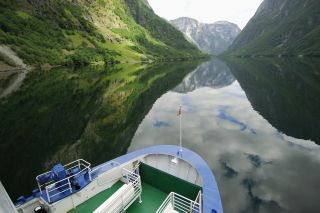
Ferries have to carefully maneuver through the narrow Naeroyfjord
Another UNESCO World Heritage Site, Naeroyfjord is often included in the "Norway in a Nutshell" itinerary for travelers on a time crunch who want to see as many fjords as possible. This narrow fjord — at some points, it is only about 820 feet wide — can be traversed on electric boats, which stop at some of the tiny villages that dot the landscape. Bakka is one of those remote communities, where visitors often become enchanted by the serene views and historic wooden buildings. The centerpiece is the Bakka Church , built in 1859 and still hosting services during the summer.

Sognefjord is 120 miles long and about one mile deep
As the longest and deepest fjord in Norway, Sognefjord reigns supreme. Known as The King of the Fjords, it has several side branches (like Naeroyfjord) and is home to more than 19 tiny, charming villages. Sognefjord "offers Norway's best combination of scenic wonder and accessibility," Rick Steves said, and is in a "relative sun belt, with only two feet of rain a year." Hikers should plan to spend a day or two in the Aurlandsdalen Valley, a scenic region often described as Norway's answer to the Grand Canyon. For a quick side trip, visit Fjaerland on Fjaerlandsfjord. This is a book town , where tomes can be encountered or purchased everywhere from banks to bus stops.
Sign up for Today's Best Articles in your inbox
A free daily email with the biggest news stories of the day – and the best features from TheWeek.com
Catherine Garcia is night editor for TheWeek.com . Her writing and reporting has appeared in Entertainment Weekly and EW.com , The New York Times , The Book of Jezebel , and other publications. A Southern California native, Catherine is a graduate of the University of Redlands and the Columbia University Graduate School of Journalism.

In the Spotlight Jerry Seinfeld has been in the news for his recent remarks, but political correctness has long been criticized for interfering with jokes
By Anya Jaremko-Greenwold, The Week US Published 16 May 24

The Week's daily crossword
By The Week Staff Published 16 May 24

The Week's daily hard sudoku puzzle

The Week Recommends Colm Tóibín follow-up shows his fascinations with 'secrets and the people who hold them in'
By Adrienne Wyper, The Week UK Published 15 May 24

The Week Recommends The 2015 tome will reshape how you think about both vegetables and Indian food
By Scott Hocker, The Week US Published 13 May 24
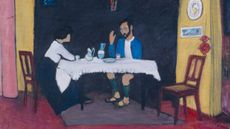
The Week Recommends Show mixes 'ferociously glowing masterpieces' from Kandinsky with less well-known artwork
By The Week UK Published 10 May 24

The Week Recommends From Arches to Zion, you should wander them all
By Catherine Garcia, The Week US Published 10 May 24

The Week Recommends Emma Rice brings Hanif Kureishi's 1990 novel to the stage
By The Week UK Published 9 May 24

The Week Recommends Massive metallic sculptures dotted across the gardens explore 'links between nature and humanity'
By Adrienne Wyper, The Week UK Published 9 May 24
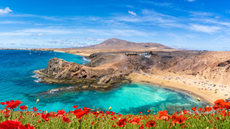
The Week Recommends Even a short exploration quickly shows the out-of-this-world island is undeserving of its 'Brits abroad' reputation
By William Leigh Published 9 May 24

The Week Recommends Keeping the legacy alive, even when the industry tries to keep them down
By Scott Hocker, The Week US Published 9 May 24
- Contact Future's experts
- Terms and Conditions
- Privacy Policy
- Cookie Policy
- Advertise With Us
The Week is part of Future plc, an international media group and leading digital publisher. Visit our corporate site . © Future US, Inc. Full 7th Floor, 130 West 42nd Street, New York, NY 10036.
From Baja to British Columbia, these are the 101 best West Coast experiences
Logo animation by Jacky Sheridan; video editing by Li Anne Liew; Storyblocks
Walk the vast salt flats of Death Valley. Enter a den of magic and mystery on a Hollywood hilltop. Sidle up to a whale in a Baja lagoon. Tiptoe above a misty forest in Vancouver. Page through rare books under an open sky in Ojai. Though it rises, falls and sprawls for thousands of miles, this is our backyard. We’ll help you explore it. Here in these stories, find out what makes the West Coast, well, the absolute best coast.
- Show more sharing options
- Copy Link URL Copied!

The 101 best West Coast experiences
Essential things to do, see and eat right now in California, Oregon, Washington, the Baja Peninsula and British Columbia. Ready to explore?

Take an epic trip along the West Coast in 2024. Here are the top 10 places to visit now
Of our 101 best West Coast experiences, these resonate most for travel writer Christopher Reynolds. Check out his ranked list of favorites.

Tell us: What’s the most extraordinary West Coast experience?
Adventurers, it’s your turn. Along the thousands of miles of towns, beaches, rivers, mountains and deserts, share the wonders you cherish most.

Buy a copy of the new ‘West Coast 101’ zine
It’s the perfect size to pack in your travel bag as you discover the wonders of the West.
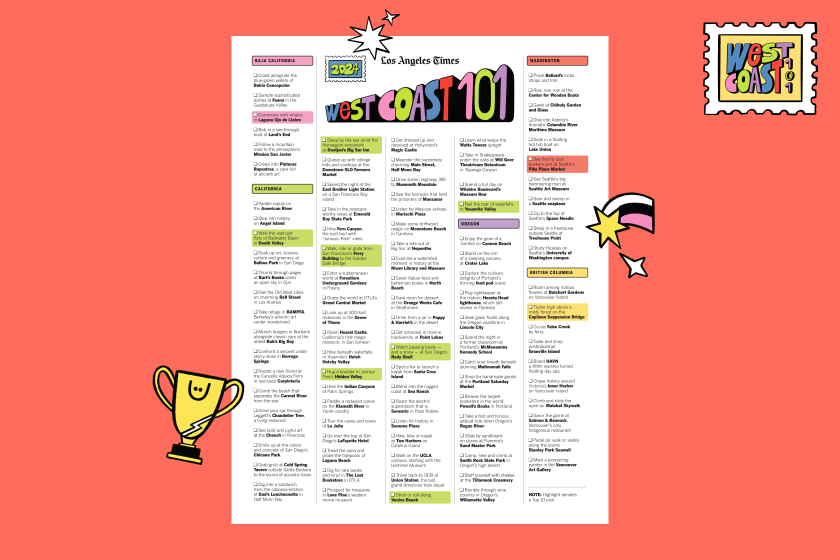
Download the checklist of the 101 best West Coast experiences
Keep it with you as you wander.
More to Read
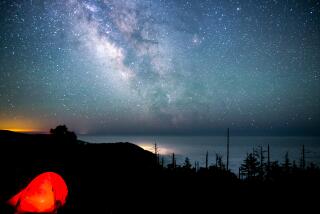
Soon you’ll have to pay to camp on the Lost Coast. Here’s what to know
May 10, 2024

16 essential brunch favorites from the 101 Best Restaurants guide
April 26, 2024

This must be Topanga Canyon
April 19, 2024
Sign up for The Wild
We’ll help you find the best places to hike, bike and run, as well as the perfect silent spots for meditation and yoga.
You may occasionally receive promotional content from the Los Angeles Times.
More From the Los Angeles Times

Entertainment & Arts
A year after its Tony boost, Pasadena Playhouse unveils 2024-25 season
May 16, 2024
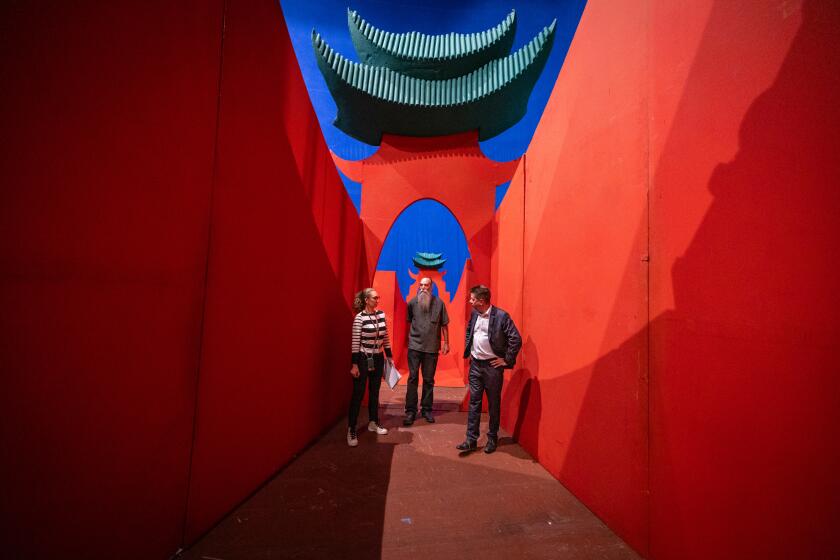
After 34 years, David Hockney’s magnificent ‘Turandot’ sets get resurrected in L.A.
May 15, 2024

Climate & Environment
A rare songbird’s epic journey from the edge of extinction back to the L.A. River
7 stunning l.a. gardens where you can stop and smell the roses (quite literally).
May 13, 2024
A first-timer's guide to Gran Canaria, Spain

May 13, 2024 • 9 min read

Get to know Gran Canaria, the third-largest Canary Island, with this first-timer's guide © Maremagnum / Getty Images
Ross Clarke has recently returned from Gran Canaria where he was researching for the upcoming Canary Islands guidebook (publishing November 2024). Here he creates the ultimate guide to help you start planning your vacation to the Canaries' third-largest island.
When you fly into Gran Canaria or traverse its coastline by boat to dock at one of its ports, you instantly understand why this island has captivated and intrigued people for centuries.
It’s been given the nickname of "the continent in miniature" due to its diverse terrain, and "the land of eternal spring" for its climate. The original inhabitants before the Spanish named it "Tamaran," and their legacy can be seen across the island in remains of their cave dwellings and artefacts.
Gran Canaria is the middle child of the archipelago, having sprung up from the ocean floor about 14 million years ago. It is often compared to its neighbor, Tenerife , but each of the islands has its own merits.
Most people will know Gran Canaria for its beaches and resorts, particularly Maspalomas in the south that encompasses the popular spot of Playa del Inglés . And while the beaches and sunny weather are spectacular, there’s much more to this beautiful island than sand, sun and sea, from incredible history and culture, magnificent sights and natural wonders, to outstanding food and wine.
When should I go to Gran Canaria?
For many years, Las Palmas de Gran Canaria held the title for the city with the best climate in the world. This is because the capital enjoys a temperate year-round climate with little rain and rarely scorching temperatures. Interestingly, Gran Canaria has its own microclimate, meaning that it can have hot, dry, sunny weather in the arid south, chilly, crisp and fresh temperatures in its mountainous center, and humid, hazy vibes in the north.
Gran Canaria is incredibly popular for winter sun, and beaches can be busy with tourists even in January – although you’re unlikely to spot a Canarian sunbathing until after April. Winter also plays host to several celebrations, including one of the world’s largest carnivals in February. These more-than-week-long celebrations take over the whole island and there are parties, parades and plenty of costumes and fun.
Summer also gets busy when the mercury can hit 30°C (86°F), however, with more than 60km (37 miles) of beaches around the island’s coast, you can usually find a spot on the sand to soak up some rays. Autumn and spring can be good times to visit, and prices tend to be a little lower, places less busy and temperatures ideal for exploring and sightseeing.

How much time should I spend in Gran Canaria?
Gran Canaria is both ideal for an exciting city break over a long weekend, a week-long beach holiday or an extended stay. In fact, it’s one of the most popular places for remote workers looking to balance work with the laid-back island lifestyle.
If you’re here for a week, you’re probably going to want to hit the beach (and I can’t blame you). While the dunes of Maspalomas are a sight to behold, try one of the quieter beaches such as Melenara near Telde or the remote Playa Güigüí – it’s a bit of a hike but well worth it for unspoilt sand and an all-over tan if that’s your thing! Once you’re suitably bronzed, consider hiring a car and visiting the center of the island. You’ll find fragrant and fire-resistant Canarian pine trees, family-run vineyards, and soaring volcanic monoliths such as Roque Bentayga , which were worshipped by the island’s original pre-Hispanic inhabitants.
If you’re hopping off a cruise ship or here for a city break, the capital city of Las Palmas de Gran Canaria – to give it its full name – is Spain’s eighth largest city and exudes a cool cosmopolitan vibe. It’s incredibly foodie and it’s worth indulging in the restaurant scene, from cool Canarian dishes by the beach in Mar Gastrotasca , to fine dining at Muxgo – the island’s first Green Michelin Star restaurant thanks to its 0km (0 mile) food philosophy. Don’t miss the beautiful Las Canteras beach with its natural barrier reef that protects the shore and makes the seawater almost swimming-pool like. The old town of Vegueta and Triana is also worth a visit to wander the historic streets and museums.
Is it easy to get in and around Gran Canaria?
The island has one major airport, Gran Canaria Airport (LPA), located about halfway down the east coast, which covers both international and domestic flights. It’s easy to get from the airport to all major resorts by bus, taxi or hire car.
The bus network is extensive and reaches all parts of the island. Buses are inexpensive and reliable and run by Guaguas Global . In the capital, you’ll see yellow buses. These run the length and breadth of the city and are operated by Guaguas Municipales . Single journeys start at €1.40.
Car hire is a great way to explore the island. Prices are generally good value although can peak during busy periods so it’s advisable to book ahead. Try using a local company if you can such as Cicar or Tirma . You could easily drive the circumference of the island in a single day, it is so compact, but it’s worth taking your time and planning journeys in advance so you don’t miss anything. Make sure to fill up with fuel before heading inland, as the steep, winding mountain roads can deplete reserves quicker than you think.
From the ports in Las Palmas and Agaete, you can catch ferries and high-speed catamarans to neighboring islands including Tenerife.

3 of the best things to do in Gran Canaria
1. see the waves of sand.
The rolling, shapeshifting, undulating dunes of Maspalomas should be on anyone’s must-visit list. These mountains of golden sand were here long before any development started in the resorts that now surround the protected space. Over the last few years, the Canarian government has brought in strict regulations for the dunes in order to preserve and protect them. There are several dedicated routes that you can walk that’ll take you to various parts including oases and La Charca nature reserve, a home to migratory birds. For your own bird's-eye views, head to the panoramic Atelier Cocktail Bar on the top of the Bohemia Suites hotel.
2. Climb the the Roques
There are two very famous monoliths in the center of the island, both of which are worth a visit. The Roque Nublo is the more famous, standing at a height of 80m (262ft) and soaring nearly 2000m (6561ft) above sea level. The trek to the rock is relatively easy and takes about 30–40 minutes.
Alternatively, try climbing to the Roque Bentayga . This was the last point of defence for the island’s original inhabitants, and it’s easy to see why as it stands on a plinth with views of the surrounding sunken volcanic crater. Check out the ground at the top, there are carvings and holes in the stone that are still a mystery to historians.
3. Wander the old town of Las Palmas
No visit to the city of Las Palmas de Gran Canaria is complete without a stroll around the beautiful historic streets of Vegueta. Take a trip up the bell towers of the imposing Catedral Metropolitana de Santa Ana de Canarias to get views over the city, sea and surrounding rooftops. Nearby, stop at the Museo Canario to learn all about the island’s original inhabitants and visit the rather creepy skeleton room containing many real examples of their mummified and skeletal remains. Finish with a visit to Terraza Belvédère to enjoy a local wine on the rooftop overlooking the Santa Ana Square.
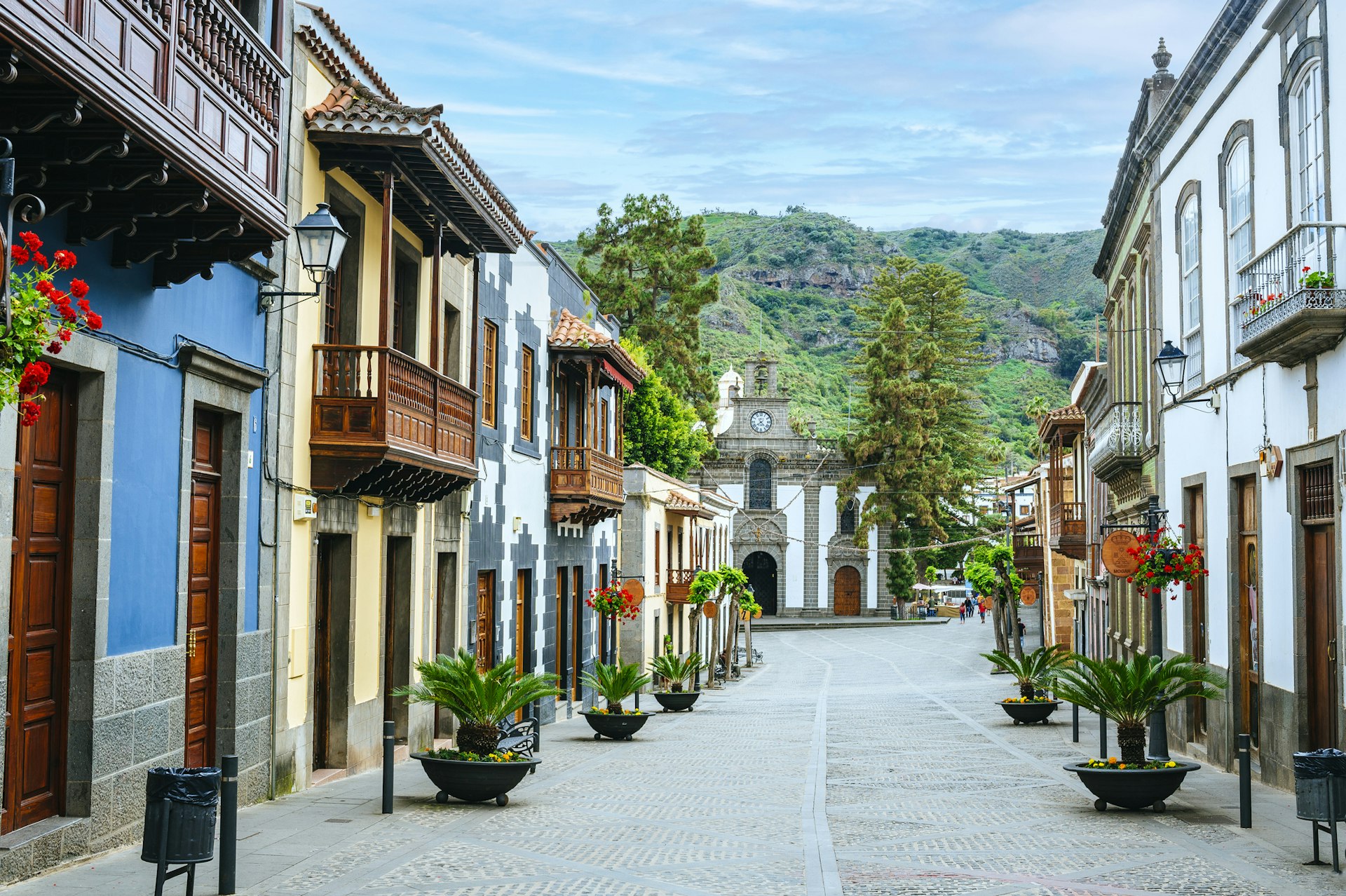
My favourite thing to do in Gran Canaria
I’m a sucker for a good market, and in Gran Canaria you’re spoilt for choice, from craft and artisan pop-ups to food and agriculture. One of my favorites, that I used to go to regularly when I lived in Las Palmas, is the weekend market in Vega de San Mateo. There are two giant warehouses that are full to the brim with stall holders. One is for crafts and but the other (which is my favorite) is the agricultural one. I love nosing at the stalls and chatting to the stallholders who often give you little taster of their baked goods or let you sniff spices. There is usually a stall selling truchas de batata – sweet potato pasties – that I devour in an instant. It’s also a good place to pick up non-touristy souvenirs such as seeds, herbs and sauces.
My other favorite is the weekend market at Teror. This town is famous for two things: the church dedicated to the island’s patron saint, Virgen del Pino; and chorizo de Teror , a sort of spreadable chorizo paste. You’ll find countless stalls selling bocadillos (rolls as big as your head) slathered in chorizo de Teror and fresh cheese.
How much money do I need for Gran Canaria?
Gran Canaria can be relatively cheap if you avoid the obvious tourist traps. The currency is the Euro (€) and most places take credit and debit cards. Over recent years cash has been on a decline, but it’s worth carrying some Euros in case you need them, especially in less touristic and developed areas.
- Hotel room: €50–250 per night
- Self-catering apartment (including Airbnb): €75–100 per night
- Bus ticket: €2.50
- Coffee: €1.50
- Tapas for two: €25–40
- Beer/glass of wine: €3
- Bottle of local wine: €15–30
Is this a family-friendly destination?
Canarian people adore children, and you’ll find families socialize together from grandparents to babies until all hours. And don’t be surprised if Canarios talk to your children before they speak to you – the island is extremely family friendly.
Is Gran Canaria good for gay travelers?
Gran Canaria is one of the most popular destinations for the LGBTIQ+ community. The island and islanders are incredibly open, and it is a safe environment to be yourself. Each year there is a famous Winter Pride in Playa del Inglés, centered around the Yumbo Centrum – the world’s only LGBTIQ+ shopping center – where you’ll find bars, shops, restaurants and clubs.
What is the calima ?
Some days in Gran Canaria, you might find that the air is very hot and yet it’s foggy or misty. This is known as the calima – the hot winds that blow over from the nearby Sahara Desert carrying sand dust in the air. While it won’t hurt you, it can make temperatures and being outside unpleasant.
Explore related stories

Destination Practicalities
A chilled and stunning Canary Island, Fuerteventura is packed with fun things to do and see. Start planning your trip now with our first-timer's guide.

Jan 31, 2024 • 6 min read

Oct 25, 2023 • 7 min read

Dec 20, 2022 • 3 min read

Jul 27, 2022 • 10 min read

Jul 13, 2022 • 11 min read
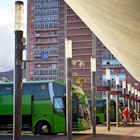
Jun 24, 2022 • 6 min read
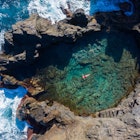
Jun 21, 2022 • 8 min read
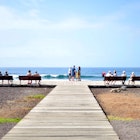
Jun 15, 2022 • 8 min read
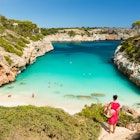
Mar 24, 2022 • 2 min read
- International edition
- Australia edition
- Europe edition

Germany’s football factory: a travel guide to the Ruhr
All eyes will be on Germany’s industrial heartland next month as Euro 2024 kicks off. We explore the region’s heritage, renewal and sporting history
I n 1961, future West German chancellor Willy Brandt declared: “The sky above the Ruhr must be blue once more.” His words were greeted with what sounded like applause but was actually his audience falling off their chairs. Because the Ruhrpott, or Ruhrgebiet, an agglomeration of industrial cities that includes Gelsenkirchen (where England will play their opening match of the European Championship this summer), Dortmund (which hosts group matches as well as a semi-final), Essen and Duisburg was a place where the chimneys of the coal, iron and steel industries poked up above the smog like candles on a giant grey birthday cake. You were more likely to slip in unicorn droppings than breathe clean air in the Ruhrpott.
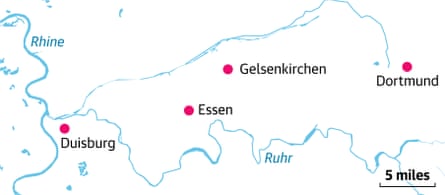
Today the notion of the Ruhr as a tourist destination may provoke as many German sniggers as Brandt’s prophecy back in 1961. But while this region of more than 5 million people may lack the fairytale castles of Bavaria or the coolness of Berlin, there’s plenty to divert the thousands of fans who will pour into the region in June and July. And that’s even if you leave aside the rich football heritage of the mighty Borussia Dortmund and Schalke 04, and perennial battlers such as Rot-Weiss Essen, Bochum and Duisburg.
The deeds and personalities of the region’s great players are commemorated everywhere with wall plaques and massive murals. One is devoted to Dortmund’s 1950s hero Max Michallek, a title-winning veteran defender whose curt reply to Hamburg star Uwe Seeler’s crack about his age, “Even when I’m 70 I’ll stop you!” is the stuff of local legend.
The Ruhrgebiet is accurately described as the industrial valley of the kings. Everything here was built on an epic scale, whether it’s the steel and brick edifice of Zeche Zollverein, once the biggest coalmine in Europe and now a Unesco world heritage site; or Villa Hügel, 19th-century industrialist Alfred Krupp’s 399-room mansion; or the glowing “U” that tops the 75-metre high tower that housed the Dortmunder Union brewery.
Even the Lichtburg, Essen’s classic 1920s cinema (such a model of pre-war German movie-star elegance it’s a surprise not to find Marlene Dietrich propping up the bar) is the largest in Germany.

Much of the heavy industry has gone (the last coalmine closed in 2018), but there’s still an impressive amount left. From the Alsumer Berg (like most of the mound-like hills that dot the Ruhr, it’s a former waste dump), where on a fresh spring morning snowy blossom drips from blackthorn trees and thrushes trill beneath a sky which – fulfilling Brandt’s prediction – is as clear and blue as a baby’s eyes, you can look down on the ThyssenKrupp iron and steel plant. It’s a metal metropolis of rolling mills, cooling towers, conveyors and serpentine lengths of pipework wide enough to drive a car through.
On the swirling Rhine, huge barges push up towards the works from Rotterdam, humping coal and iron ore. Railway trucks laden with limestone rattle over bridges and viaducts. Periodically the coking plant is fired, then doused. Clouds of steam spew and excess gas combusts in flare stacks. The sulphurous dragon-breath whiff tickles your nostrils. All this effort is to feed the monstrous appetites of a pair of blackened blast furnaces known locally as “the two dark giants”. To those for whom heavy industry is wreathed in romance and mythology, ThyssenKrupp is a hard hat Middle-earth.
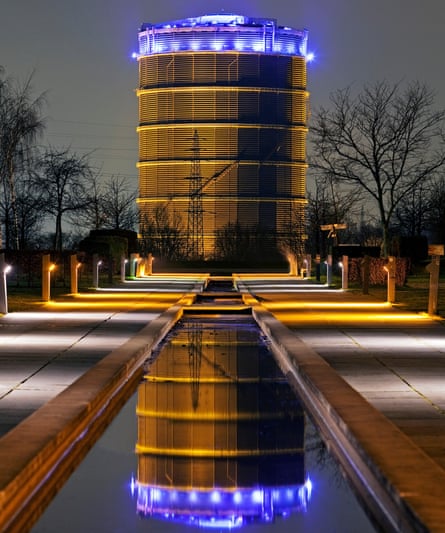
An hour after descending the Alsumer Berg, I’m standing on top of another massive blast furnace, the decommissioned behemoth at the centre of the Duisburg-Nord landscape park. Below, families sit beneath the cherry trees eating currywurst with chips and dollops of mayonnaise. This spicy, sticky mix is one of the Ruhr’s great culinary delicacies. The Dönninghaus in Bochum claims to make the best bratwurst in the world.
Duisburg-Nord is a masterpiece of imaginative repurposing. The gasometer is now a scuba diving pool and the great concrete storage bins have become climbing walls. More surprisingly, it has become a popular photographic backdrop for those with more niche interests. During my visit I saw a man dressed as an intergalactic warlord brandishing a ray gun, a couple decked in full rubber fetish gear and a manga-style schoolgirl being menaced by a mutant creature with chainsaws for arms. It’s not the sort of thing you’d come across at, say, Beamish Open Air Museum on a Saturday morning, but it suggests that the public have embraced the place.
The same holds true – albeit without the cosplay – of the Oberhausen Gasometer. Standing close to 120 metres in height, the 24-sided steel tower once stored coal and blast furnace gases. Today it’s an exhibition centre that attracts up to 100,000 visitors a day. For all of 2024 the halls are given over to a show about the oceans. On the 40-metre-high projection screen that lines one wall, giant luminous jellyfish float upwards into the darkness.
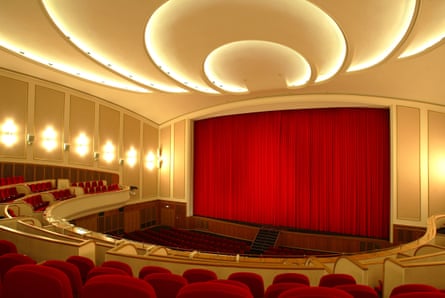
Further east is Duisburg’s inner harbour, where rows of towering Victorian grain stores and flour mills once supplied workers’ daily bread. Now they are art galleries and restaurants. I survey canvases by Anselm Kiefer and Gerhard Richter before demolishing a big slab of sour-sweet plum streusel cake on a terrace overlooking the water.
West along the canal and outlined against the grassy mounds of spoil heaps (all topped by works of art, including Genth and Mutter’s vertigo-inducing rollercoaster staircase the Tiger and Turtle – Magic Mountain) is the pale, rounded outline of the Veltins-Arena in Gelsenkirchen, home of Schalke. The stadium is named after the sponsor, a brewery whose beer is pumped directly into the stadium via a three-mile pipeline.
after newsletter promotion
Schalke left its original ground, the Glückauf-Kampfbahn ( Gl ück auf was the traditional miners’ greeting) in 1973. It’s still standing, preserved for its elegant 1920s entrance and main stand, and is a pre-match meeting place for fans. At one time many of the players were pitmen at the city’s Consol mine, whose winding tower is a monument. The teams used to go for post-training beers to Bosch, the atmospheric bar next to the Glückauf: its walls are decorated with photos of greats of the past, including scoring phenomenon Ernst Kuzorra.
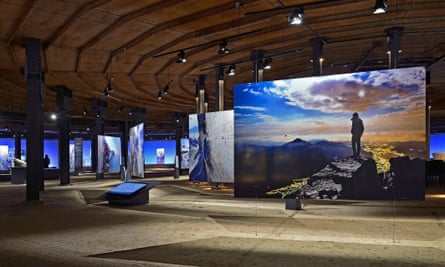
A greater measure of the place Schalke holds in the local imagination can be found in St Joseph’s church. No longer used for services, its altar is decorated in the royal blue and white Schalke colours, and scarves are plastered across its walls. A stained-glass window features Saint Aloysius dressed as a renaissance prince, except for his sturdy football boots. His cloak is blue and white; a ball rests at his feet. He appears ready to run on to the field, though even in the rumbustious 1950s it’s hard to imagine the referee would have allowed him to play while carrying such a big dagger.
Franz Beckenbauer called the Ruhr “the beating heart of German football”. (It’s a measure of regional influence that Toni Turek from Duisburg was the goalkeeper when West Germany won their first World Cup in 1954, Manuel Neuer from Gelsenkirchen when they won their fourth.) So it’s fitting that the national football museum is up the road in the home of Schalke’s rivals, Borussia Dortmund. Here fans of a certain age can get a sweet, misty-eyed hit from vintage Adidas shirts, pose beside the giant photo of Helmut Rahn from Essen (goal-scoring hero of West Germany’s surprise World Cup final victory in 1954) and vote on whether Geoff Hurst’s infamous goal in 1966 (the keeper, Hans Tilkowski, came from Dortmund) actually crossed the line.

On Bochumer Straße in Gelsenkirchen, a revitalised quarter is clustered around the imposing 1920s Heilig-Kreuz church. Now a performance space, it’s entered through doors designed to resemble the entrances of pit shafts. The massive, pillar-less interior feels like the belly of a whale. In the streets around it are artists’ studios, cafes, vintage stores, restaurants and bars including the excellent Trinkhalle Am Flöz.
Like football, beer is integral to life in the Ruhrpott. In Frohnhauser Sudwerkstatt, a microbrewery and one-room bar in Essen, owner-brewer Peter is an evangelist for British ale. He opened his doors in February uncertain of what to expect. “I didn’t know if people here would like my beer, but you see …” he gestures to a bar whose every square foot is occupied by a German glorying in their first experience of chocolate porter or dark mild.
Later, in Essen’s Holy Craft Süd, drinking unfiltered export pilsner made by brewery Mücke (named after a heroic pit pony from the Zollverein mine), a local bemoans the changes he has seen over his lifetime. “Young people now, they don’t know how it was. When the blast furnaces were working here in the city, at night they turned the whole sky orange.”
Where heavy industry is gone, nostalgia is sure to move in. But it doesn’t have to be all that is left. Rebuilding is tough, but in the Ruhr, a land filled with the skeletons of industrial giants, maybe there are growing signs that a compromise can be reached, that you can merge tradition with modernity, pairing currywurst with a hazy IPA beneath a smokeless sky.
- Germany holidays
- Europe holidays
- City breaks
- Short breaks
Most viewed

6 Last-Minute Travel Tips for the 2024 Total Solar Eclipse
I n less than a month, people will look to the sky as the moon passes between the sun and the Earth in a celestial event known as a total solar eclipse . The phenomenon is set for April 8, 2024, and the next one that can be seen from contiguous United States will be August 2044 , so it's unsurprising that eclipse fever has gripped the nation. Between 1 and 4 million people are predicted to travel to the path of totality, joining the 31 million people already living within it.
Among the tours, cruises, hotels, and even scenic flights offering their own spin on the total solar eclipse experience, here are six tips that last-minute planners should keep in mind for the special day.
1. Figure out where you want to go
There are 13 U.S. states on the path of this year's eclipse: Texas, Oklahoma, Arkansas, Missouri, Illinois, Kentucky, Indiana, Ohio, Pennsylvania, New York, Vermont, New Hampshire, and Maine (small parts of Tennessee and Michigan are also in the path). Among all of these states, totality will occur in two national parks-Hot Springs National Park in Arkansas and Cuyahoga National Park in Ohio-and they're expected to get crowded. Instead, consider one of the more than 100 state parks along the path, some of which are more off the radar. If you're more of a city dweller, you can also experience totality in big cities, including San Antonio, Austin, Cleveland, and Rochester.
Consider the weather, too. According to NOAA 's past weather records, April weather seems to bring more chances of rain-meaning more potential for cloud coverage-in the Northeast than in the South.
2. Consider the length of totality
Aiming for a destination in the path of totality is a no-brainer, although the amount of totality you'll get depends on where you go. The closer to the center of the path of totality an area is, the longer the total eclipse lasts. Take Austin and Dallas: While both are on the path of totality, Austin will get 1 minute and 46 seconds of totality, while Dallas will get 3 minutes and 52 seconds of totality. The longest duration you can get for totality is about 4 minutes and 30 seconds. Particularly traveler-friendly spots to maximize your time in the dark are Texas Hill Country towns like Kerrville (which will receive around 4 minutes and 24 seconds of totality and is partnering with NASA) and Fredericksburg (which is set to get 4 minutes 23 seconds of totality). Texas Hill Country is also one of AFAR's best places to go in 2024 .
3. Consider camping
If you want a solar eclipse experience surrounded by nature rather than people, camping may suit you better. But booking developed campgrounds at state parks and well-known nature spots will likely be difficult at this point. As an alternative, check for privately owned land through platforms like Hipcamp or look for dispersed camping sites in a national forest, like Ozark National Forest or Green Mountain National Forest . While backcountry spots may not have amenities, they can be perfect for those seeking solitude.
In addition, be sure to check the capacity of a park when it comes to handling the influx of visitors for April 8. As an example, Erie's tourism board is discouraging visits to Presque Isle State Park to prevent bottleneck traffic from its one entry and exit point.
4. Look into a town, festival, or last-minute tour
Plenty of places within the path of totality are putting their own spin on the solar eclipse with dedicated festivities. Get an educational experience at Rochester Museum & Science Center's ROC the Eclipse Festival , a three-day event that includes talks titled "Frontiers of Plasma Physics" and "The Search for Earth-Like Planets" from science experts. Or lean into grandeur at the four-day Texas Eclipse Festival in Burnet, Texas; its lineup includes music performances, yoga sessions, and immersive art experiences. (If you're heading to Texas for the eclipse event in general, check out this interactive map of special activities happening across the state.)
If the mere thought of navigating trip logistics brings a headache, check for the availability of some solar eclipse tours. Some tours still have availability, like Holland America Line's whopping 22-day Solar Eclipse cruise tour through North America. Others, like Travel Quest's Mexico's Copper Canyon Total Solar Eclipse tour , only have wait-list spots. But don't give up hope: As last-minute cancellations roll in, a quick call could secure you a place.
5. Try to get a last-minute spot at hotels in the path of totality
Hotels are leaning into the solar eclipse experience too, and properties are throwing celebrations and dedicated solar eclipse events just for the event. Miraval Austin Resort and Spa is hosting a viewing session with its astrologer, while Hôtel Swexan in Dallas is offering solar eclipse wellness activities on the evening of April 8 that includes meditation, a sound bath, and a Reiki healing session.
Keep in mind that a last-minute booking may cost a premium. Properties all across the band of totality are recording sky-high prices -even budget hotels . Similar to booking tours, do your due diligence and call to check for a cancellation.
6. Come prepared
Of course, you should wear solar eclipse glasses to prevent permanent damage to your eyes. If you're going to an event, check to see if they will be provided or if you'll need to bring your own. If you don't want to buy them, you can use household materials like cardboard to make your own pinhole projector , a contraption that allows you to see the sun change shape as the moon crosses in front of it.
In addition to bringing materials for the day of the event, anticipate what happens next. The length of totality is less than five minutes, but the traffic afterwards may disrupt your plans for hours. If you're coming from a crowded park or city, be on the safe side and come prepared with extra snacks and water.


COMMENTS
Your official guide Hamburg's greatest points of interest. Planning a weekend in Hamburg? Explore our Top 10 sights, the Elbphilharmonie concert hall, upcoming events and the best things to do. Find anything from luxury hotels to cheap hostels in central Hamburg.
Hamburg is one of the most beautiful cities in the world and radiates an incomparable charm. Go on a discovery tour through the city by the Elbe and explore the most beautiful sights, attend unique events or feast in the most delicious restaurants & cafés. The city's scene & nightlife are known all over the world and Hamburg is also a great ...
Get to the heart of Hamburg with one of our in-depth, award-winning guidebooks, covering maps, itineraries, and expert guidance. Shop Our Guidebooks. 04 / Go Beyond.
20 travel tips every Hamburg visitor needs to know. 1. Expect the rough with the smooth. Every metropolis is multi-faceted, but Hamburg's vivid contrasts often take first-time visitors by wide ...
St. Michael's, Hamburg's largest church, is actually the third church to be built in the same spot and was constructed in 1912. Visitors flock to the landmark church to see its five different ...
Enjoy the view from the Michel, Hamburg's most famous church. Admire the Elbphilharmonie - and ideally even attend a concert. Take a harbour tour and marvel at the large container ships. Eat a fish sandwich. Stroll through the Speicherstadt or, even better, take a boat trip through the canals. 2.
We estimate that budget travelers will spend an average of €40-€70/day. That said, you can easily spend a little less or quite a bit more depending on your travel style. Check out our Hamburg Price Guide to get a better estimate of travel costs. In general, your biggest expenses will be accommodation, food, and alcohol.
Planten un Blomen is a botanical garden in Hamburg's city center. It's more than 116 acres (450,000 sq. m) in size, connecting the Elbe River with the Outer Alster Lake. Inside these gardens, you'll find an array of plant life, lakes, and fountains. There's also a Japanese garden and kids playground.
Hamburg (it's one of 3 "city-states" in Germany) Schleswig-Holstein is the state north of city. Lower-Saxony is the state south of city. Train Travel Times to Hamburg. Berlin Hamburg = 2 hrs. Frankfurt Hamburg = 4 hrs. Munich Hamburg = 5.5 hrs. Salzburg Hamburg = 8 hrs. Paris Hamburg = 8 hrs.
Explore the very best things to do in Hamburg during your first visit. Includes top places to see, things to do, where to stay, tips, tours and more. ... (Travel Guide) St Michael's Church. The main draw to this church is a climb up the stairs of the tower for a view of Hamburg. St Michael's church is the most popular church in Hamburg and ...
A local's guide to Hamburg: 10 top tips. With buzzy cafes, plenty of green space, music venues, fashion and football, there's more to the Beatles' favourite German city than the Reeperbahn ...
Hamburg Travel Guide Germany ... The best time to visit Hamburg is the months between May and September when 70-degree temps sweep through the city. Room rates might be a bit higher and you may ...
Prices start at just $13 per day for a mini car, with full-size cars available for as low as $44 per day. It's recommended to plan ahead and book a rental car in Hamburg to secure great rates; visitors can save up to 30% by comparing rates and booking in advance. From iconic landmarks to charming neighborhoods, our Hamburg Travel Guide has ...
Elbe Tunnel - Today, you can walk under the water from one shore to the other of the Elbe River when in Hamburg. The 1,400-foot tunnel, originally opened in 1911, is still open for transit from shore to shore, as well as for curious tourists, including cyclists and pedestrians (free). A little spooky, a lot history.
Among the must sees: Hamburg Harbor - The 800-year-old harbor is one of the largest ports in the world. Take the free ferry or wander through the reinvigorated Hafencity, a warehouse district that is newly built up and offers the latest in shopping and dining. Fischmarkt - Another historic, lively working site is the 300-year-old fish market.
The Free and Hanseatic City of Hamburg ( Freie und Hansestadt Hamburg) is Germany's second-largest city and, at the same time, one of Germany's 16 federal states or Bundesländer. Prior to the formation of the modern German state, Hamburg for centuries enjoyed a status as de facto independent city state and regional power and trade hub in the ...
The Great Fire of 1842. The Great Fire of 1842 destroyed ¼ of the city. It started on Hamburg's oldest street, Deichstraße, and there are rumors that it was purposely set in order to rebuild and expand Hamburg. During the Great Fire of 1842, the first known photographs of Hamburg as a city were taken.
Hamburg is Germany's second-largest city and its most important port (even though it's about 60 miles from the sea). The city's fishy maritime atmosphere gives Hamburg an almost Scandinavian feel that's worlds away from the sun-drenched, Baroque joviality of Bavaria. It's popular with German tourists who come here to eat fish, watch soccer games, marvel at its mighty port, and experience the ...
Get information on Hamburg Travel Guide - Expert Picks for your Vacation hotels, restaurants, entertainment, shopping, sightseeing, and activities. Read the Fodor's reviews, or post your own.
Hamburg takes food very seriously indeed, and its cuisine is oriented towards the sea. Places like Elbfisch or Deichgraf serve up local specialties of the highest quality, but even the street food is delicious, with filling falafel and doner kebabs available at bargain prices. 5. World-Class Markets Represent a Shopper's Dream.
Rough Guides® is a trademark owned by Apa Group with its headquarters at 7 Bell Yard London WC2A 2JR, United Kingdom. Plan your visit to Hamburg, Germany: find out where to go and what to do in Hamburg with Rough Guides. Read about itineraries, activities, places to stay and travel essentials and get inspiration from the blog in the best guide ...
An 800-year-old harbor, Germany's largest port, is just the beginning of Hamburg. This city is also home to a famed fish market, the largest Japanese garden in Europe, and the largest warehouse complex in the world. The 9 Best Restaurants in Hamburg, Germany. Weather in Hamburg: Climate, Seasons, and Average Monthly Temperature.
Sognefjord. Sognefjord is 120 miles long and about one mile deep. As the longest and deepest fjord in Norway, Sognefjord reigns supreme. Known as The King of the Fjords, it has several side ...
Travel & Experiences. From Baja to British Columbia, these are the 101 best West Coast experiences. Logo animation by Jacky Sheridan; video editing by Li Anne Liew; Storyblocks. Walk the vast salt ...
3 of the best things to do in Gran Canaria. 1. See the waves of sand. The rolling, shapeshifting, undulating dunes of Maspalomas should be on anyone's must-visit list. These mountains of golden sand were here long before any development started in the resorts that now surround the protected space.
Travel Guide to More Than 100 Destinations Around the World' is National Geographic's first travel book aimed at the LGBTQIA+ community. Authors Amy B. Scher and Mark Jason Williams dive into ...
One is devoted to Dortmund's 1950s hero Max Michallek, a title-winning veteran defender whose curt reply to Hamburg star Uwe Seeler's crack about his age, "Even when I'm 70 I'll stop you ...
2. Consider the length of totality. Aiming for a destination in the path of totality is a no-brainer, although the amount of totality you'll get depends on where you go. The closer to the center ...
Here are 13 reasons to visit Madinat Jumeirah: Hit the beach. Jumeirah Al Qasr. The Beach. Unwind on Madinat Jumeirah's more than a mile-long private stretch of sand and indulge in the resort ...